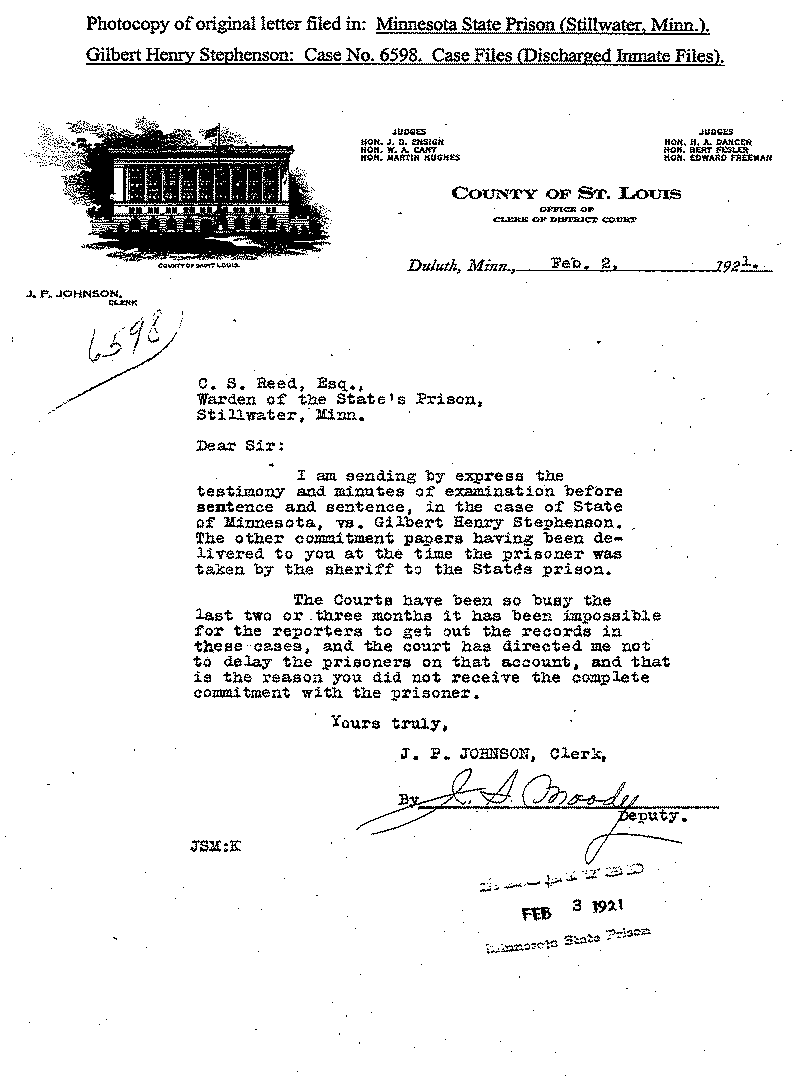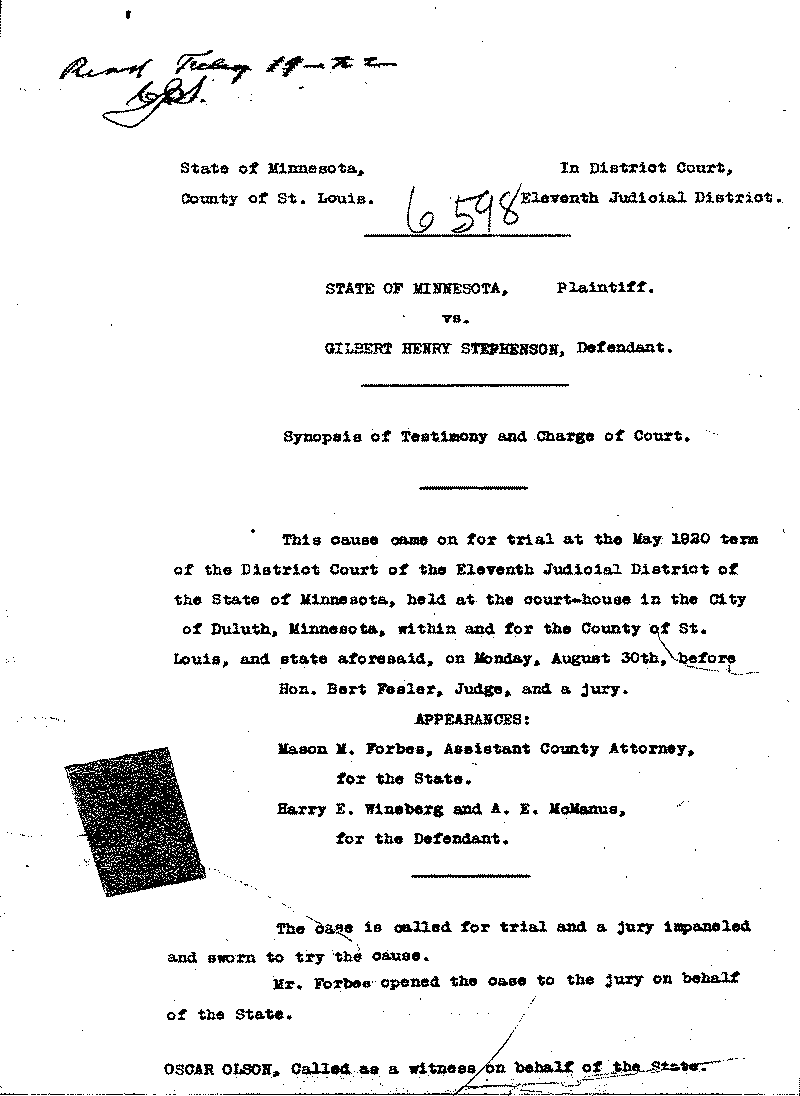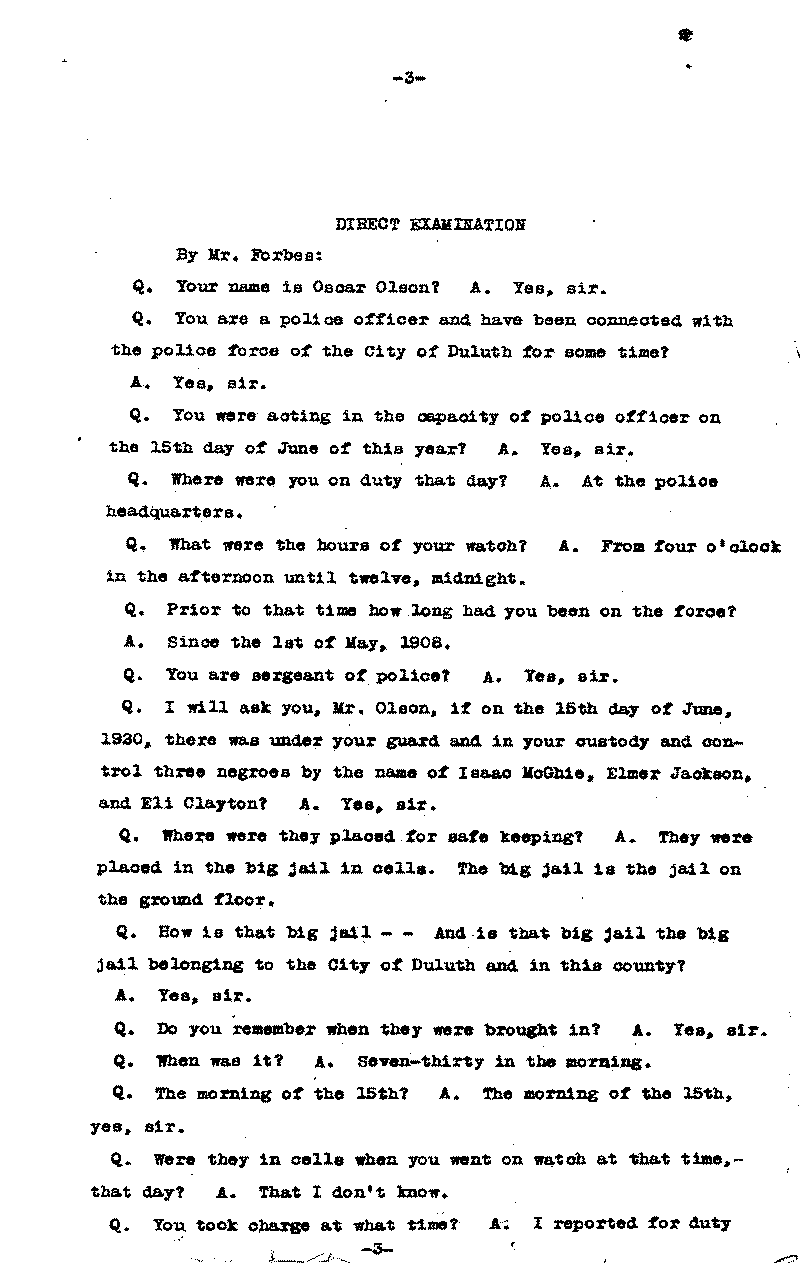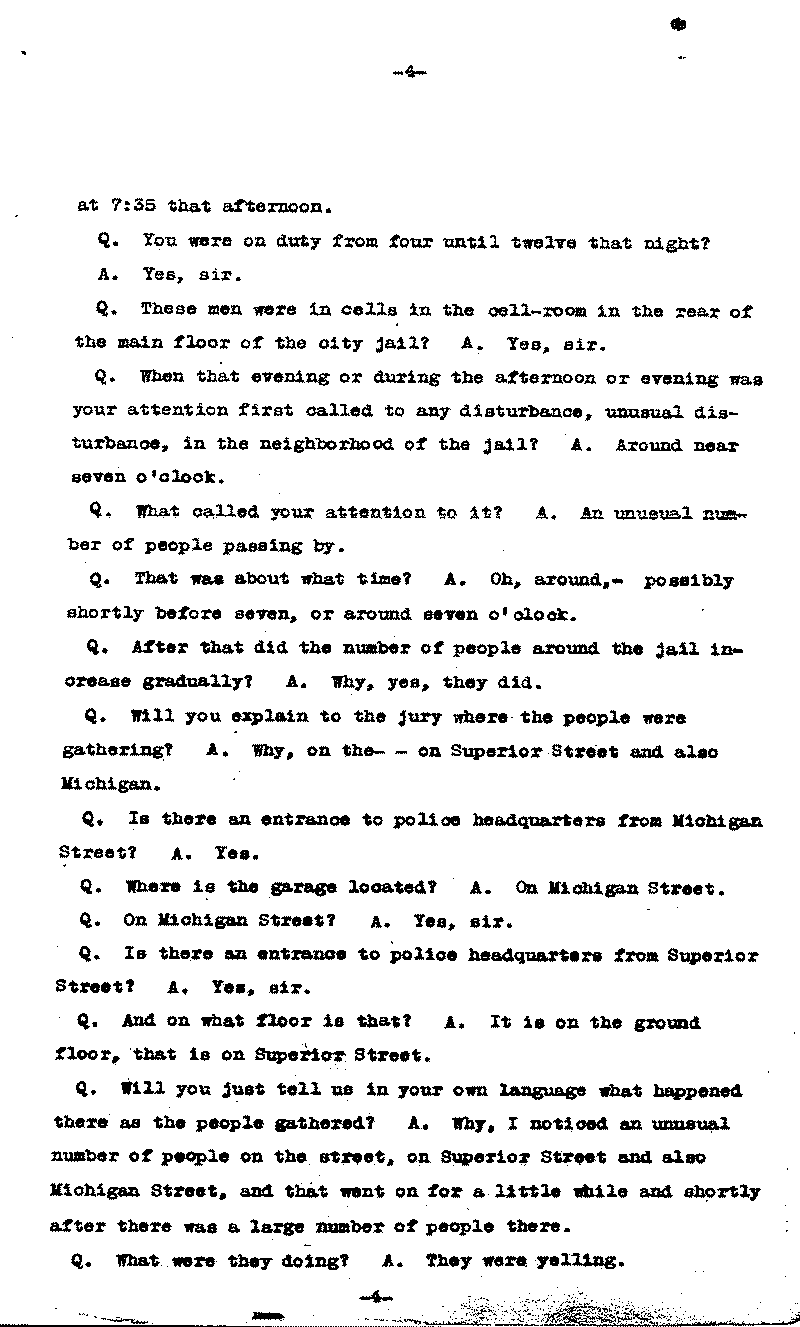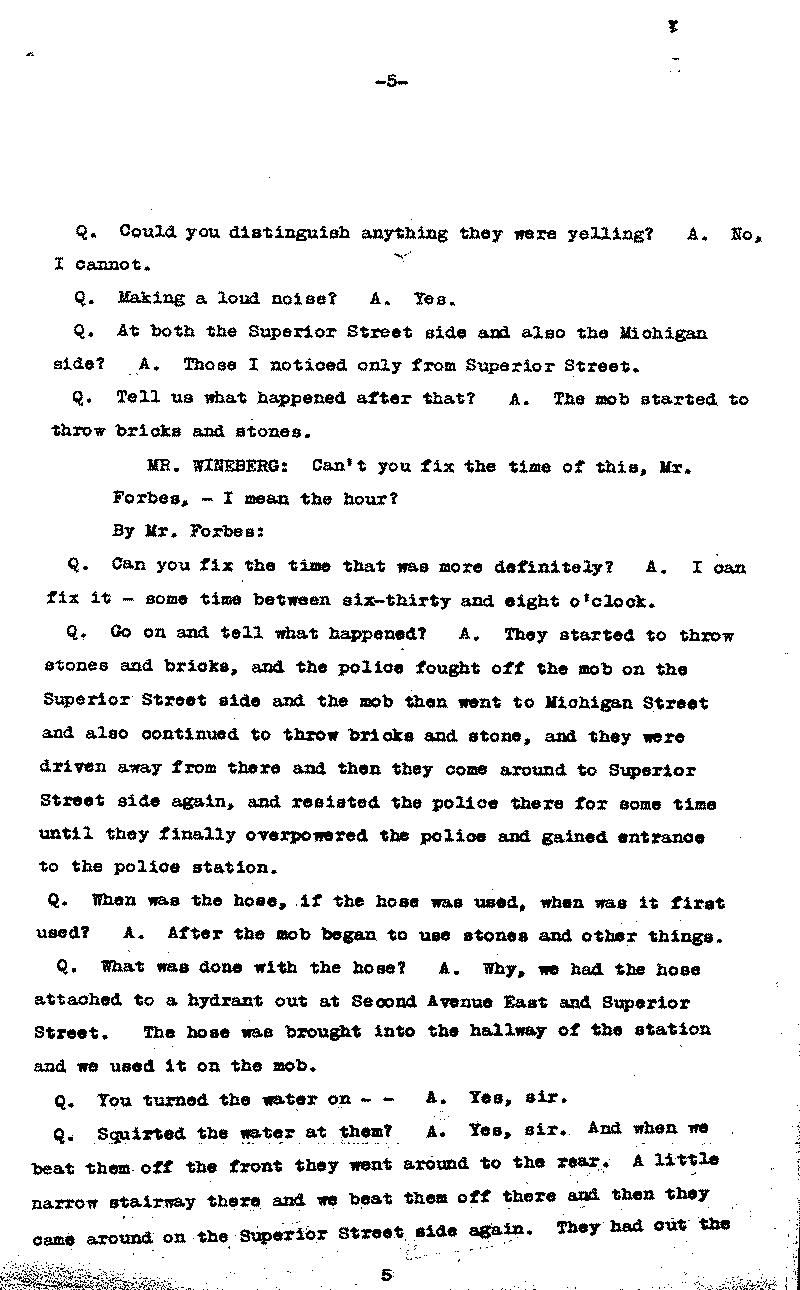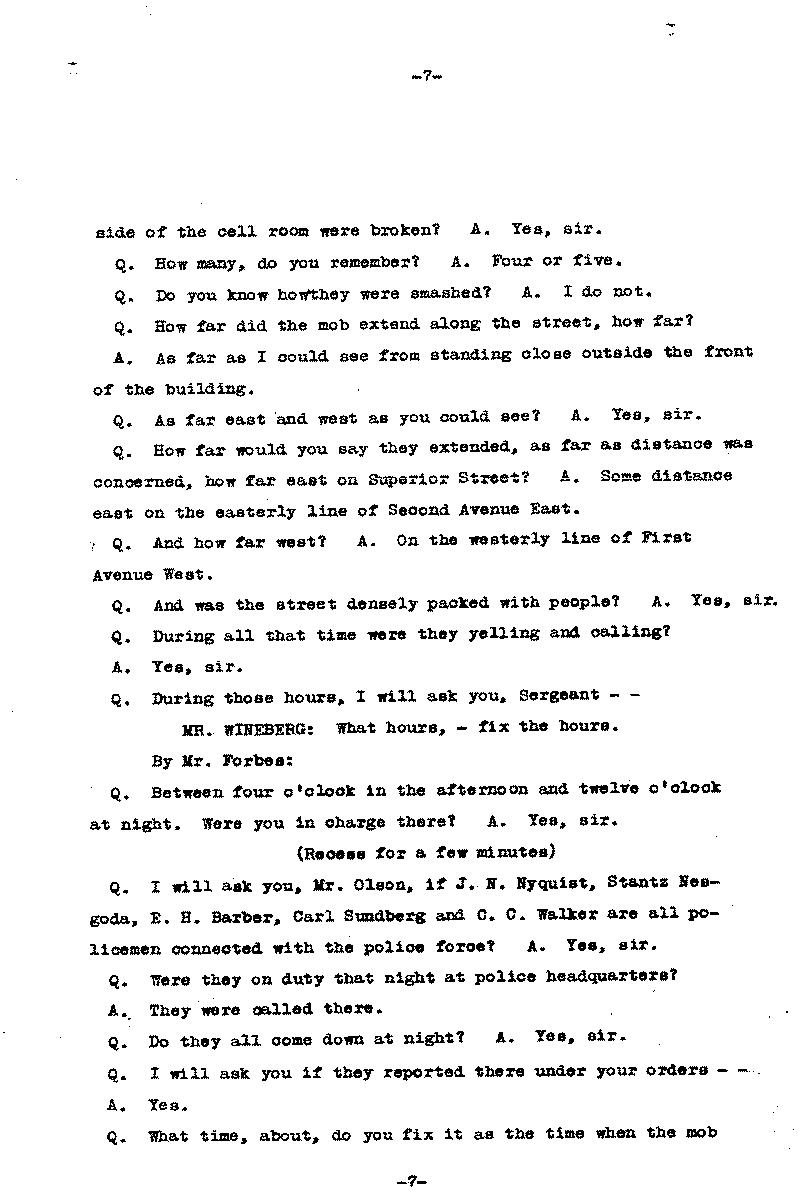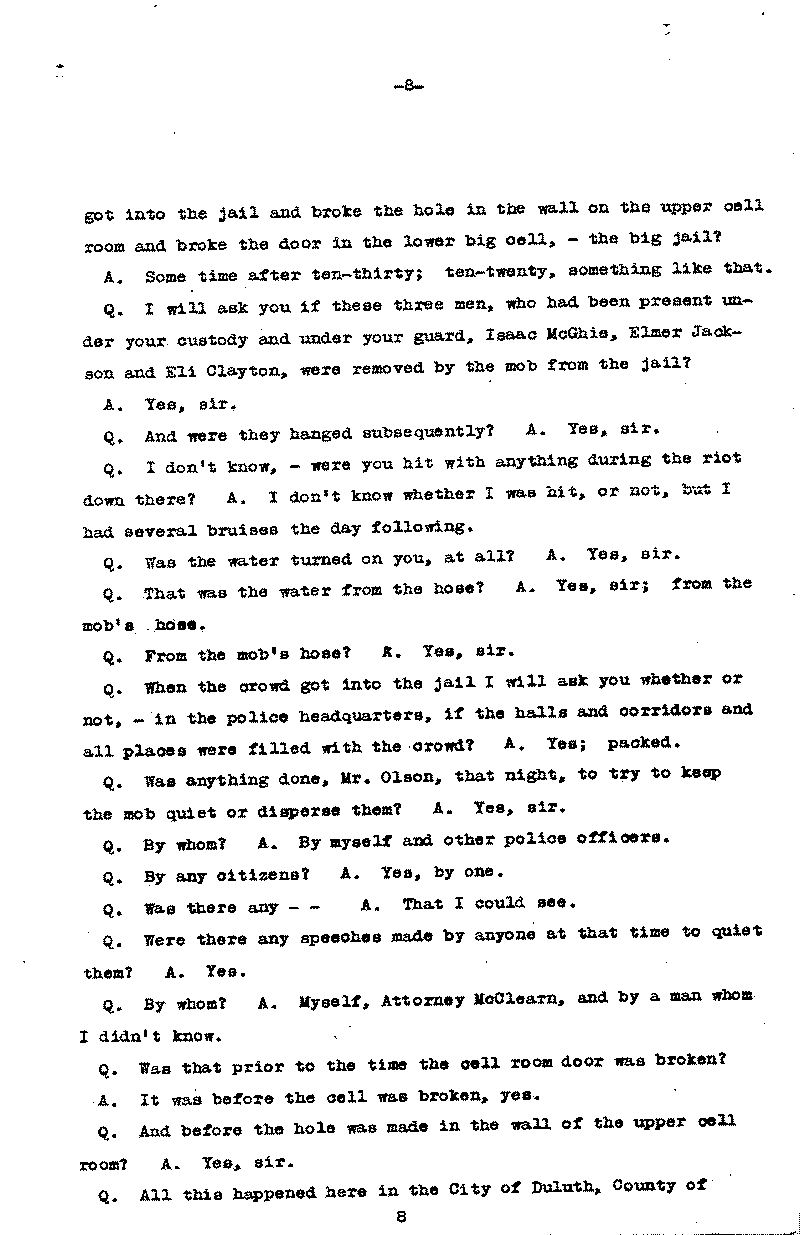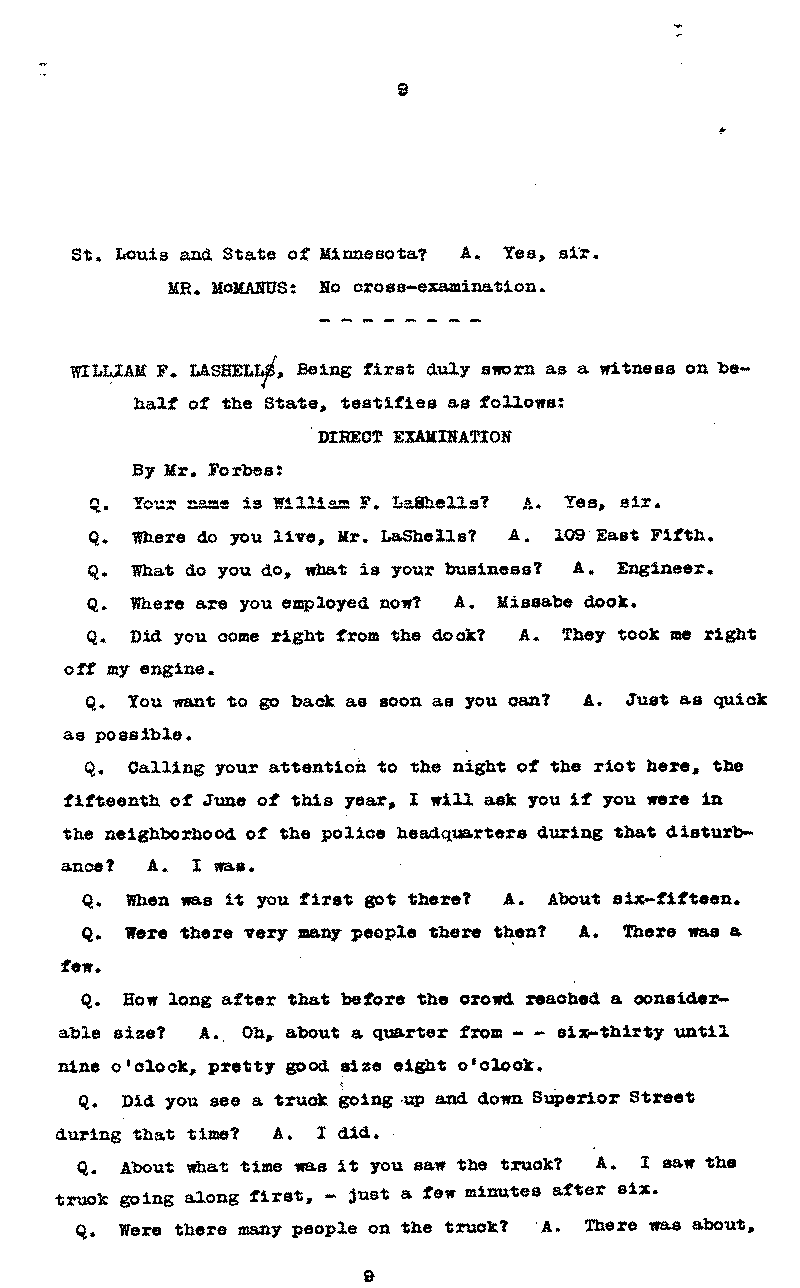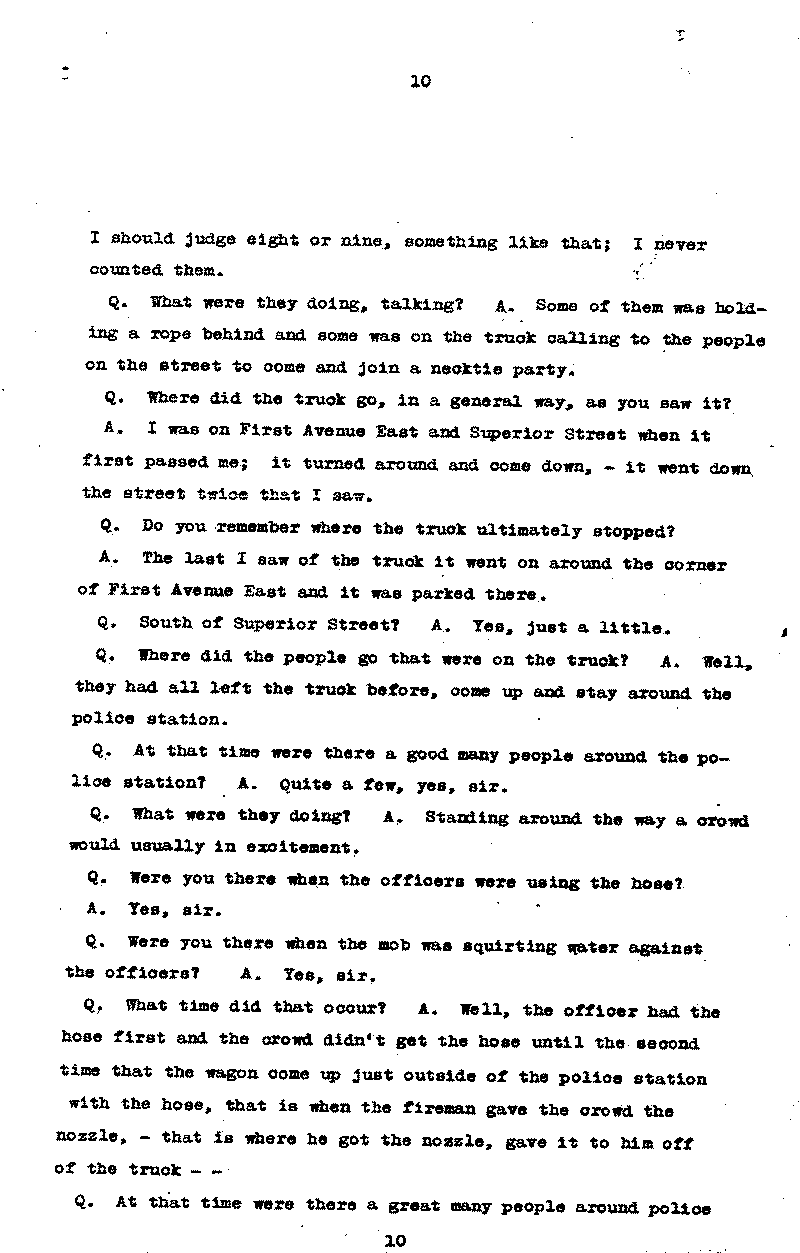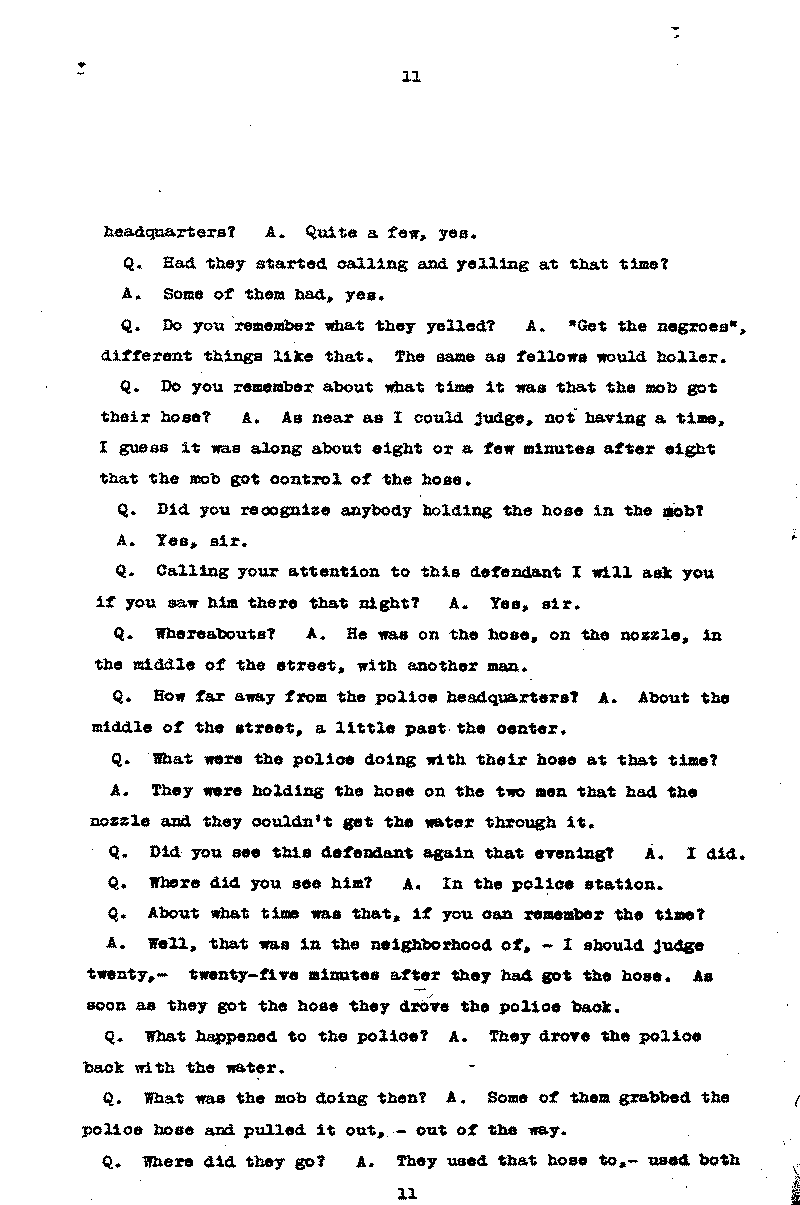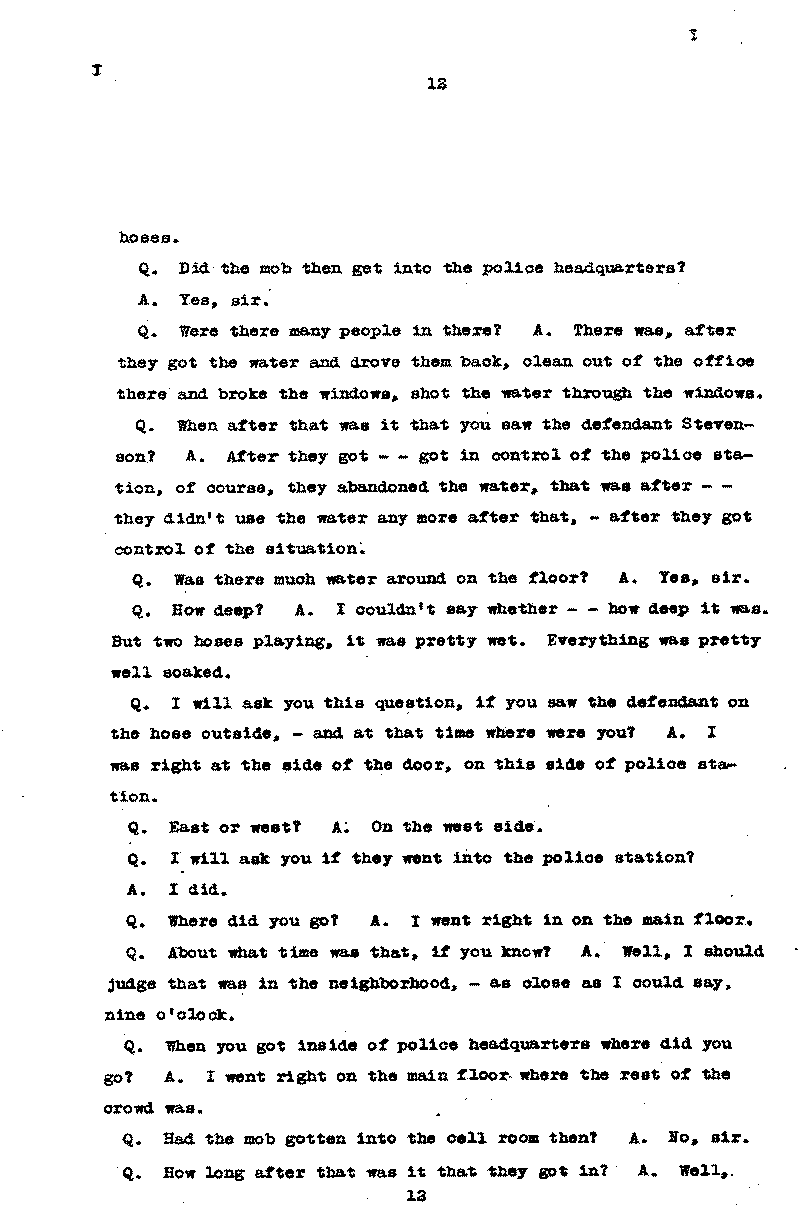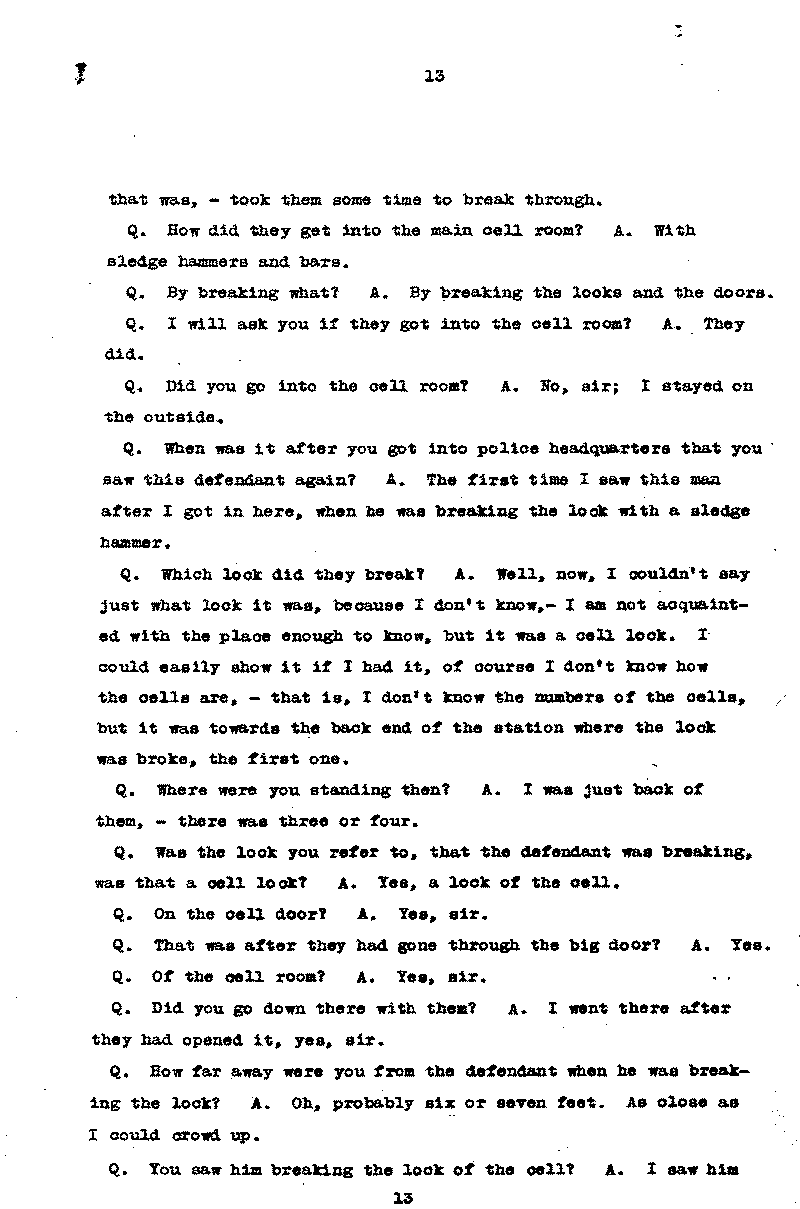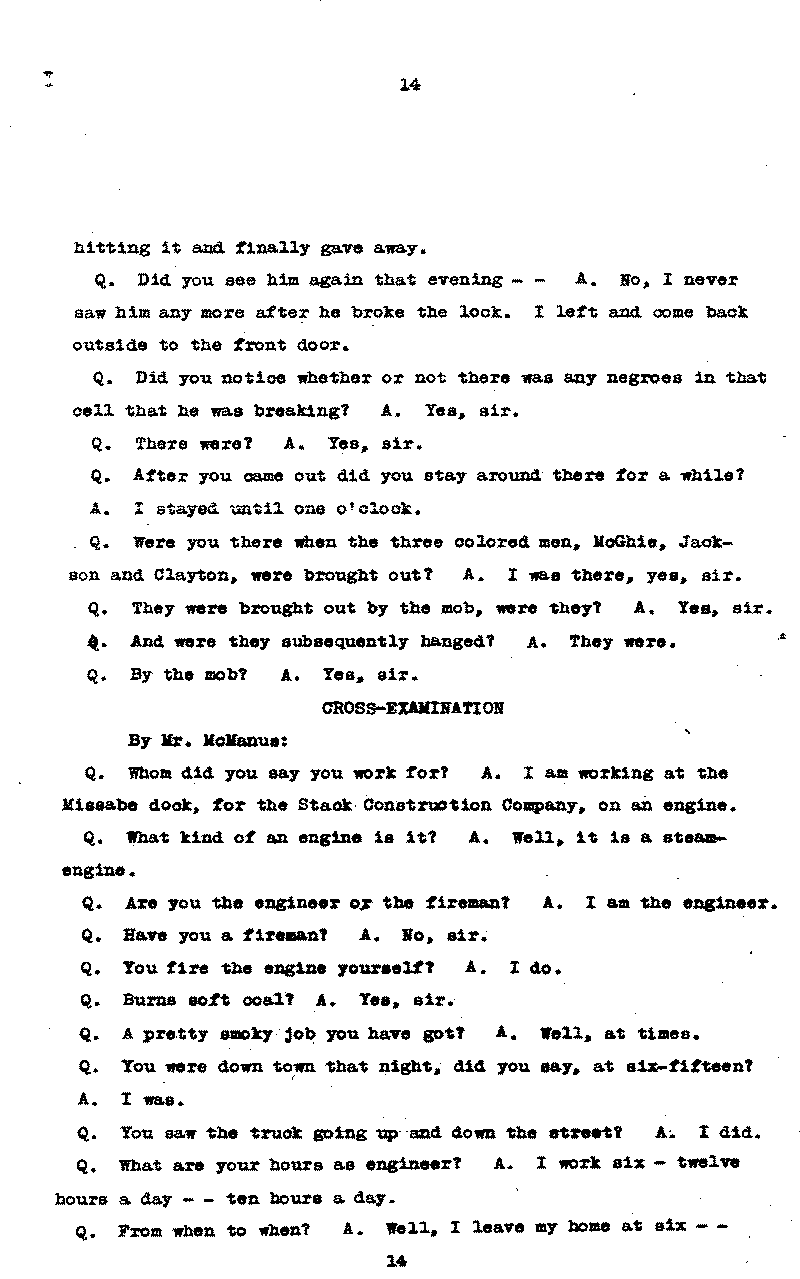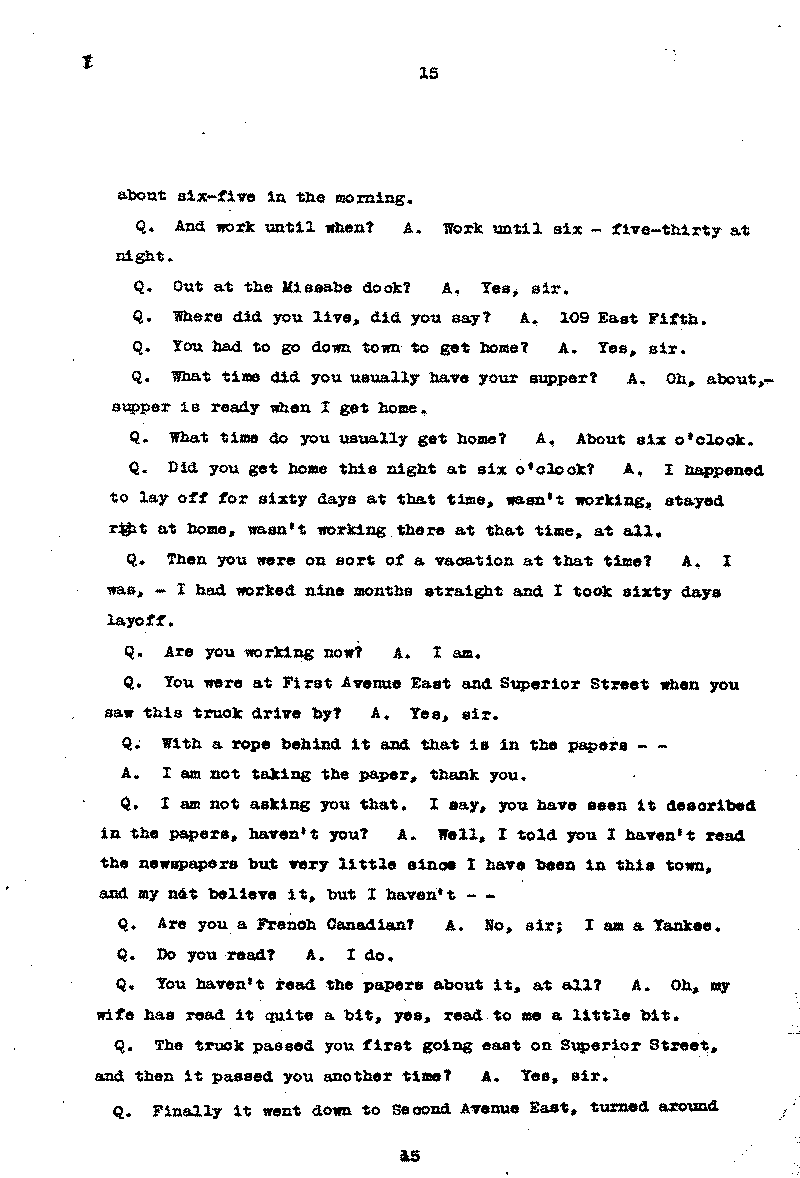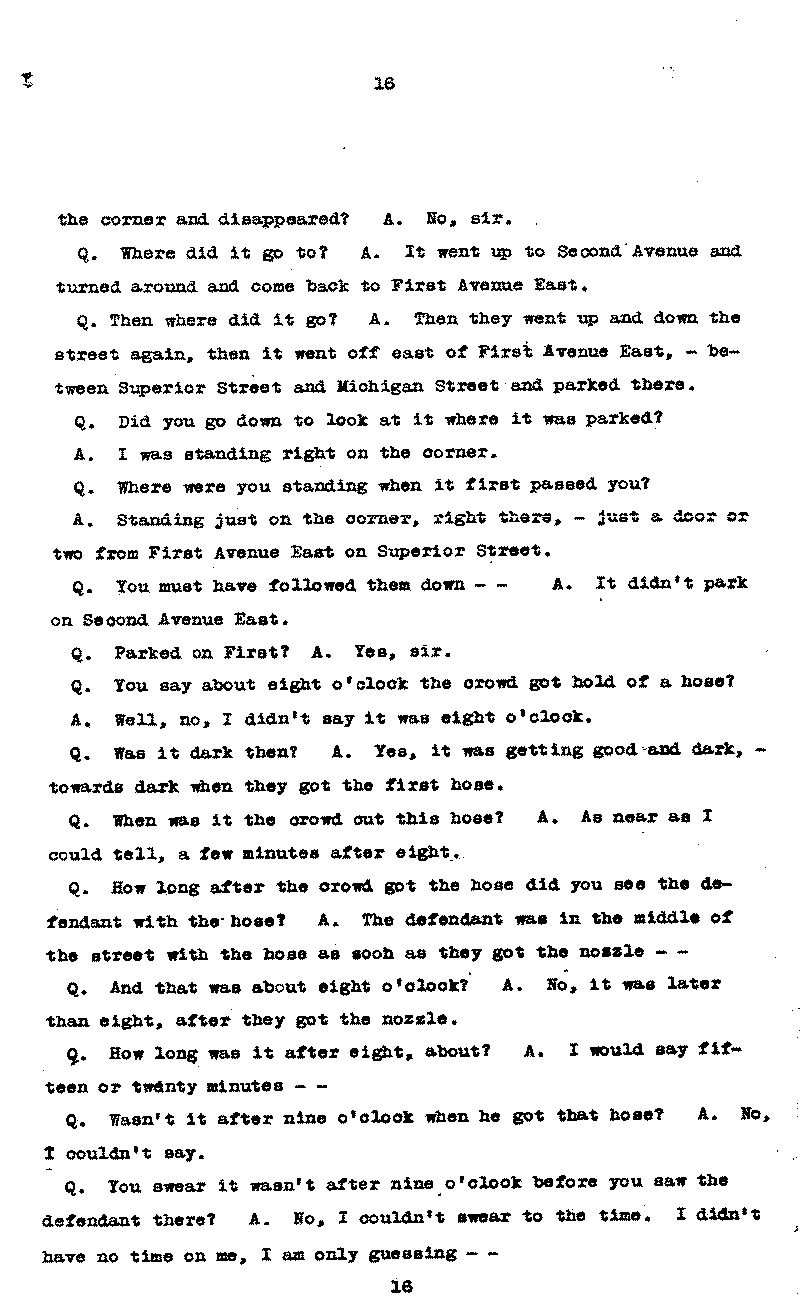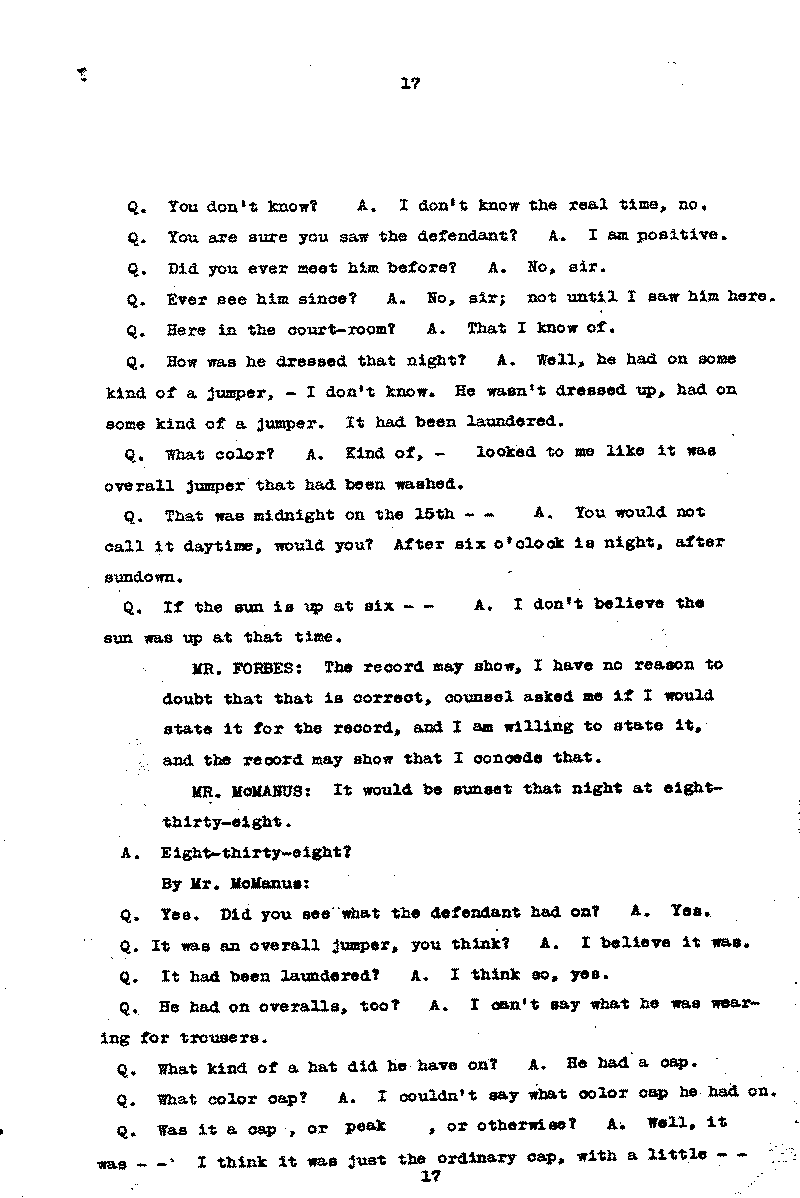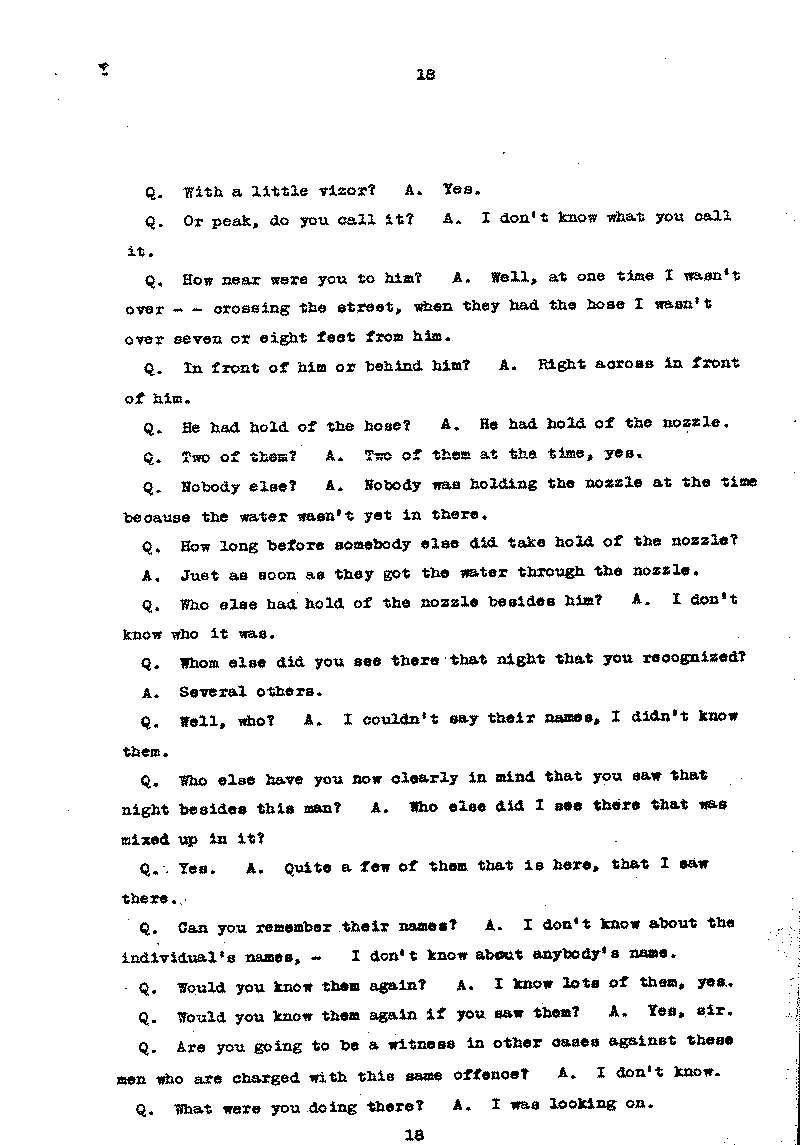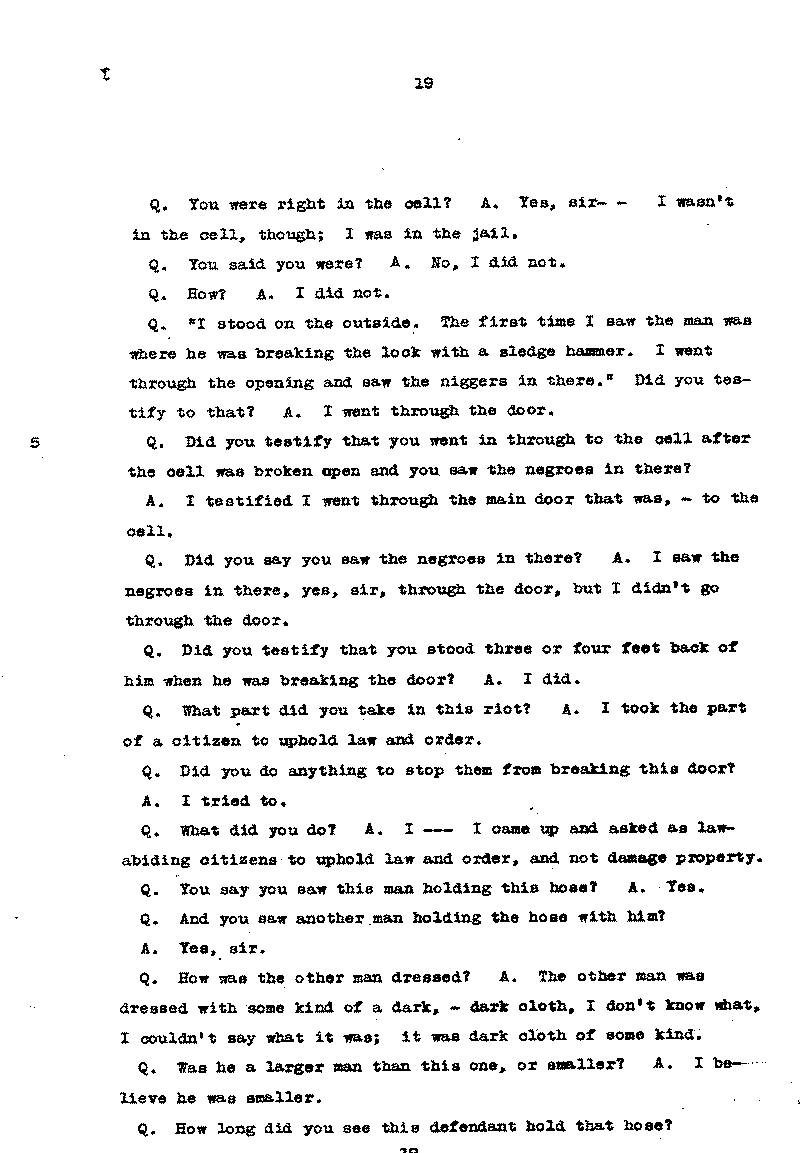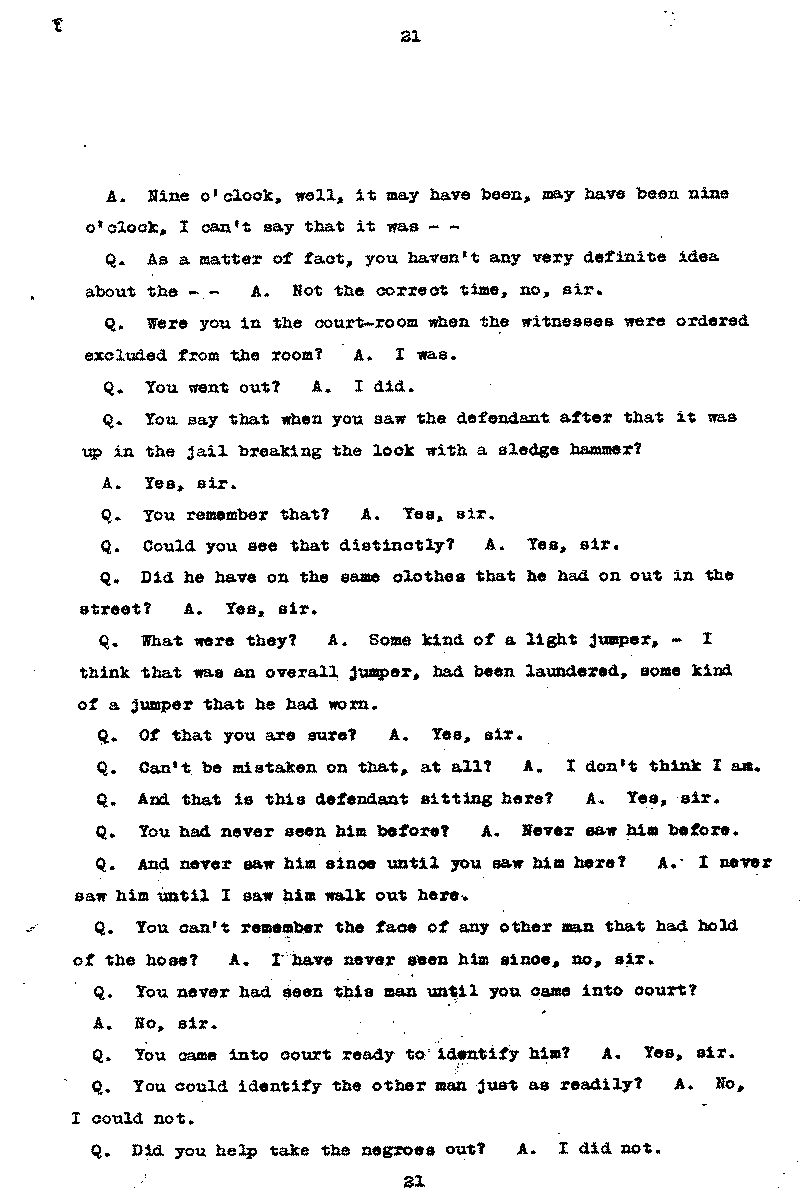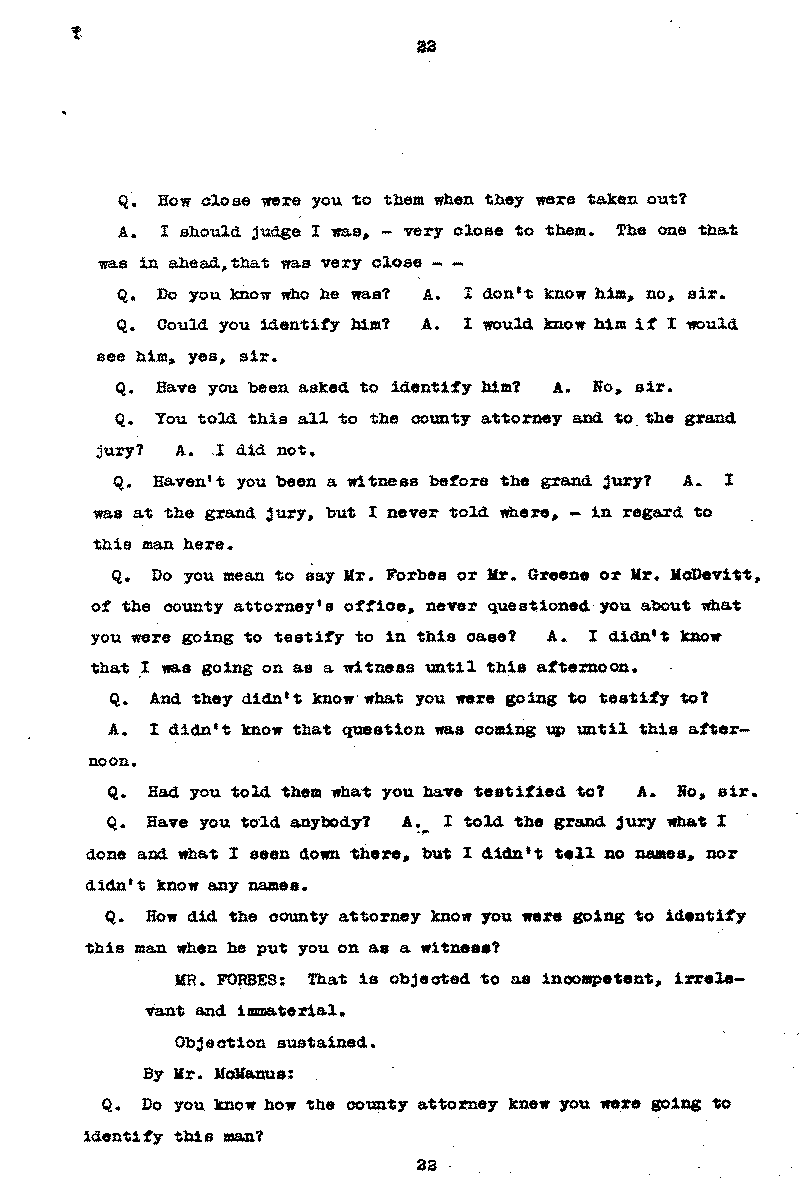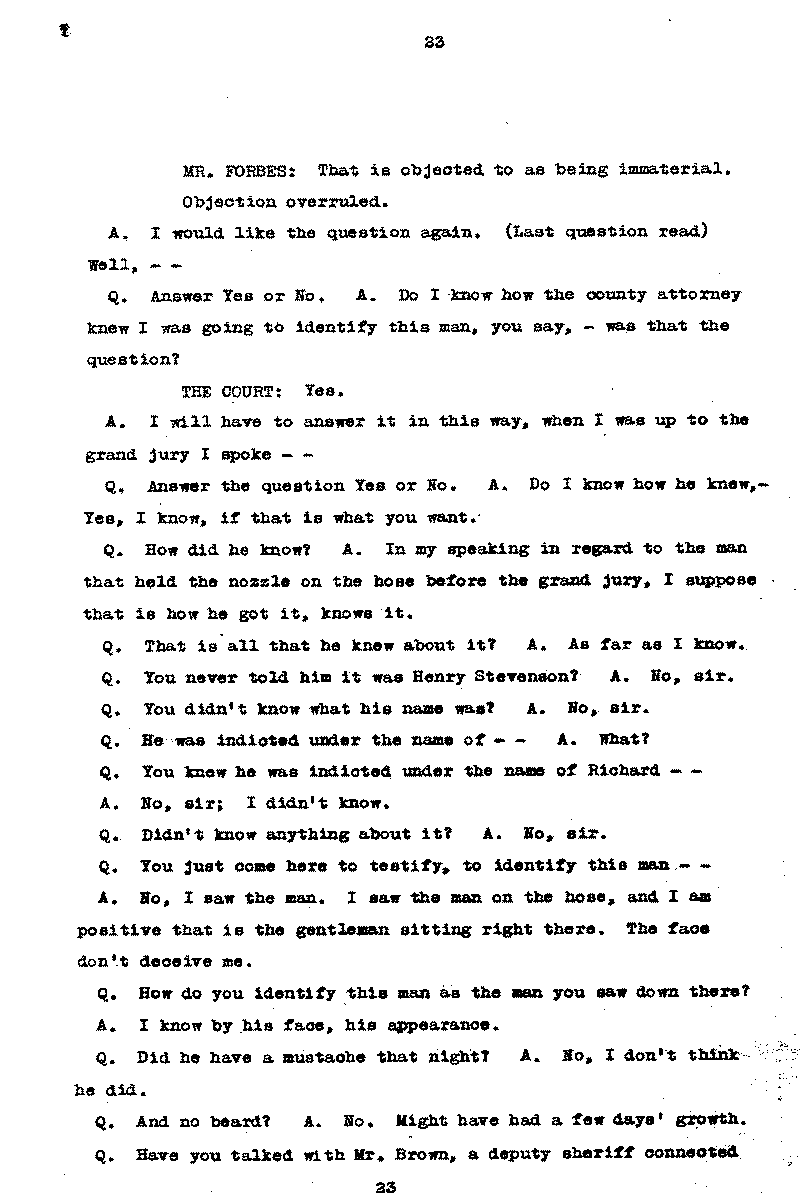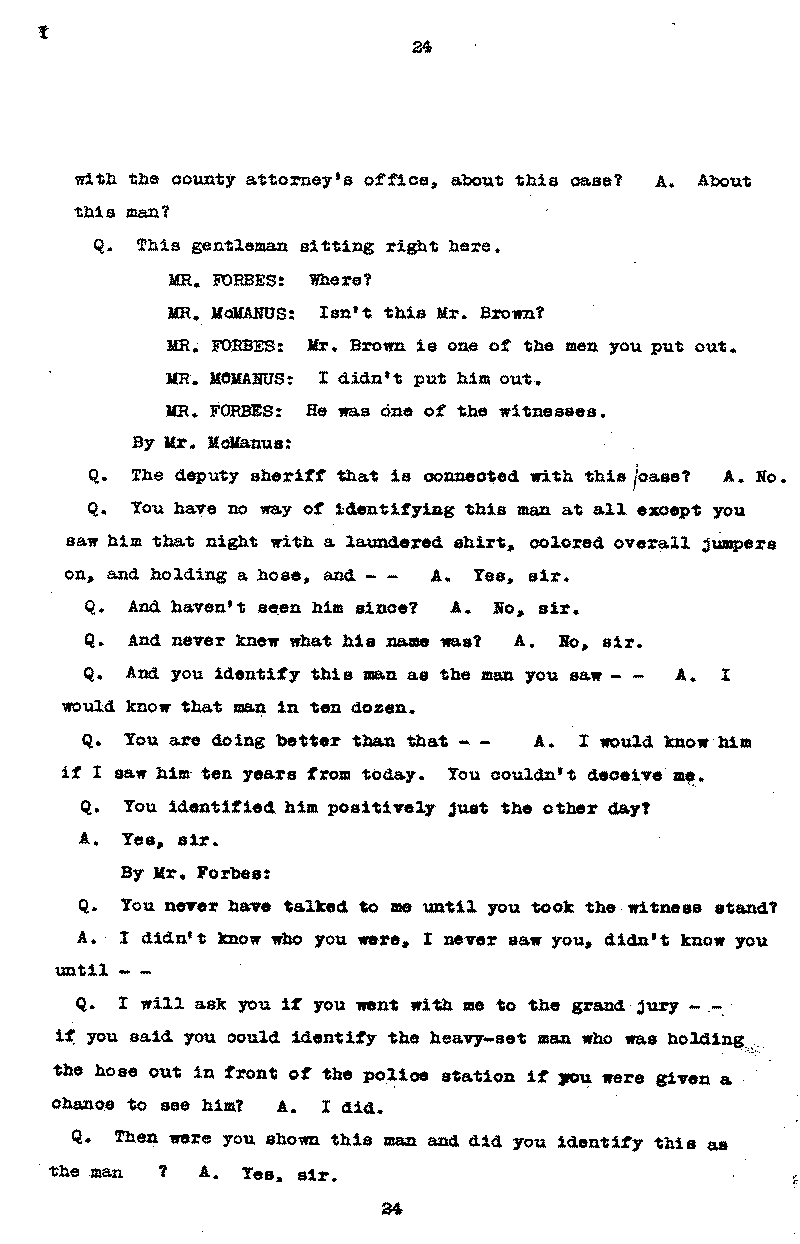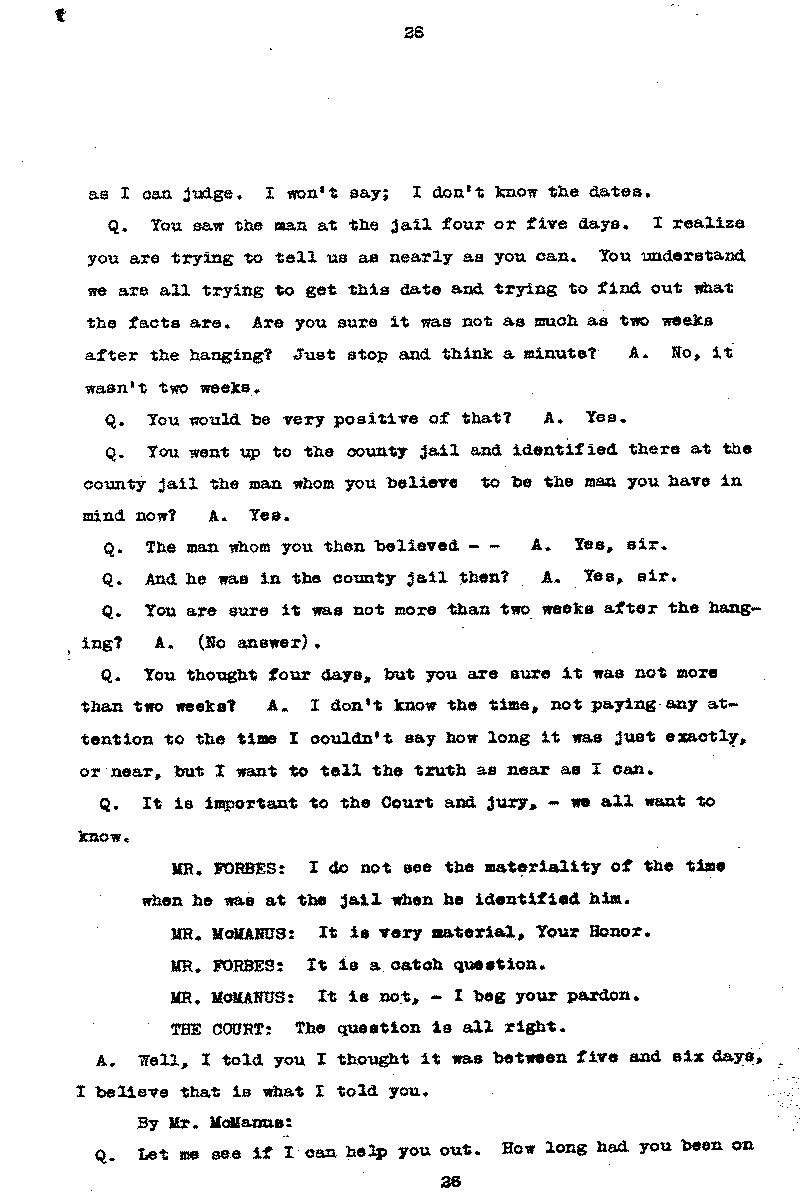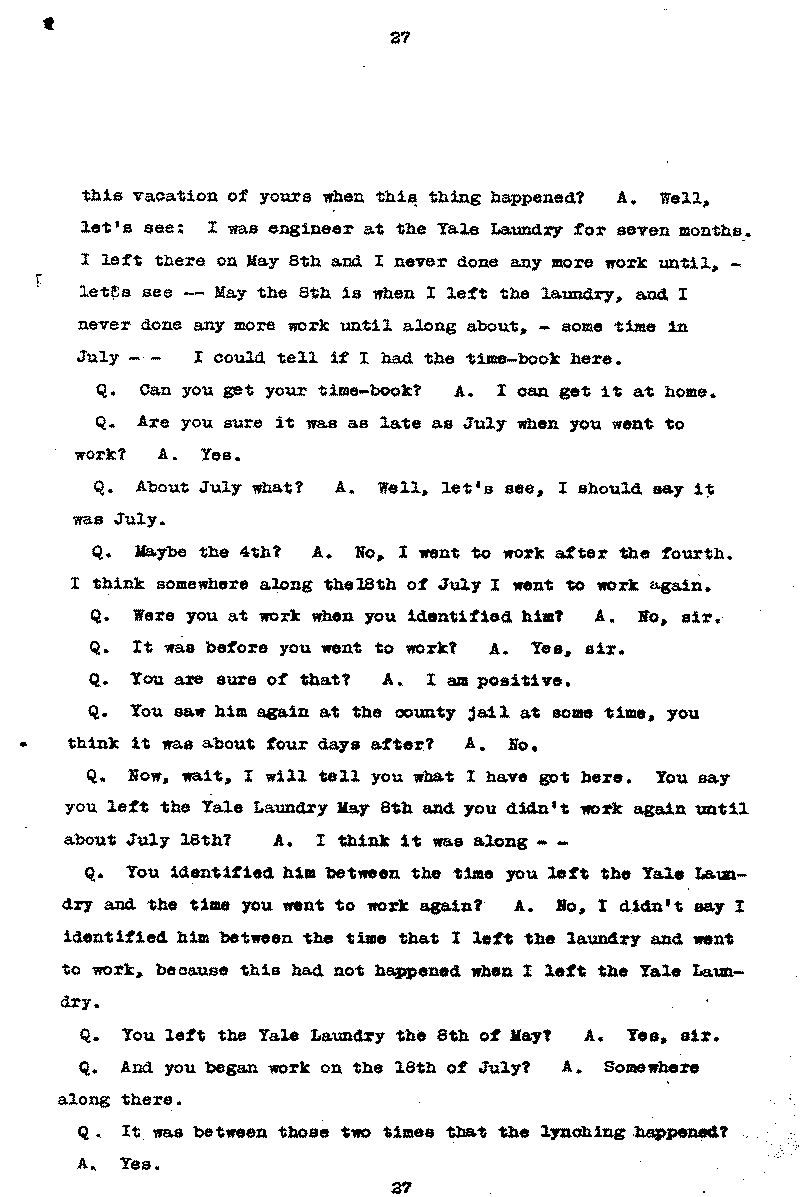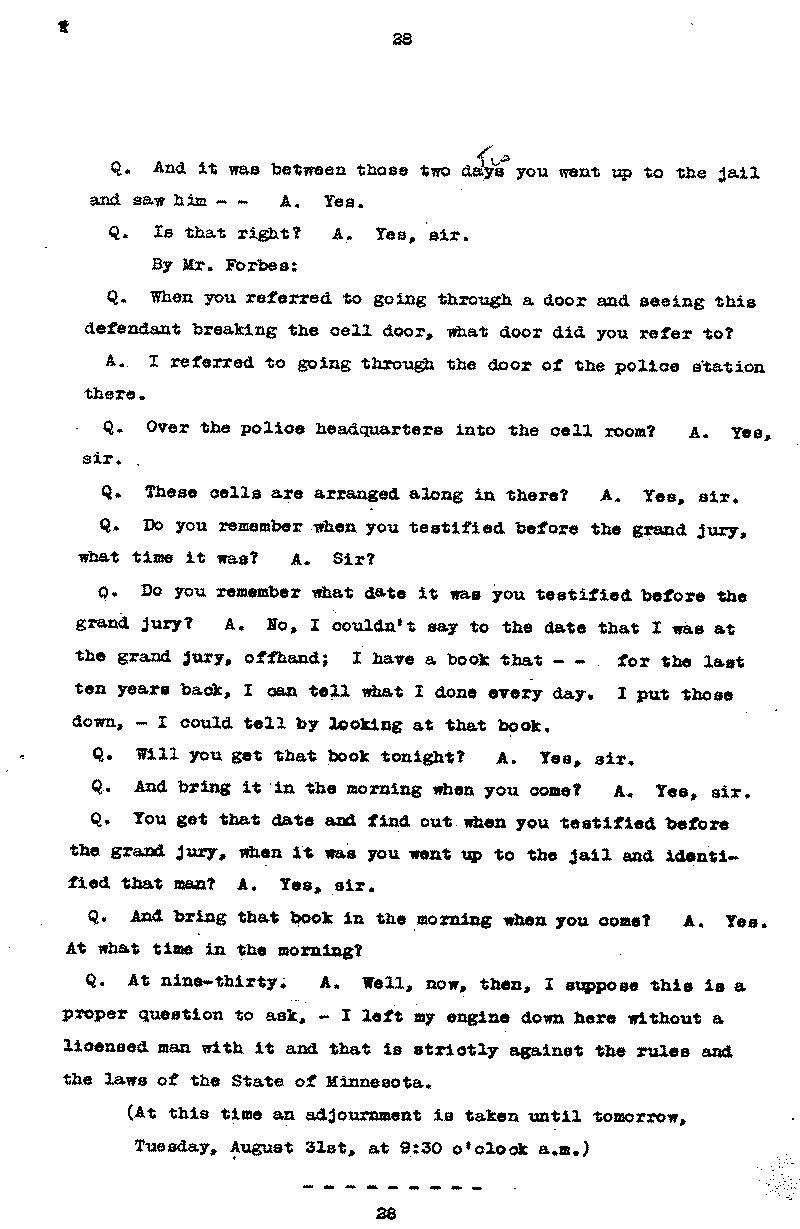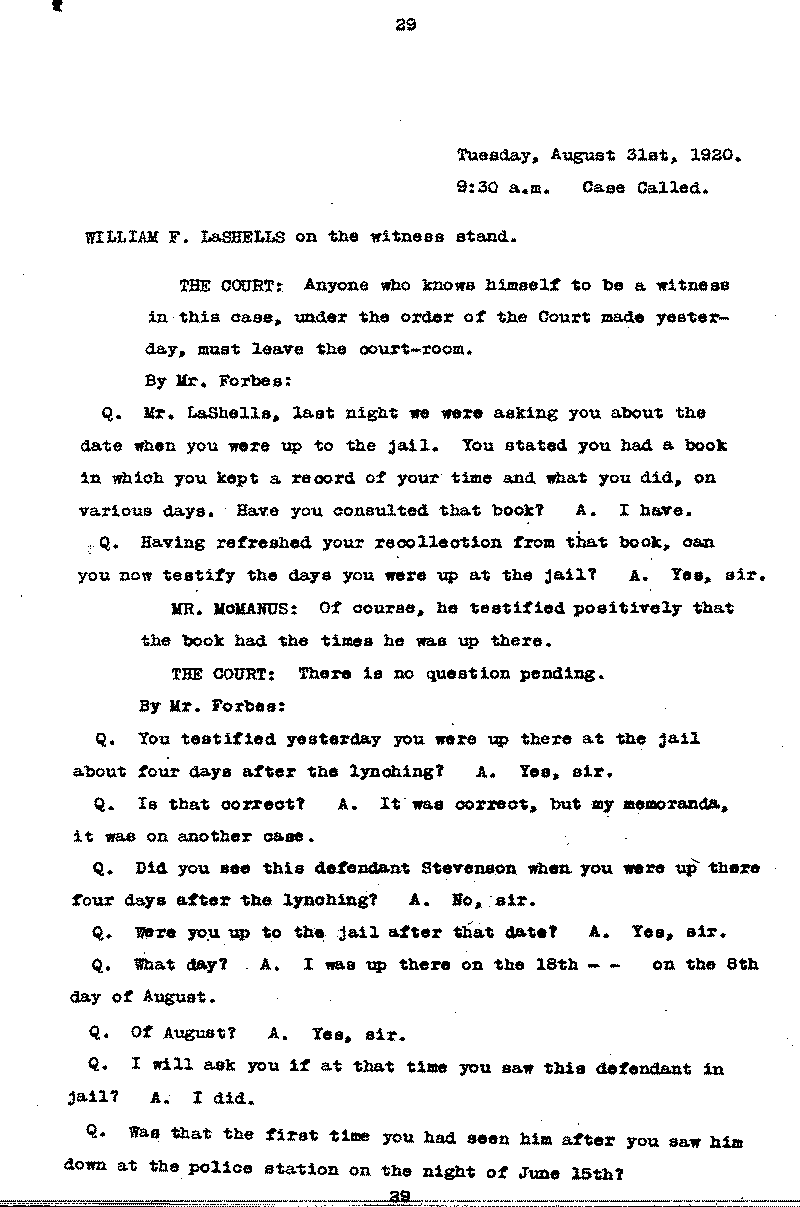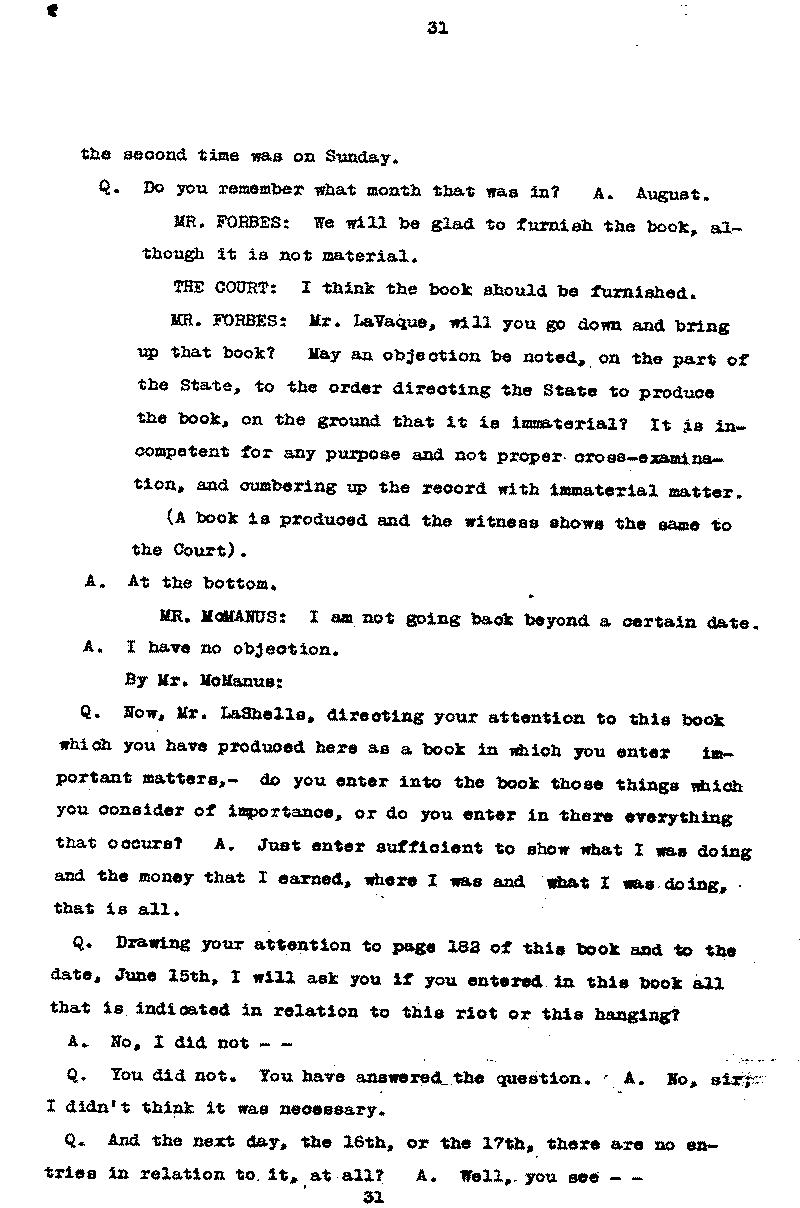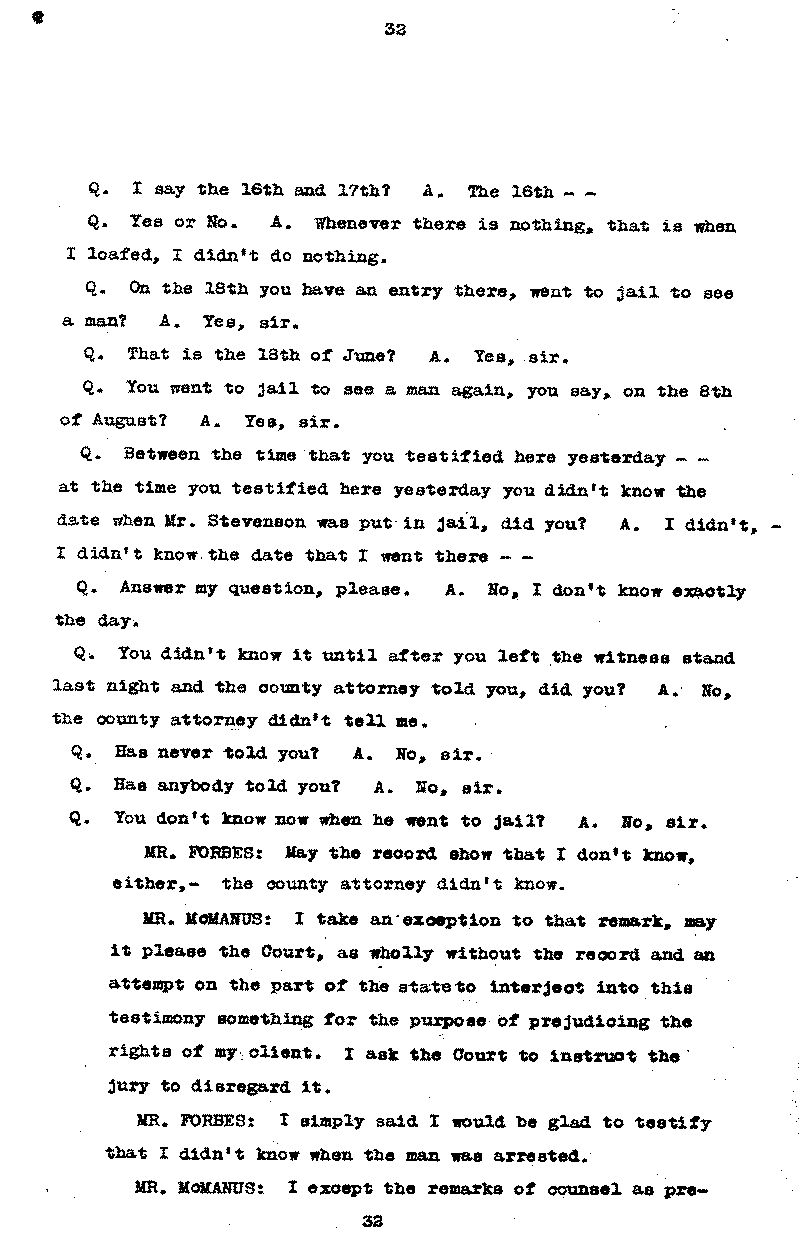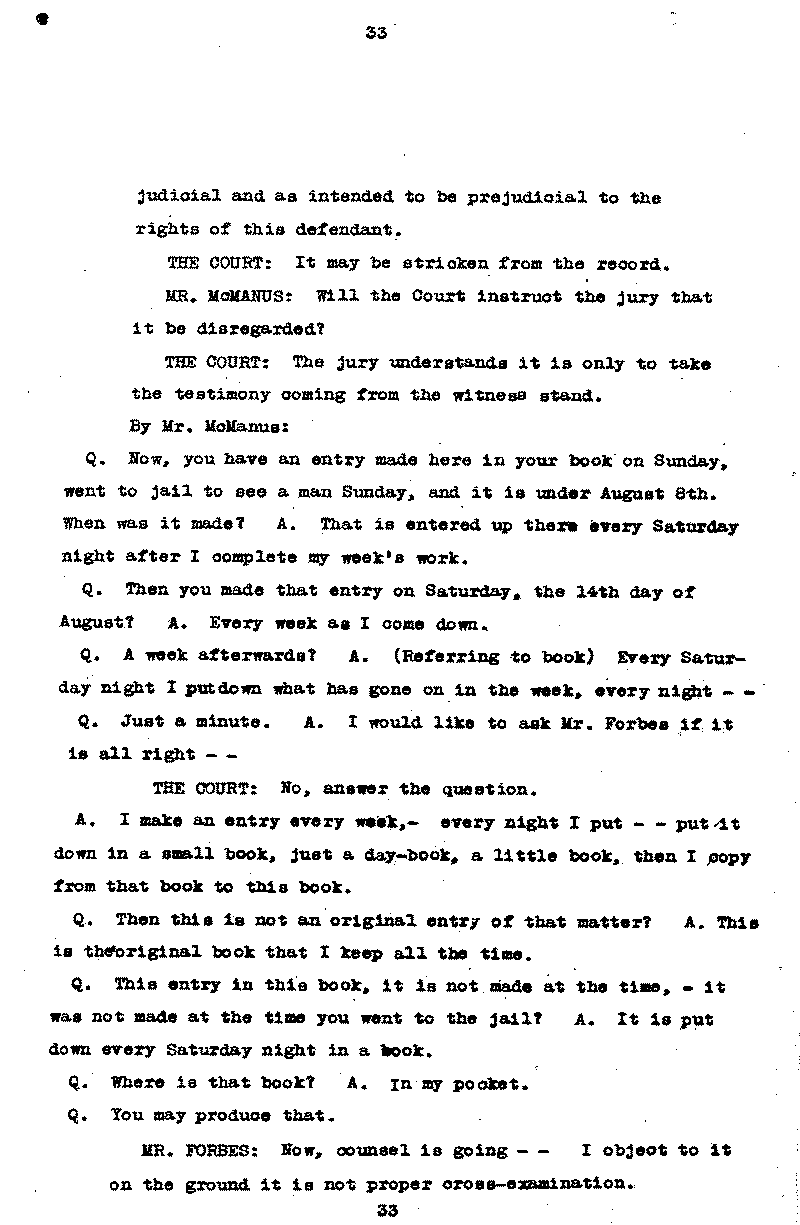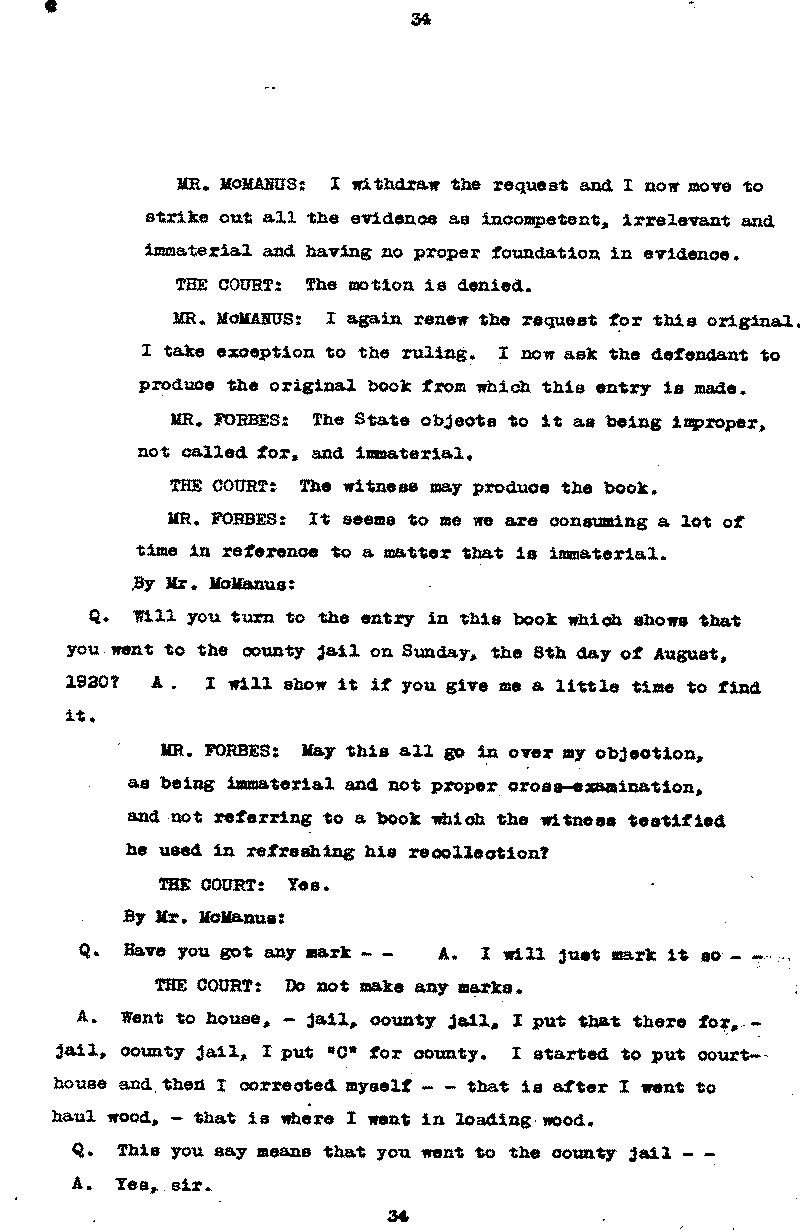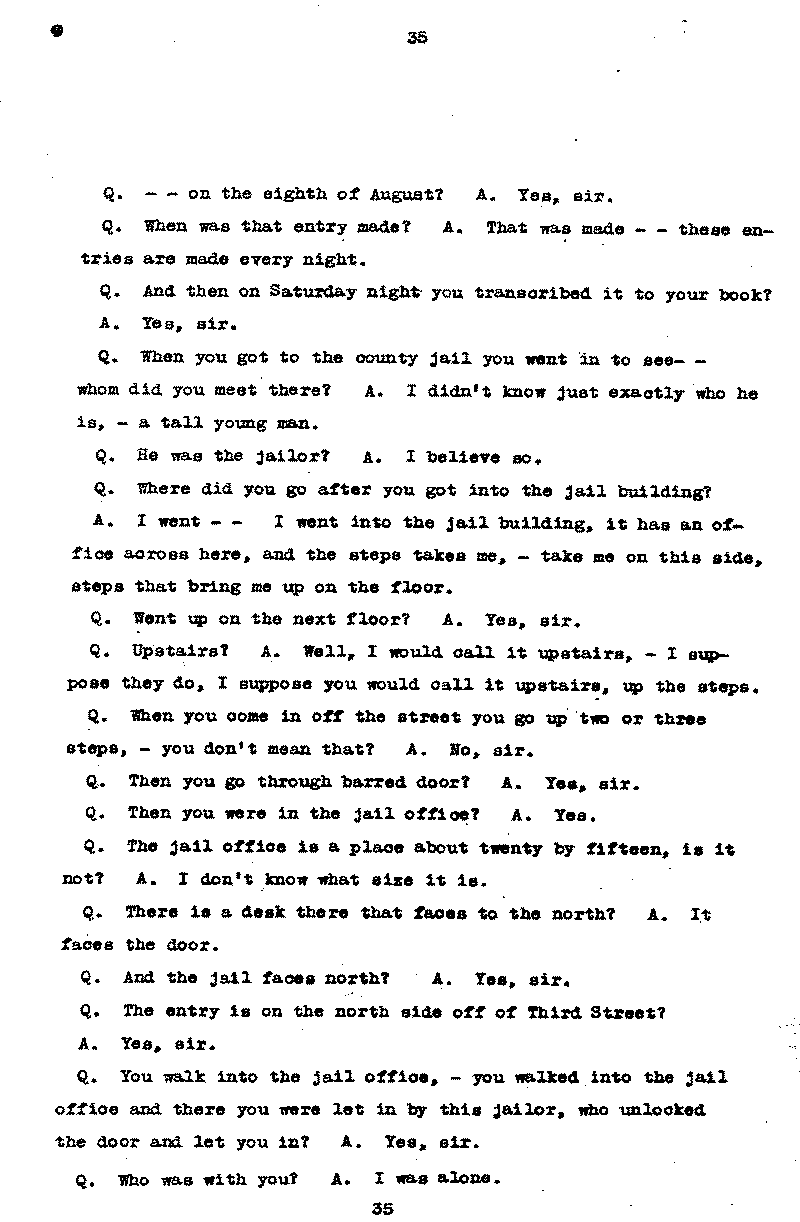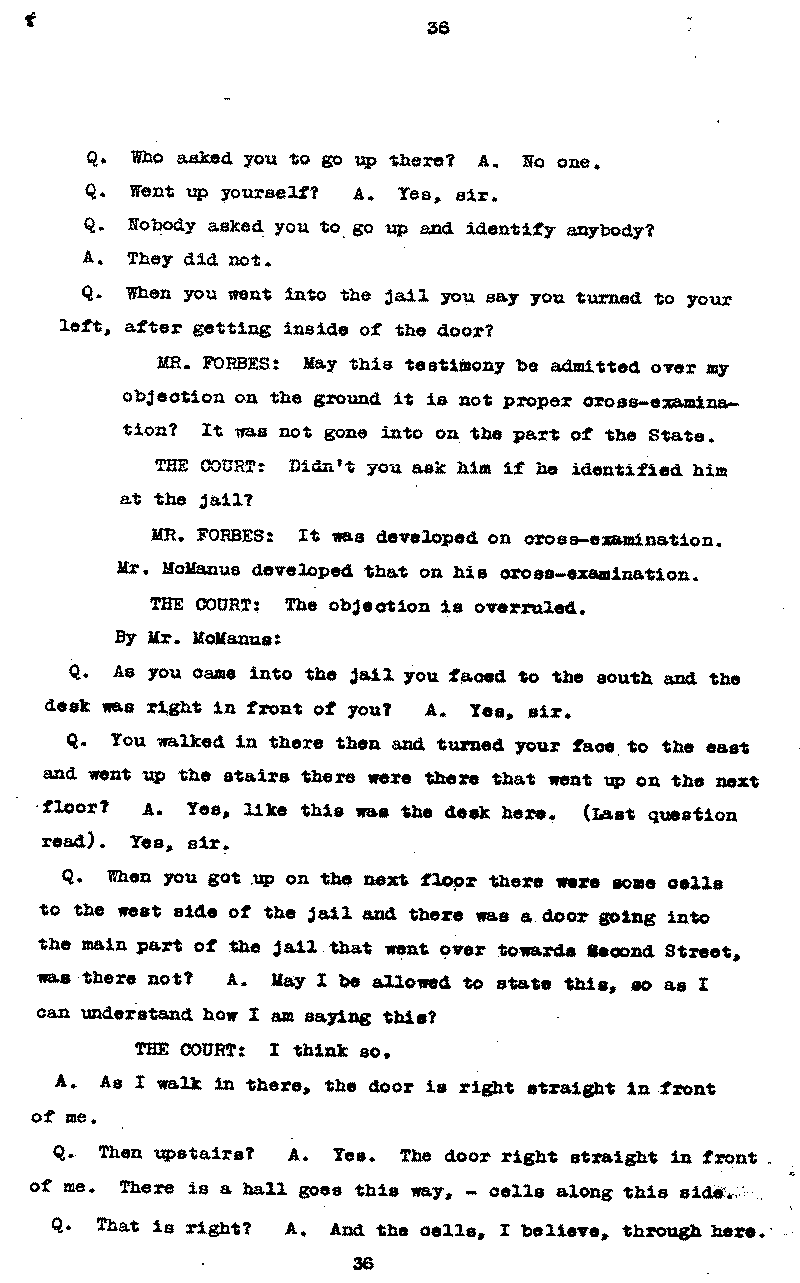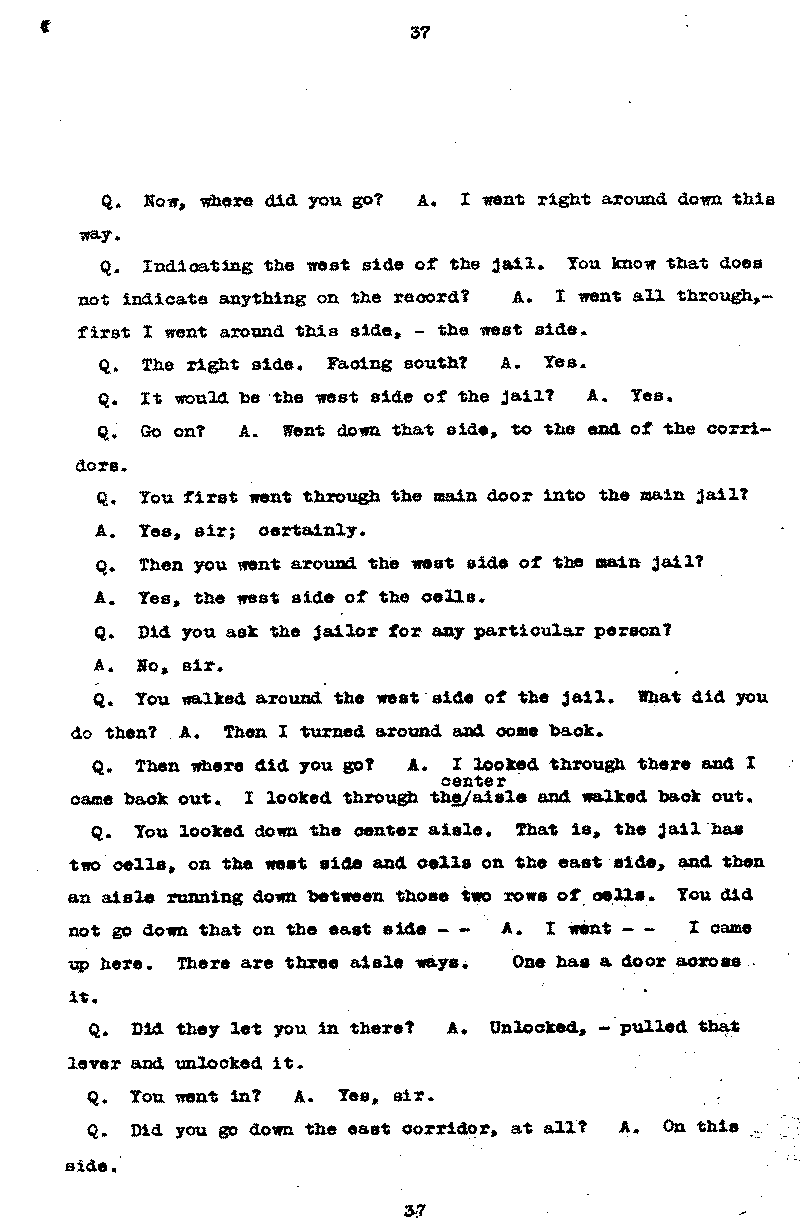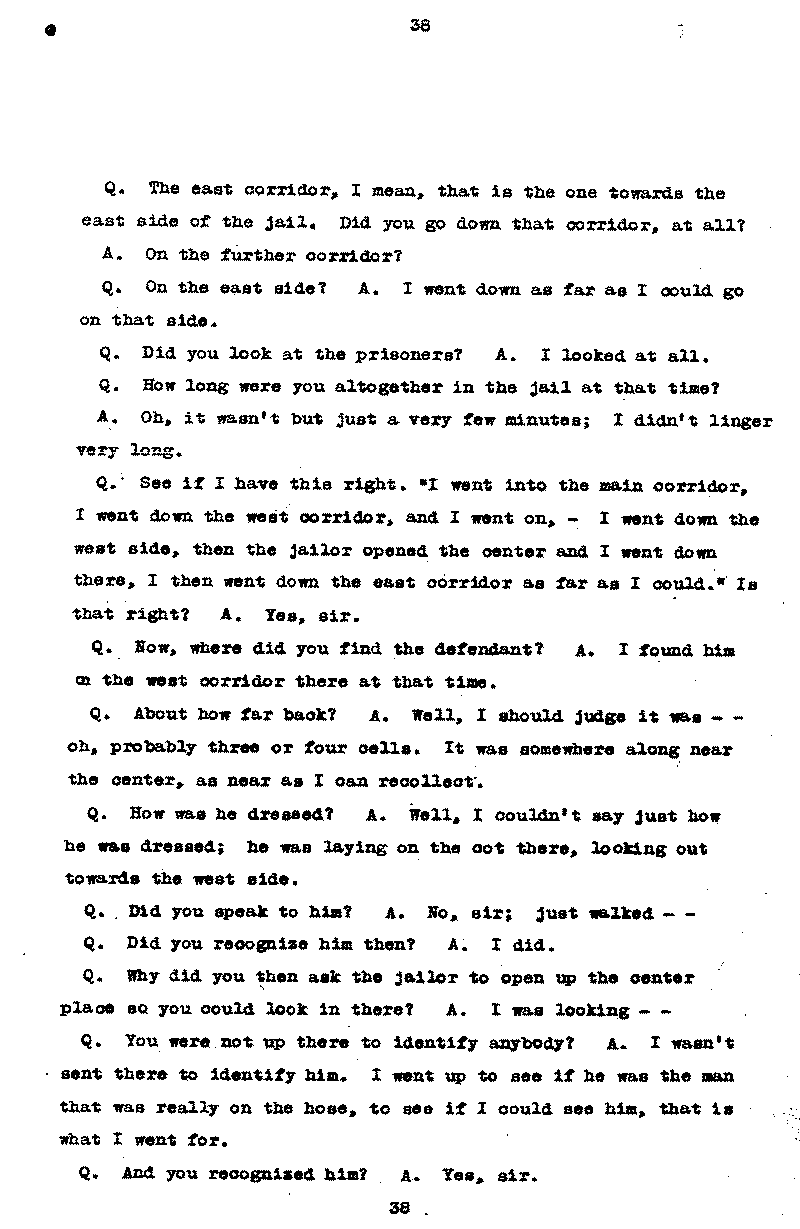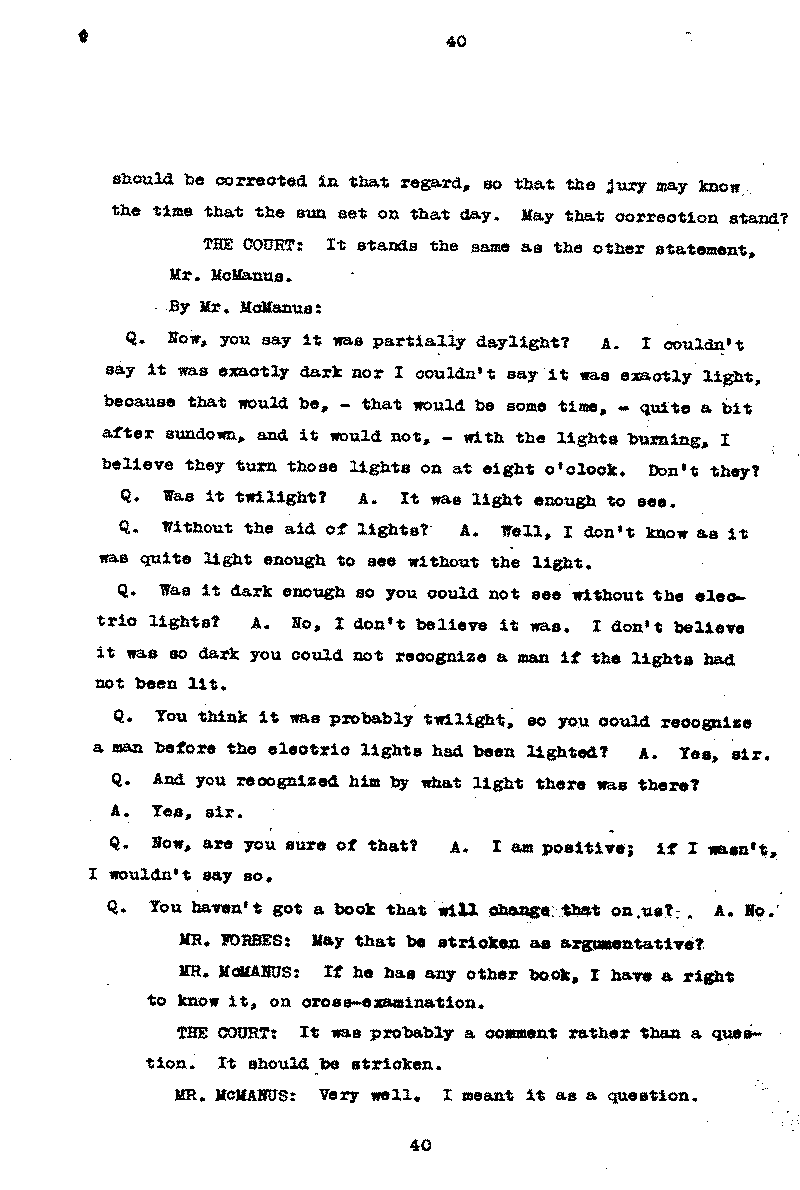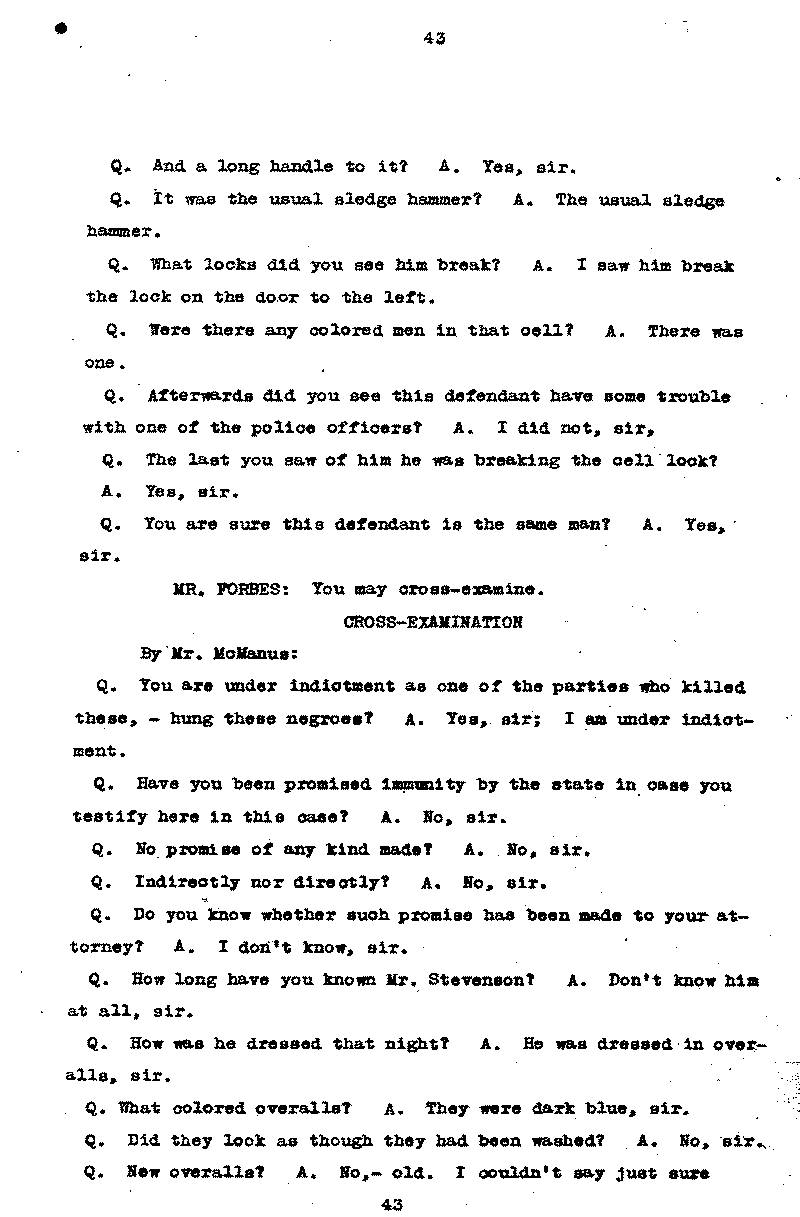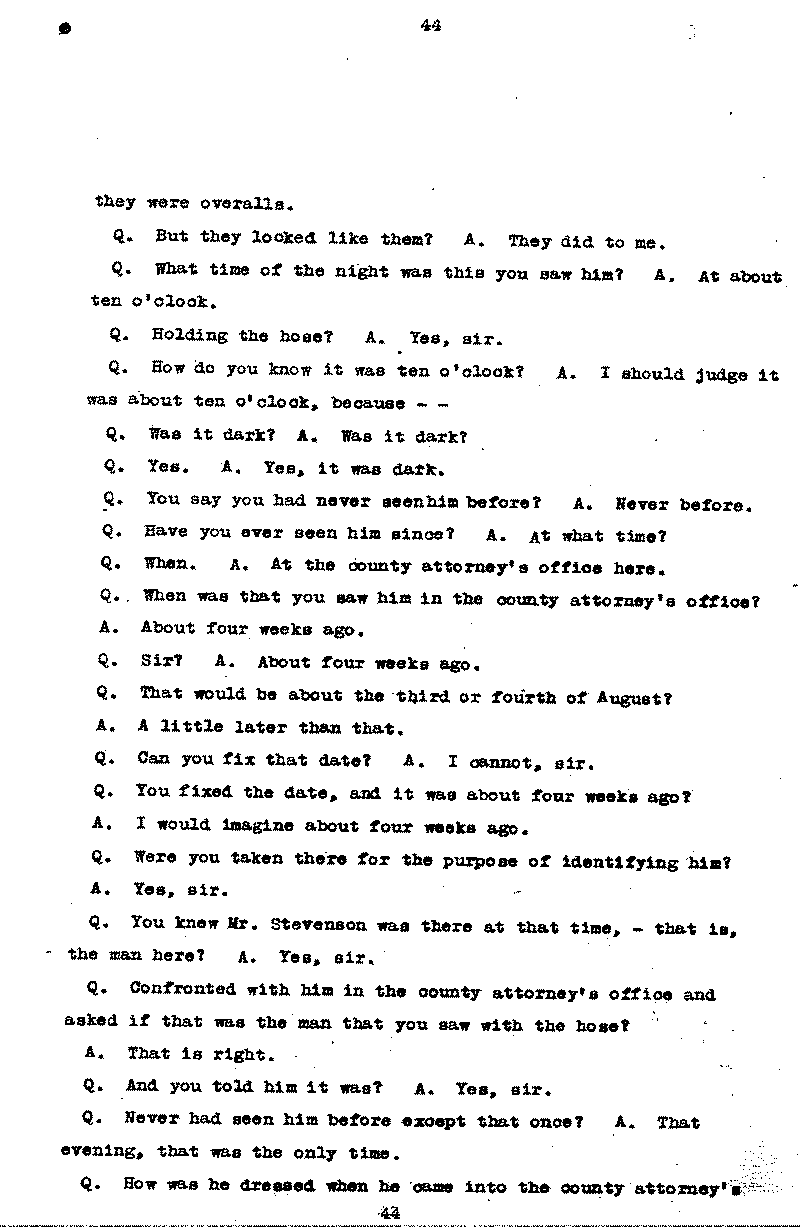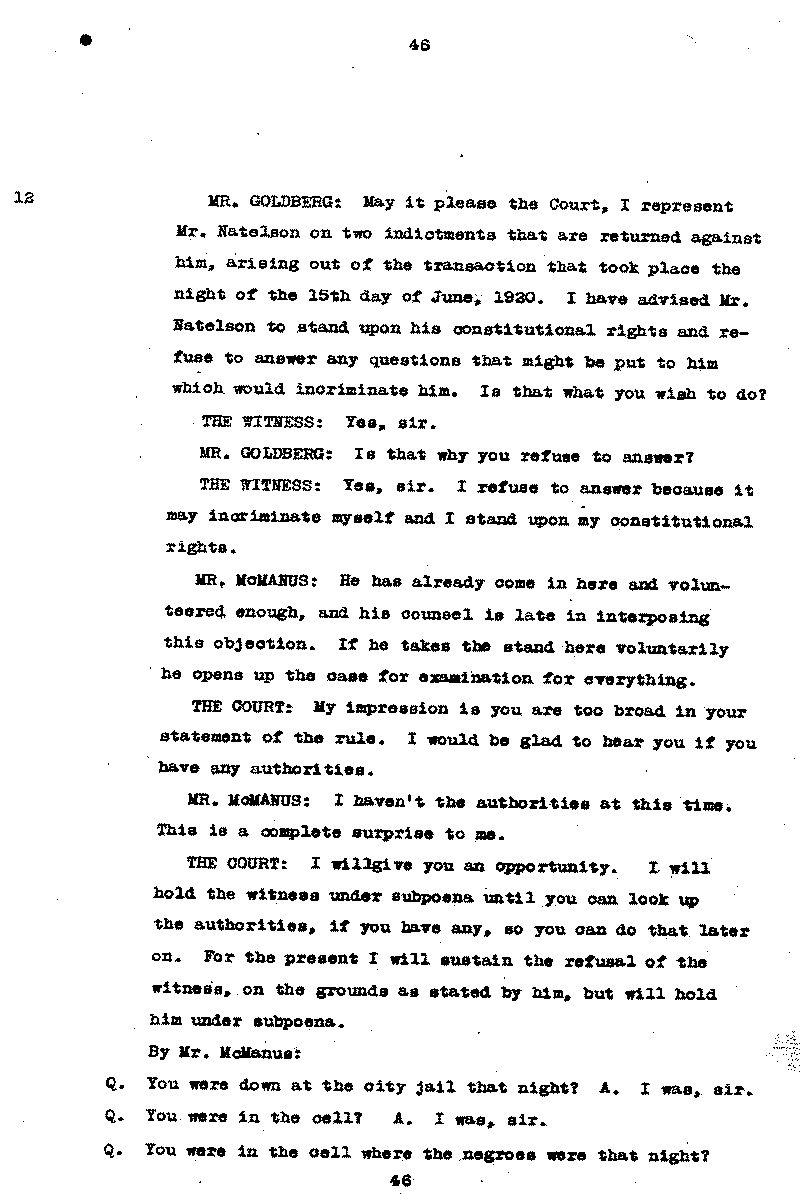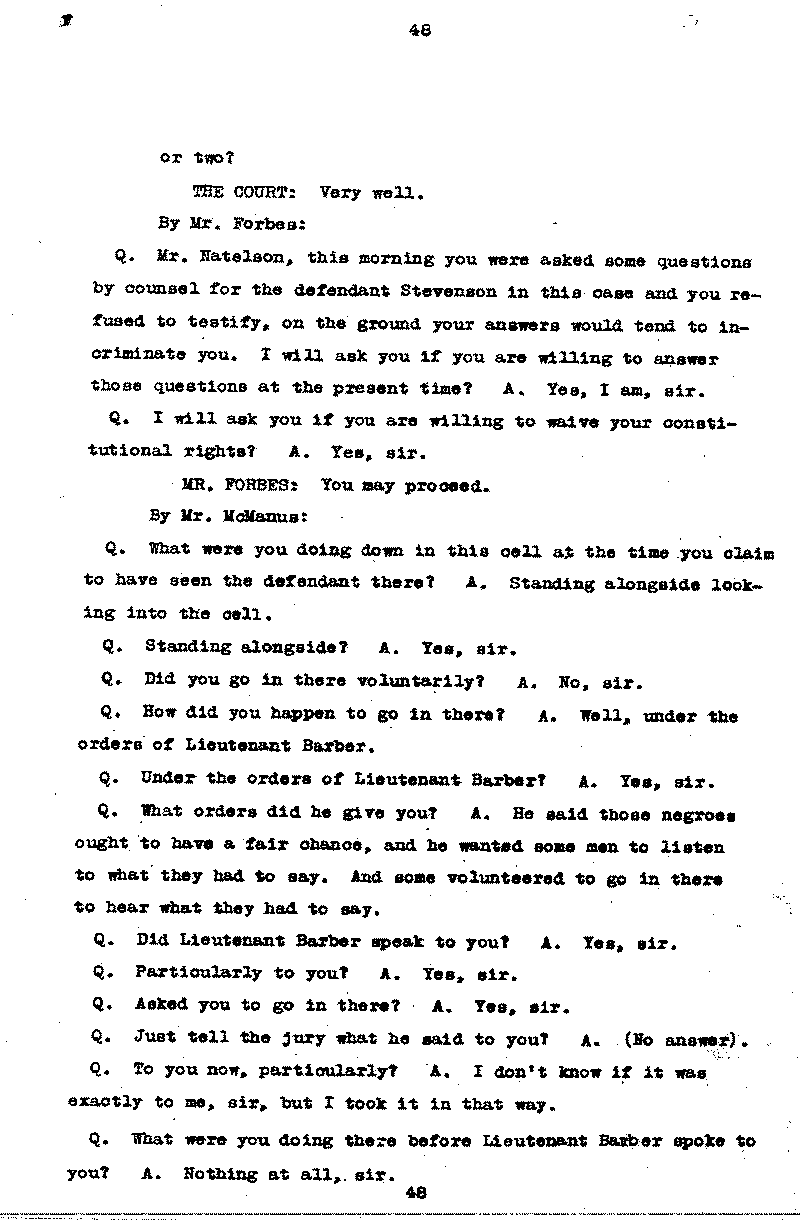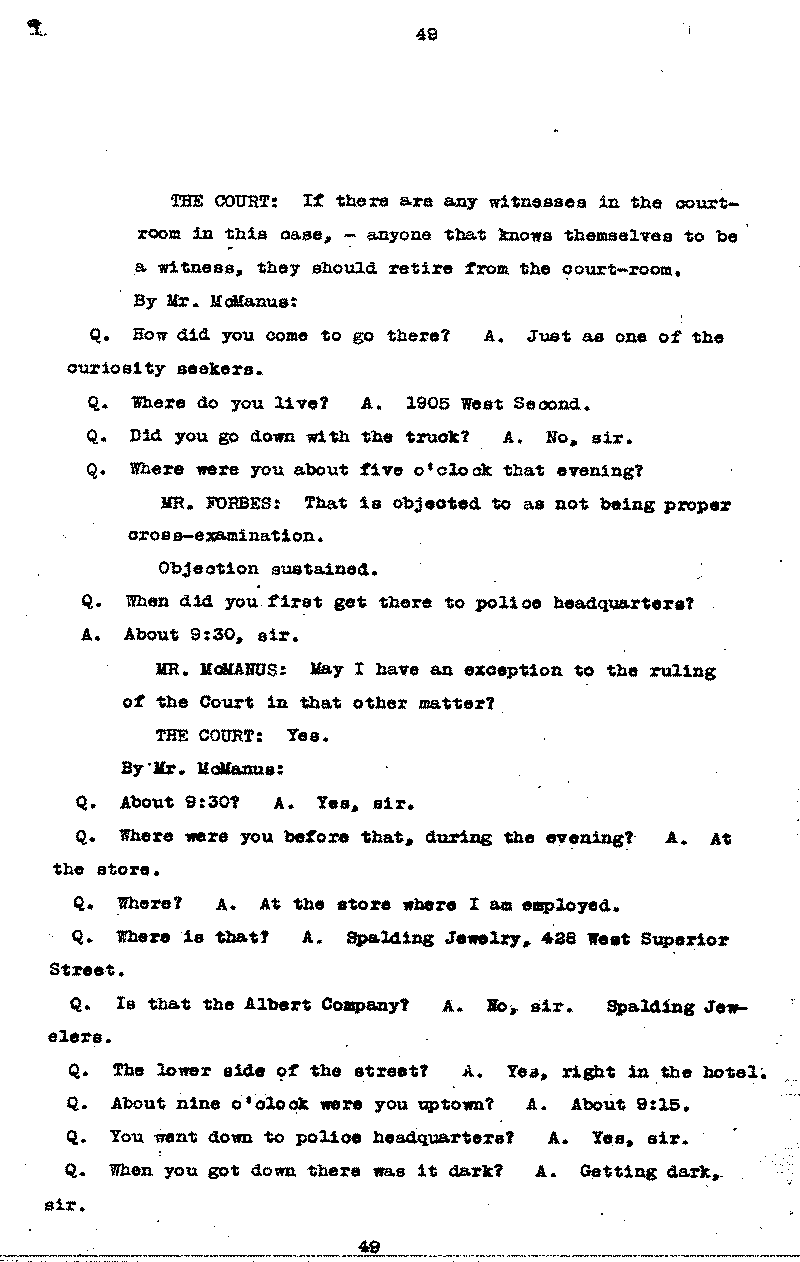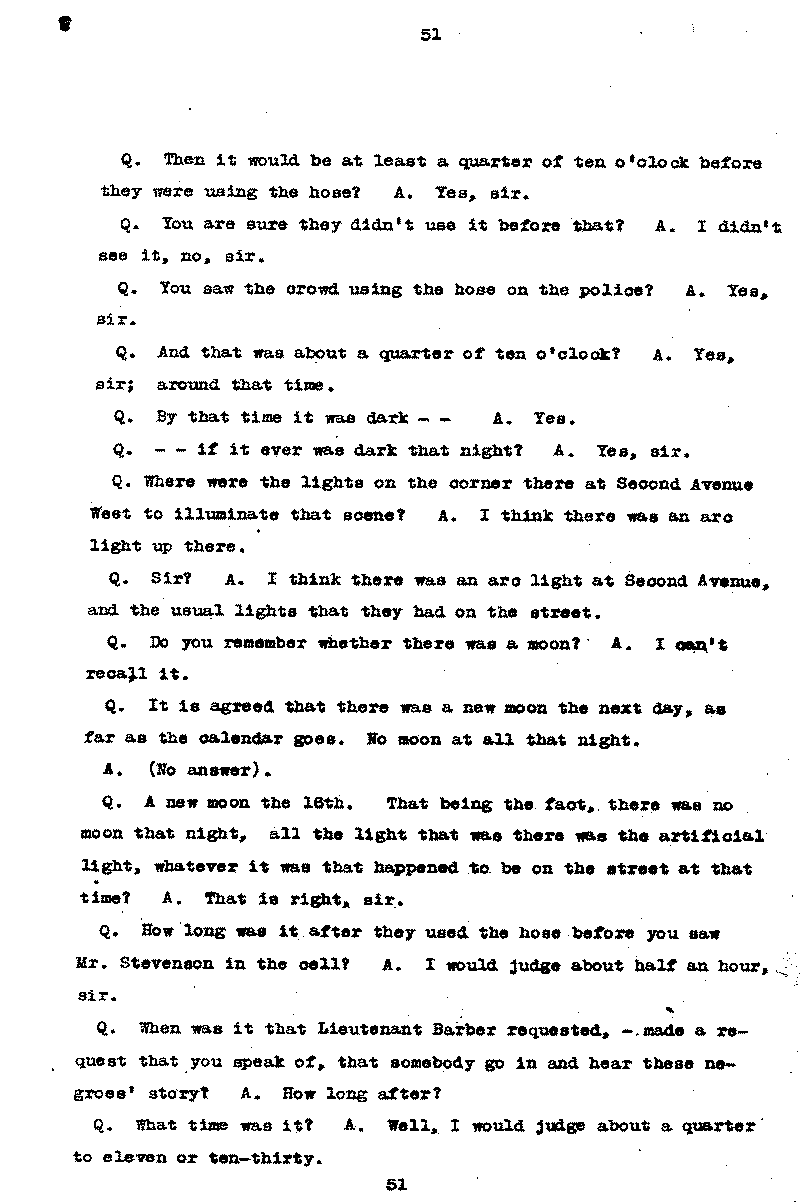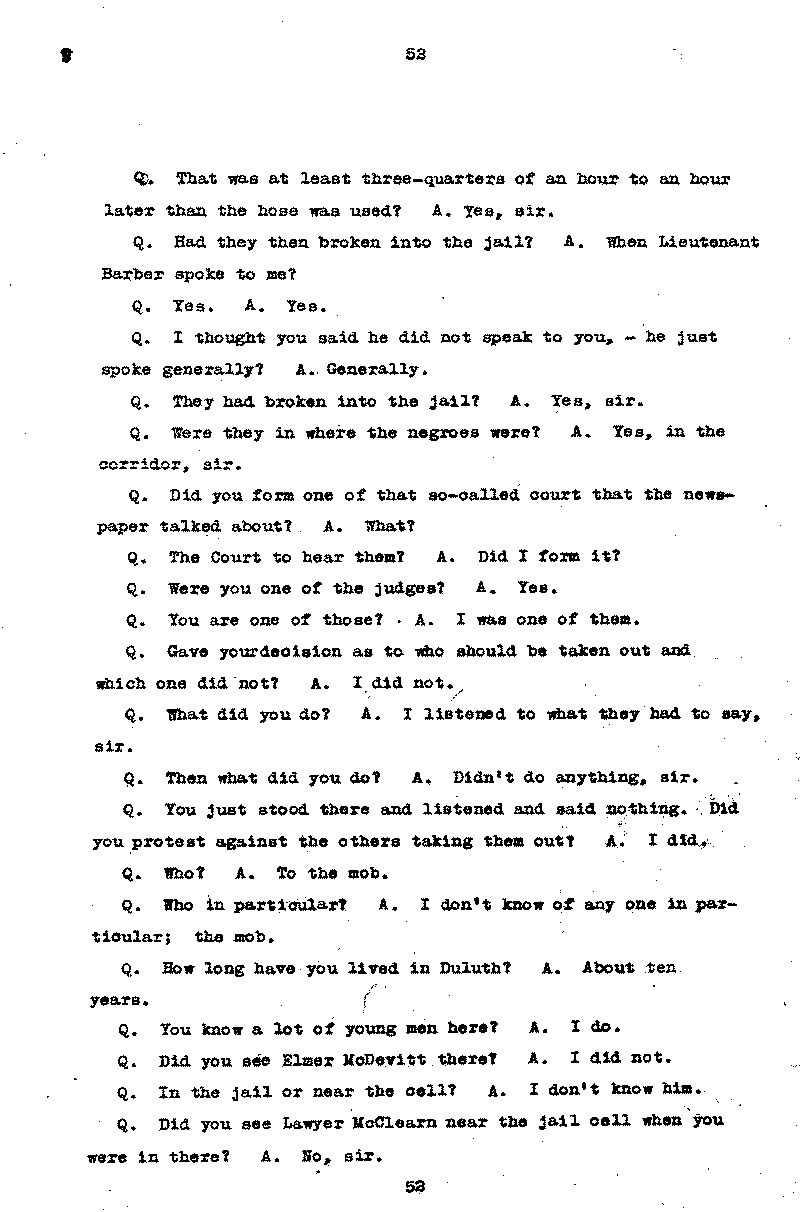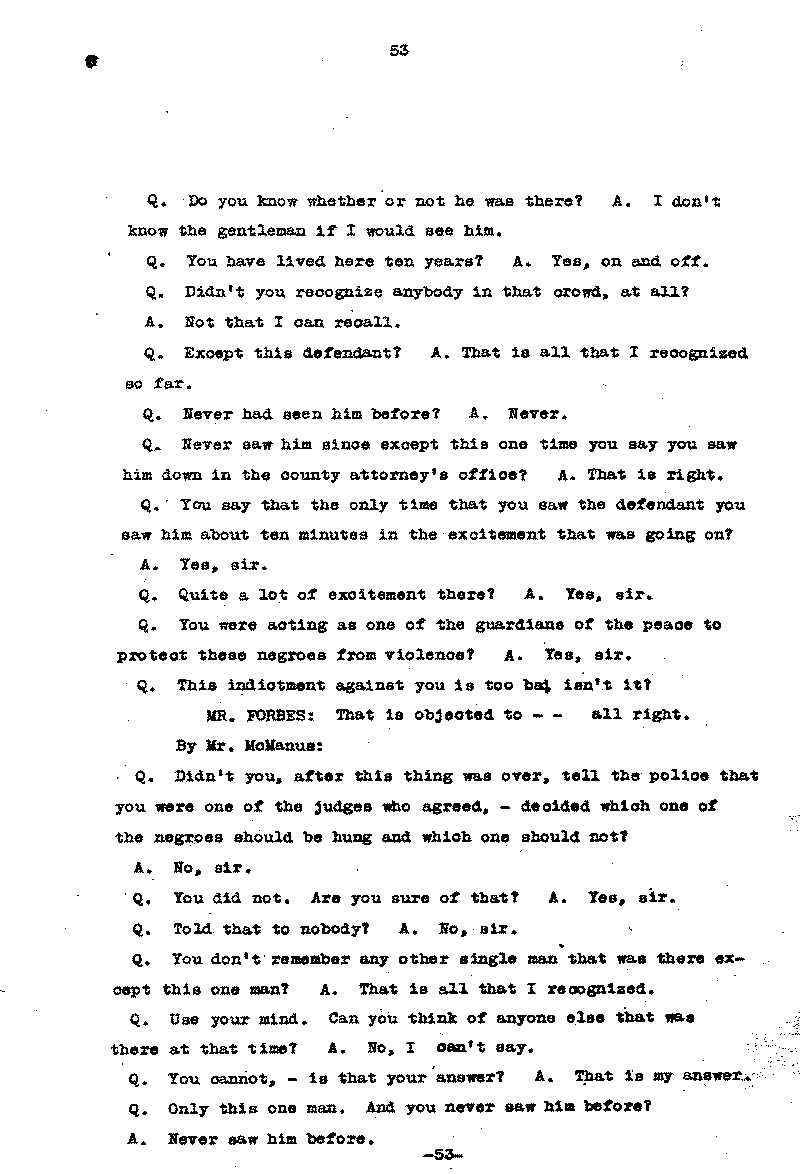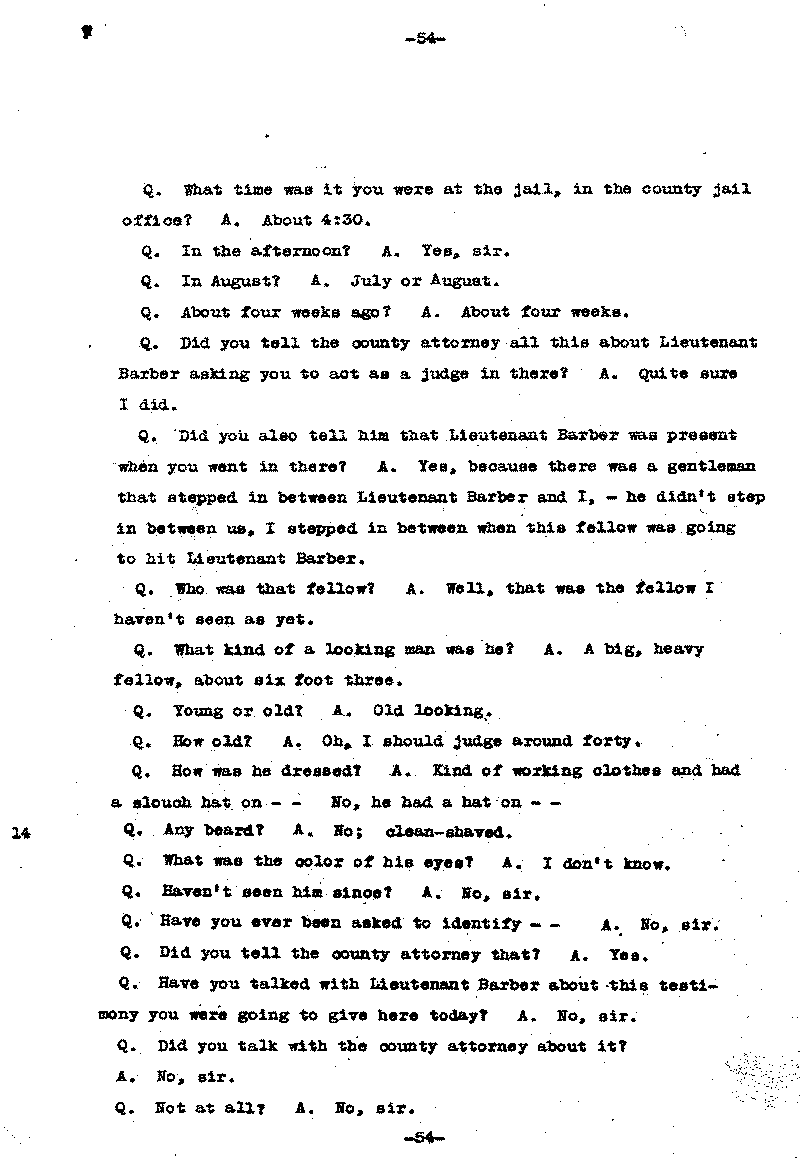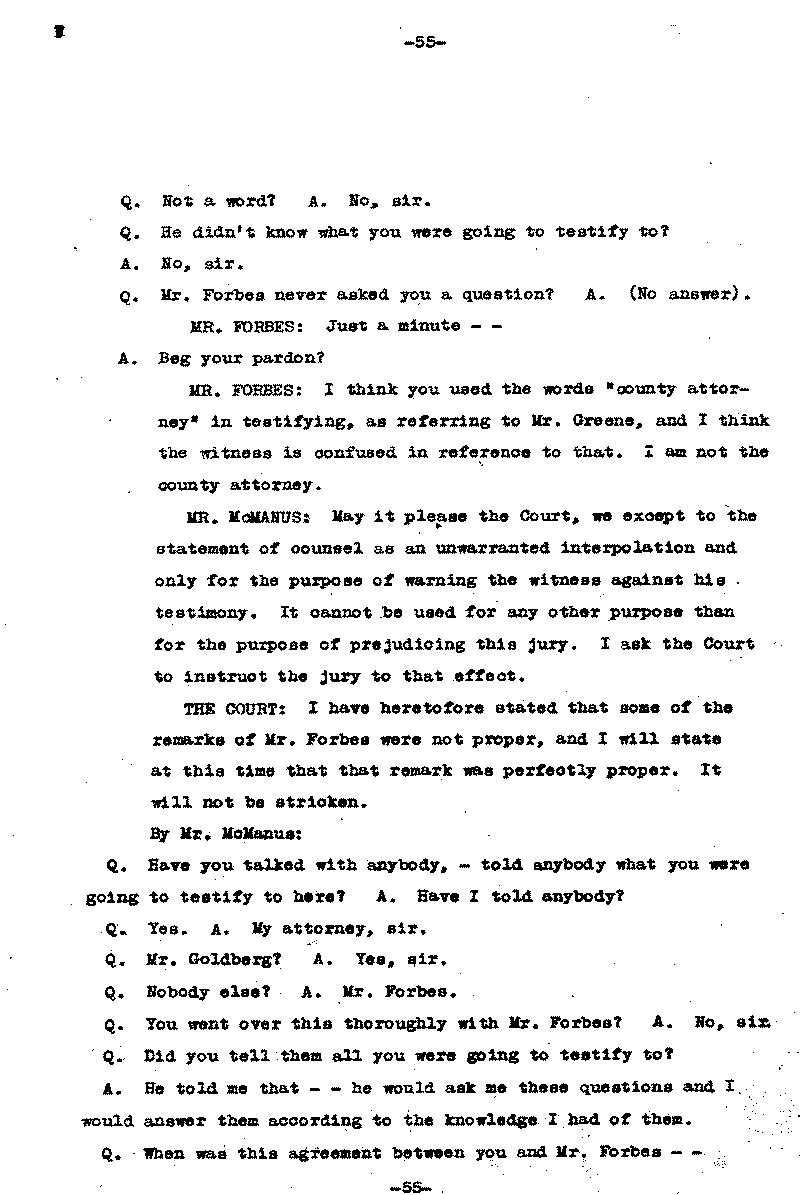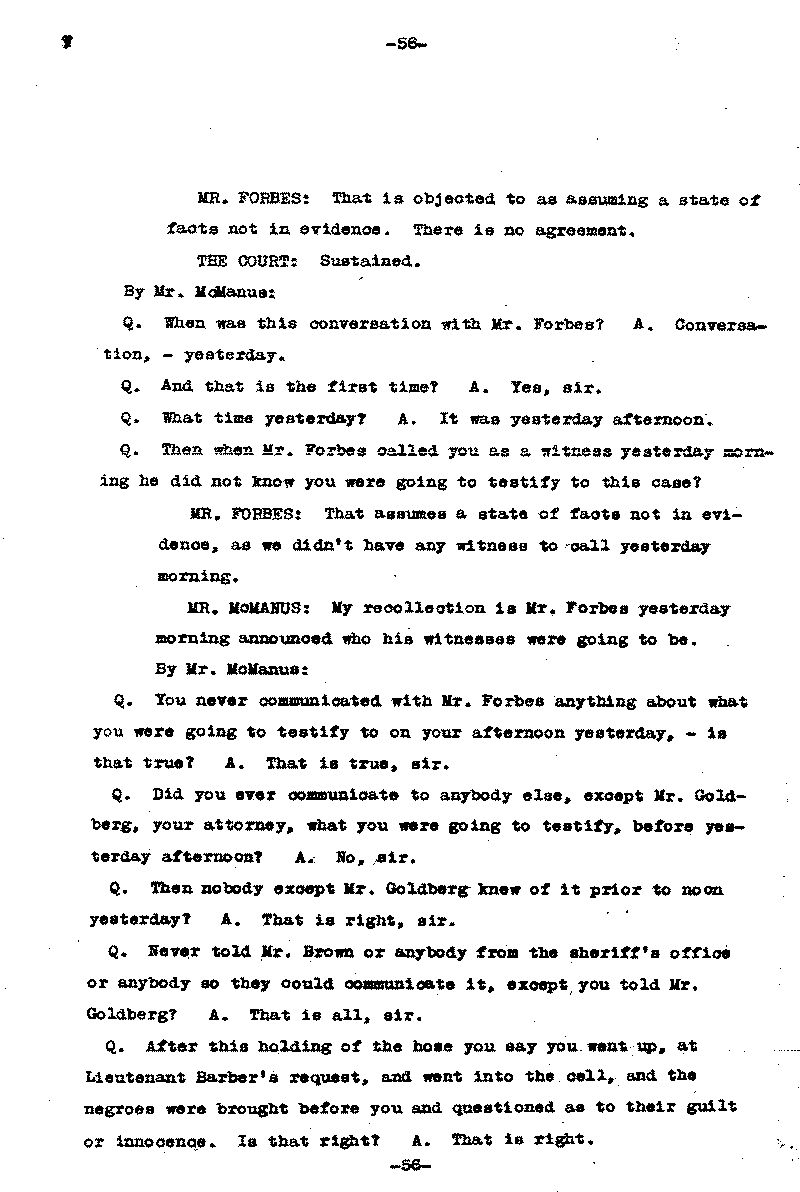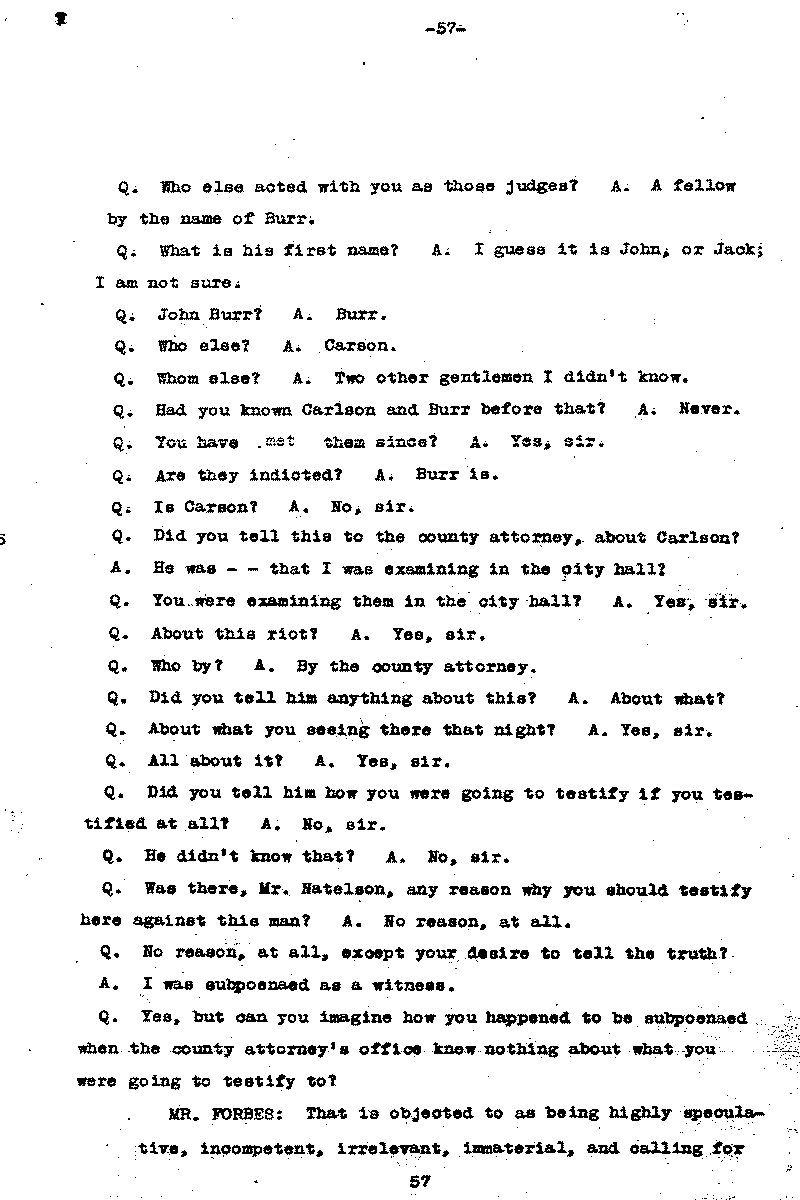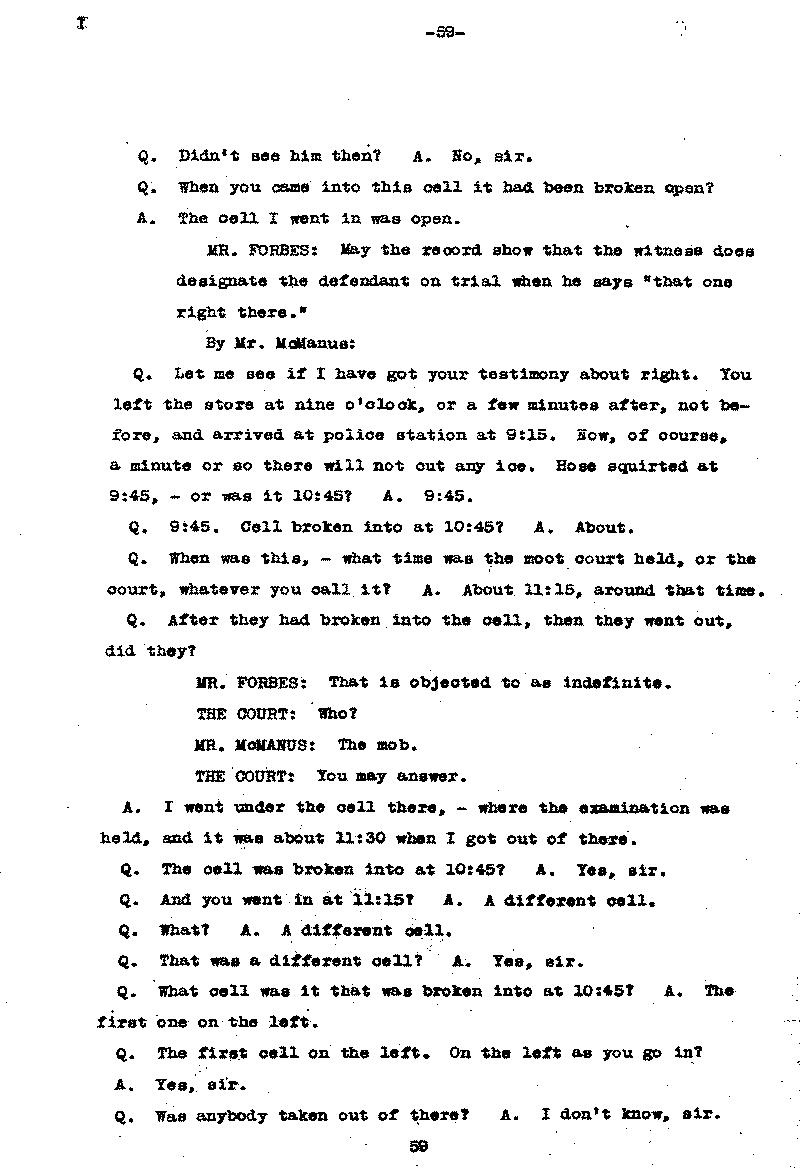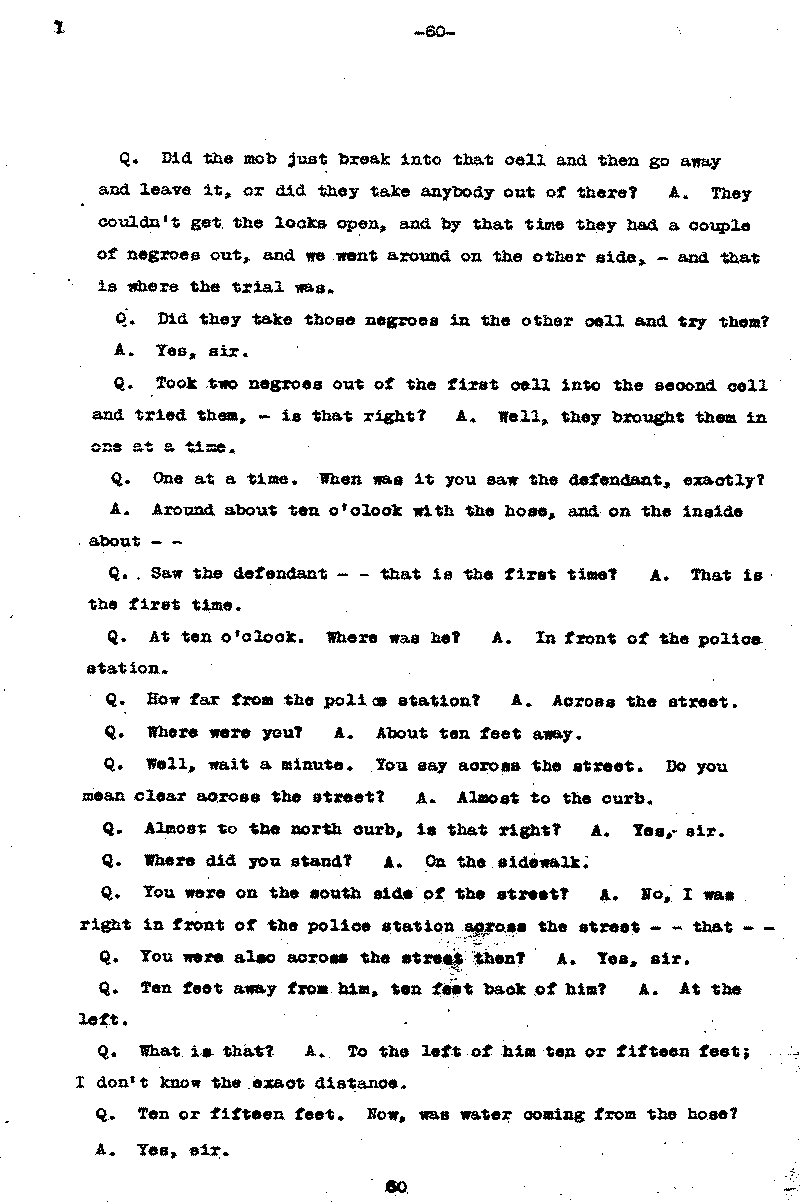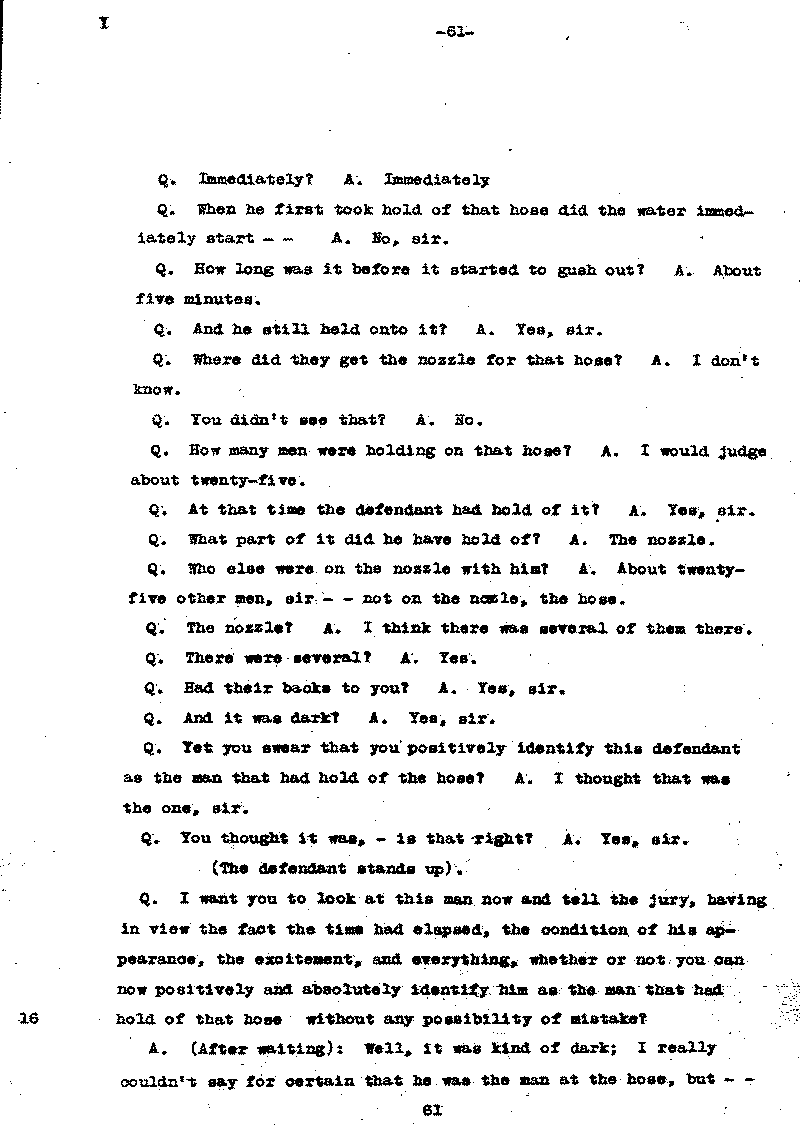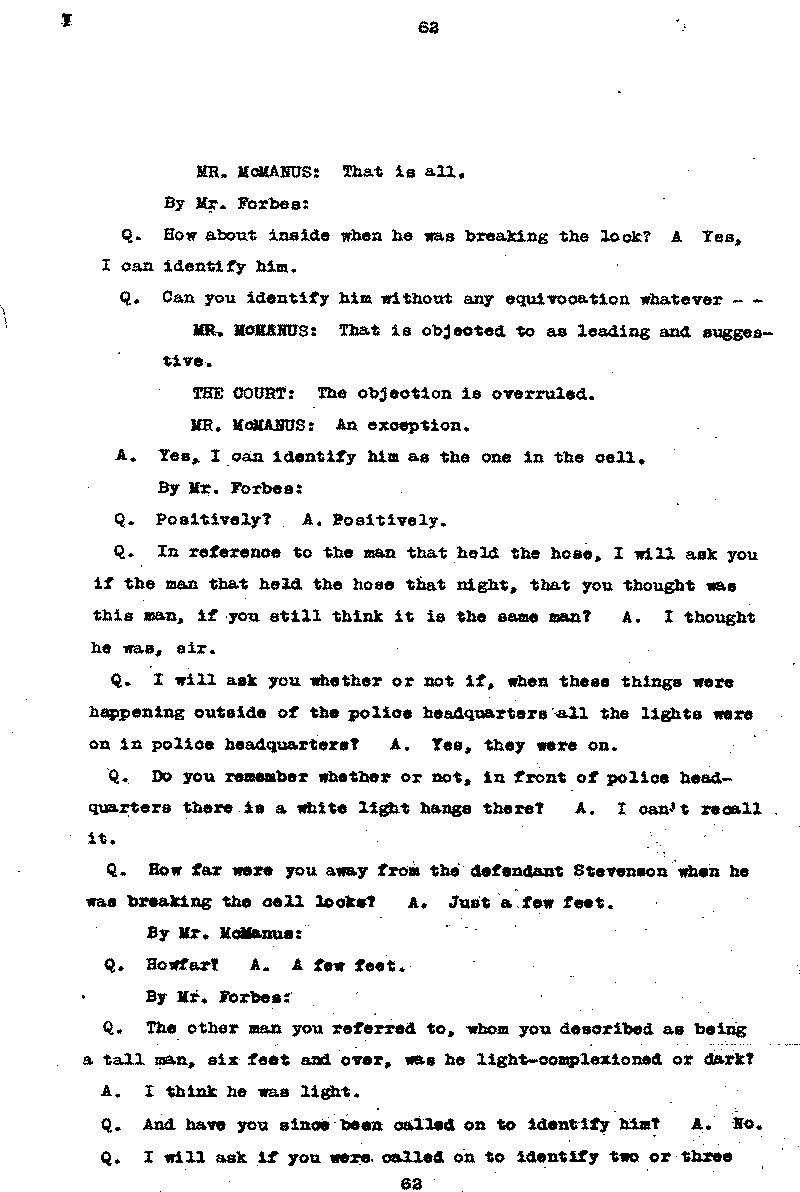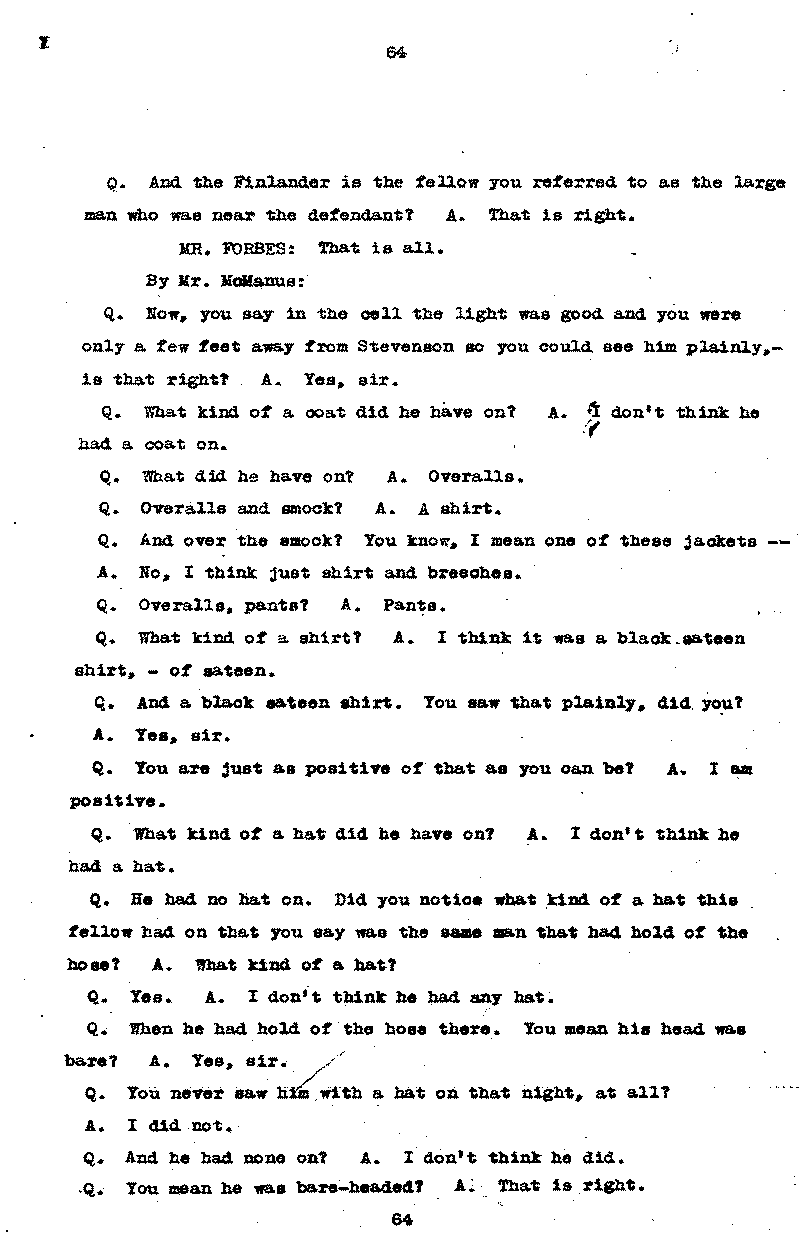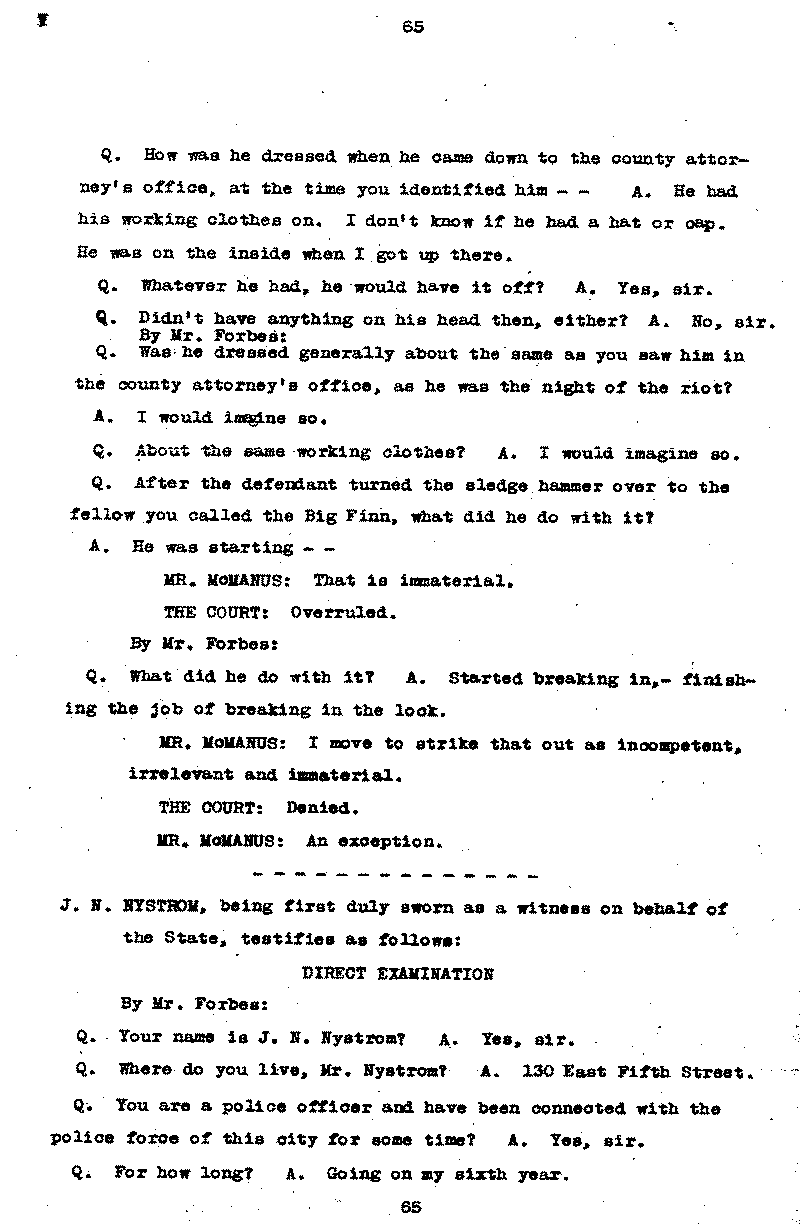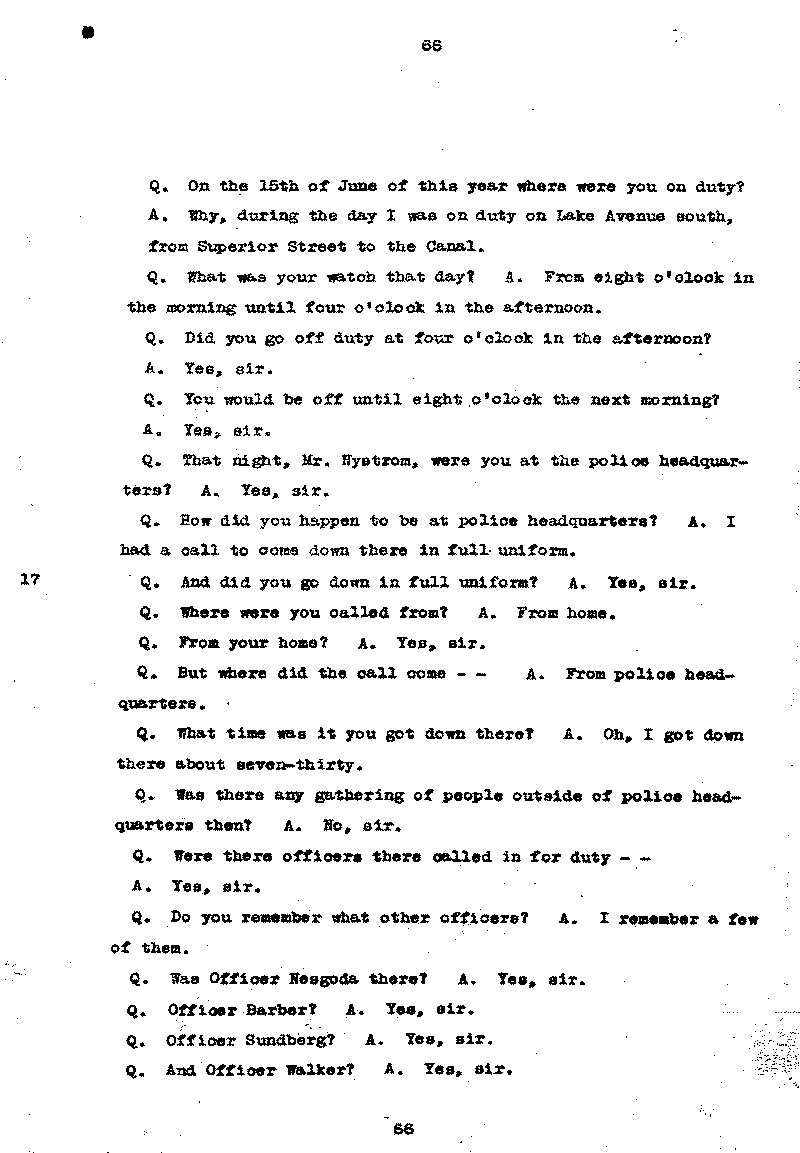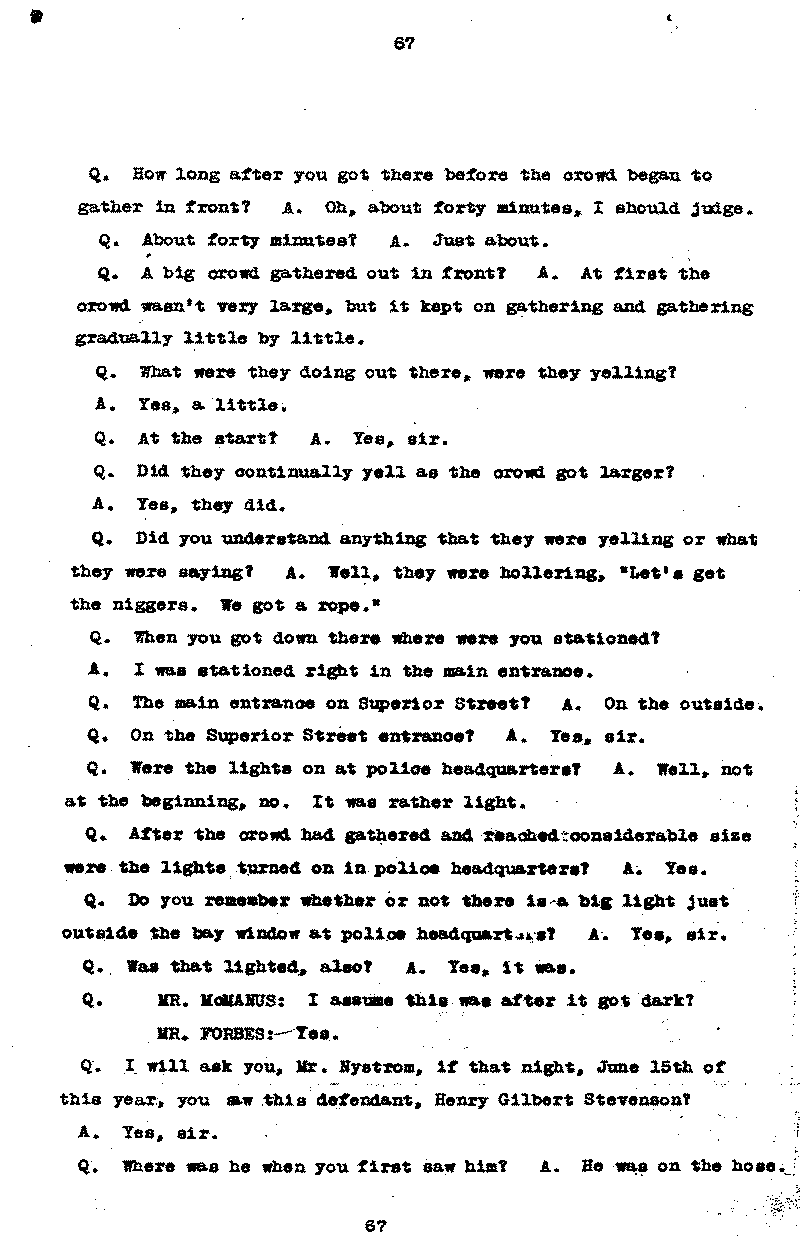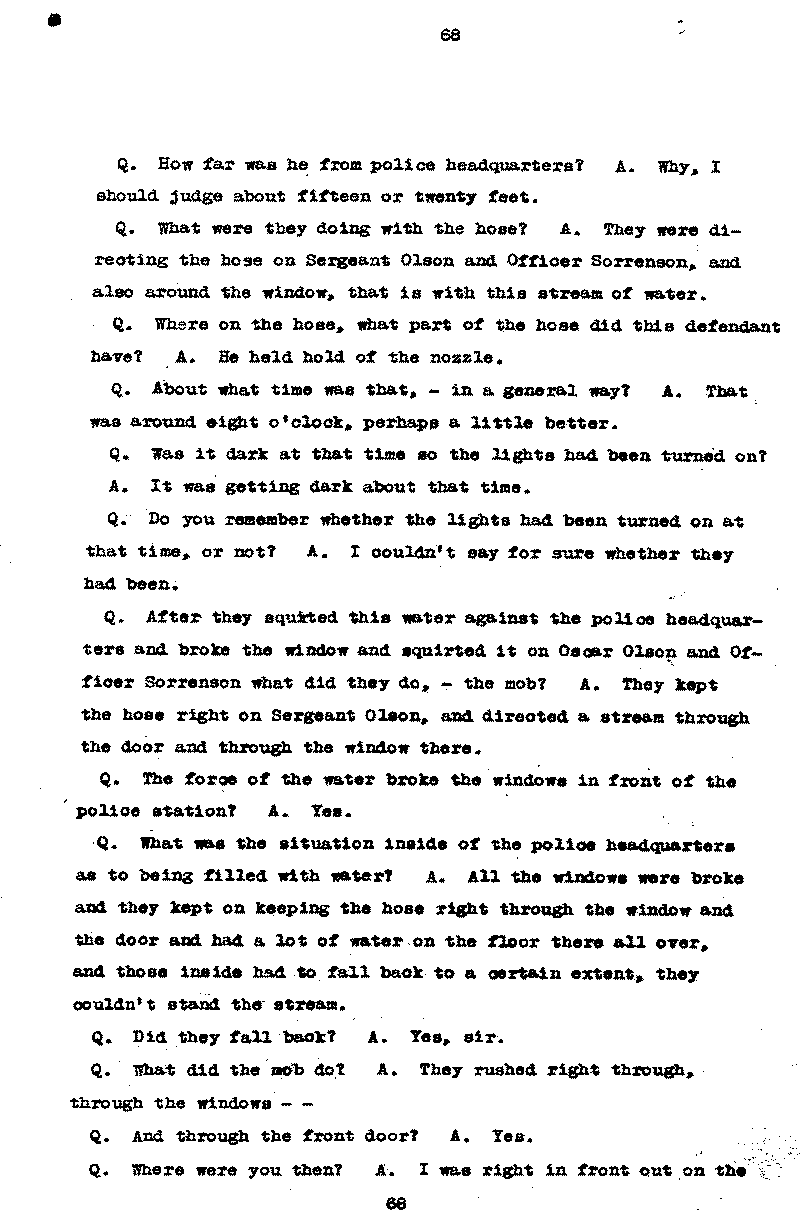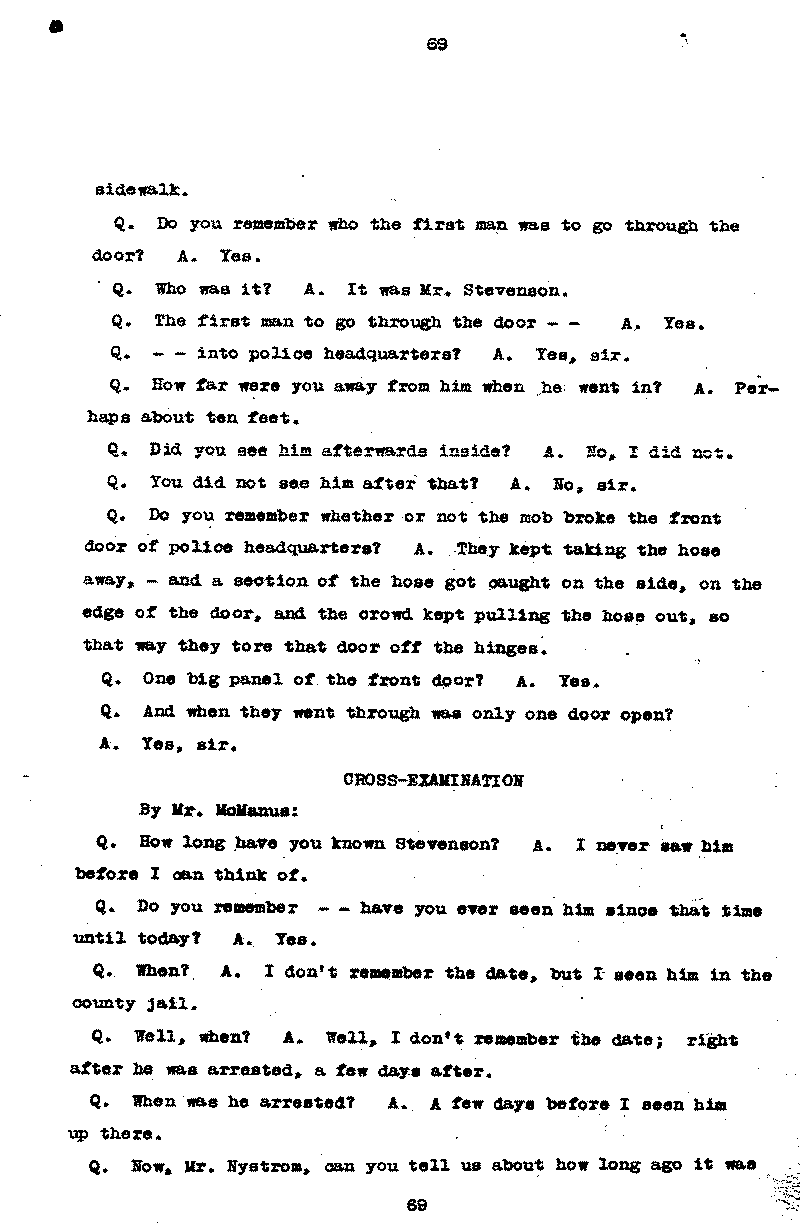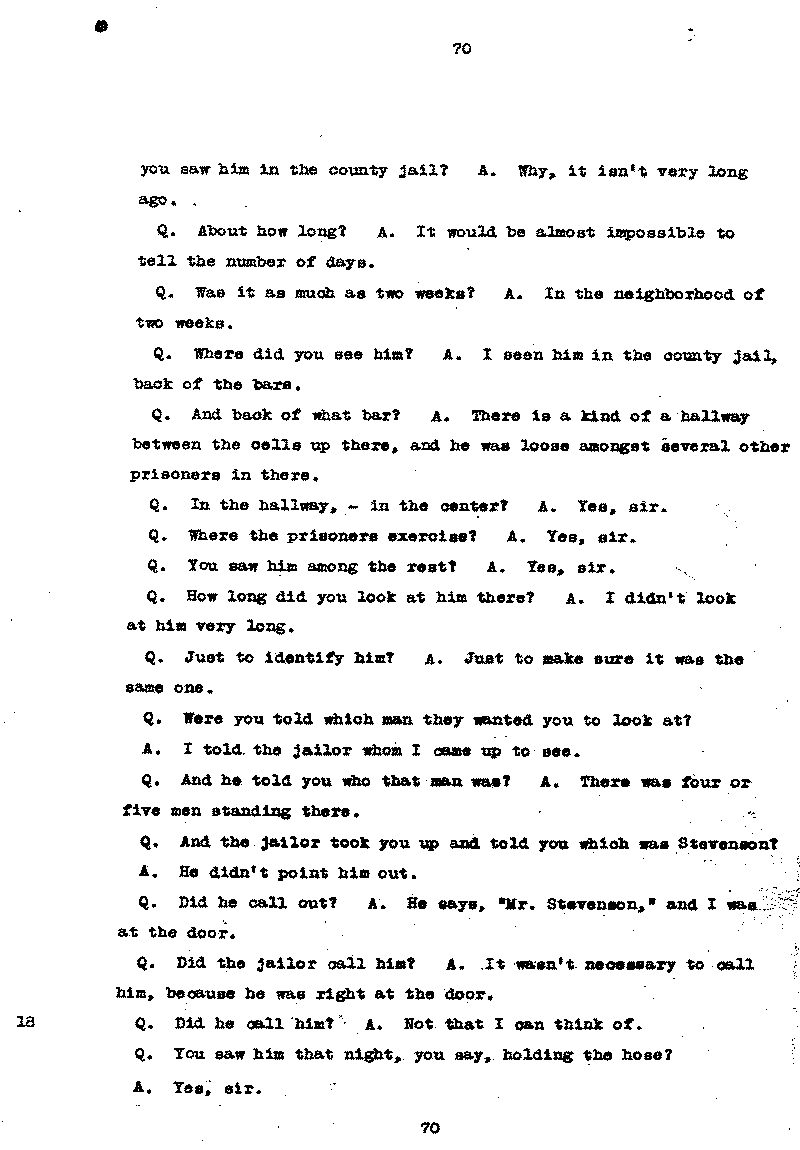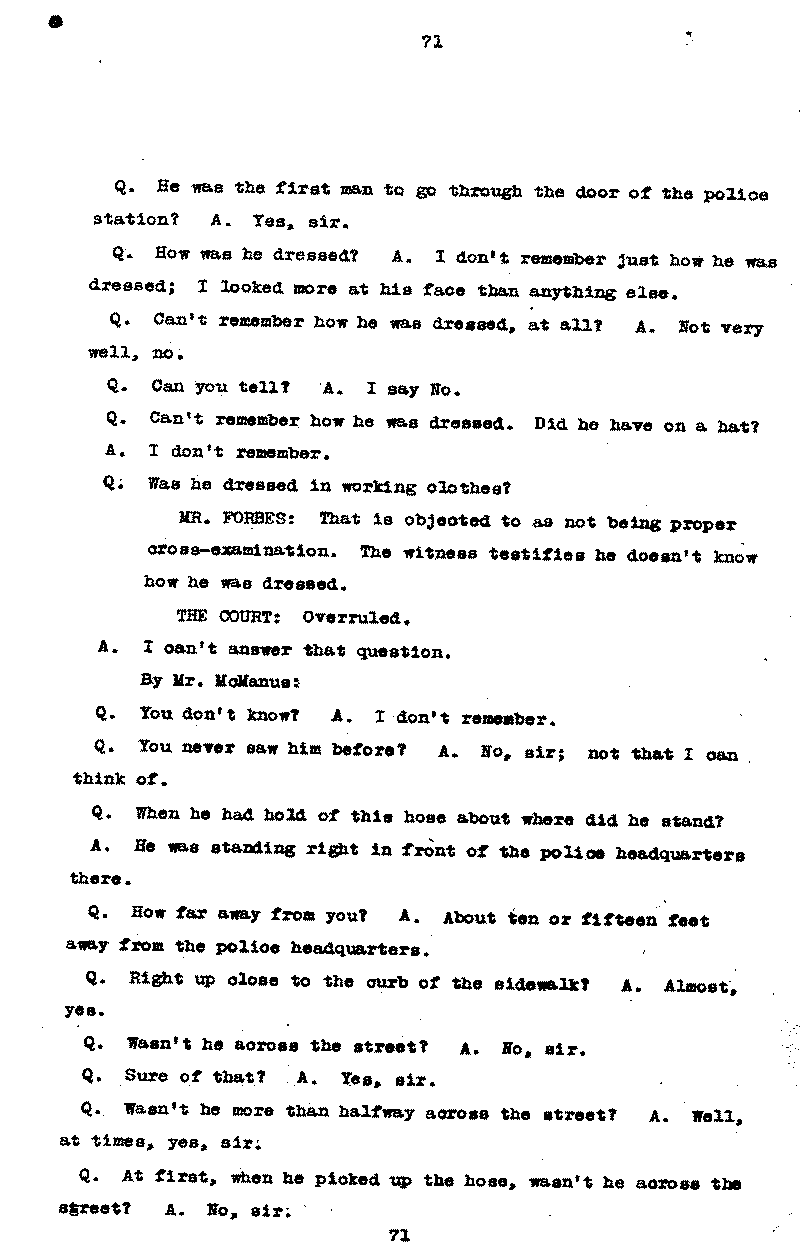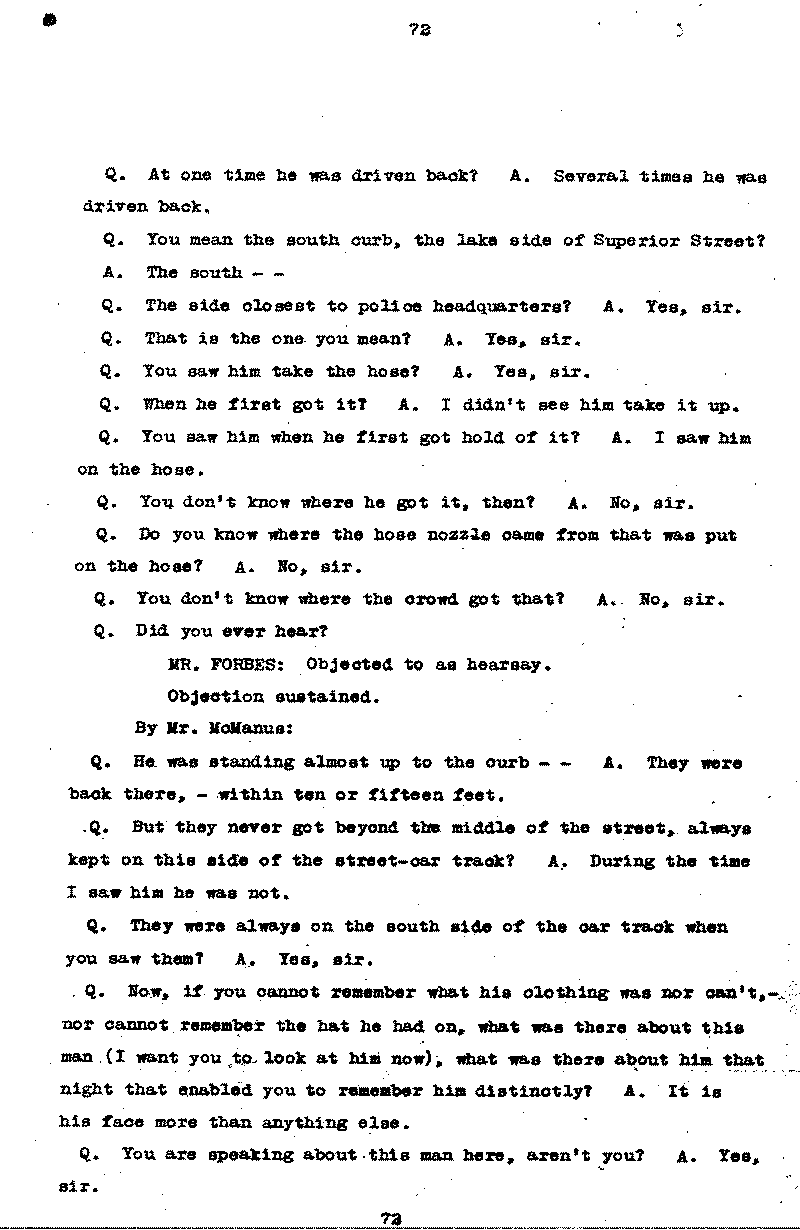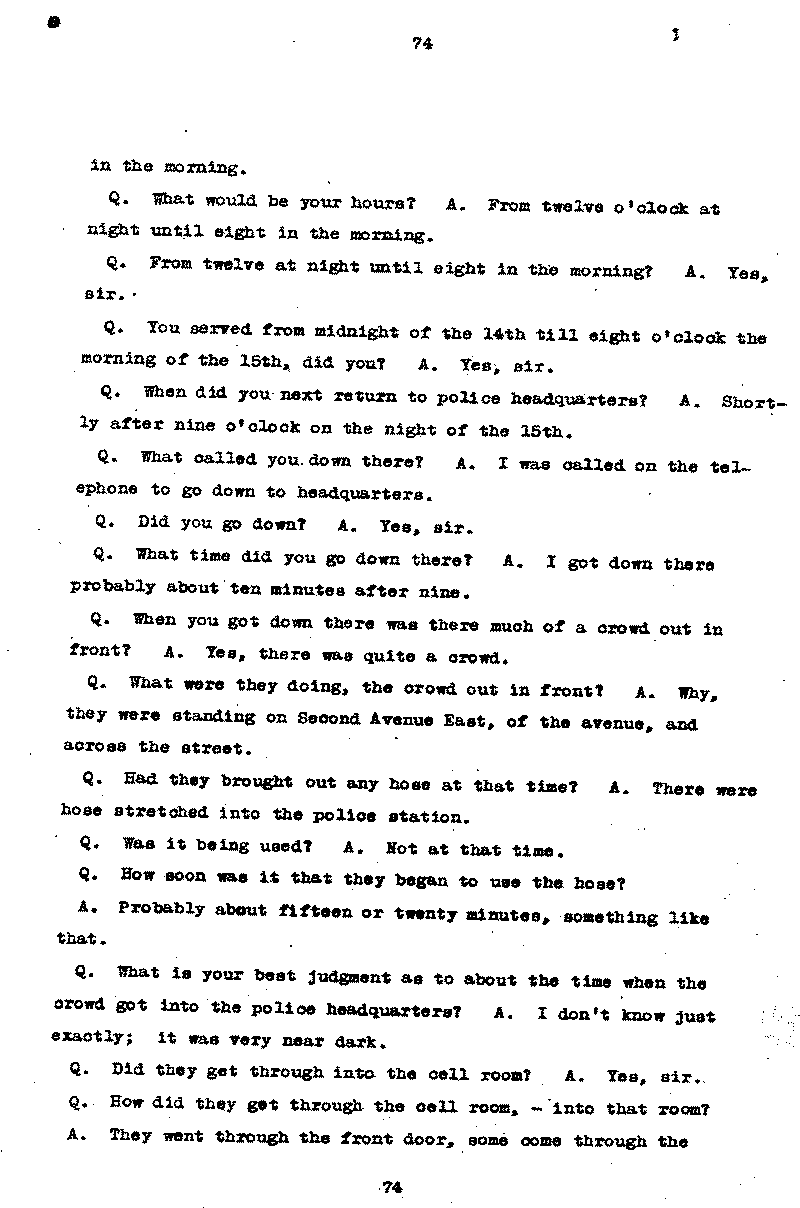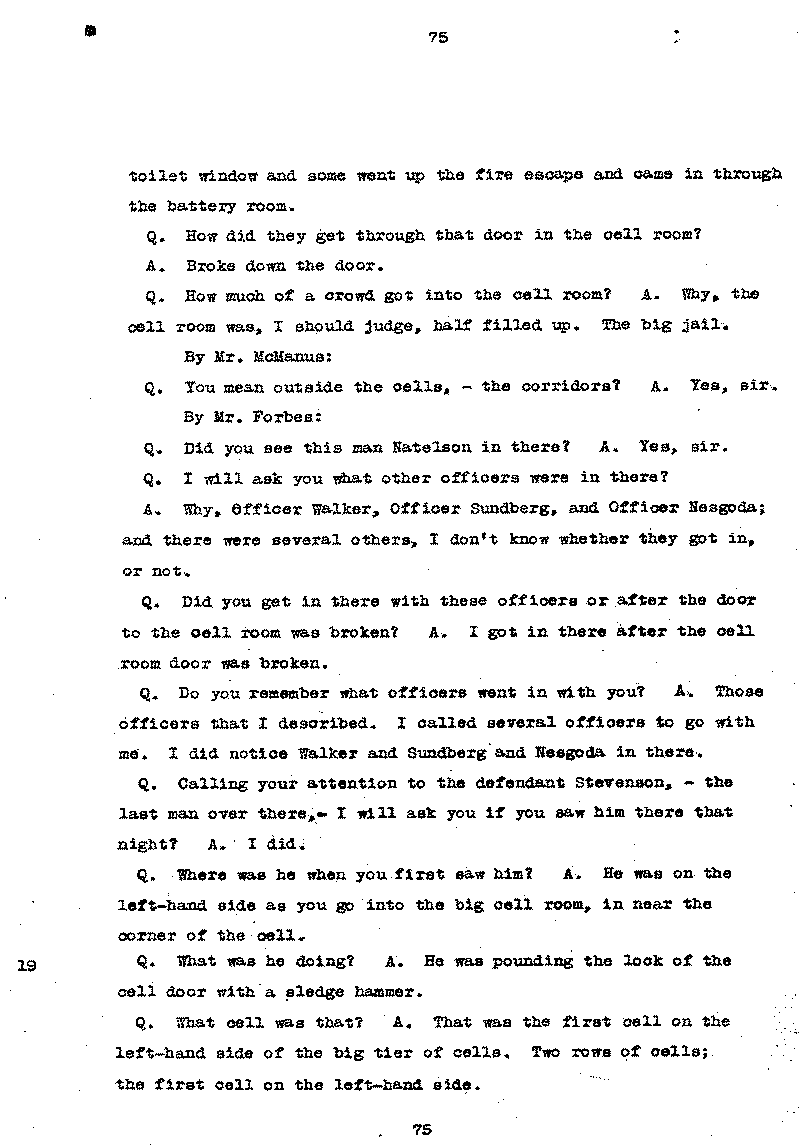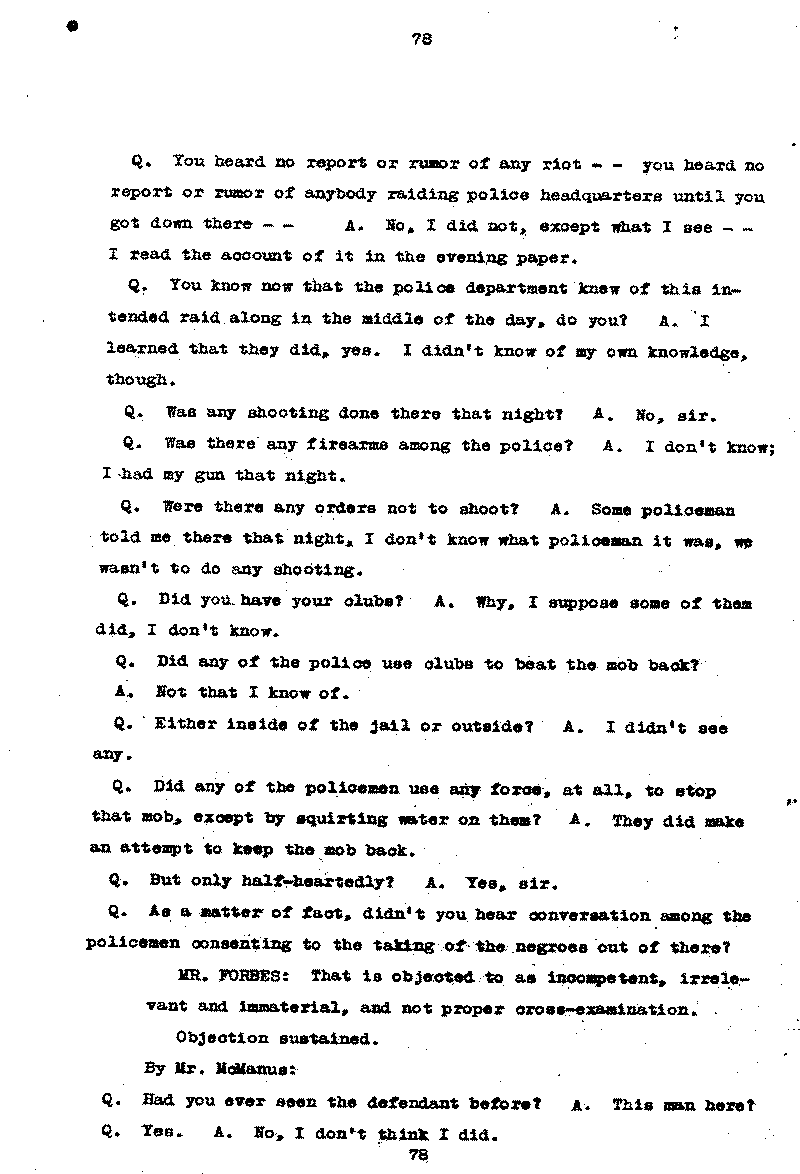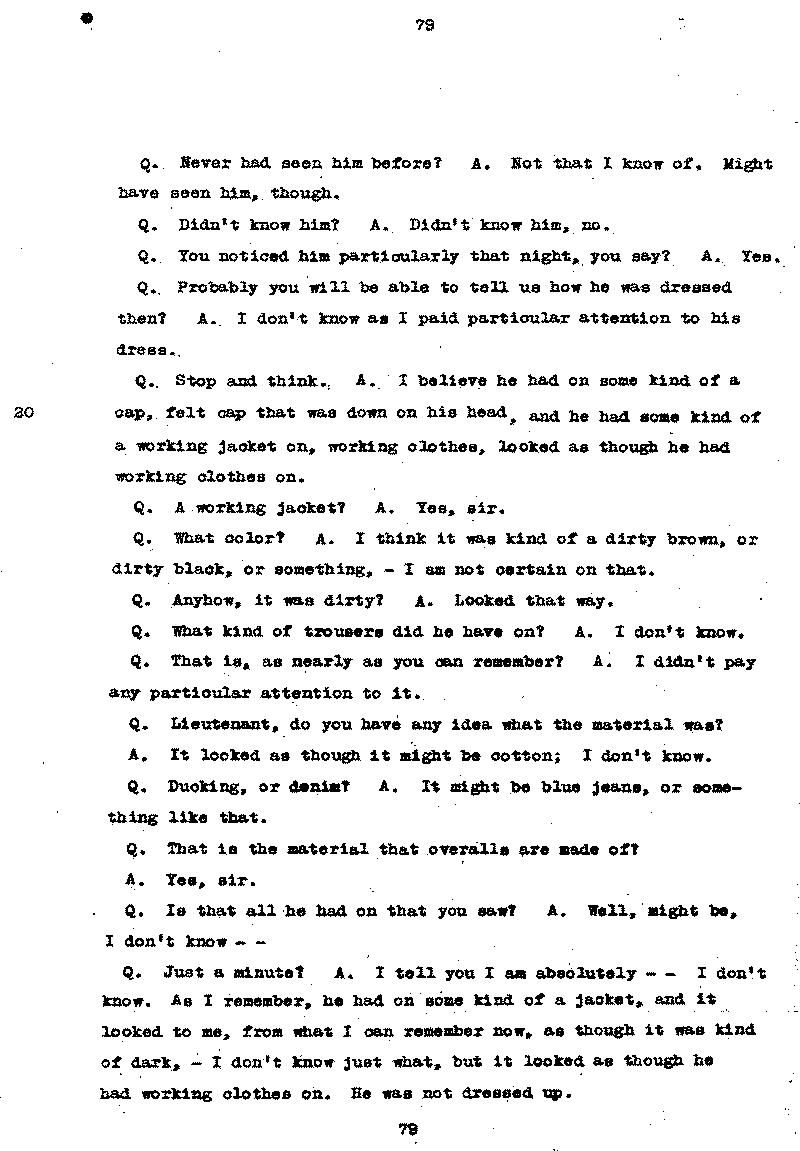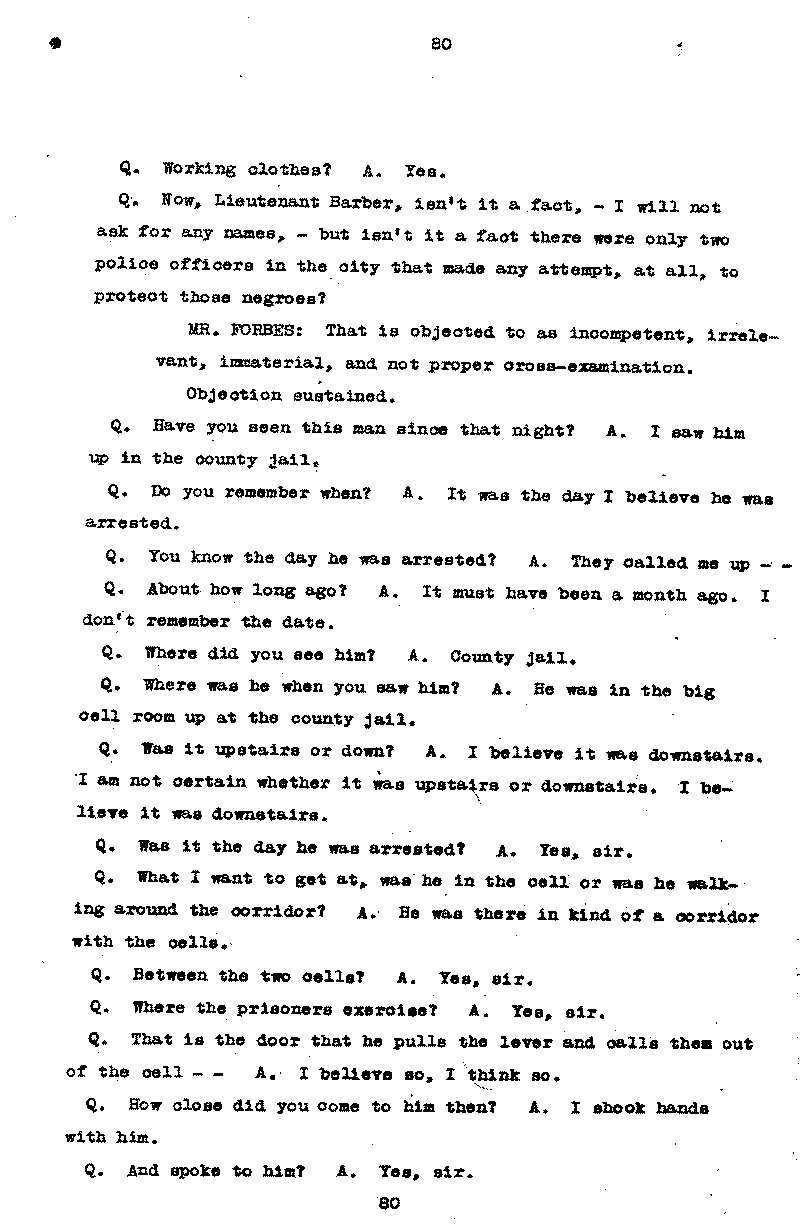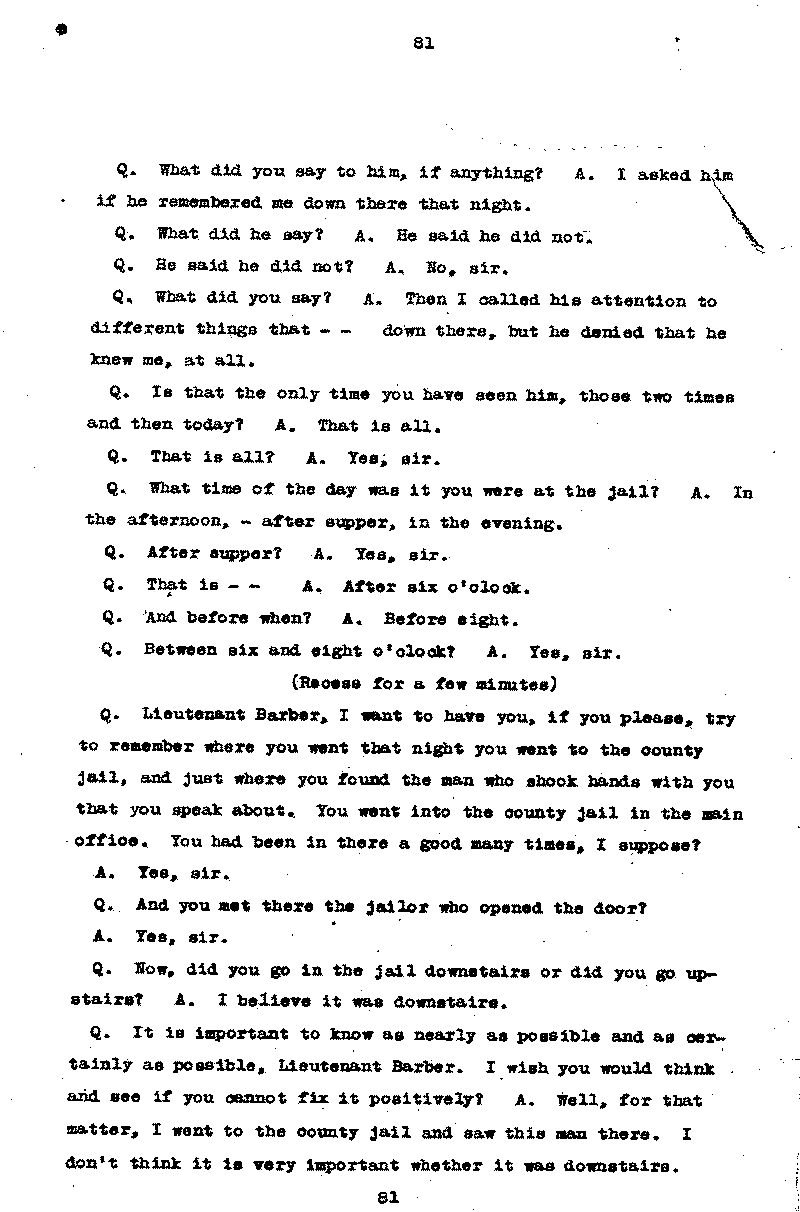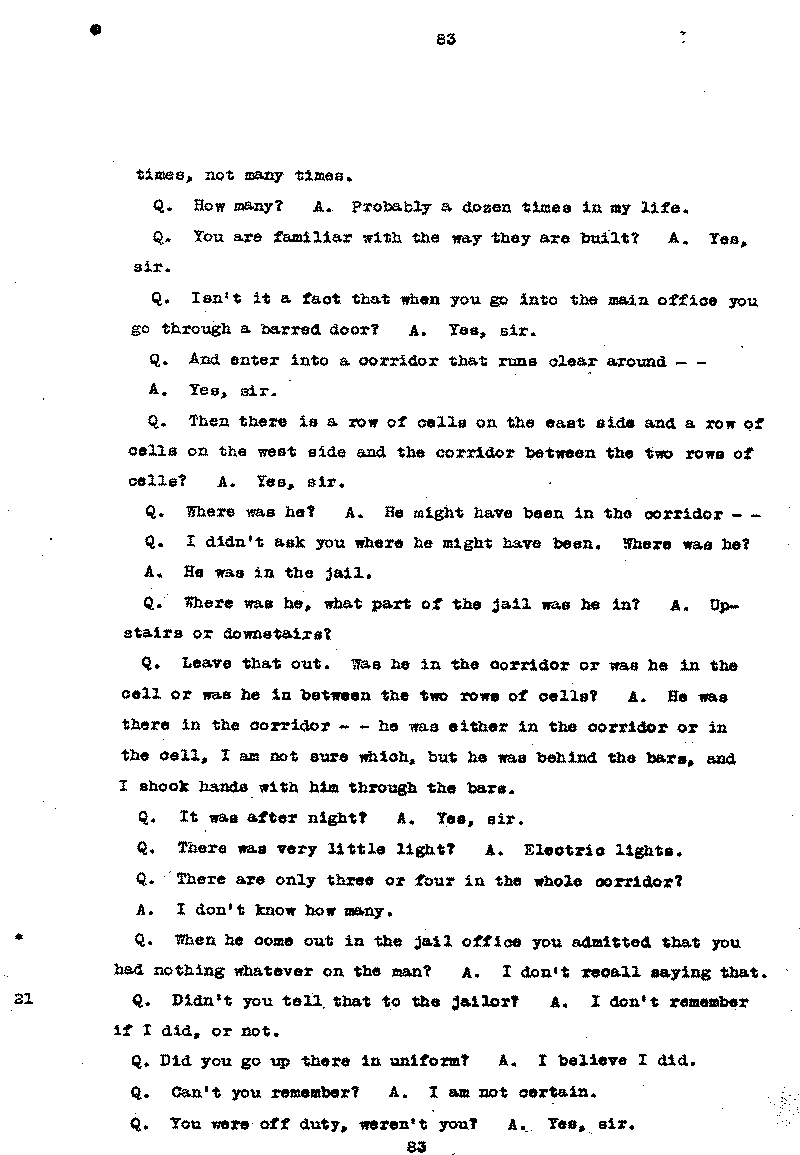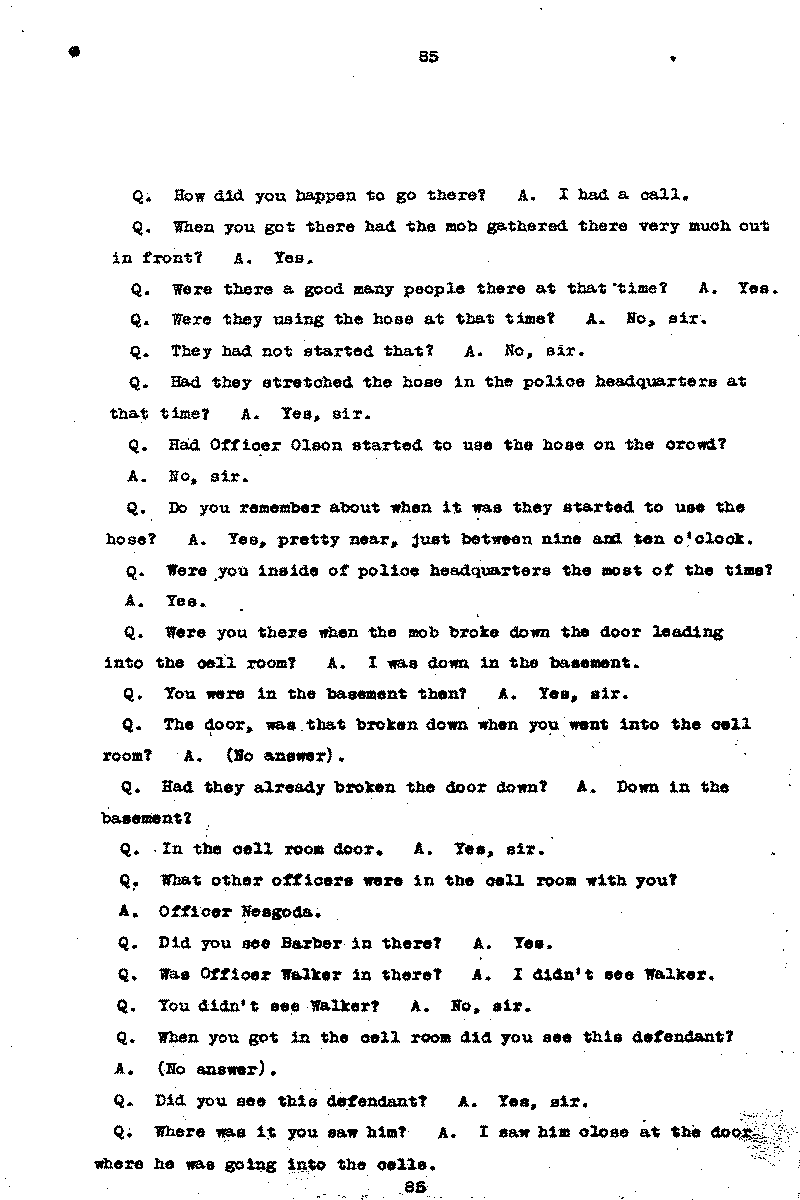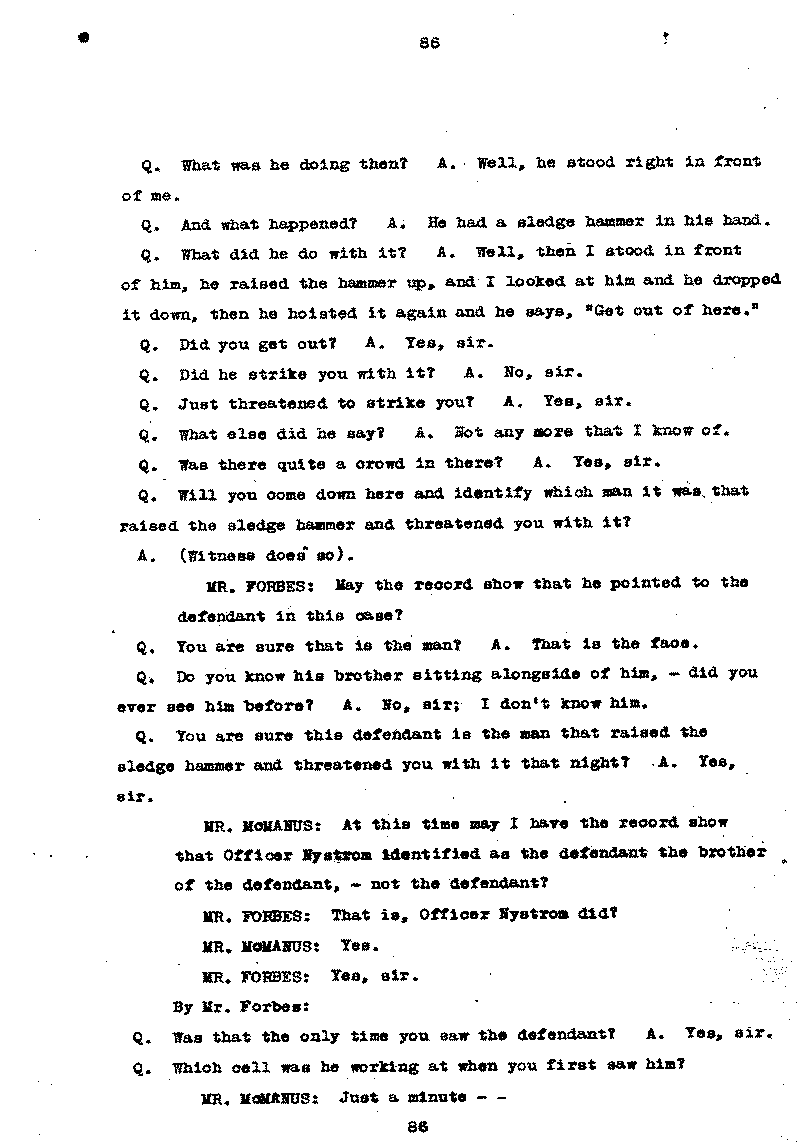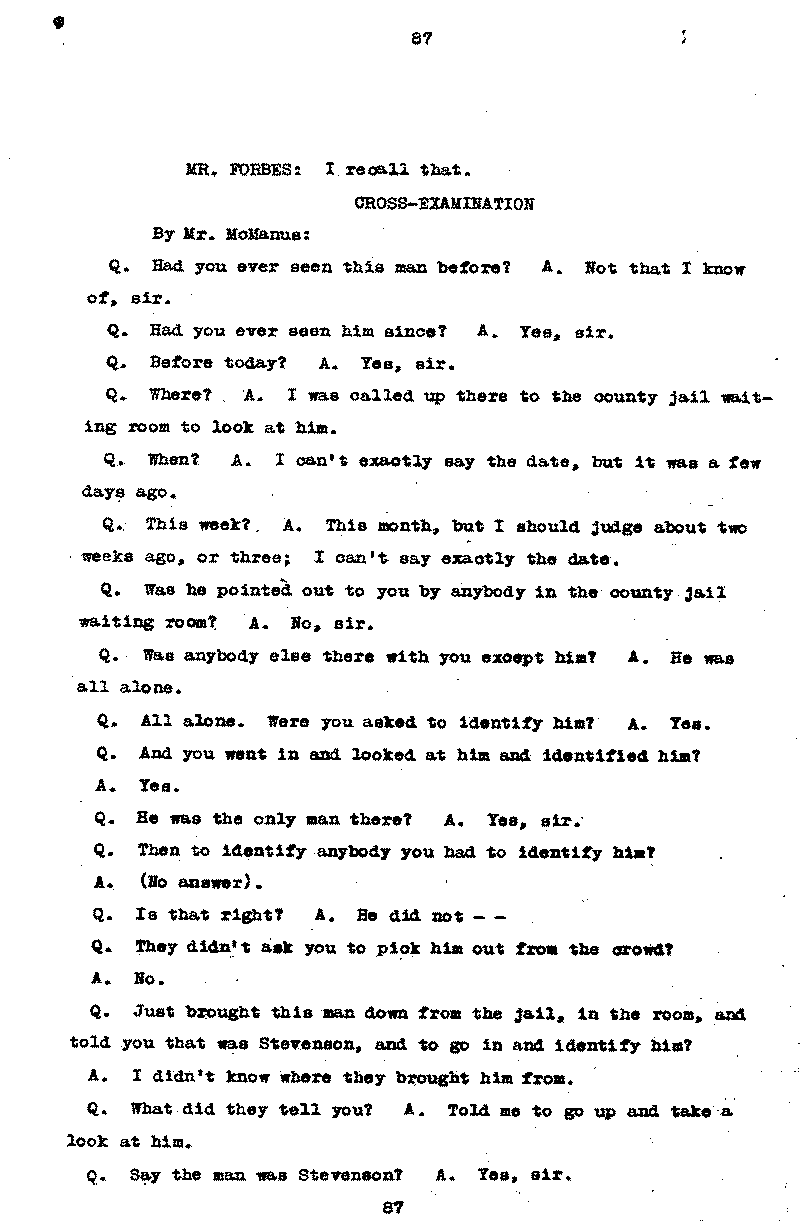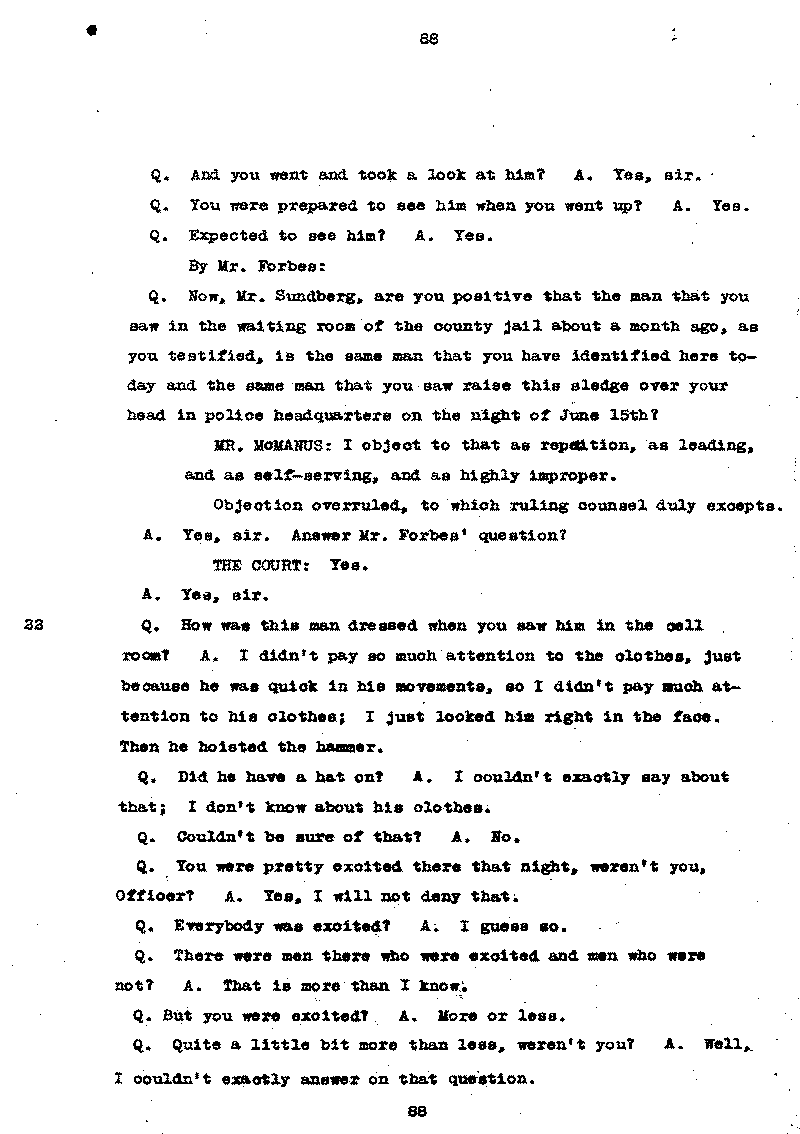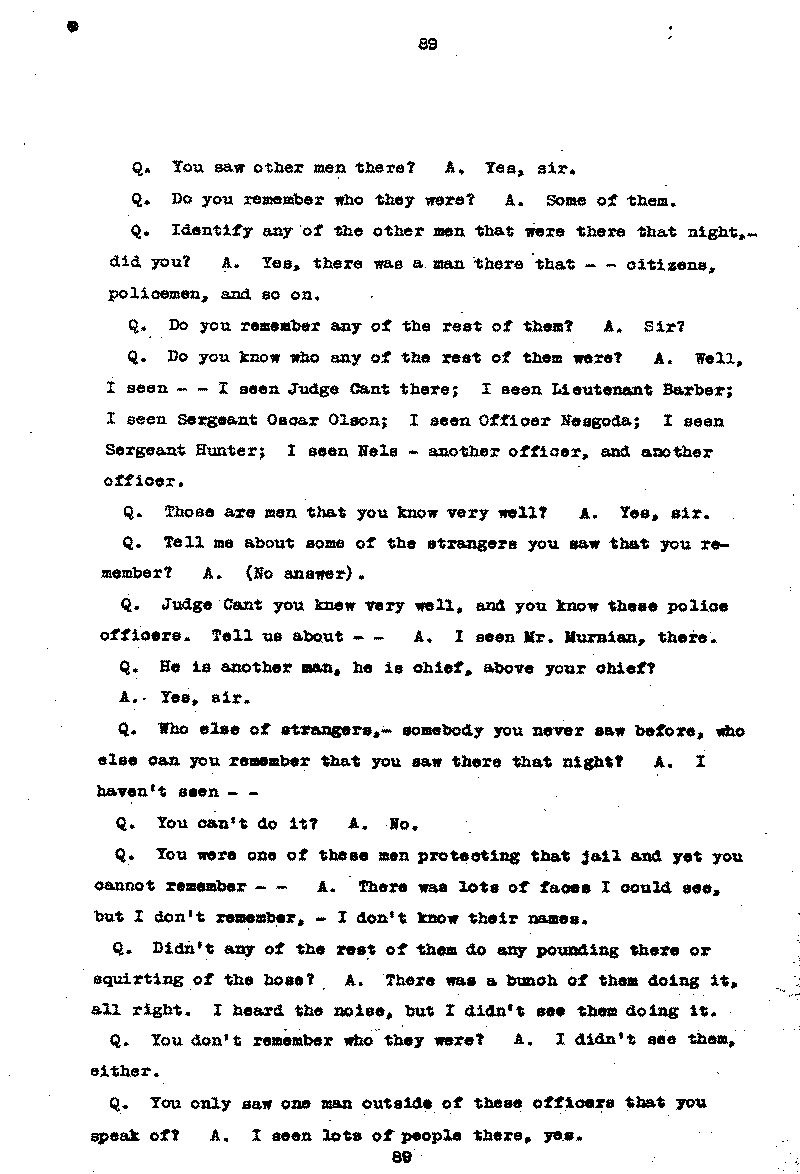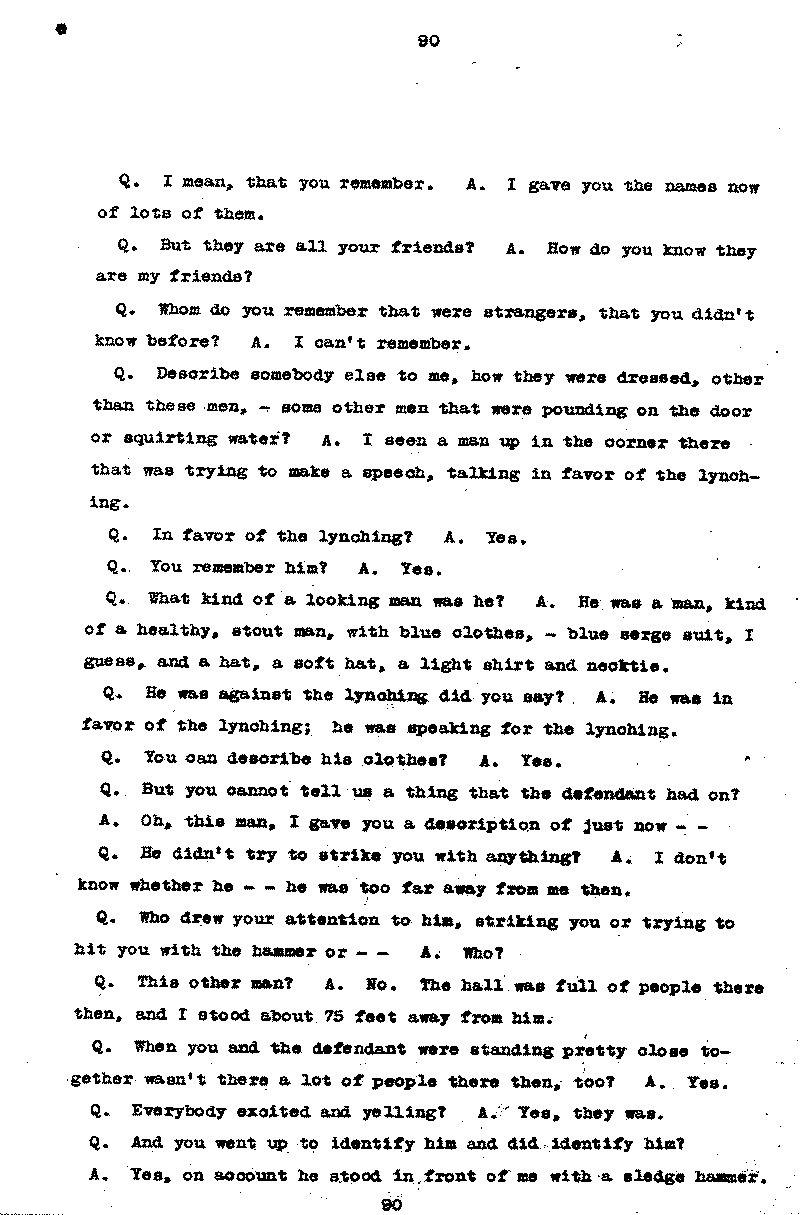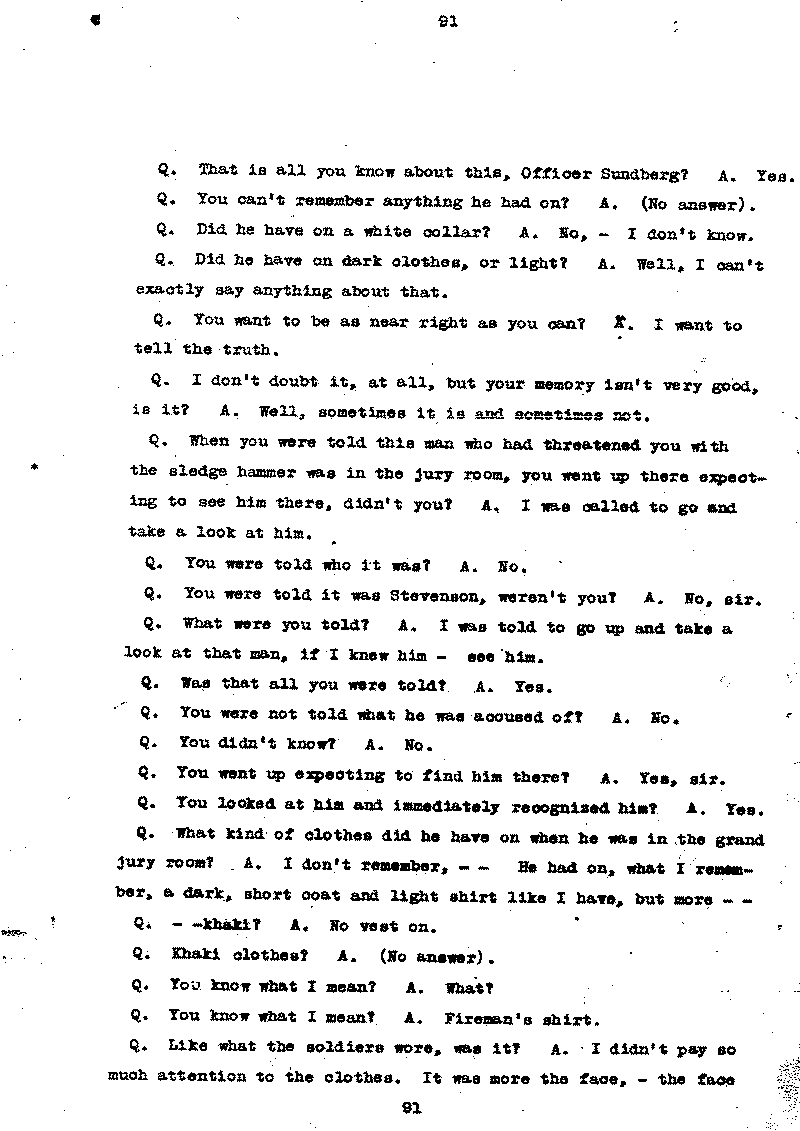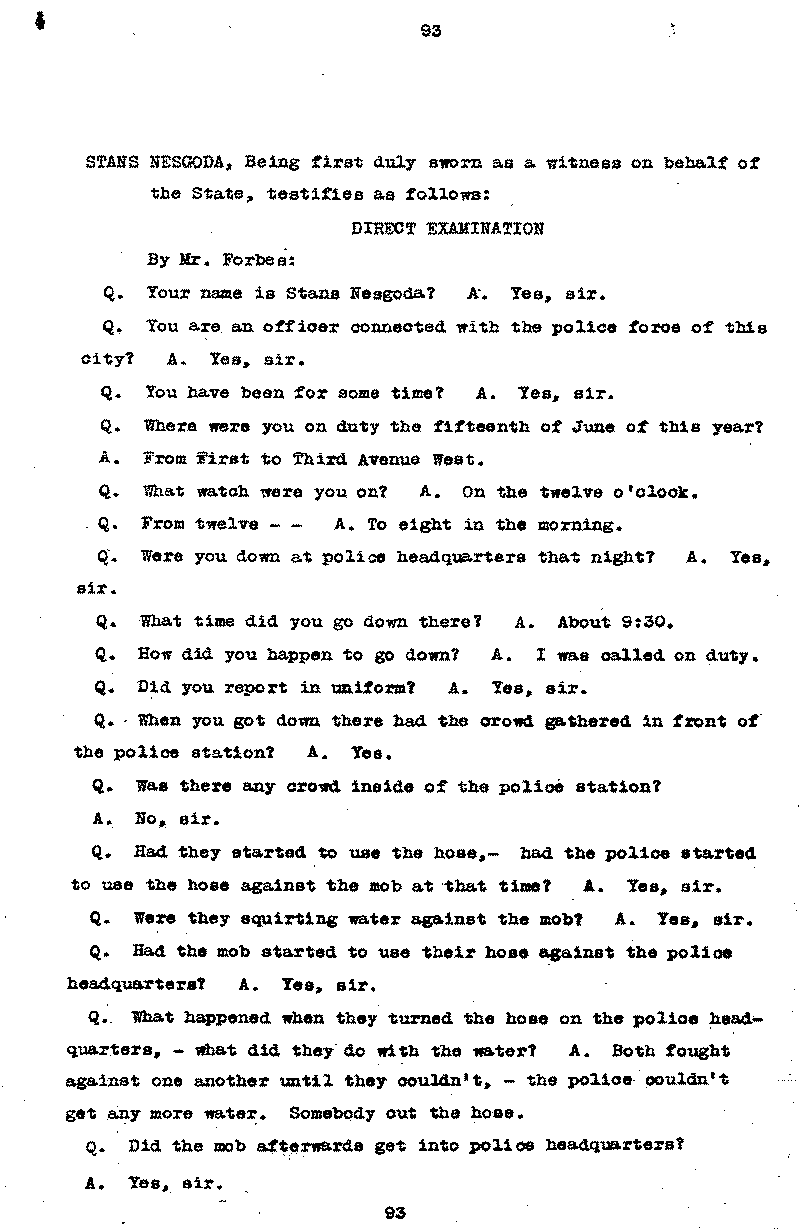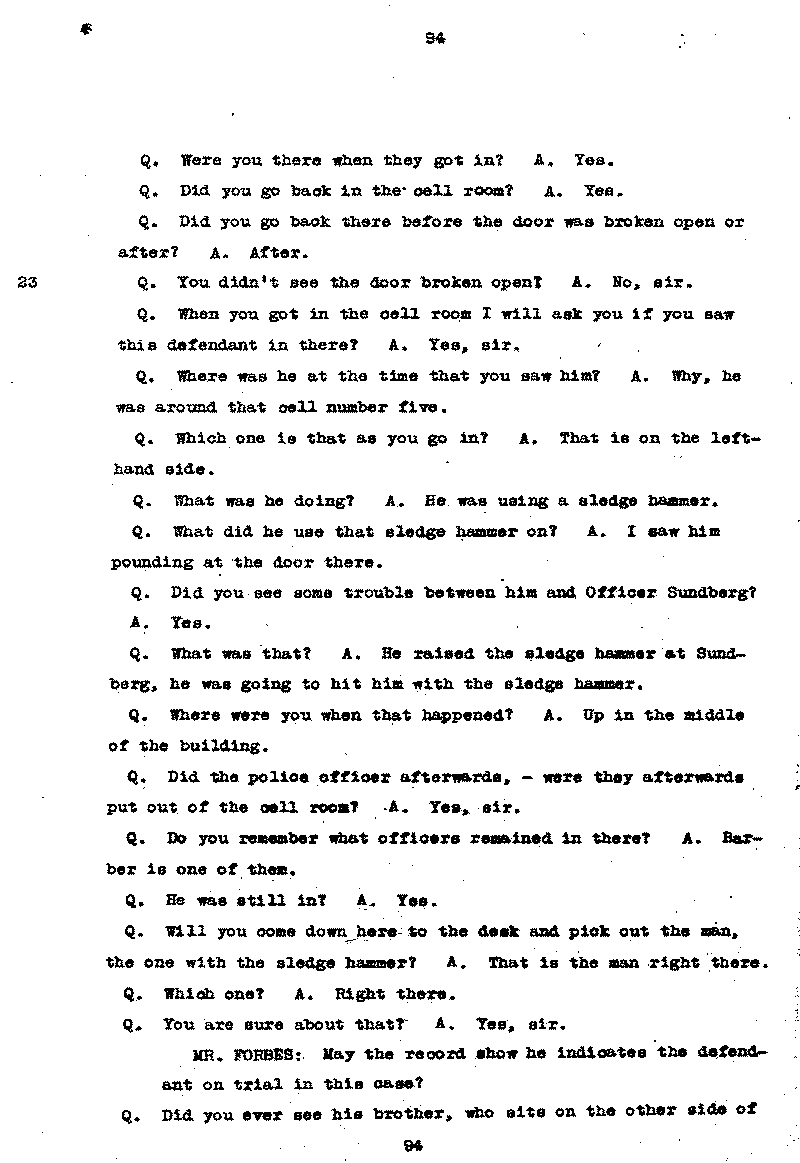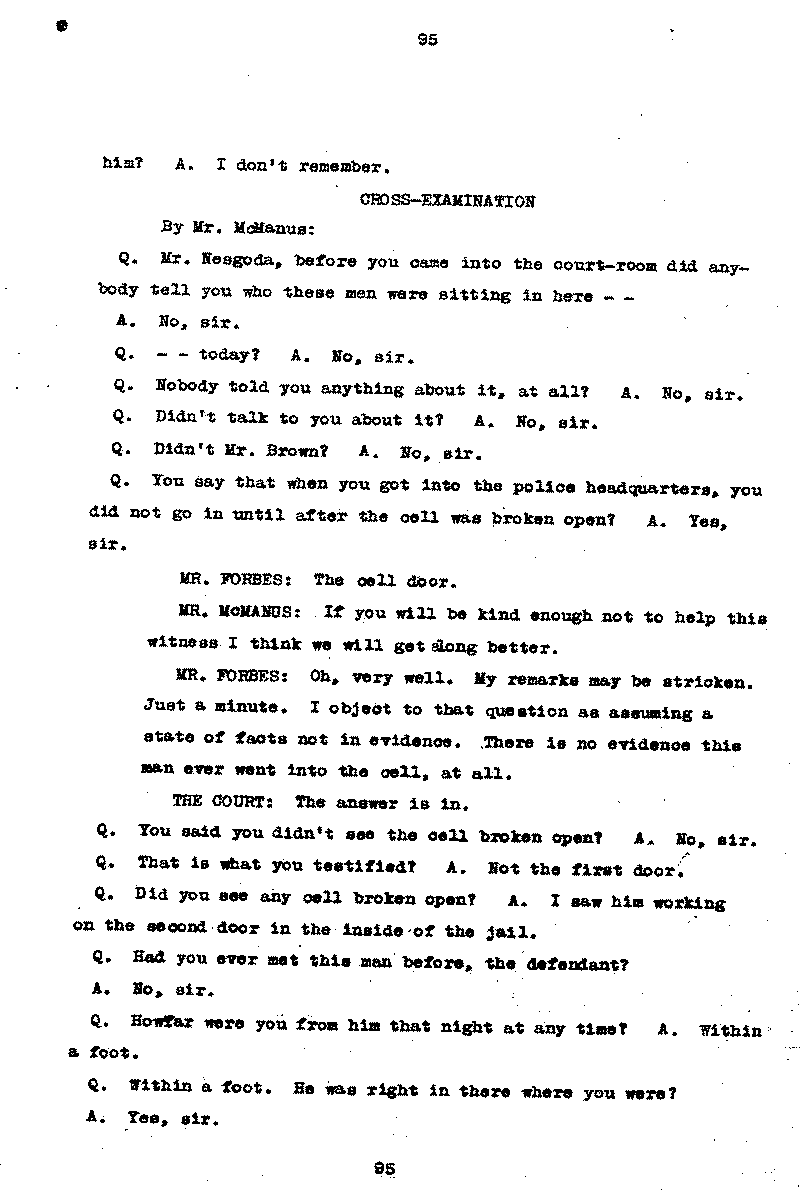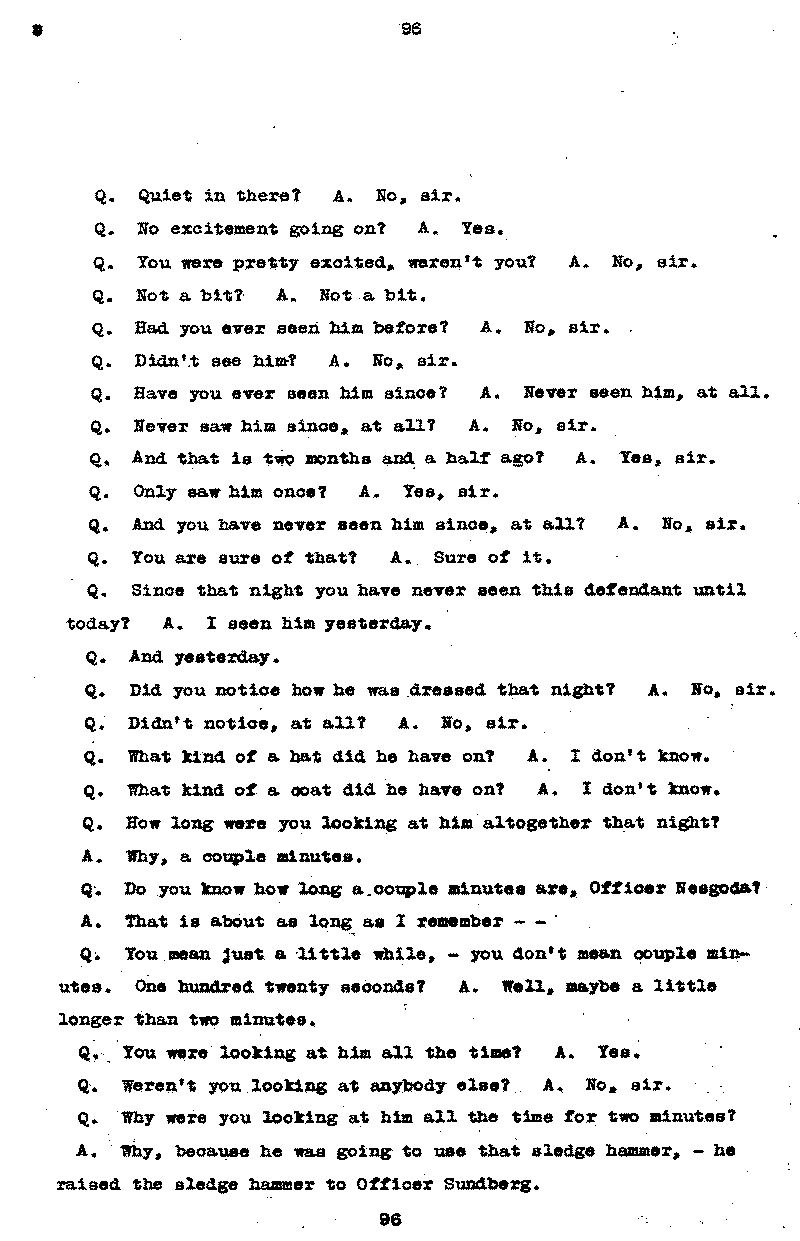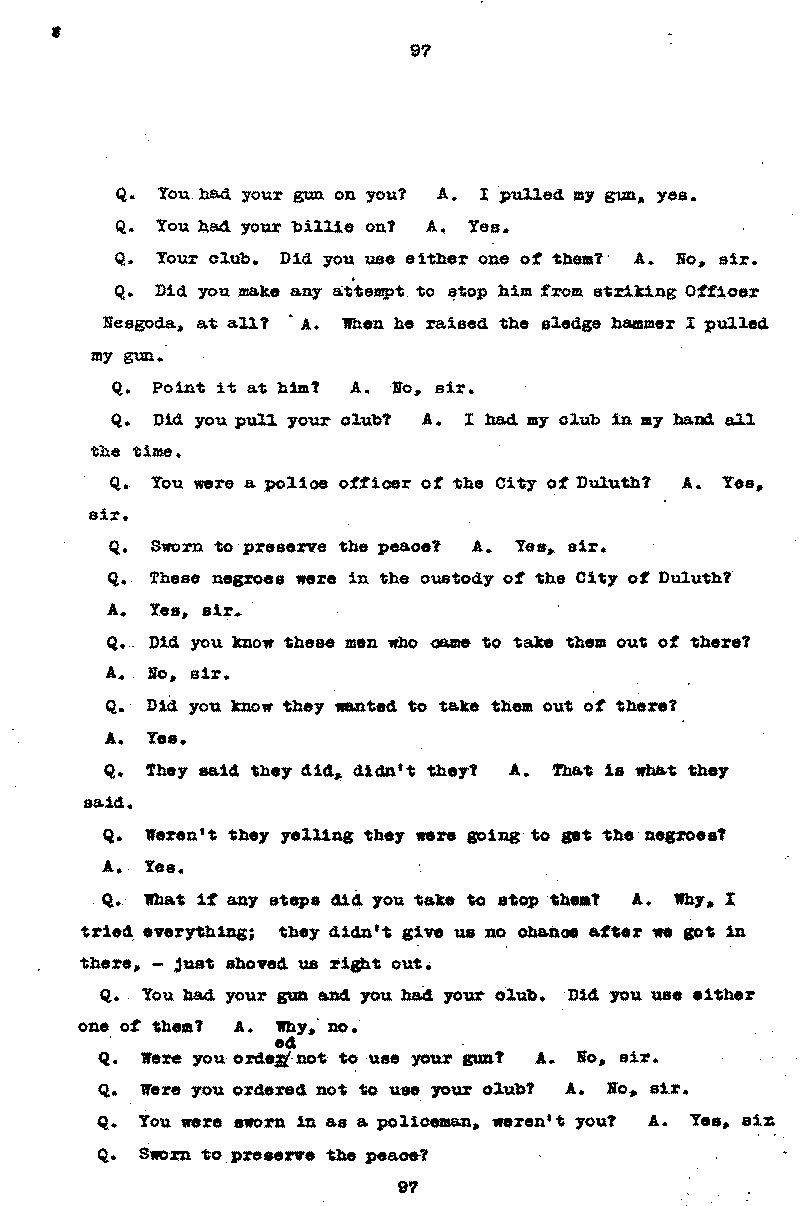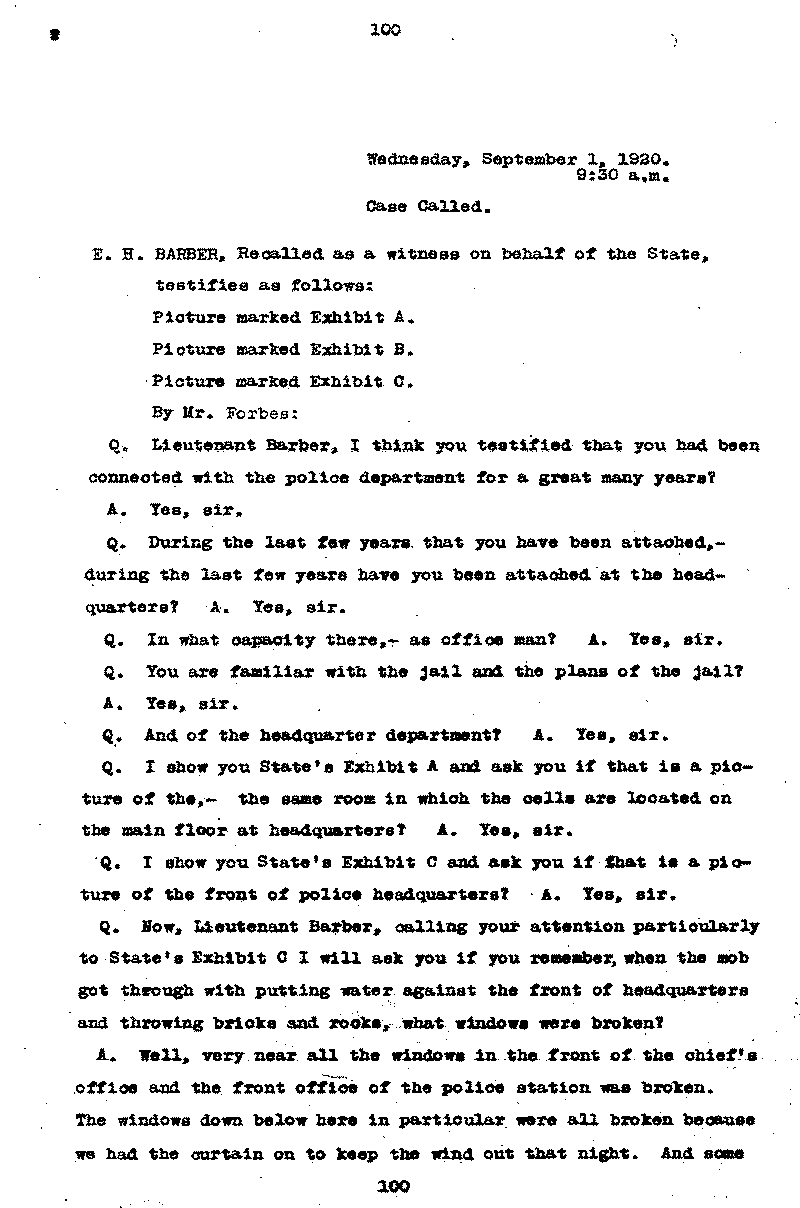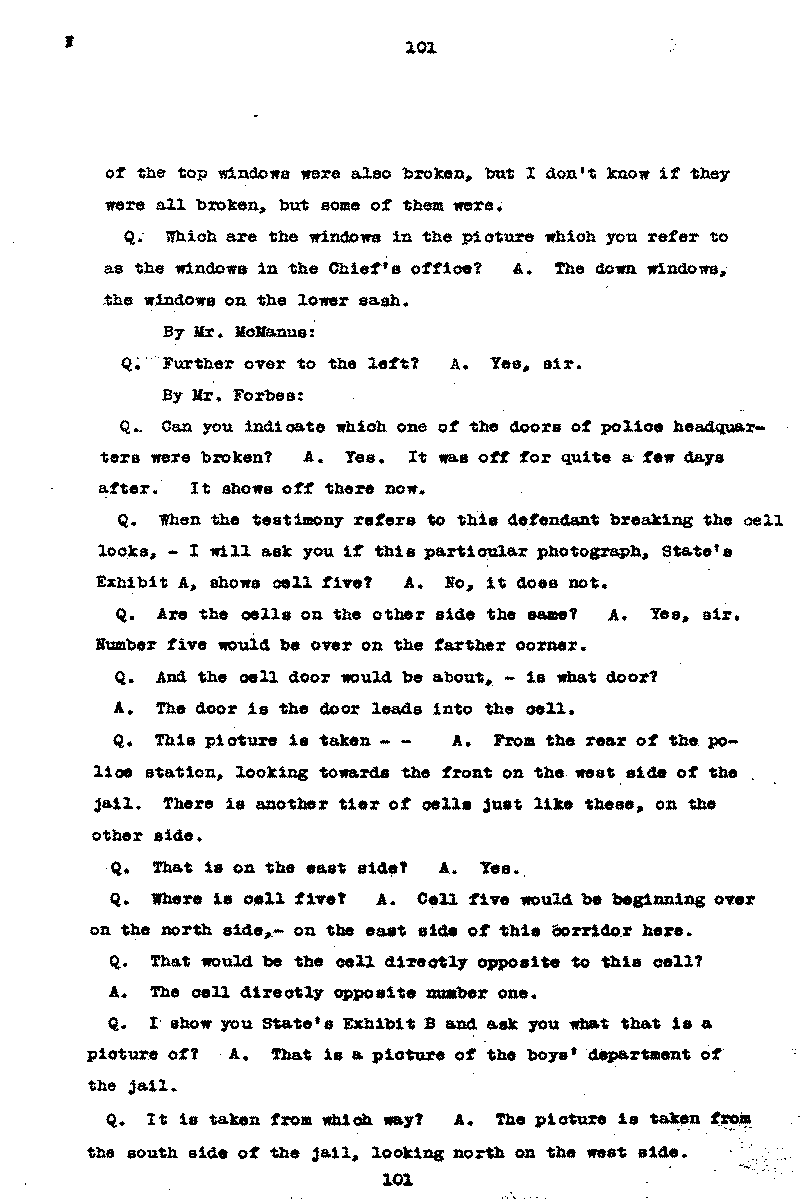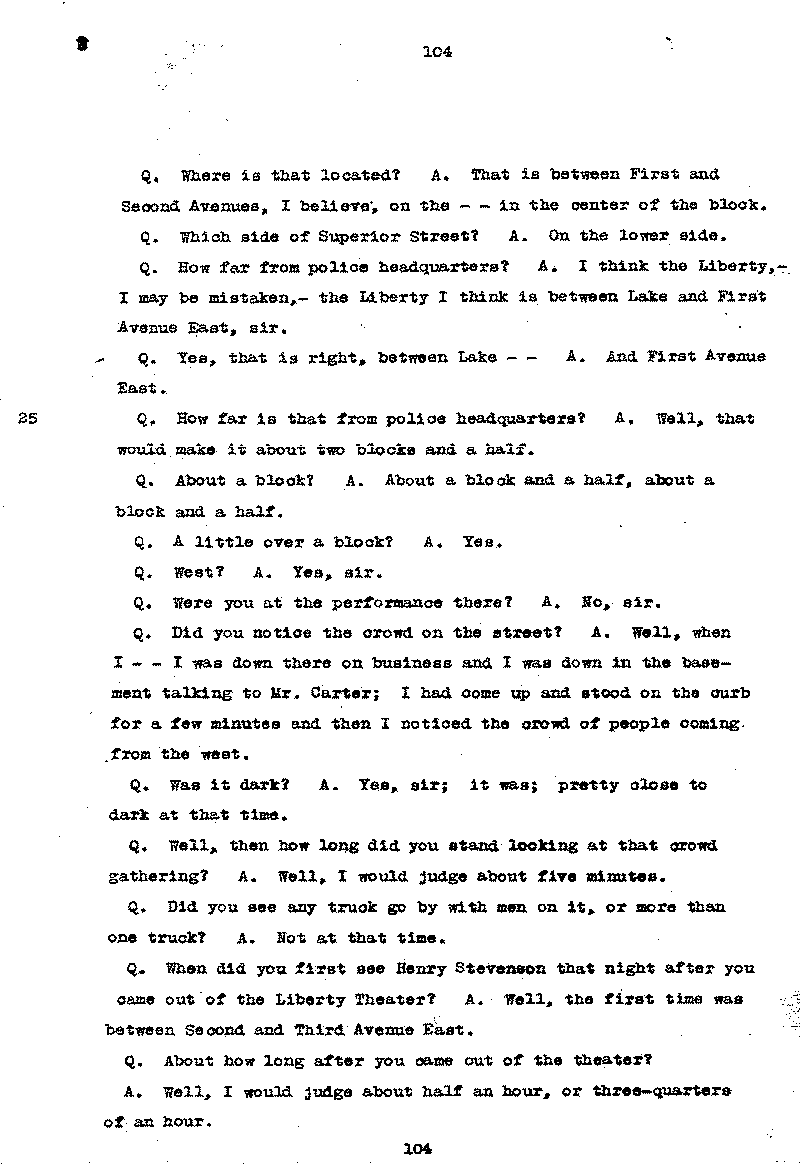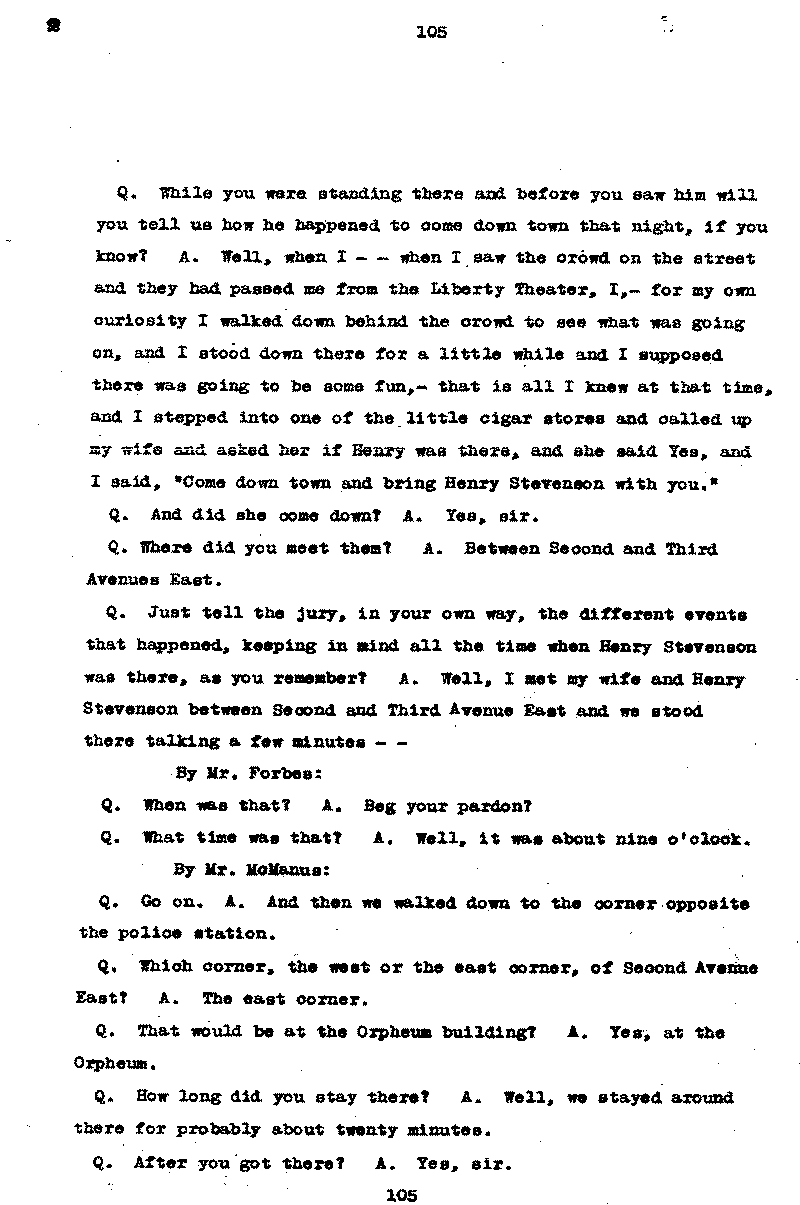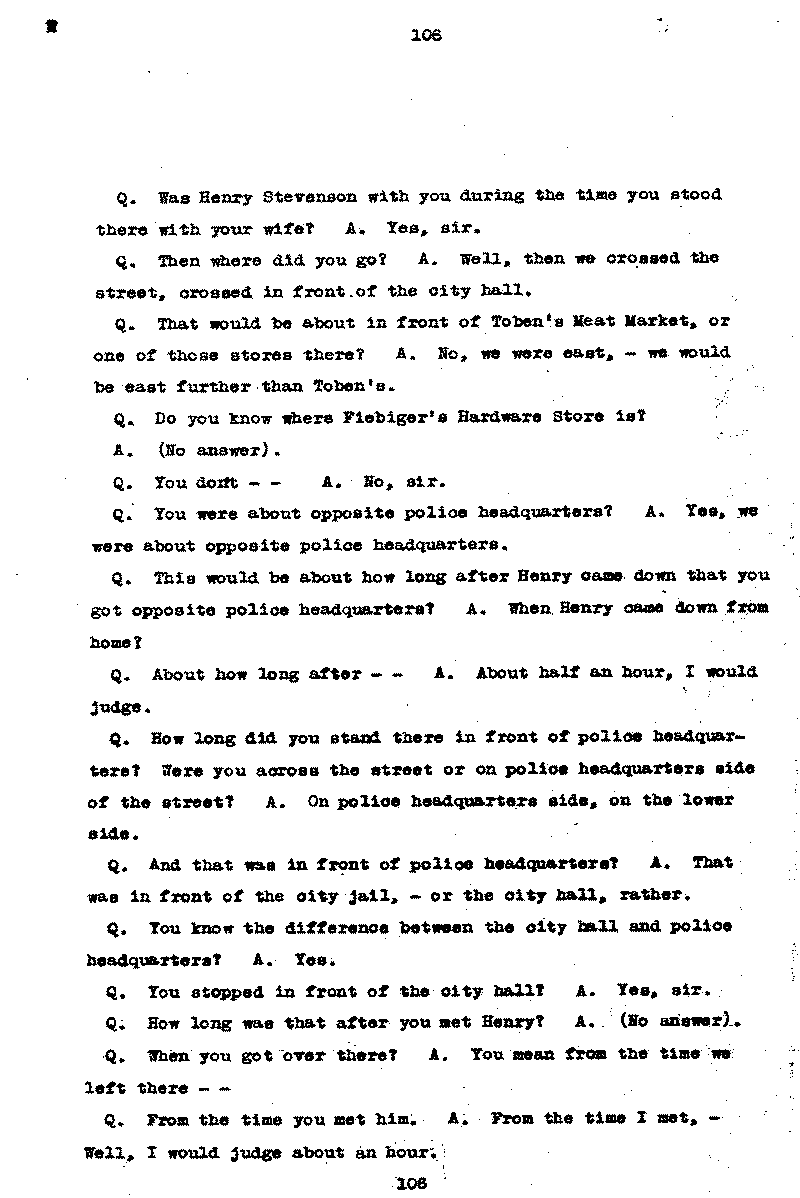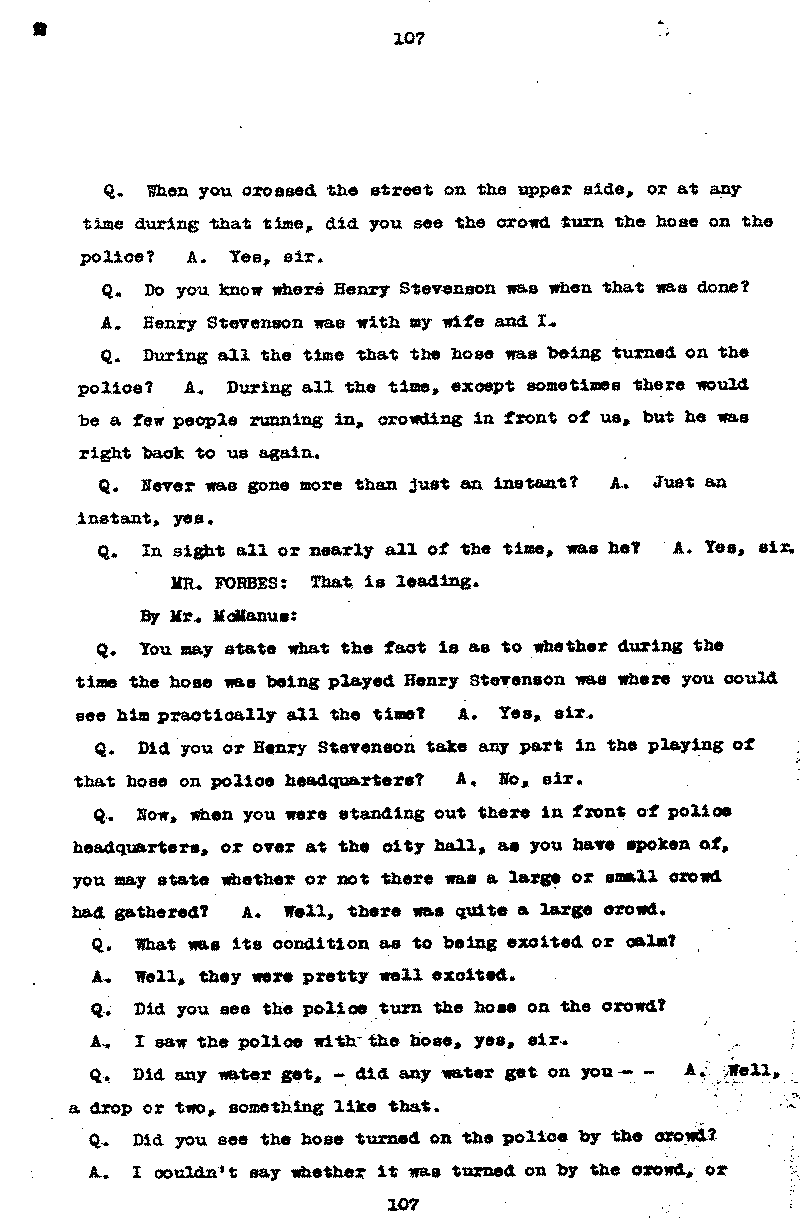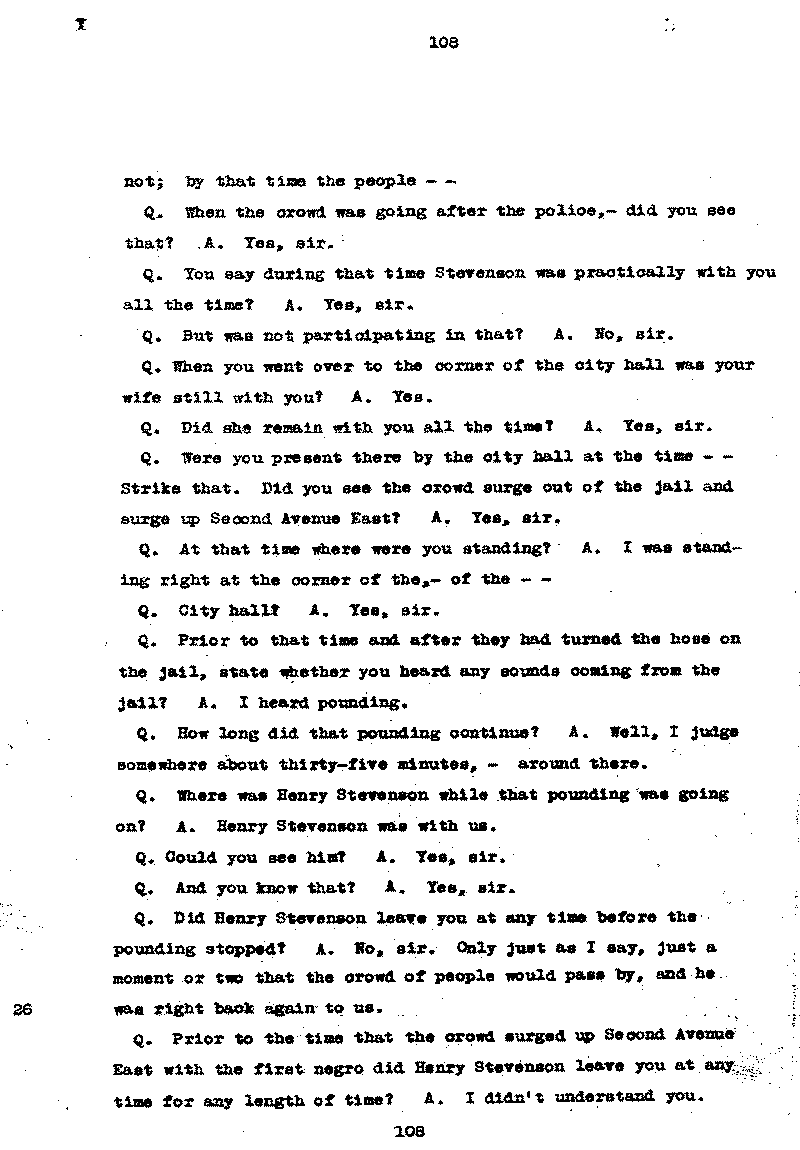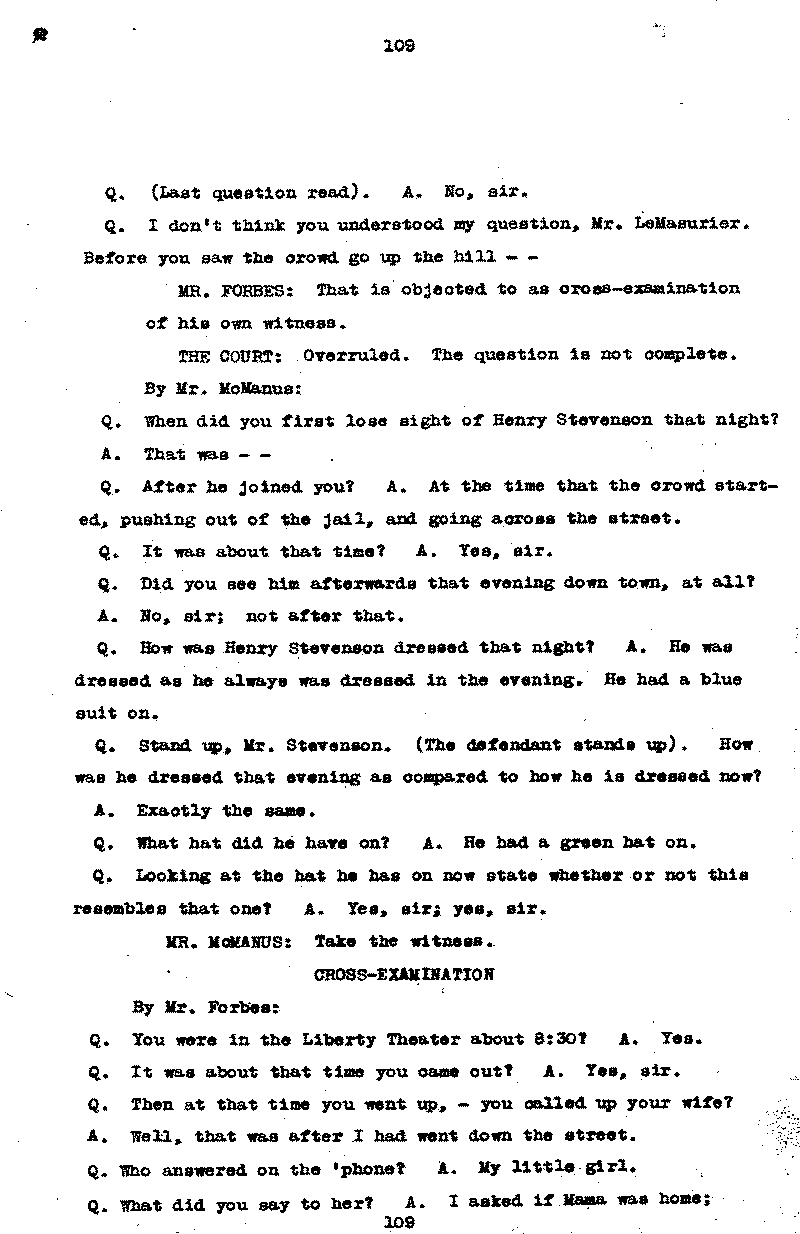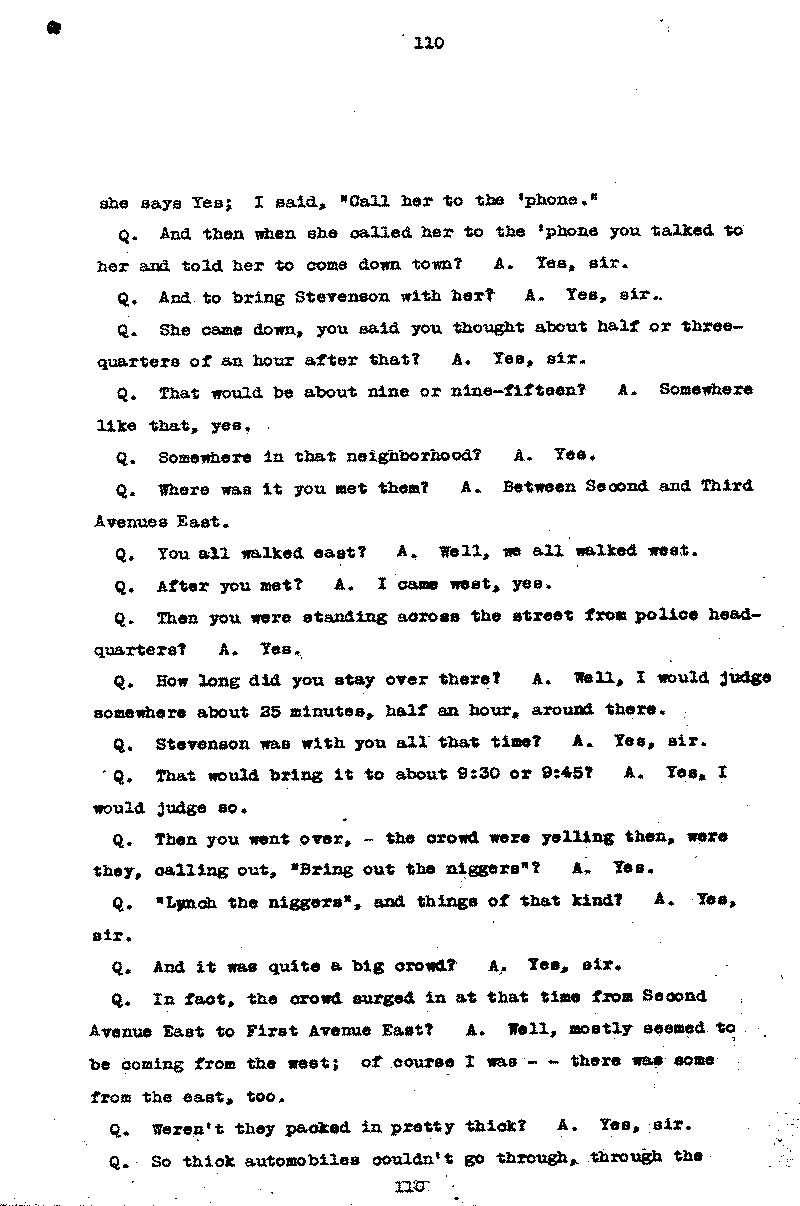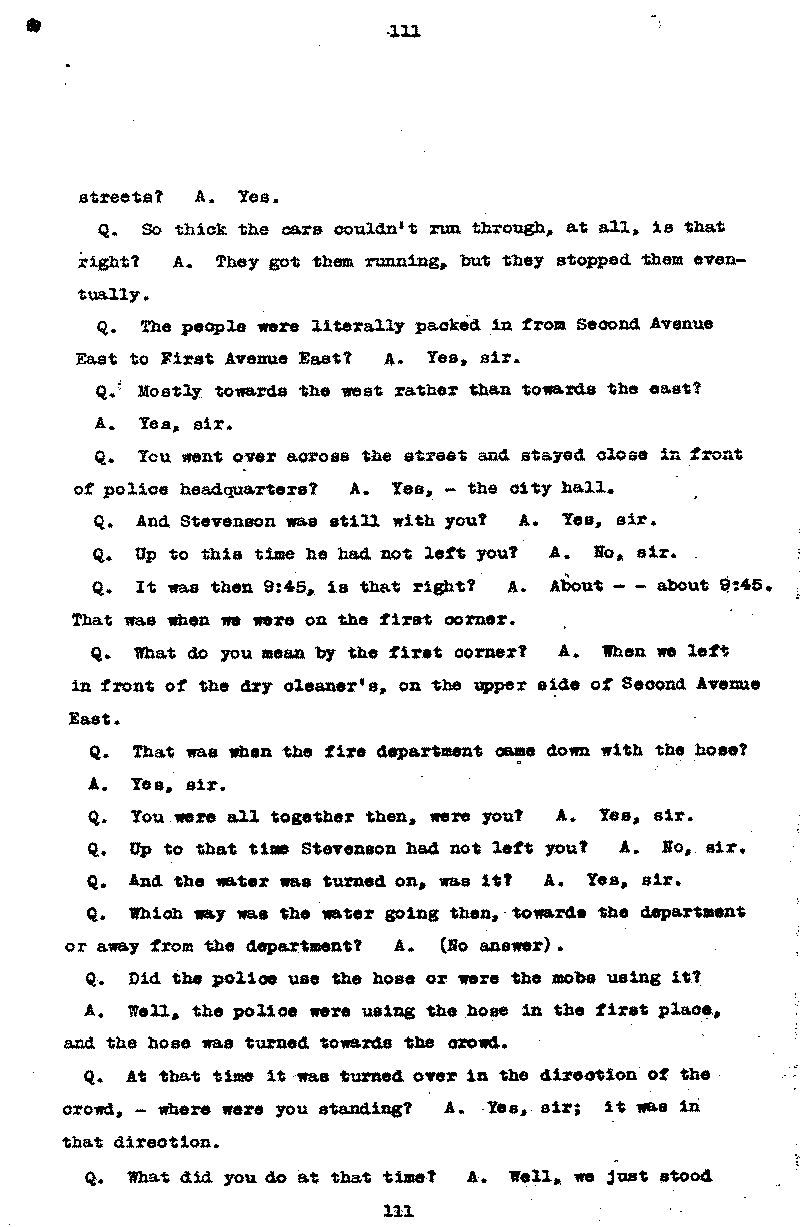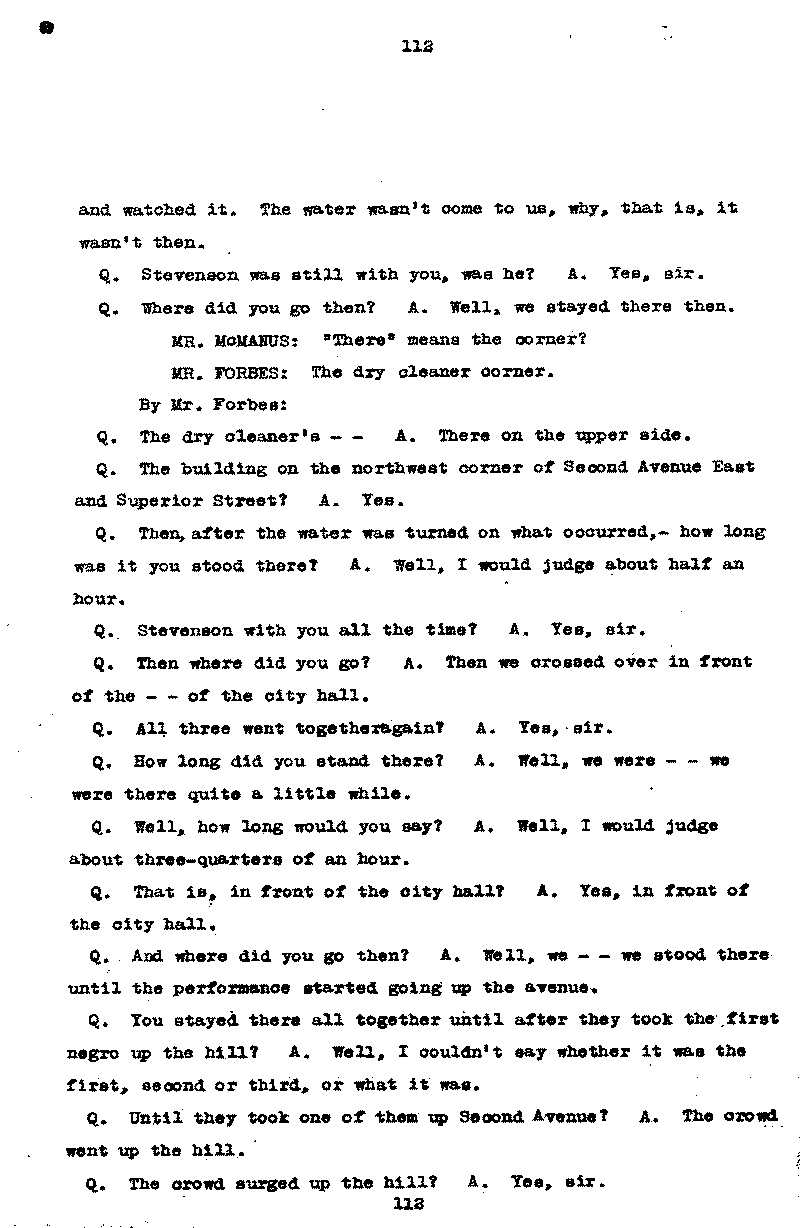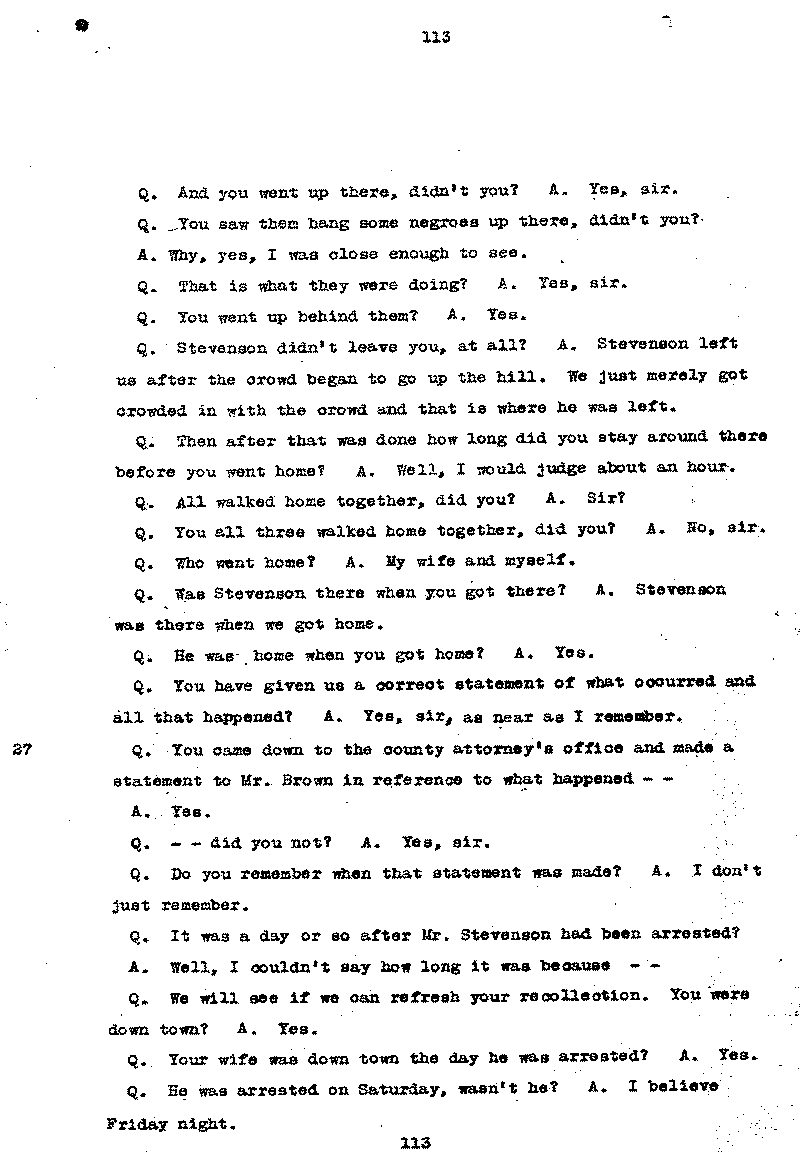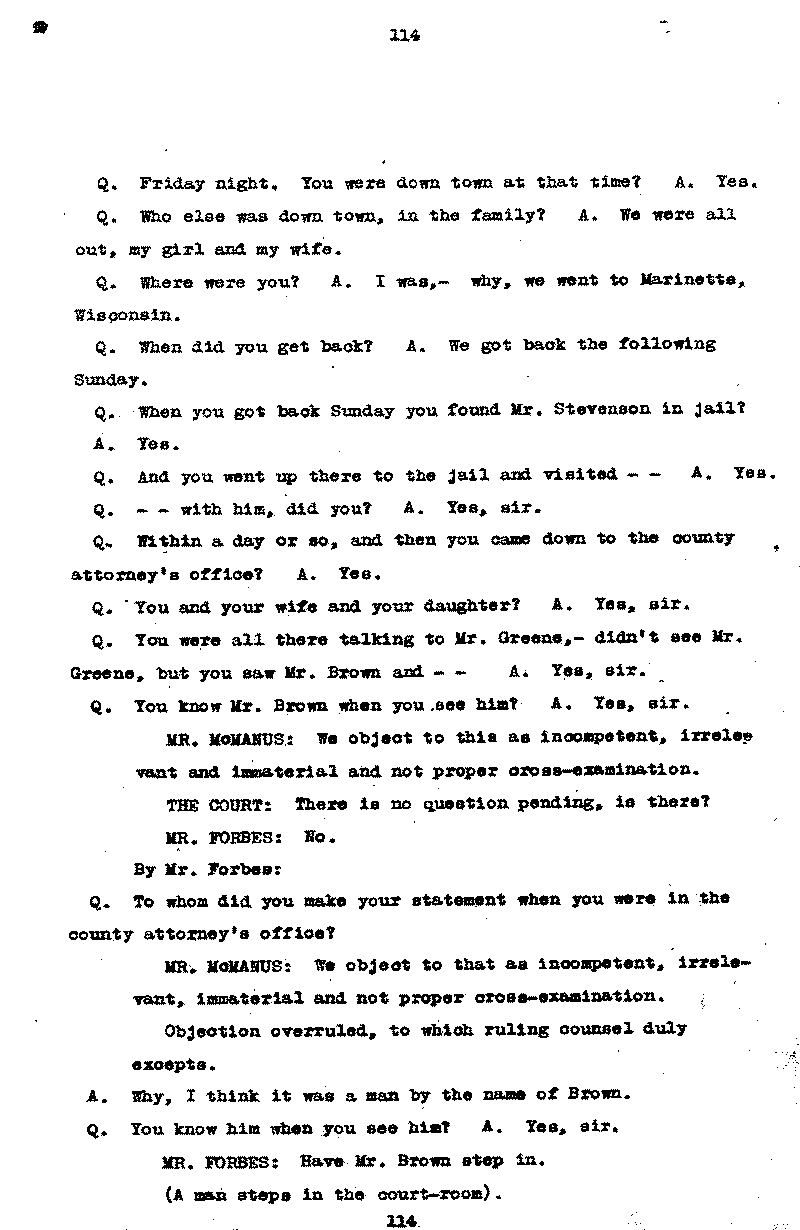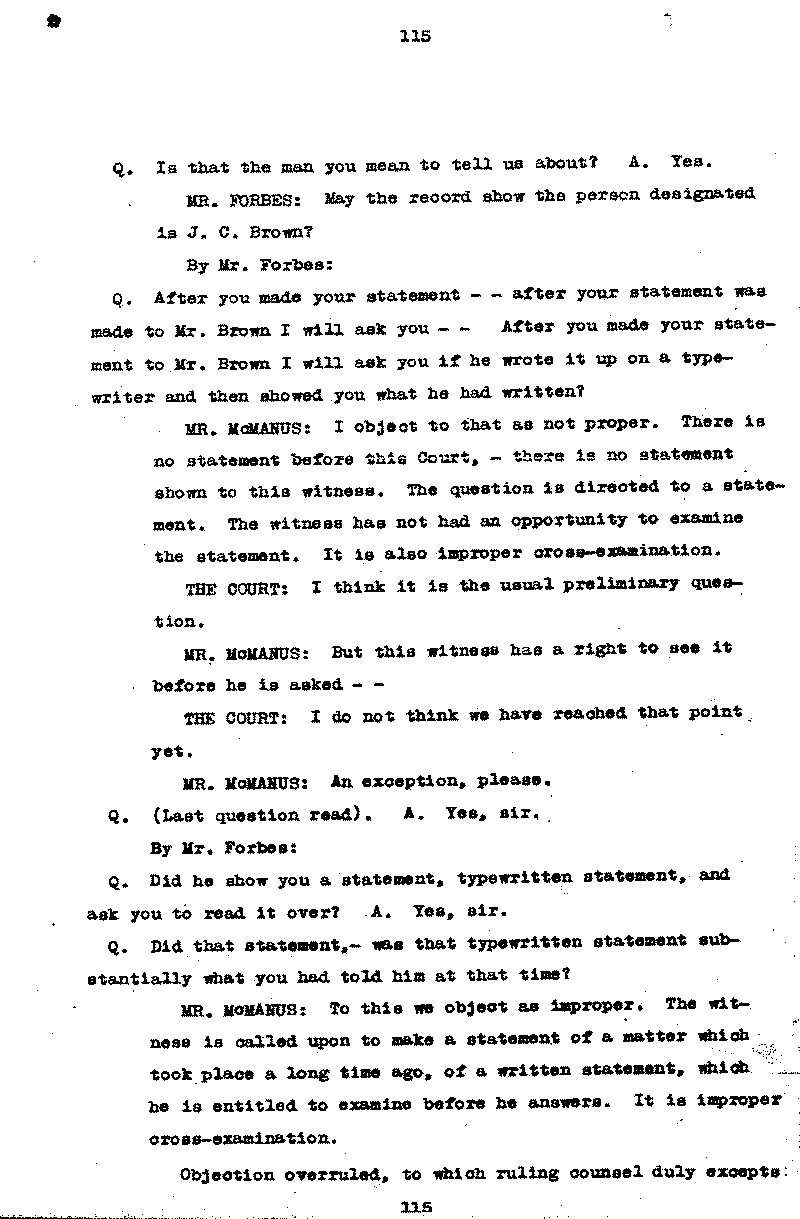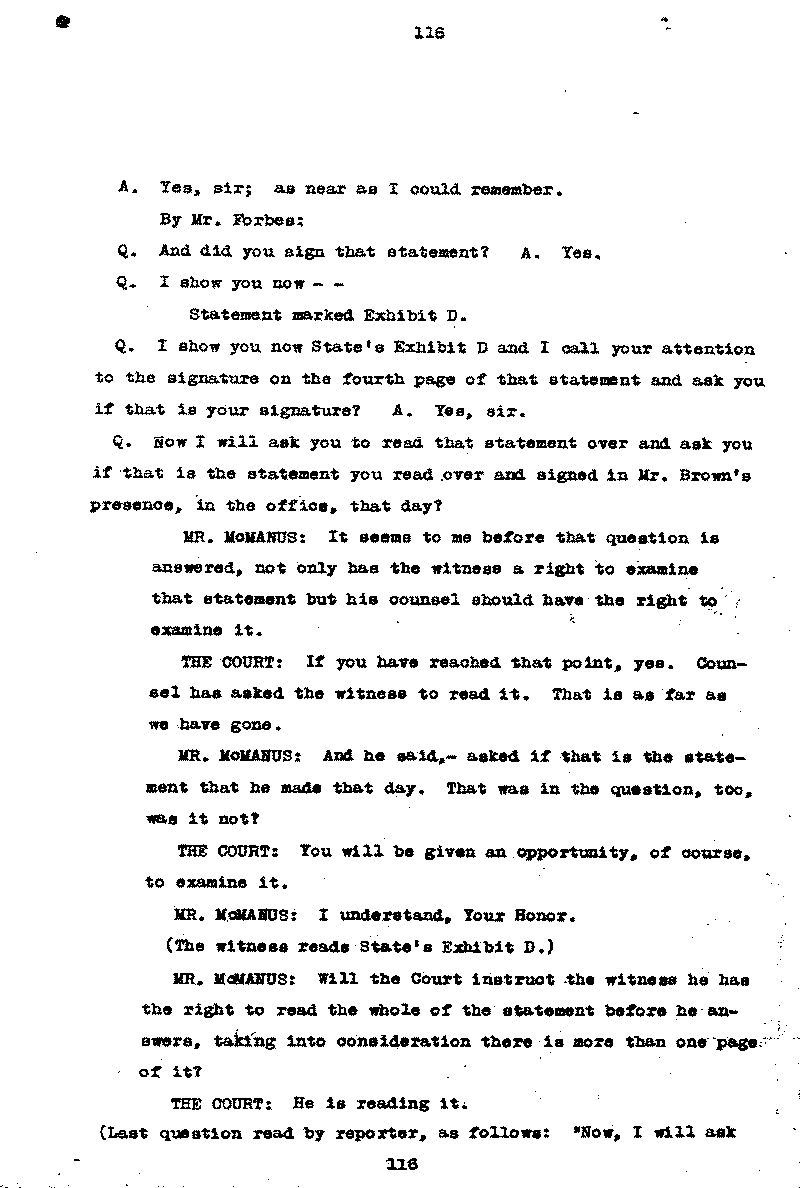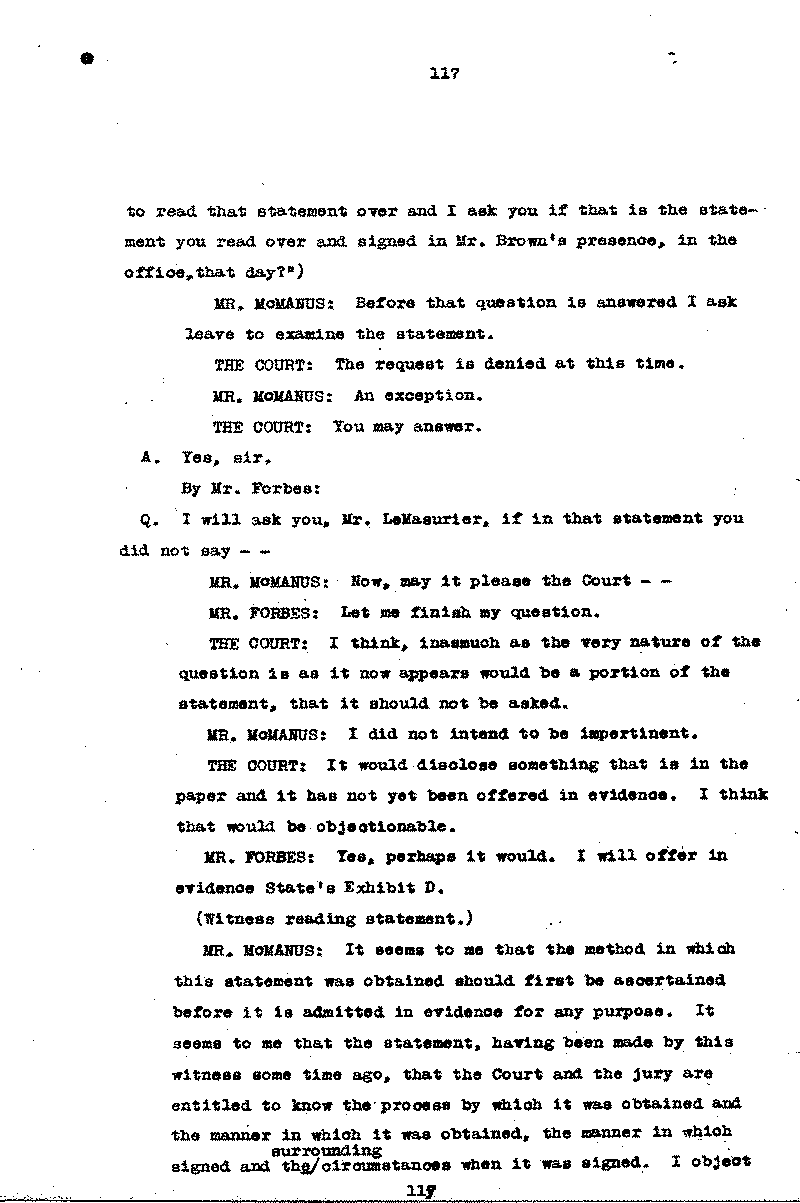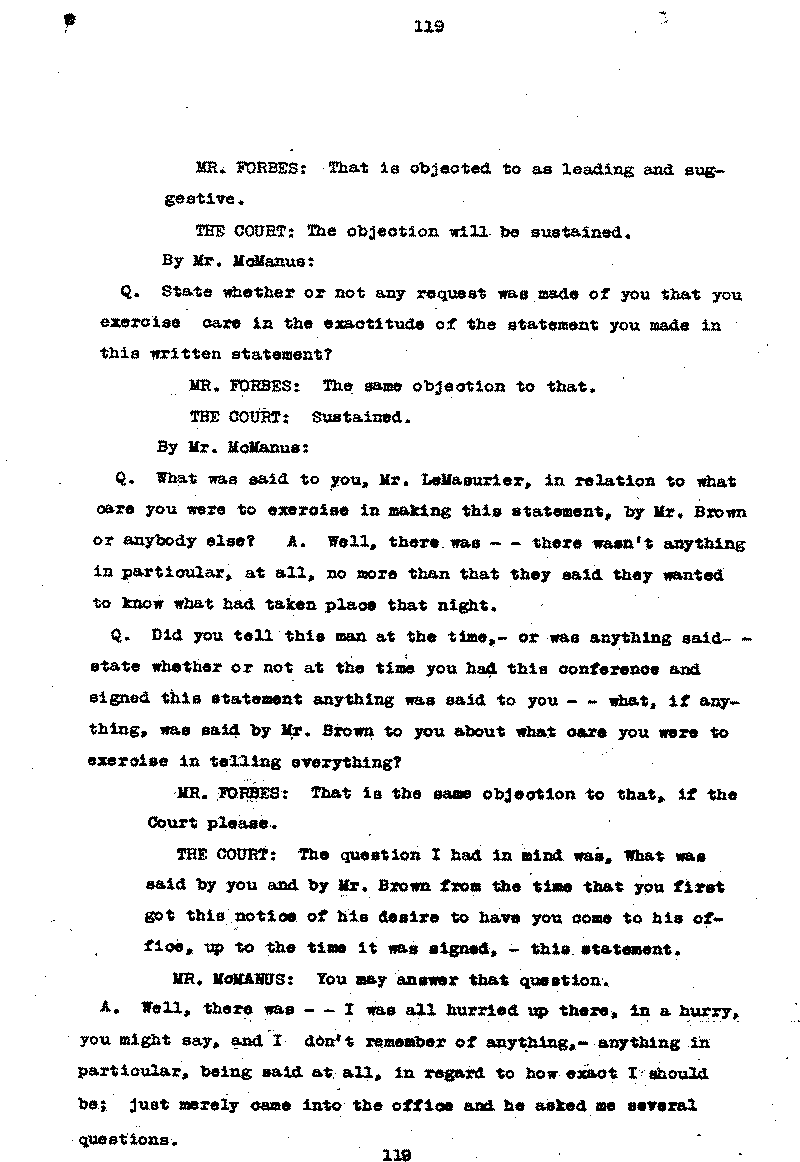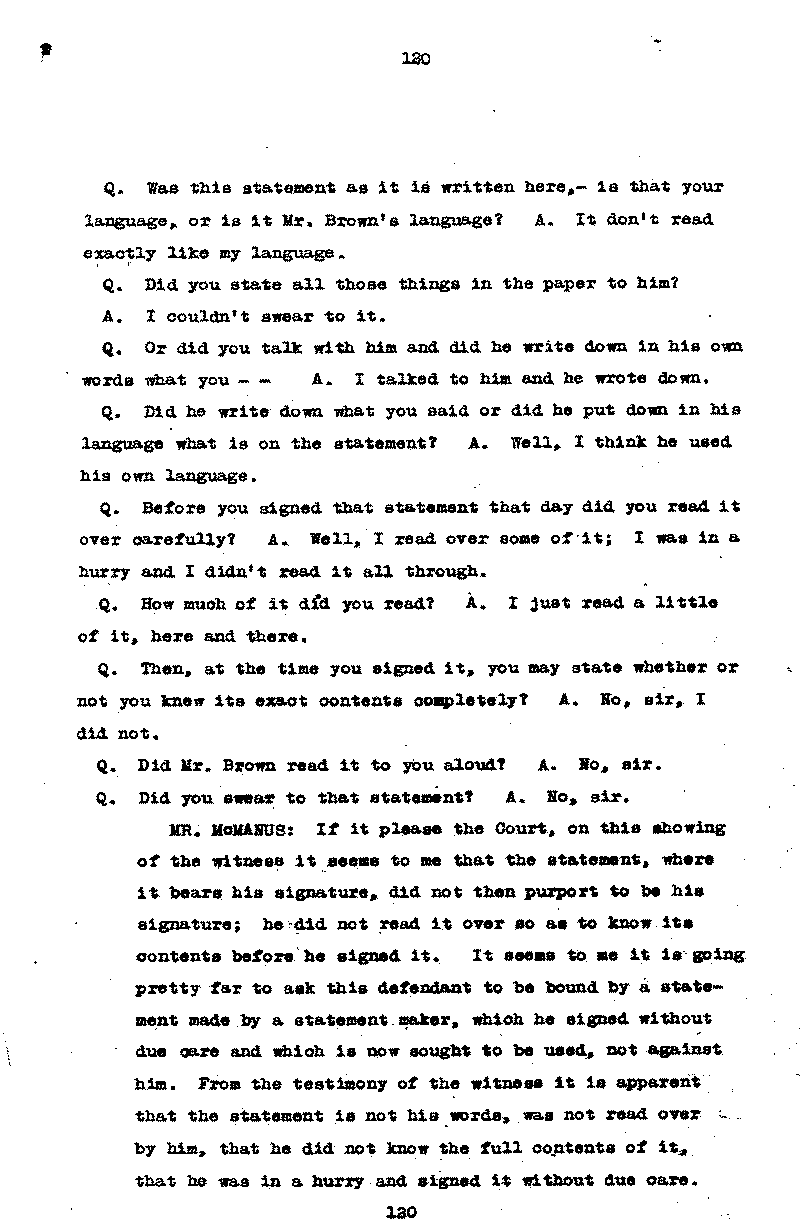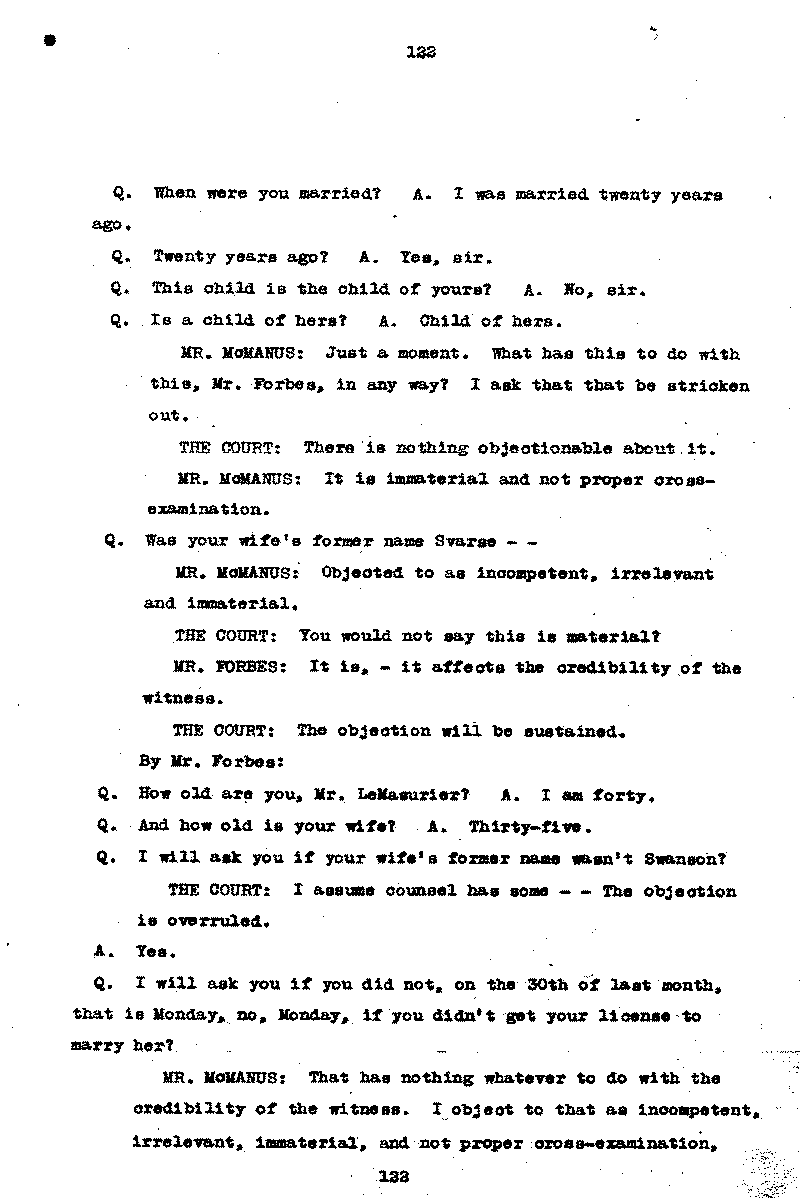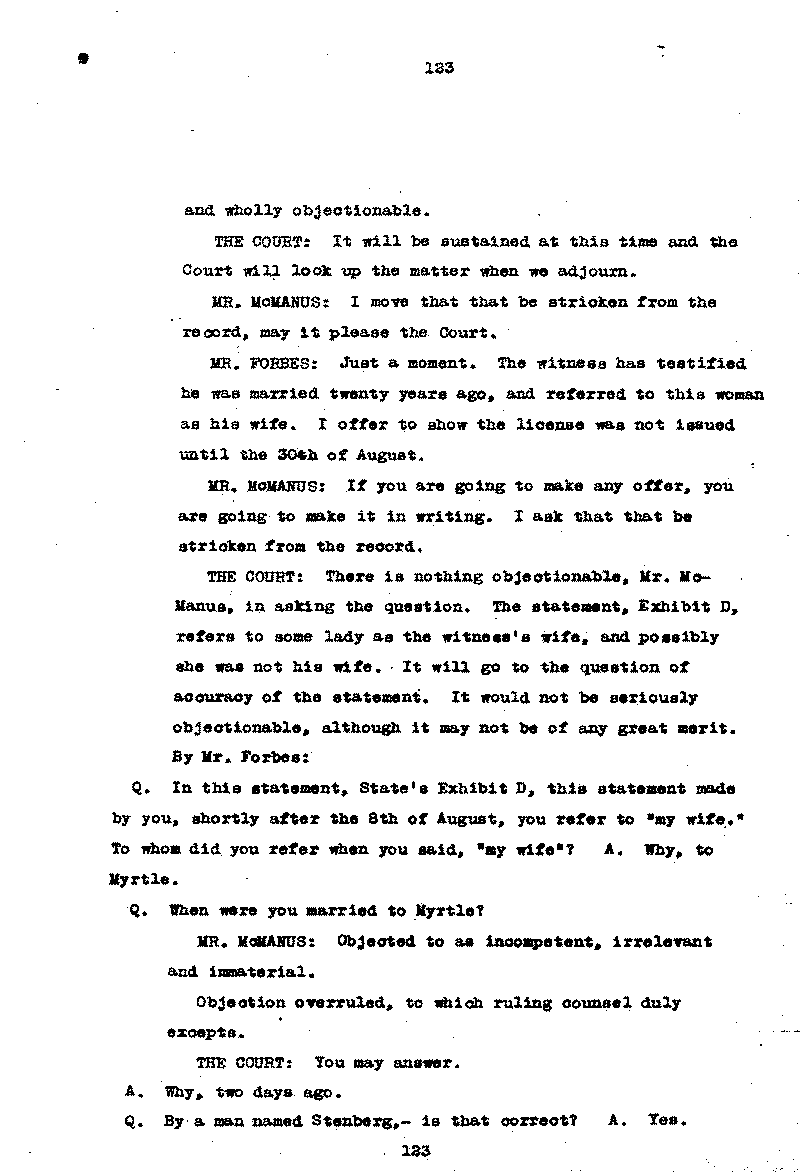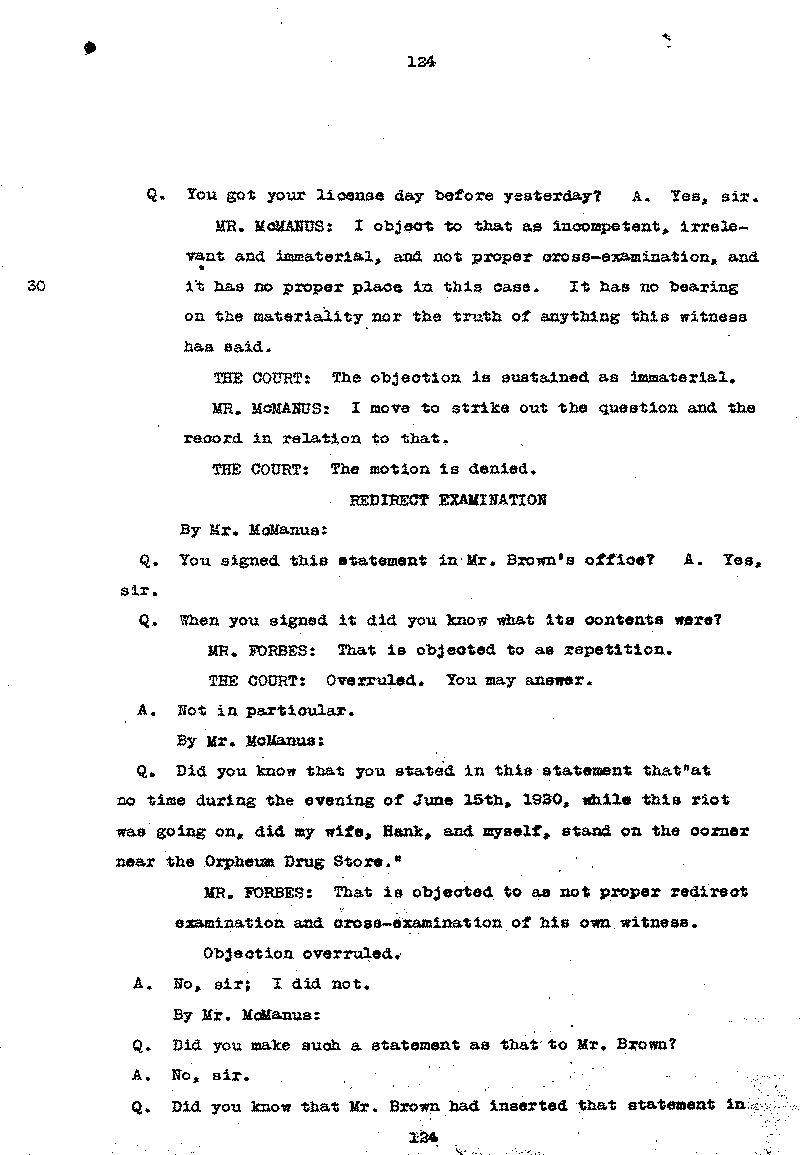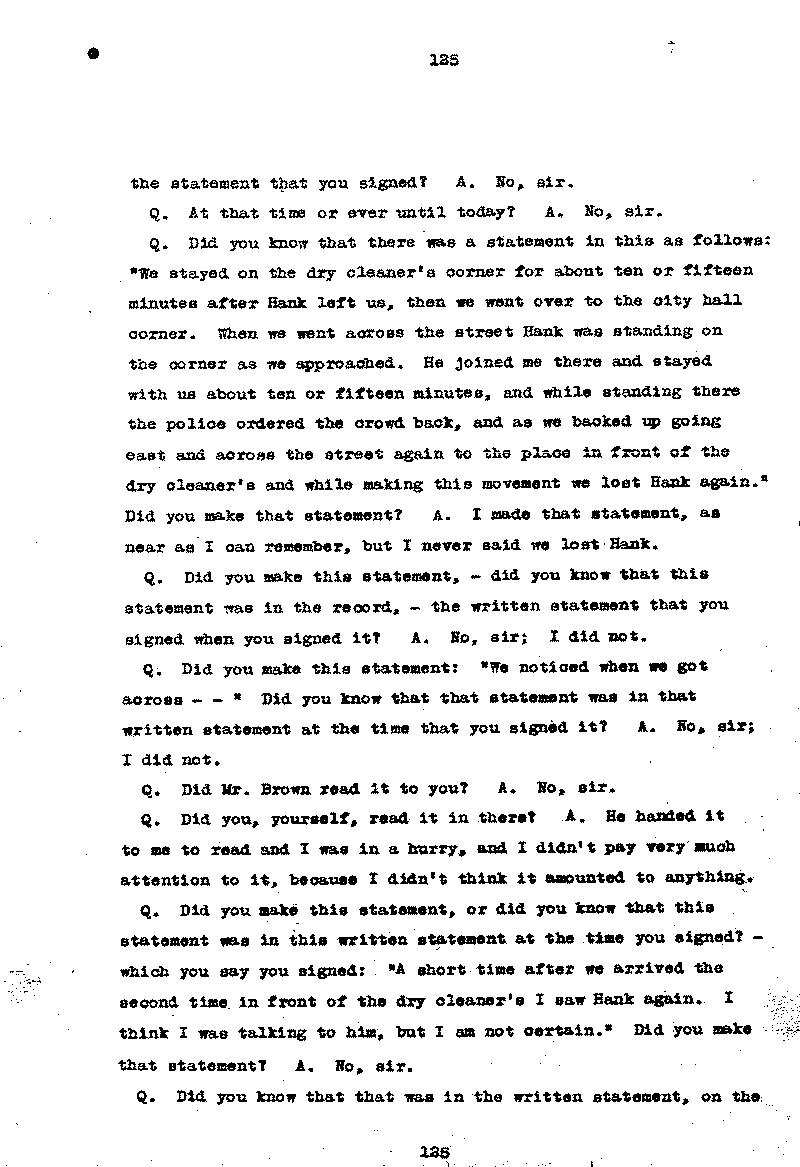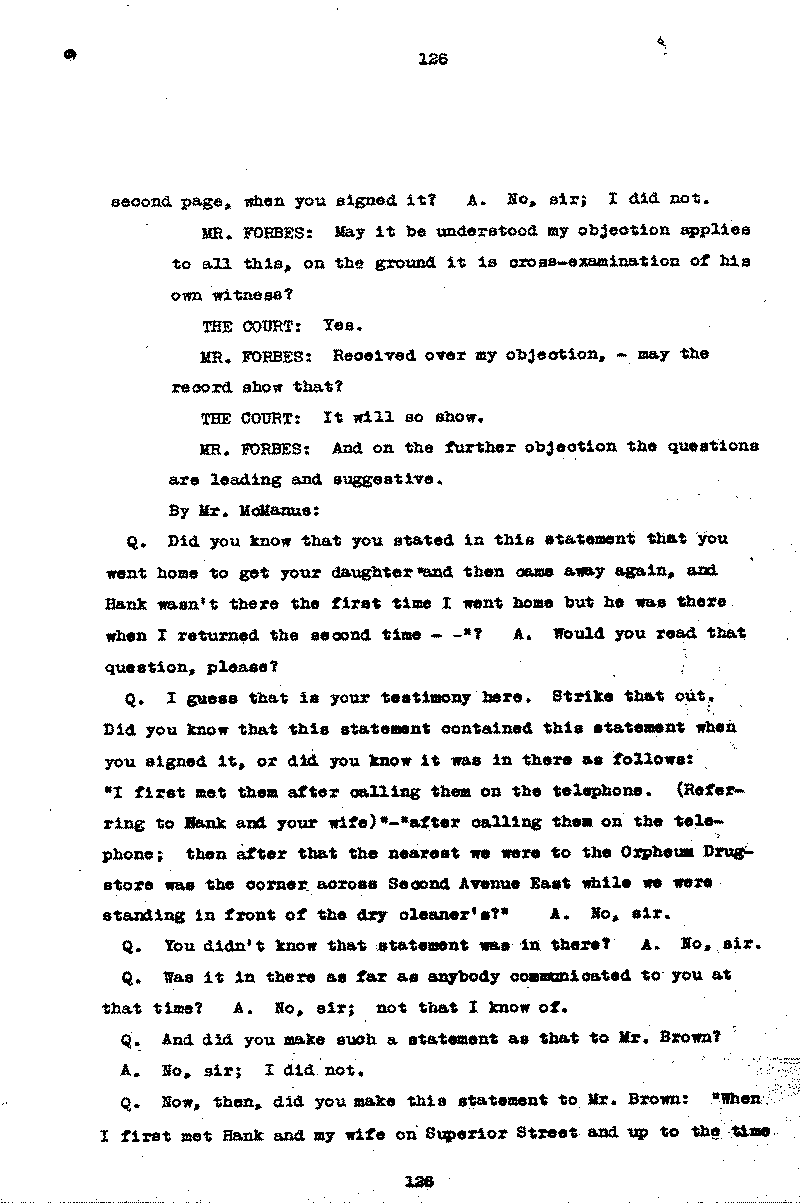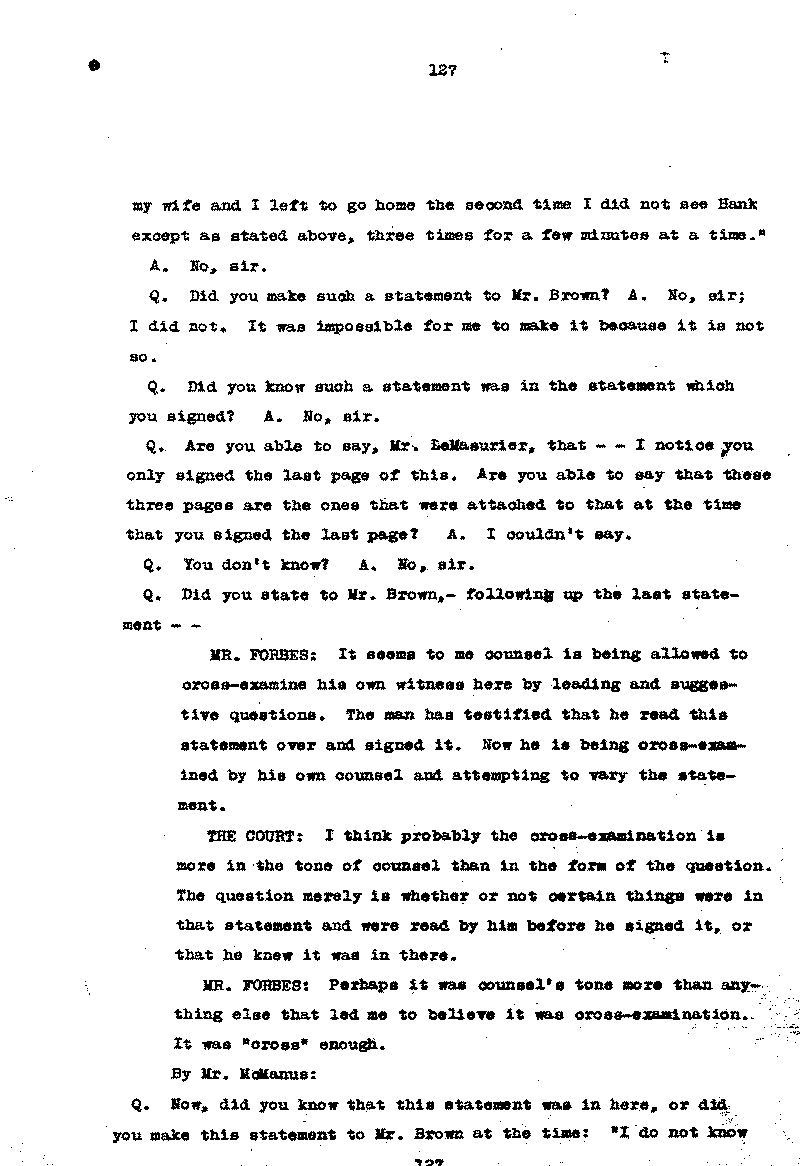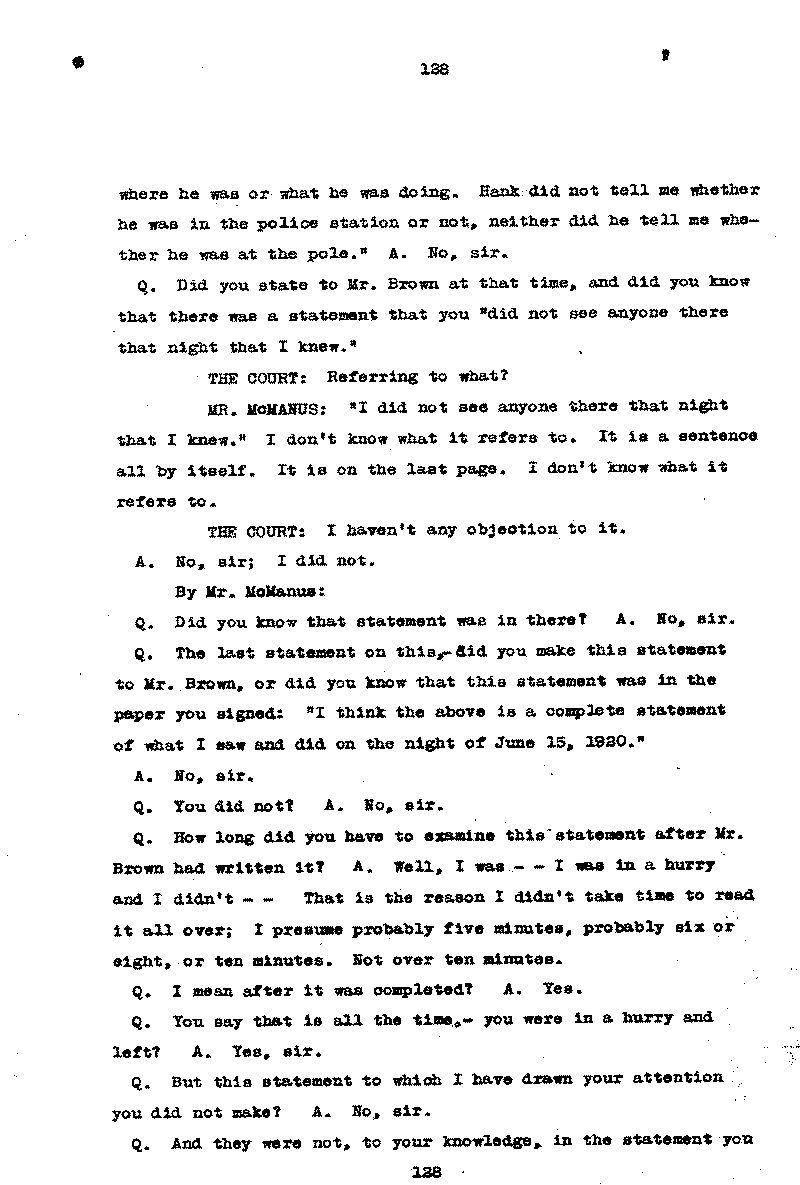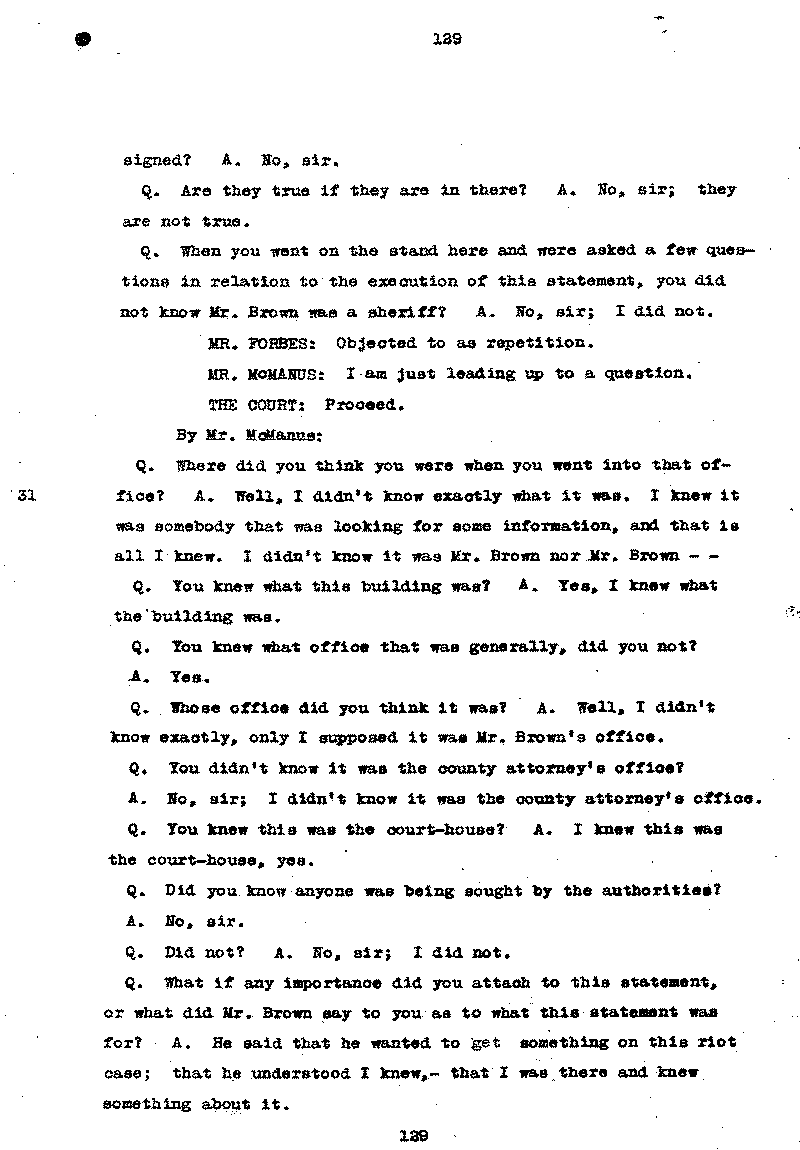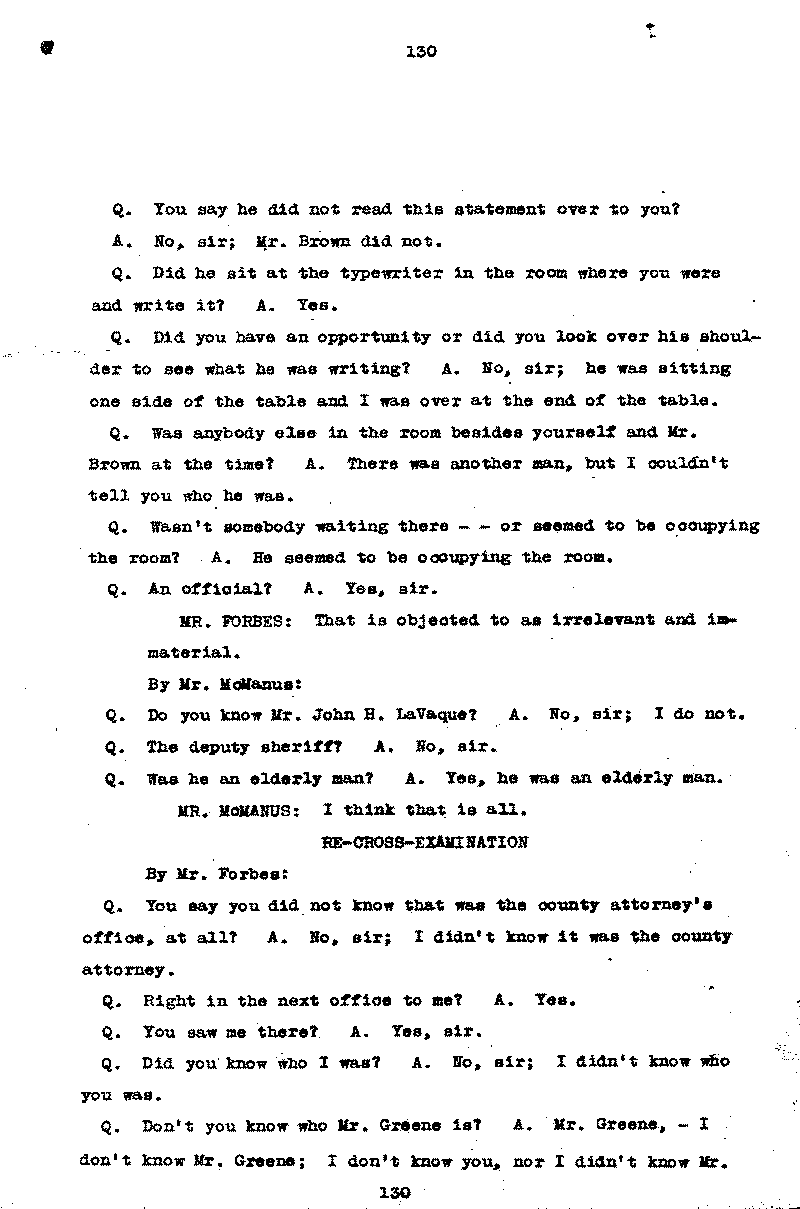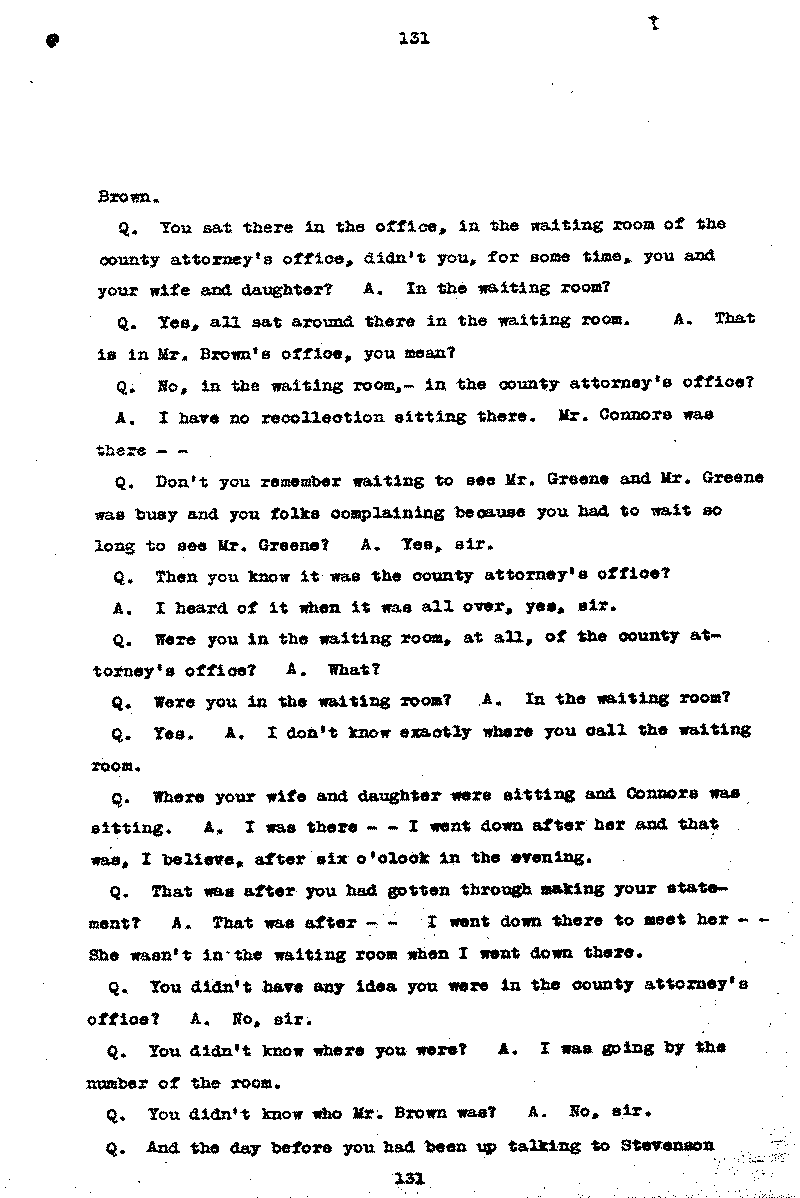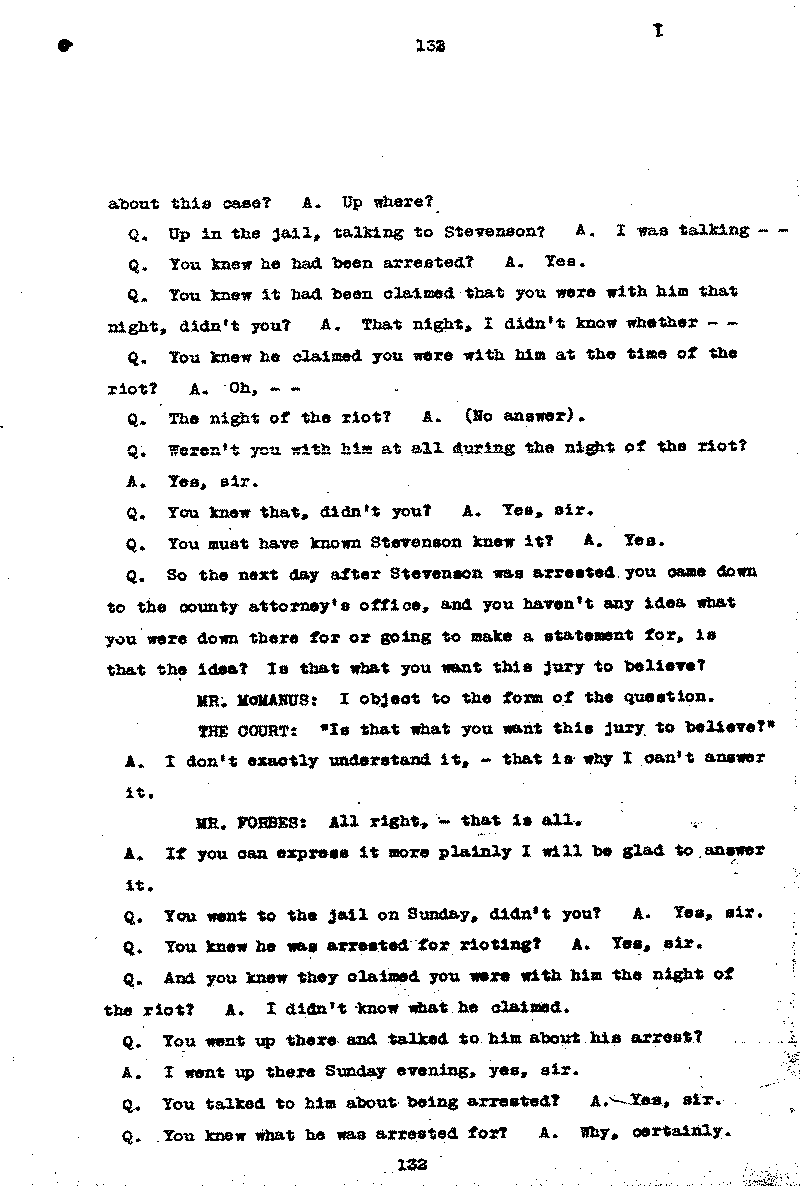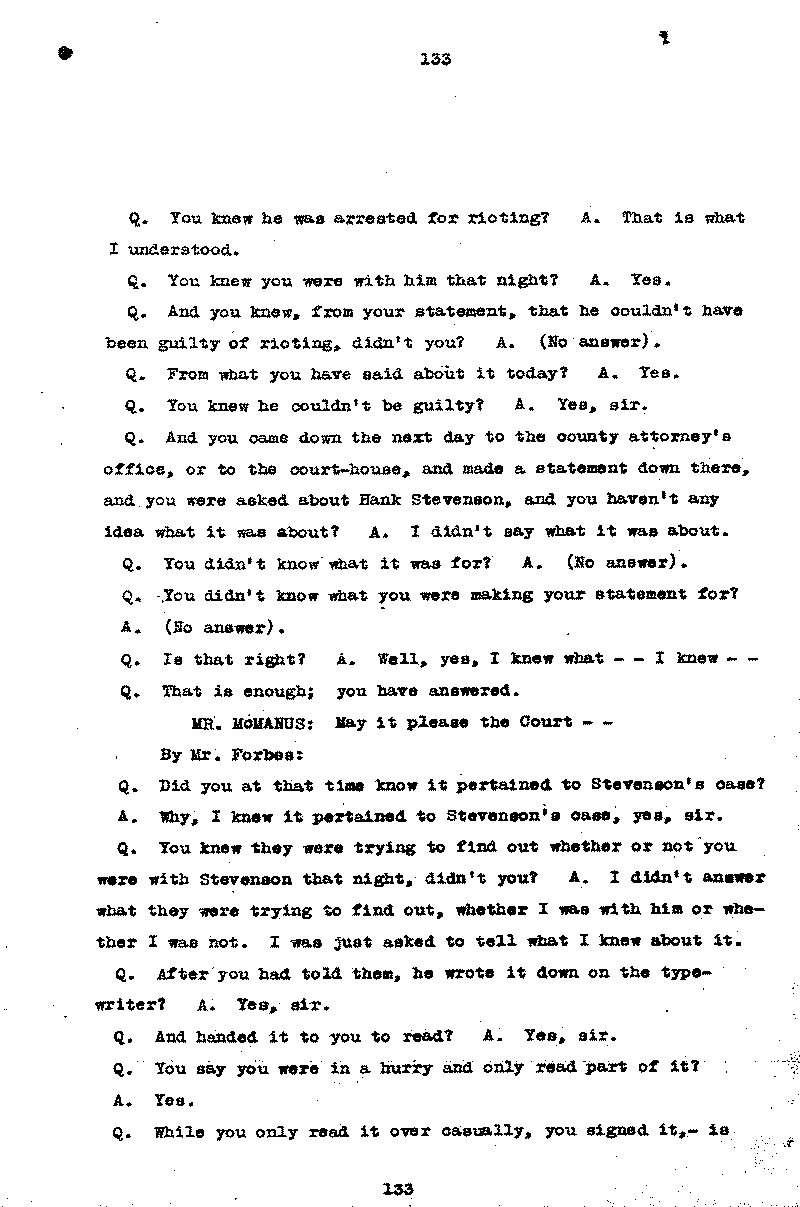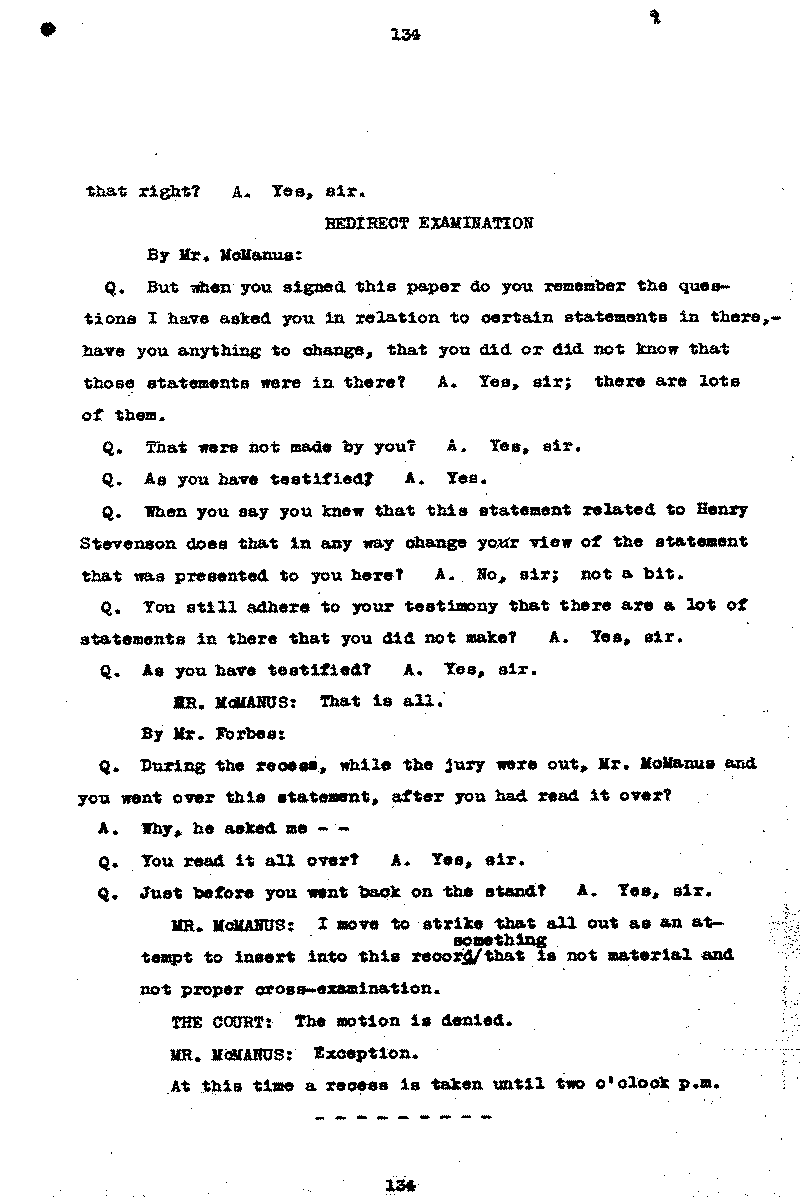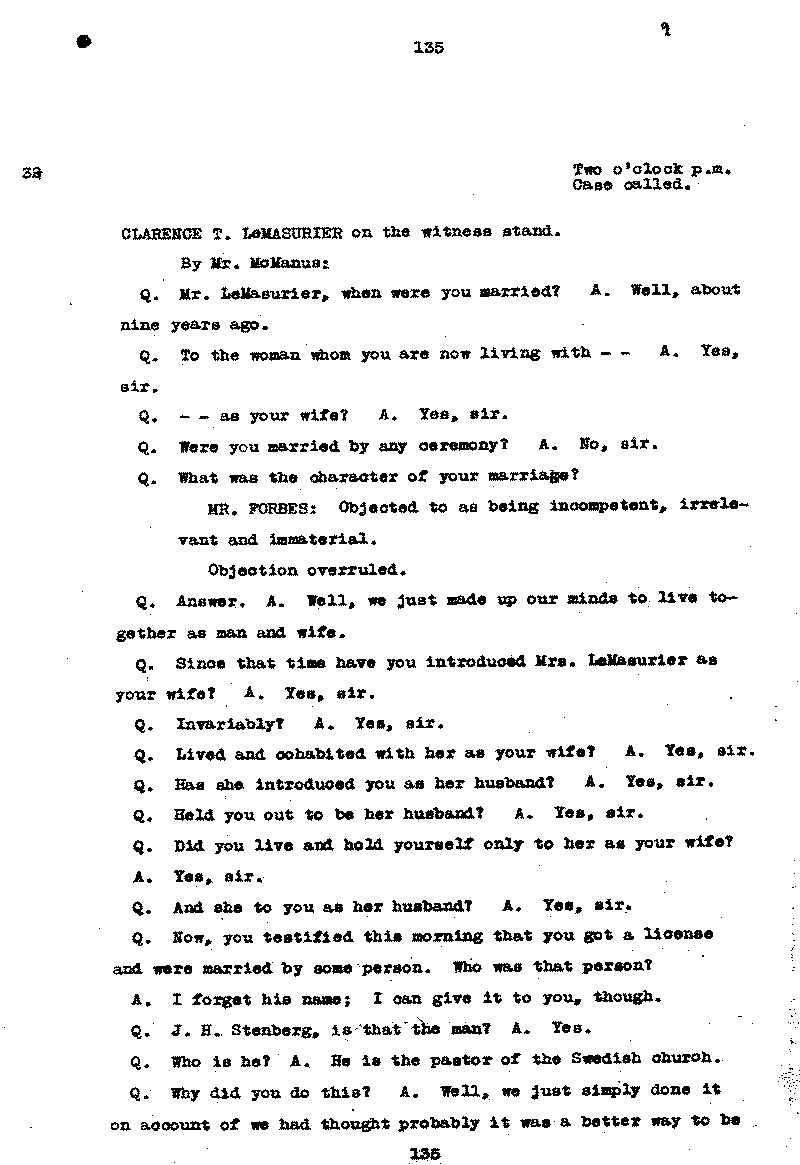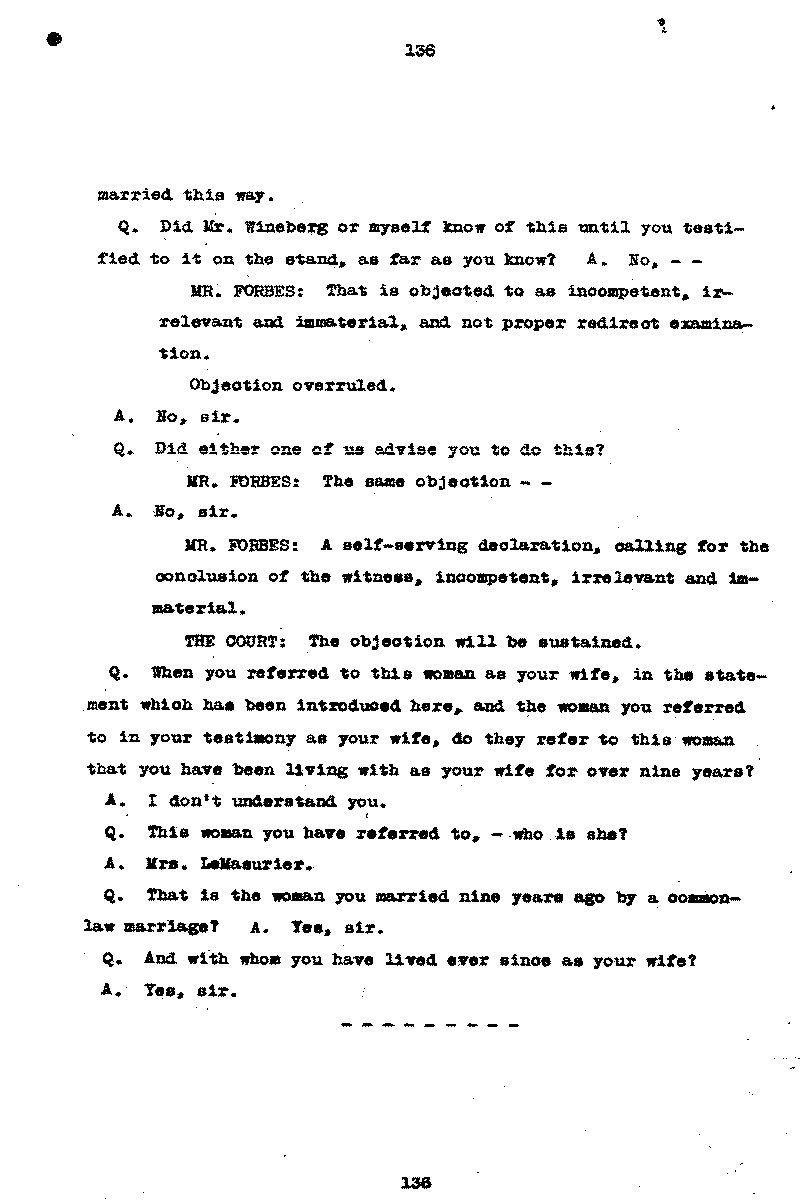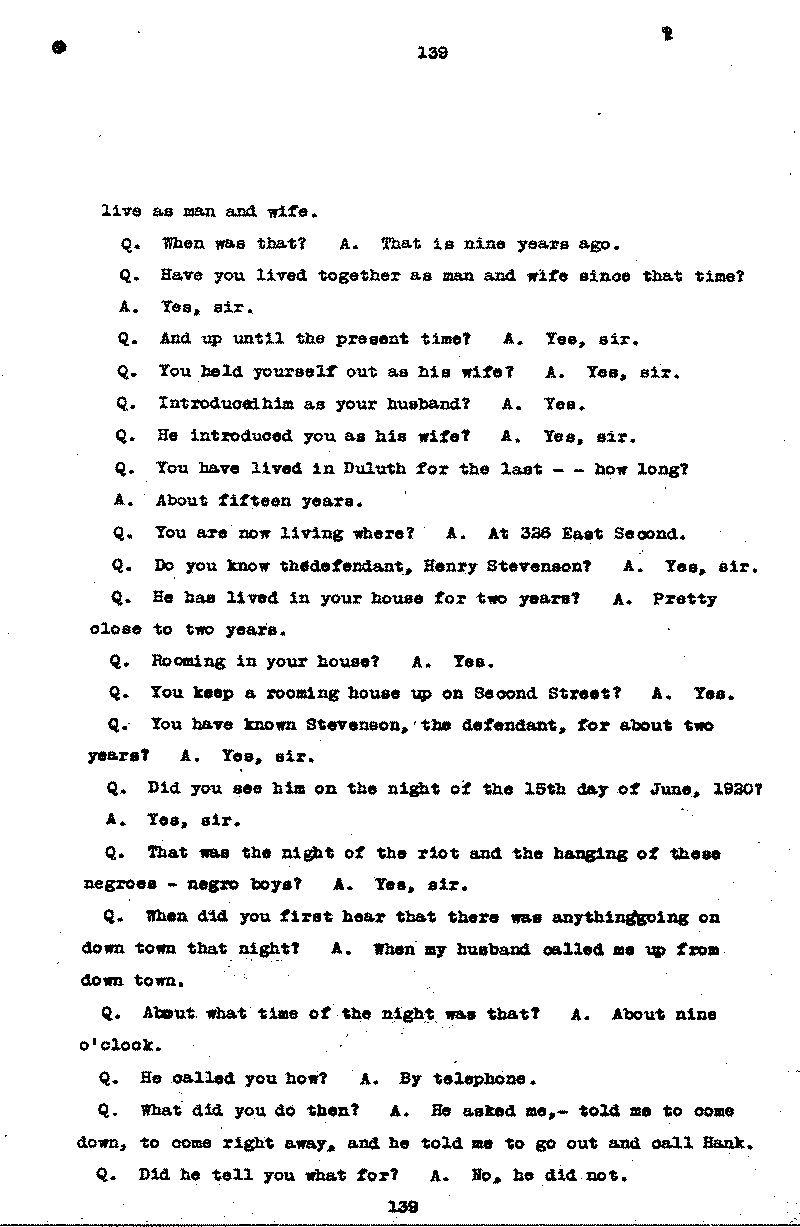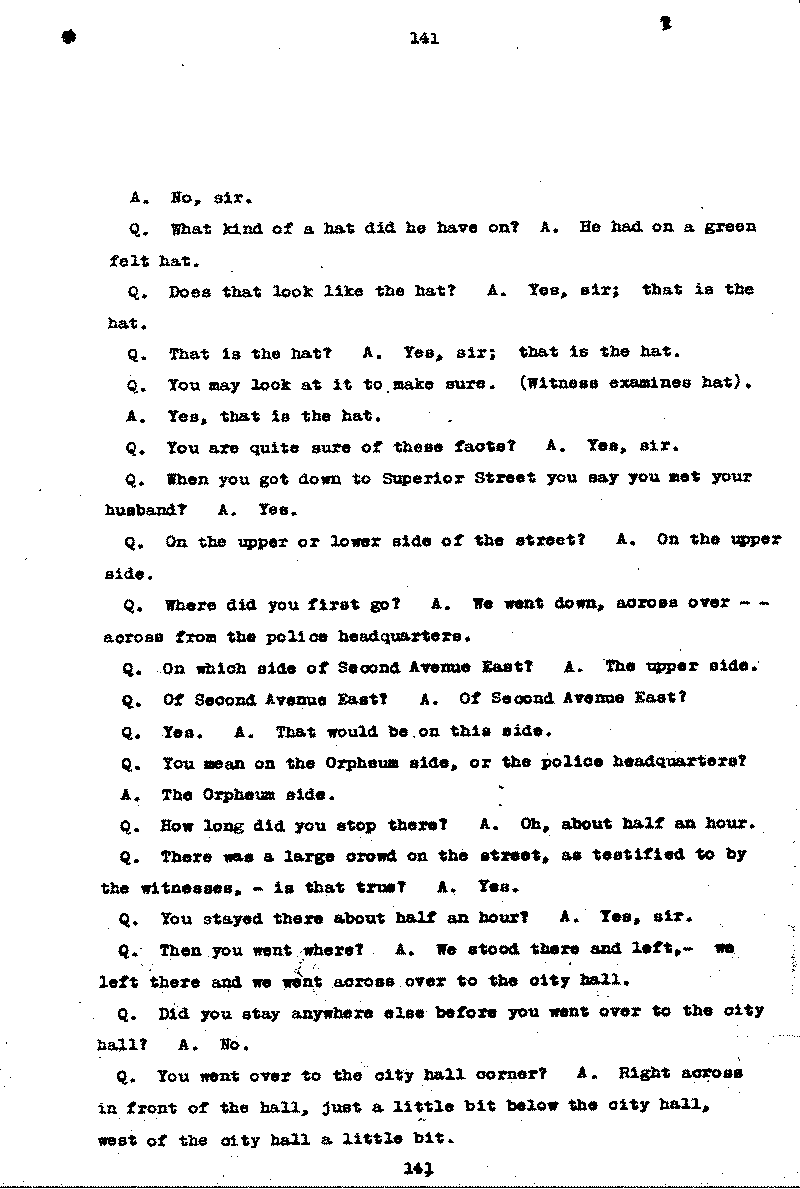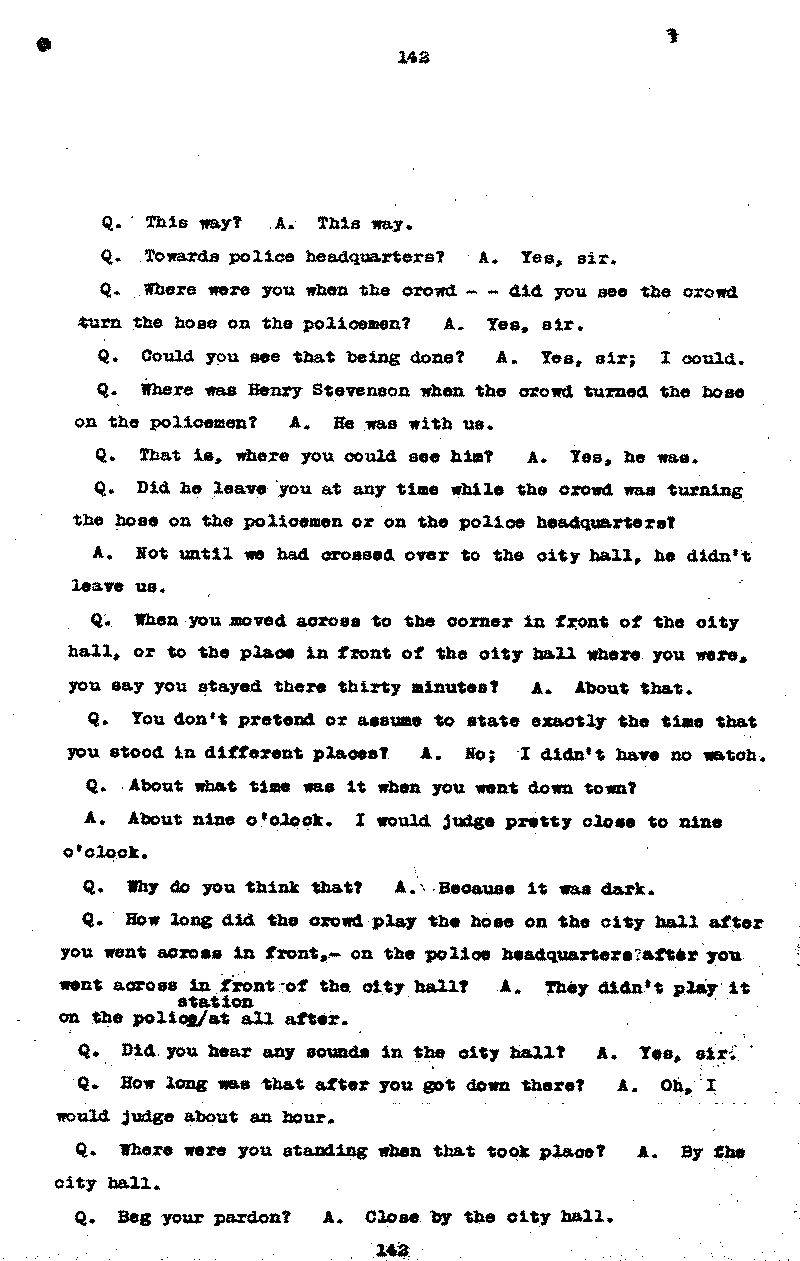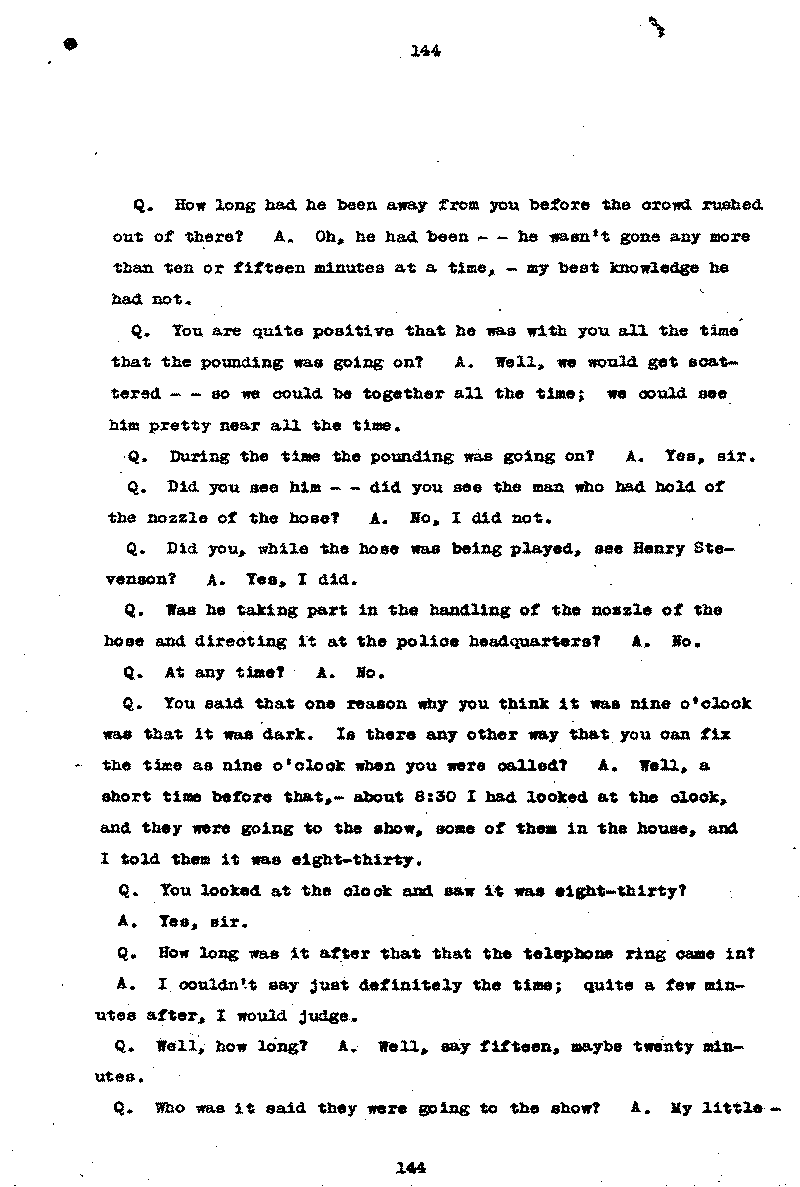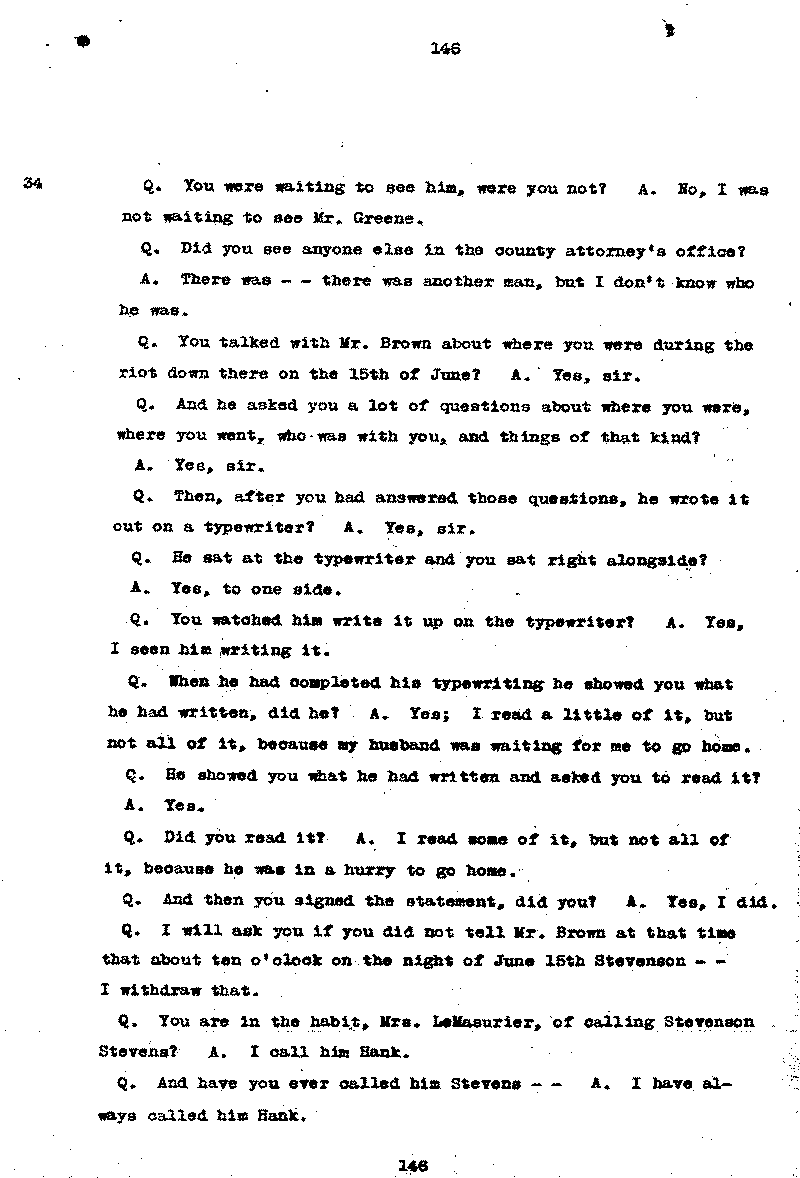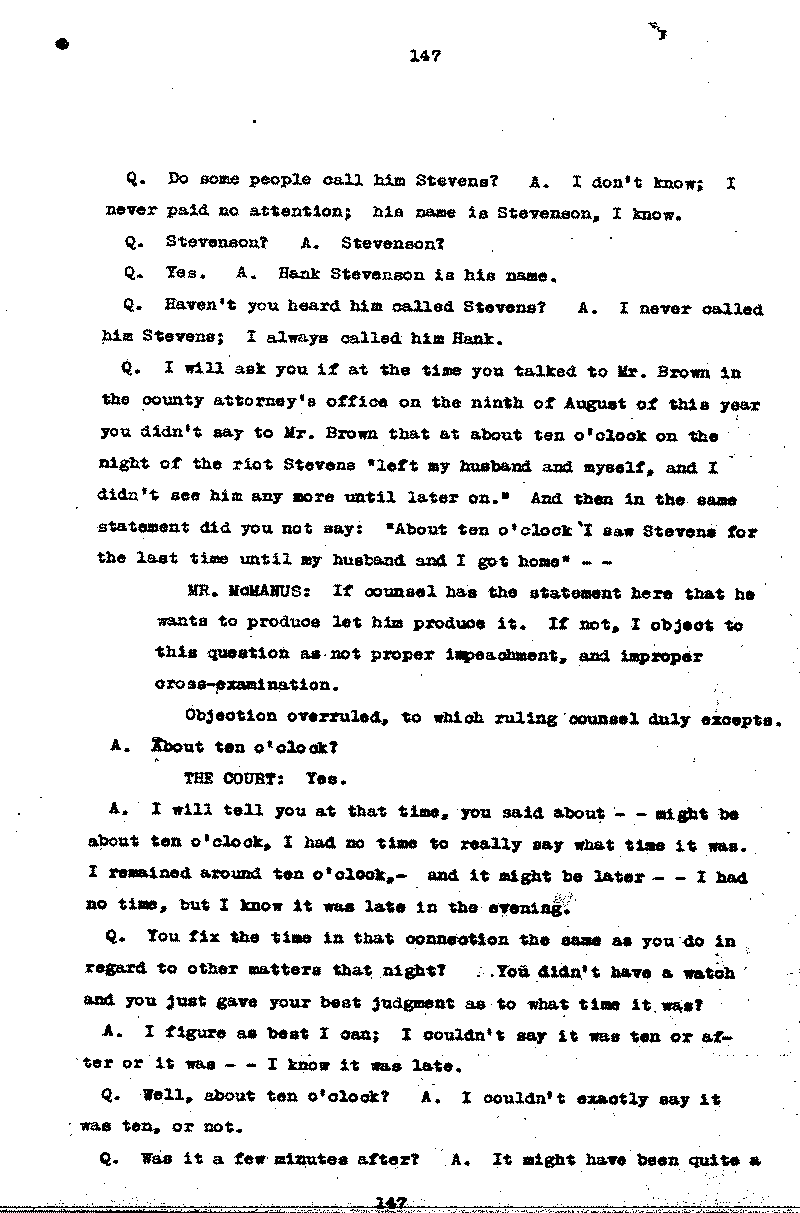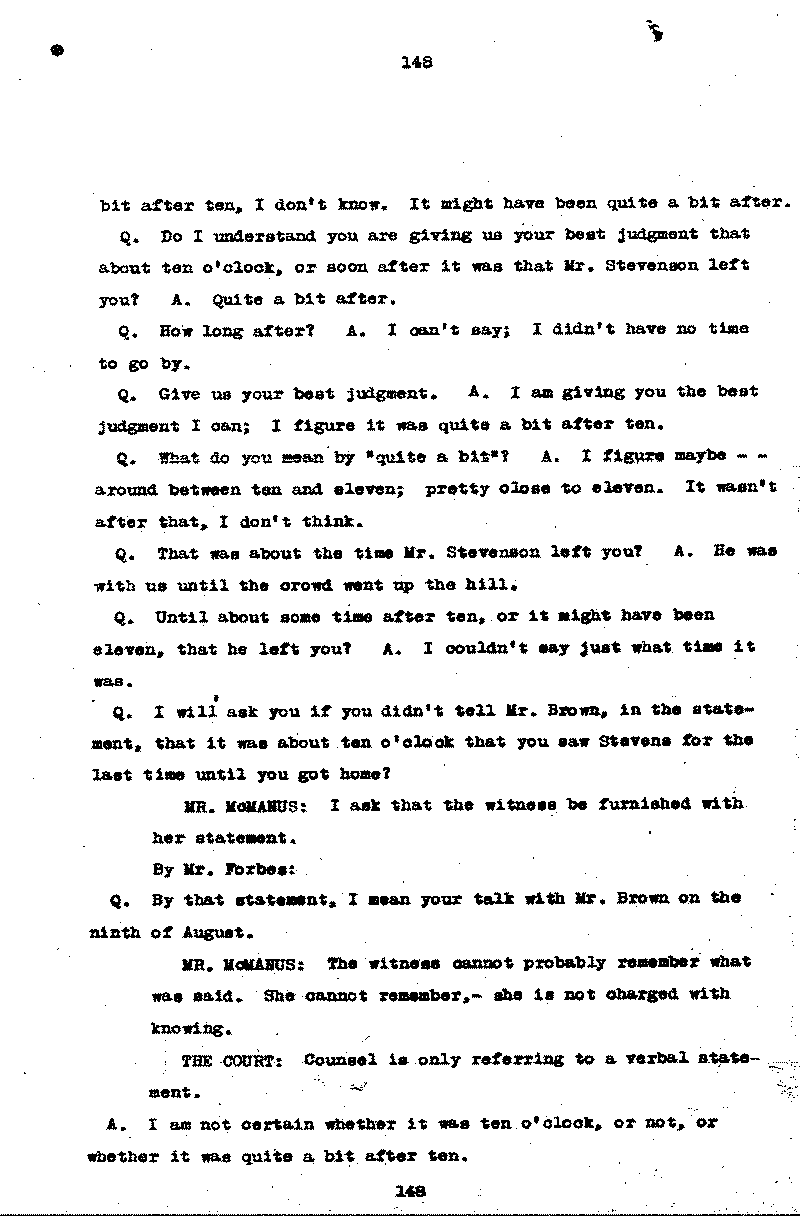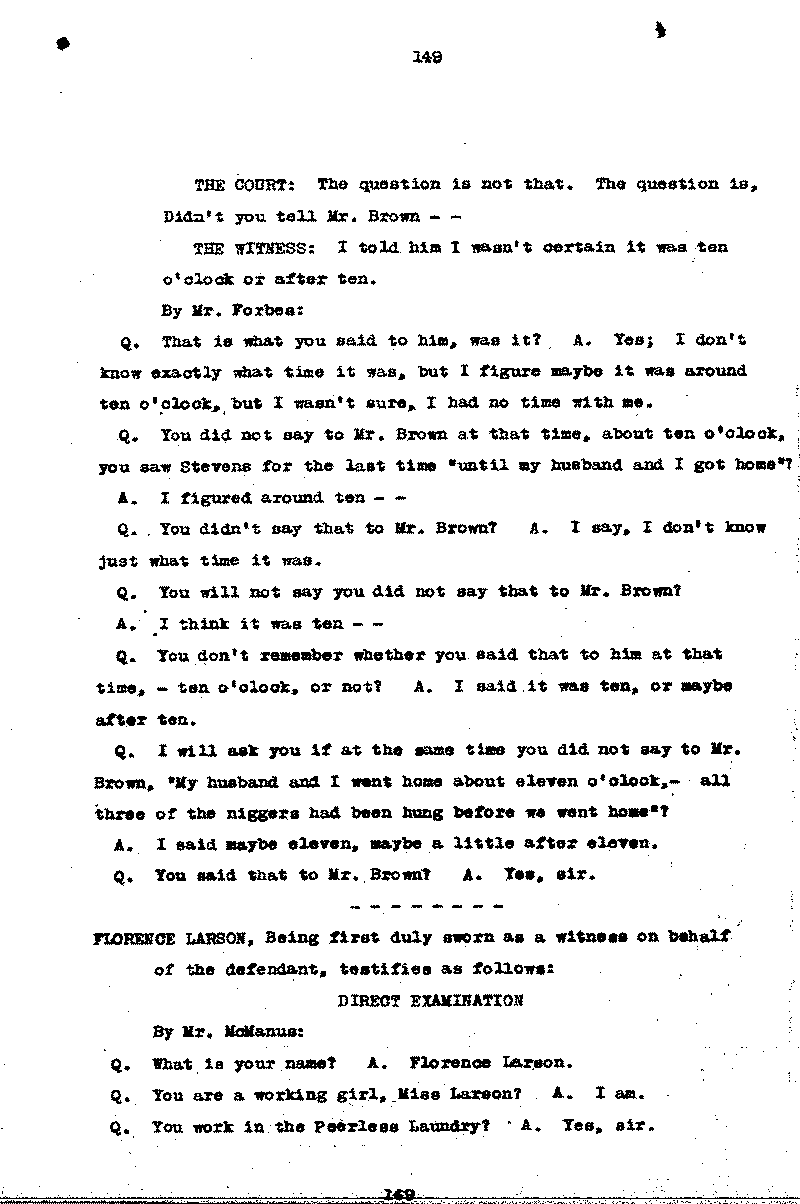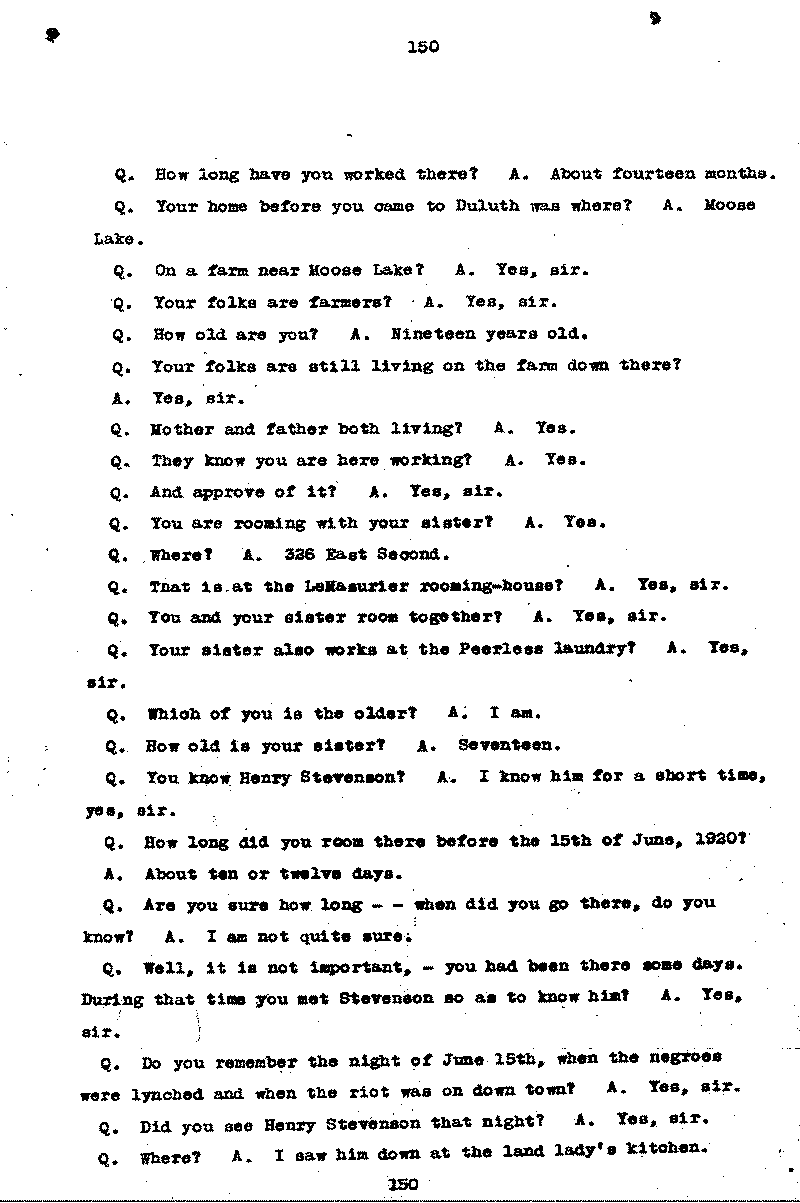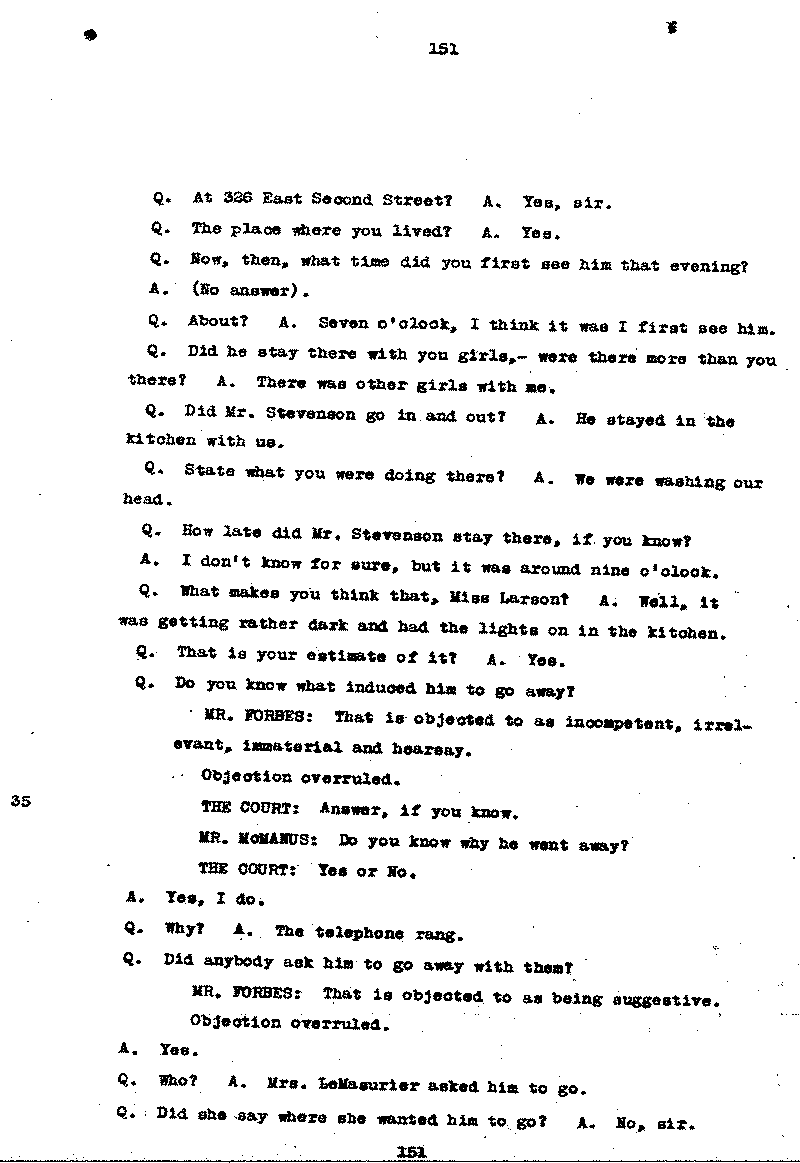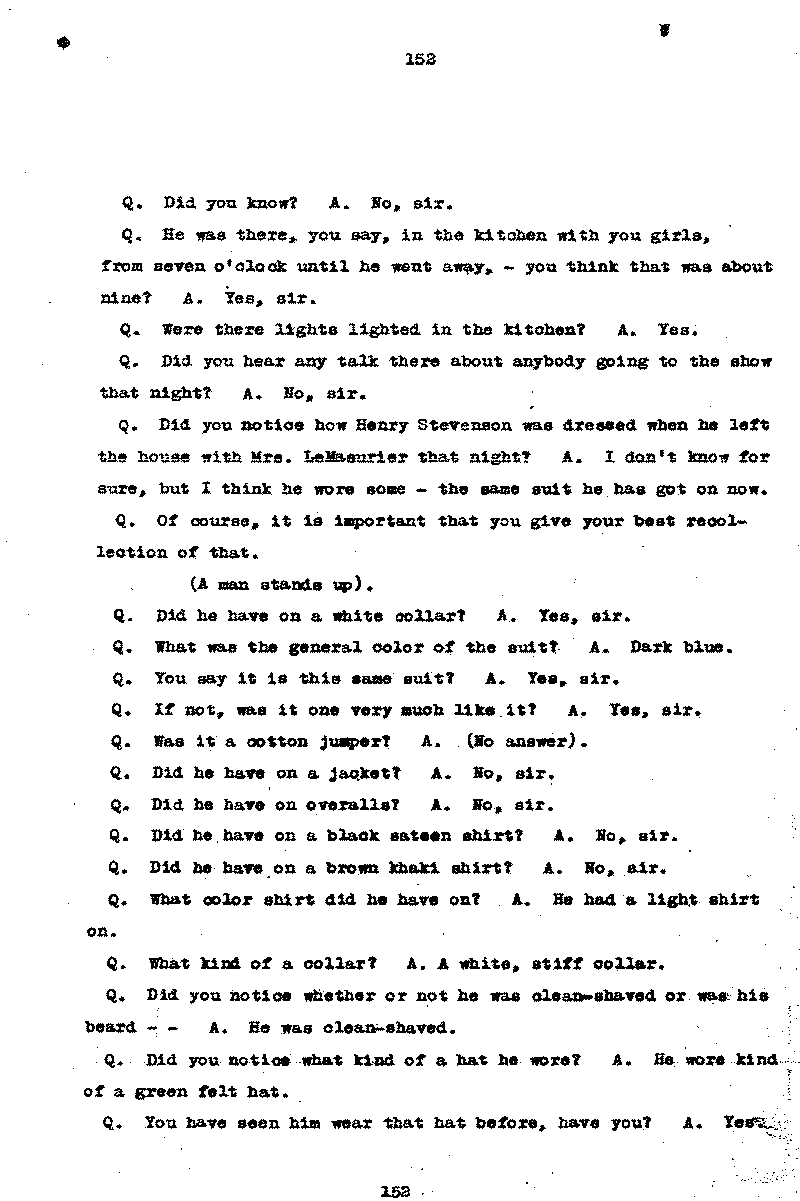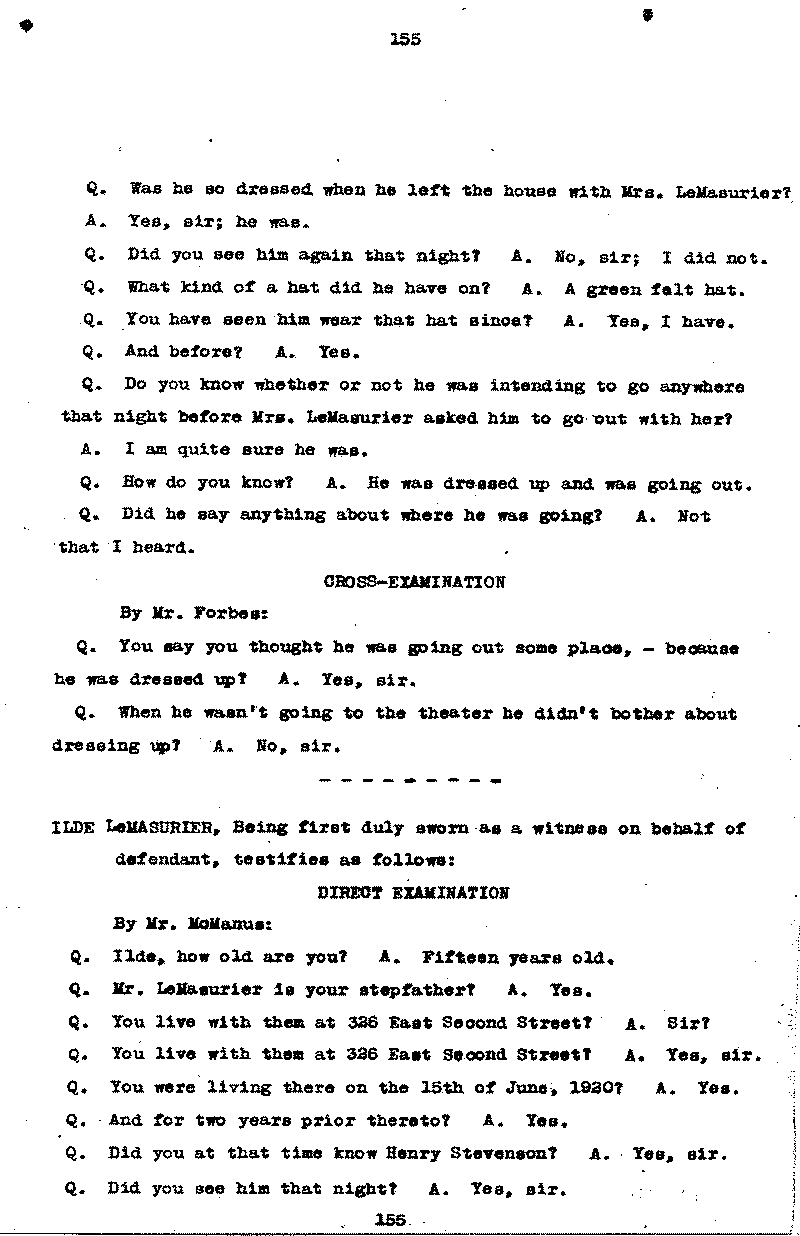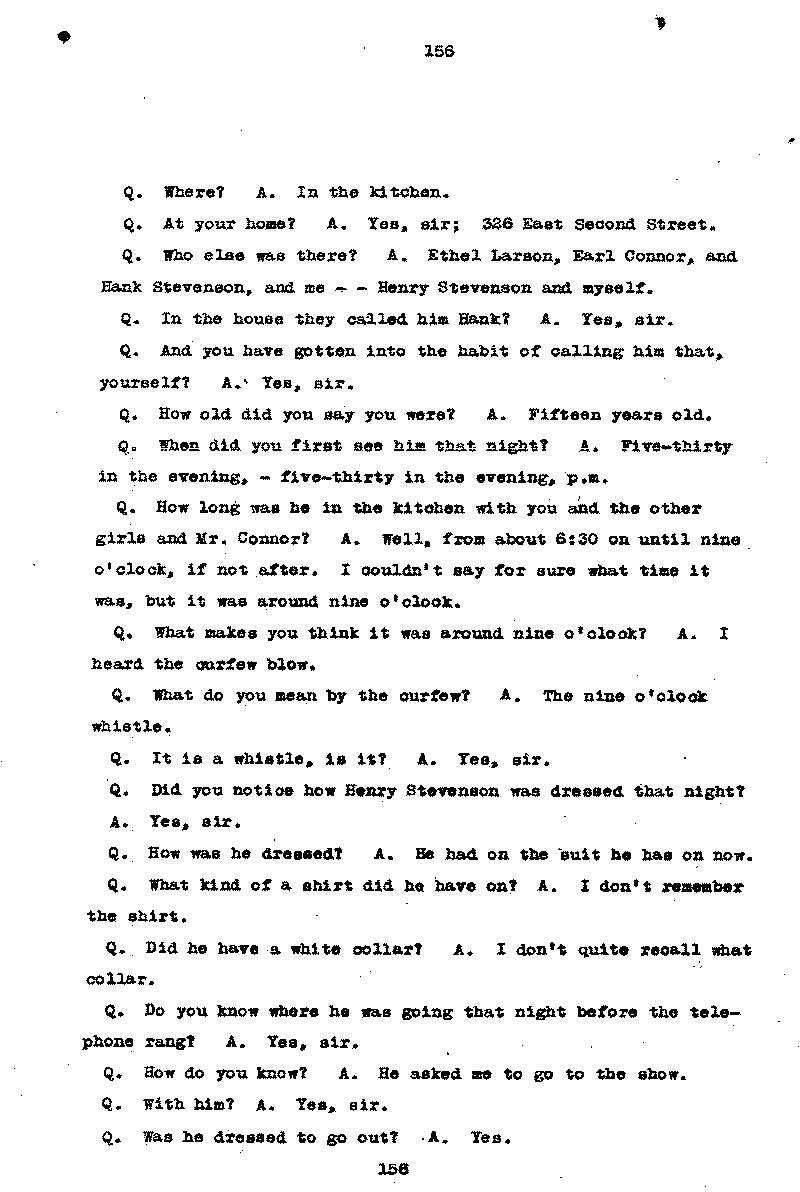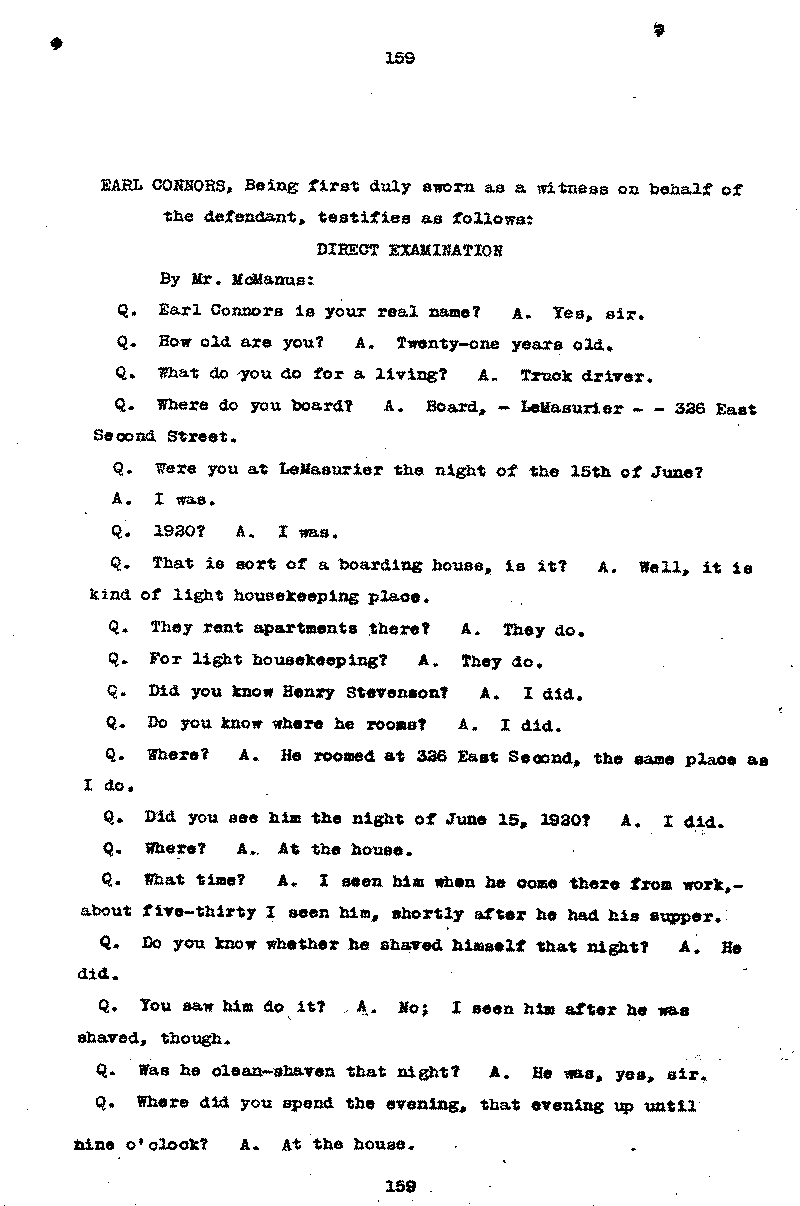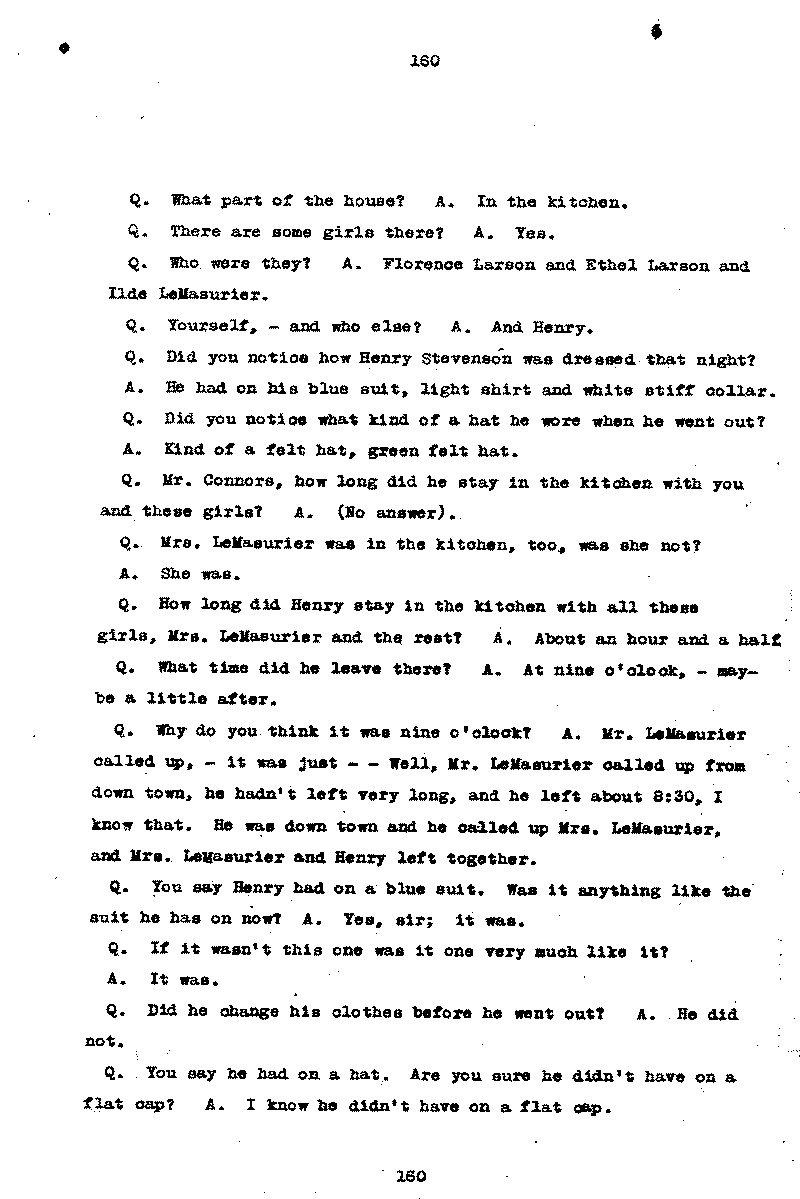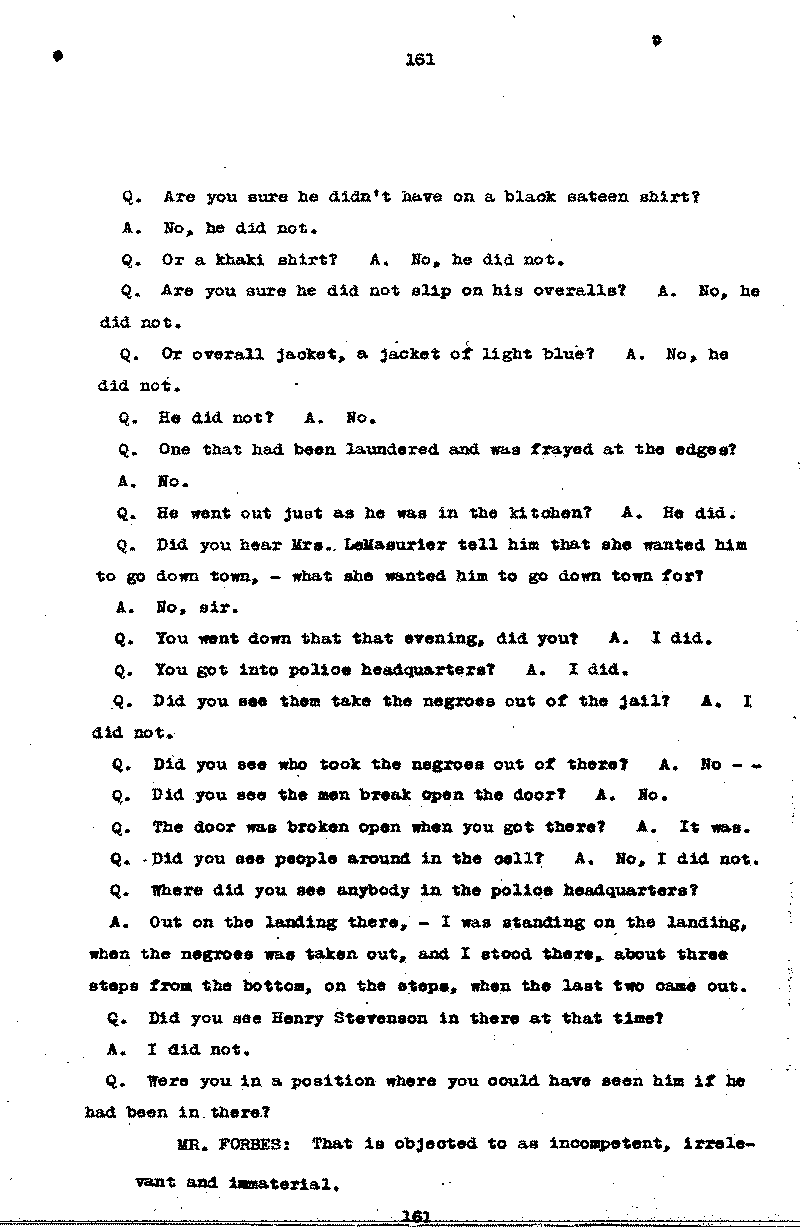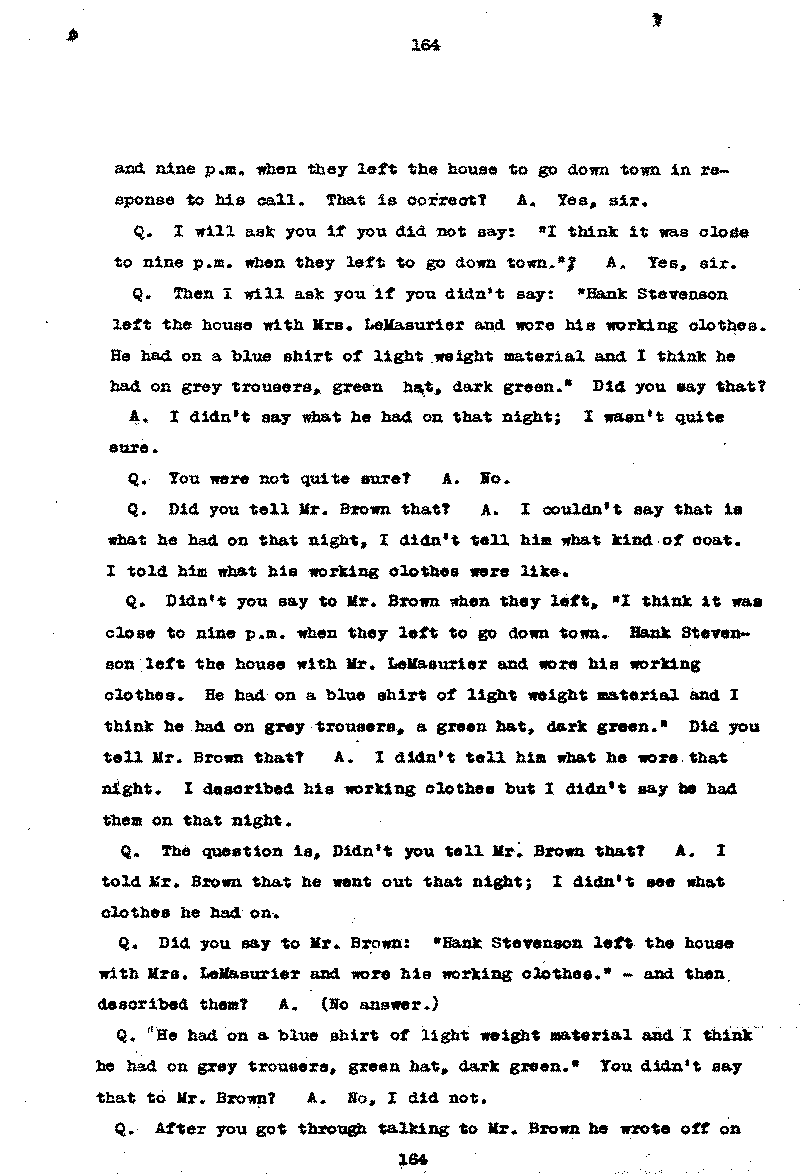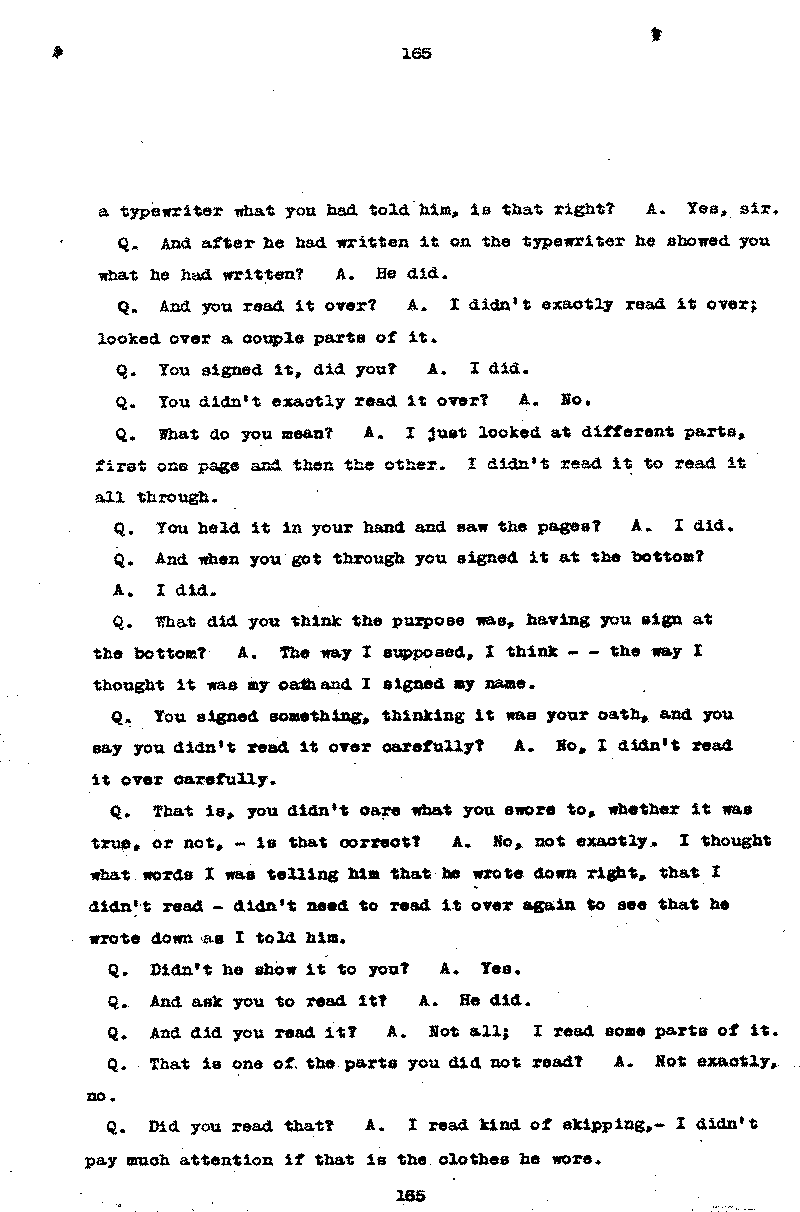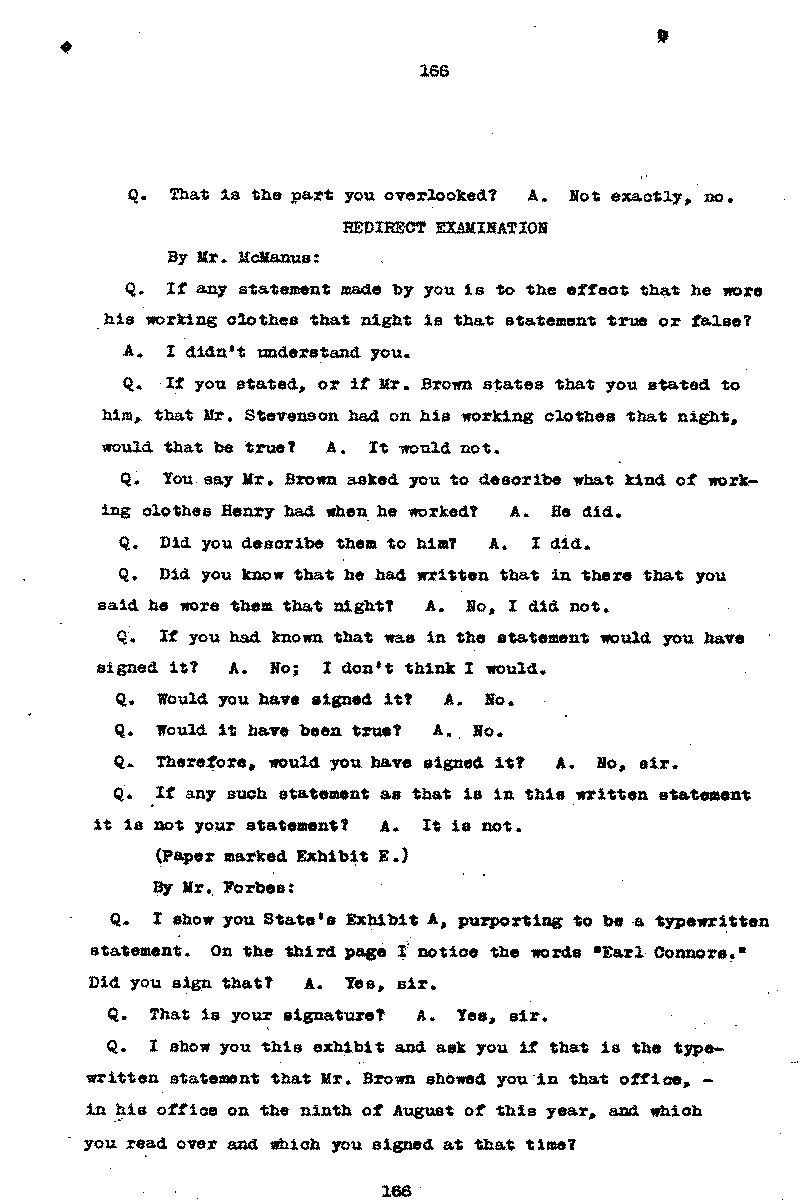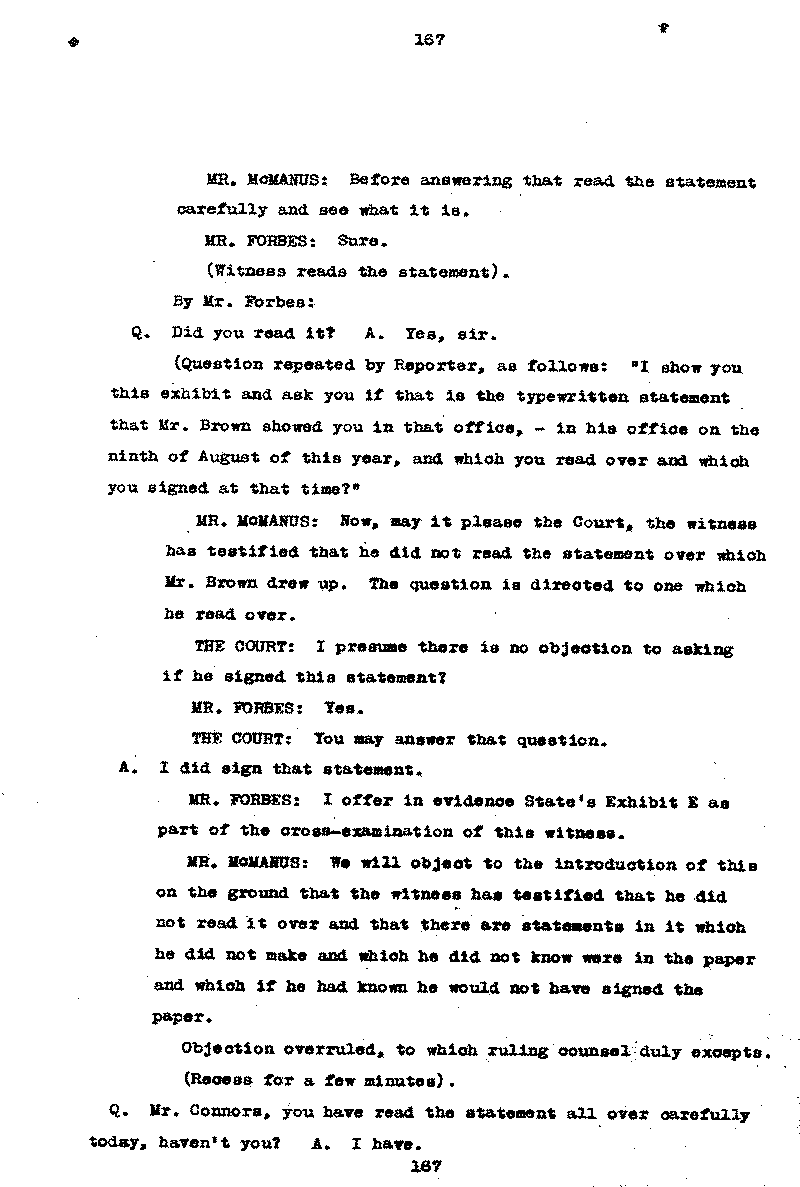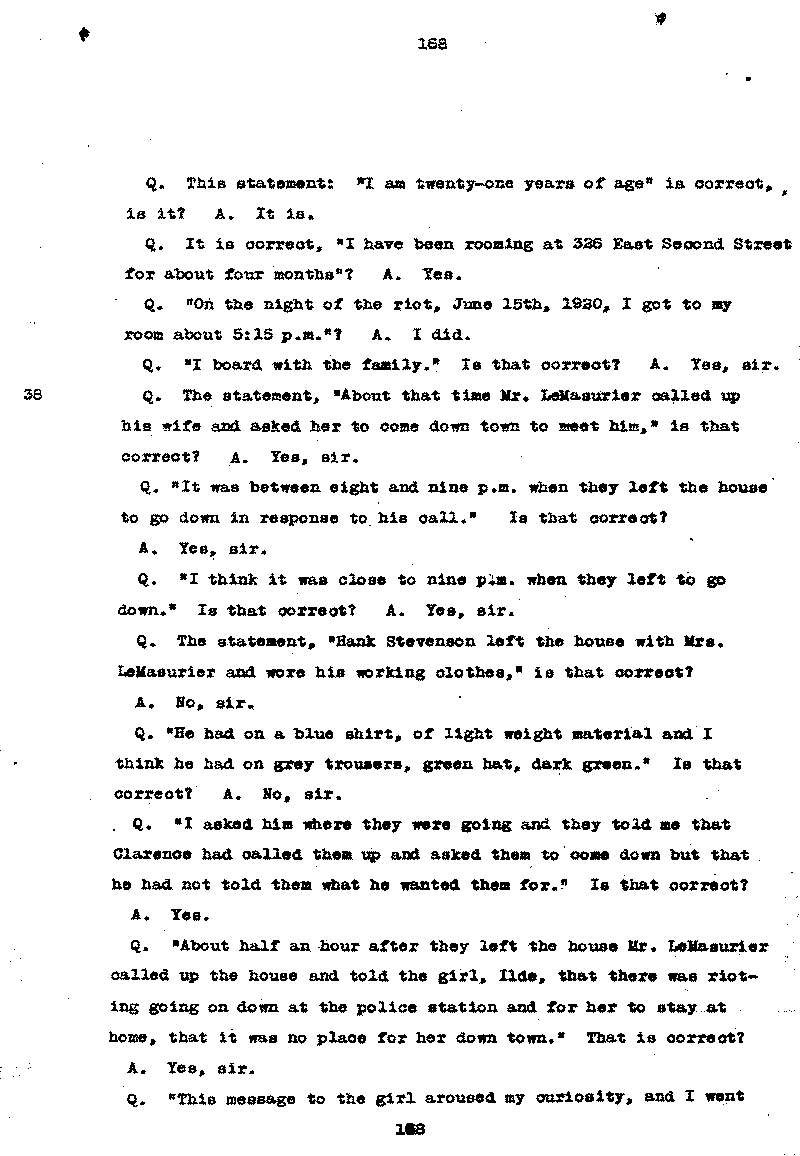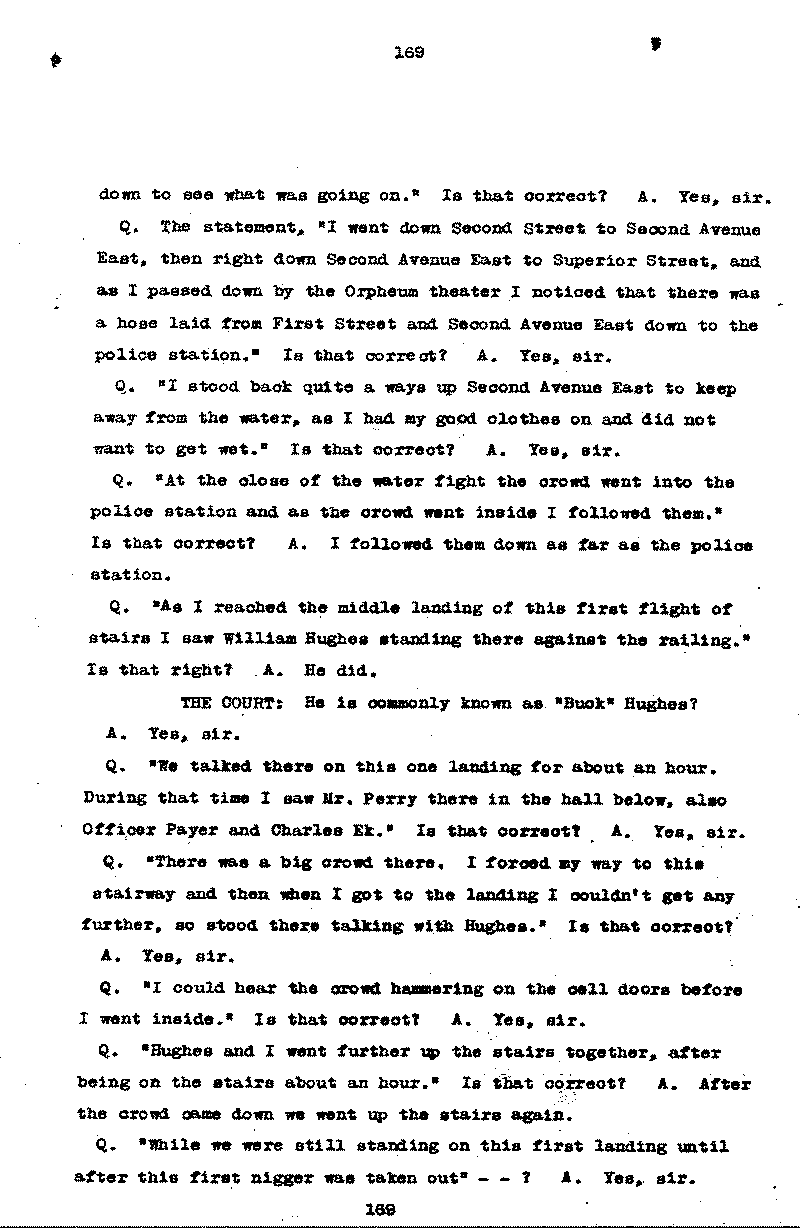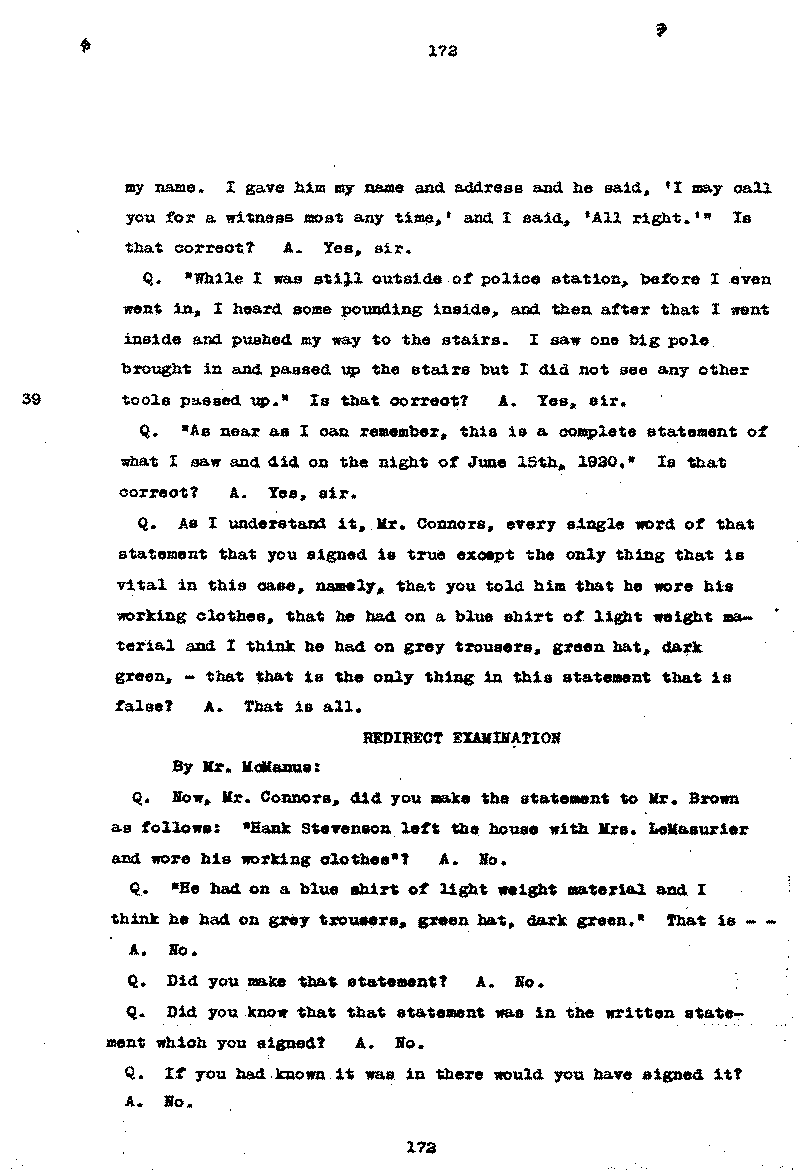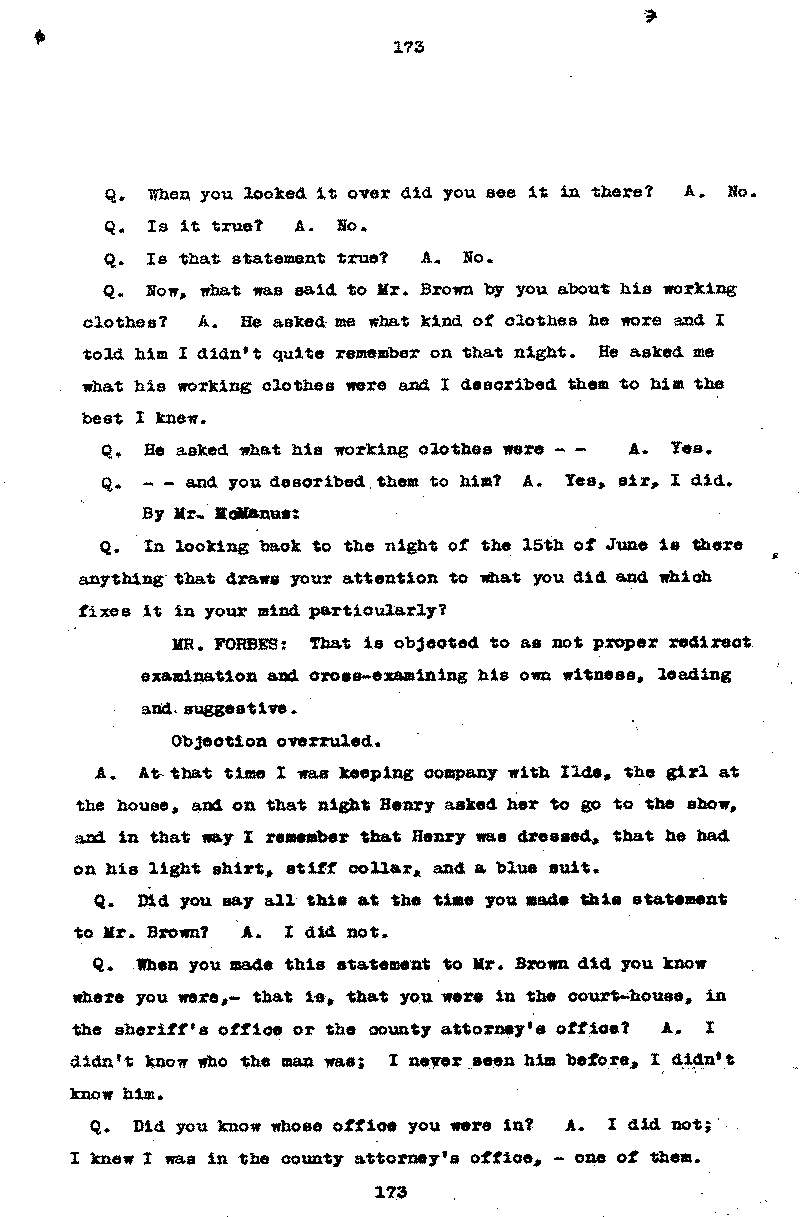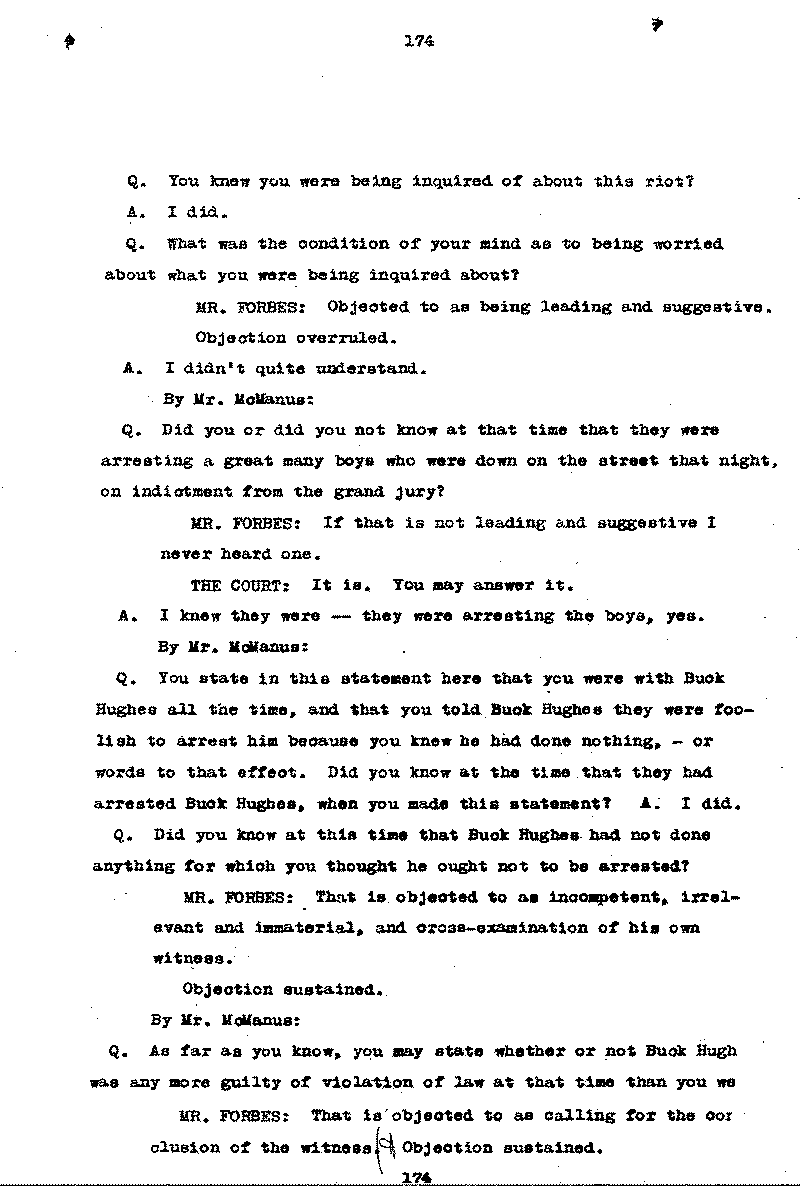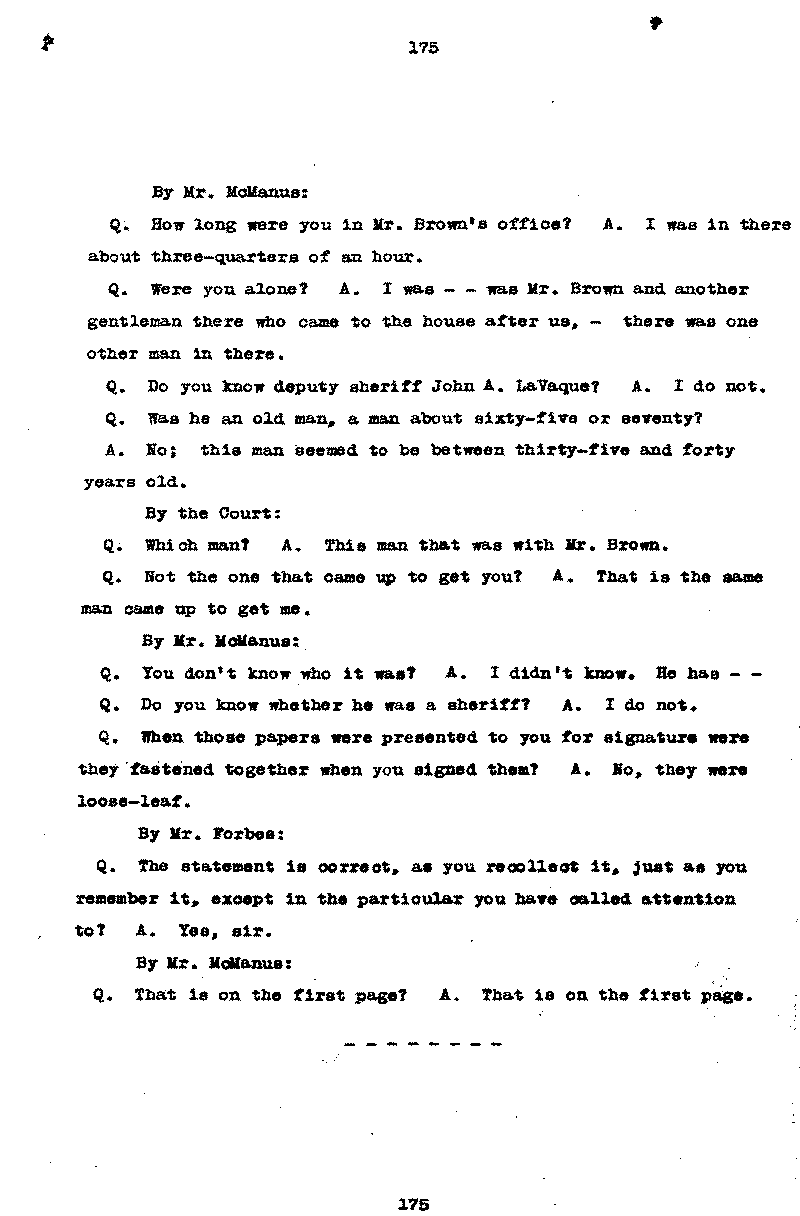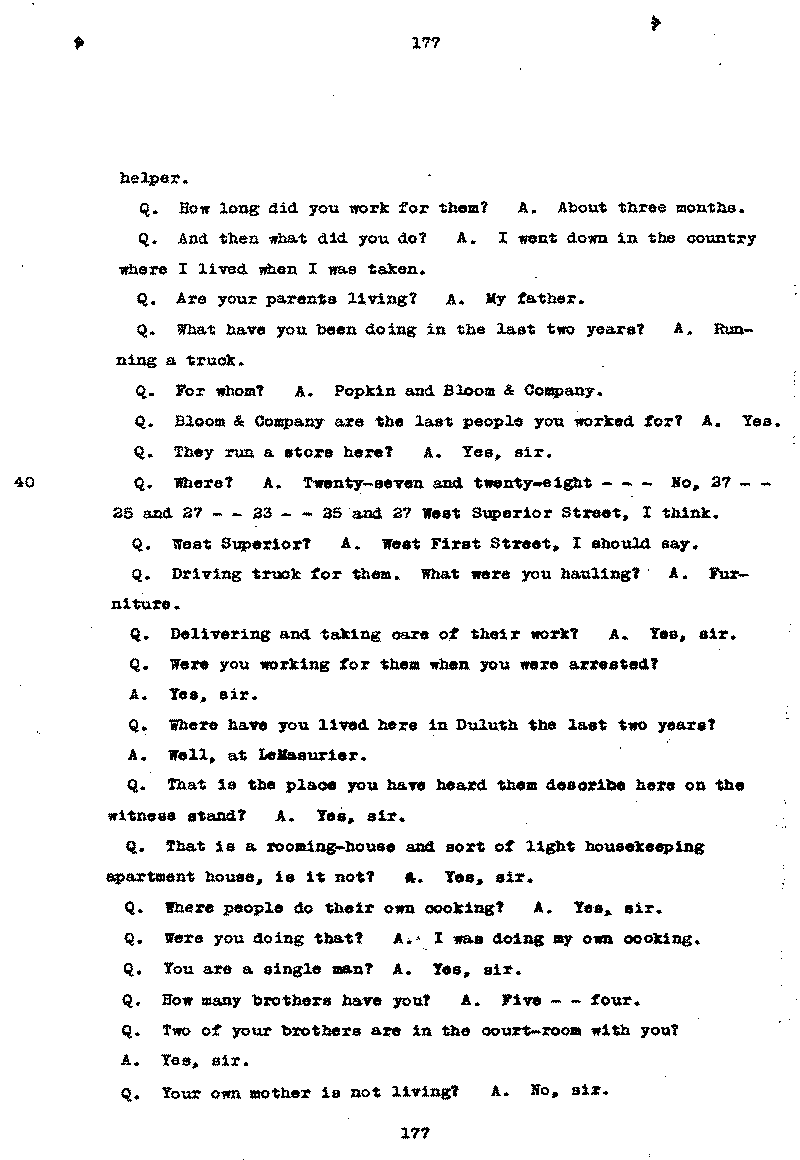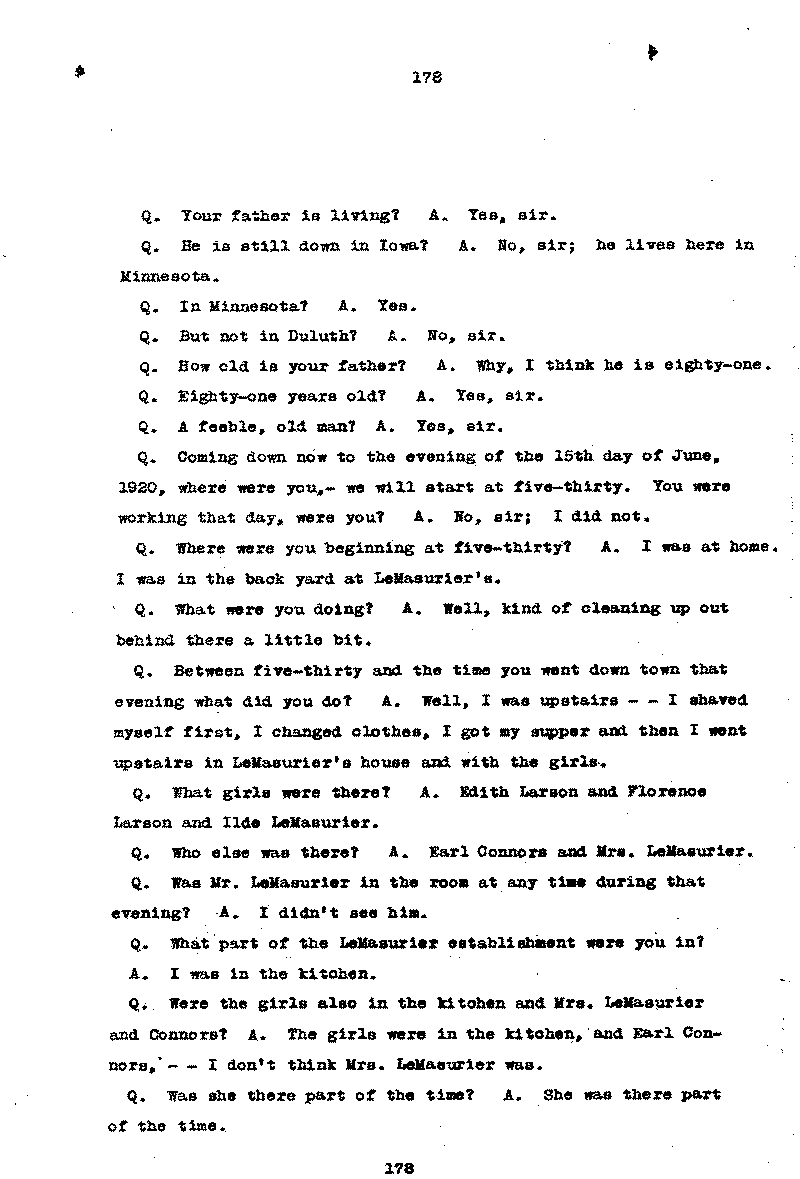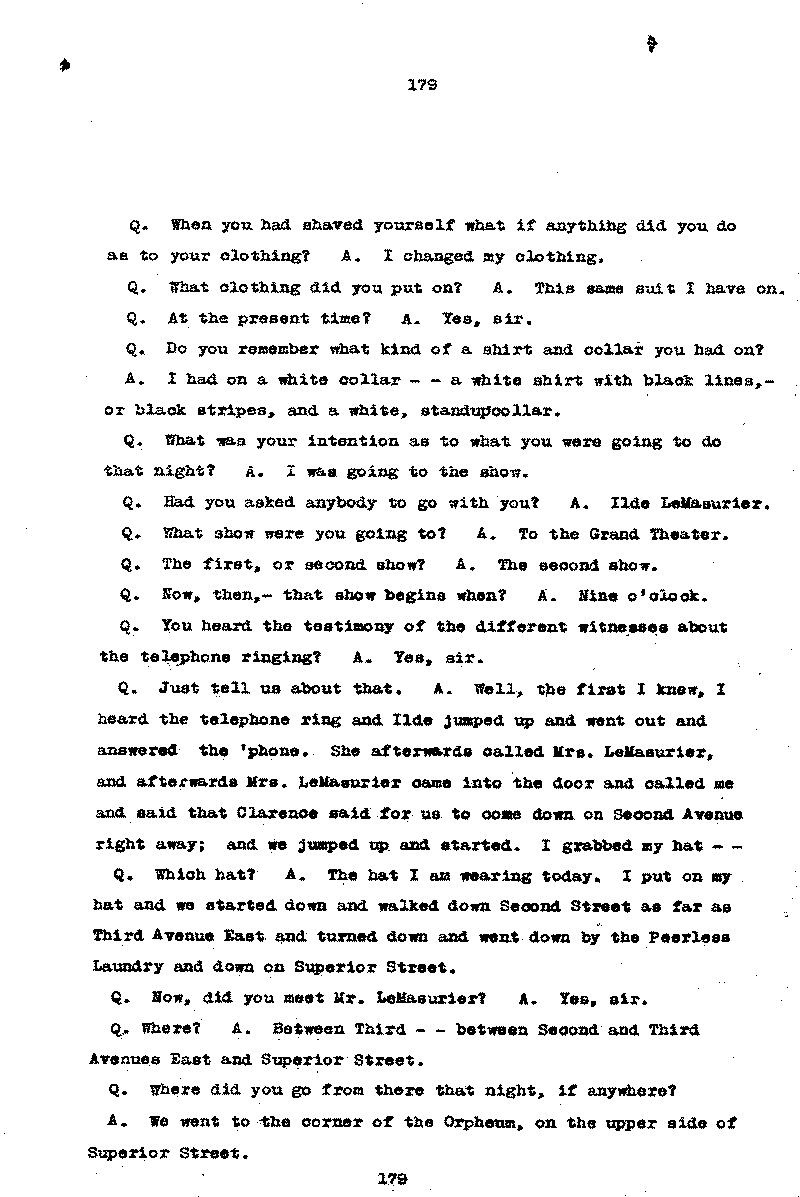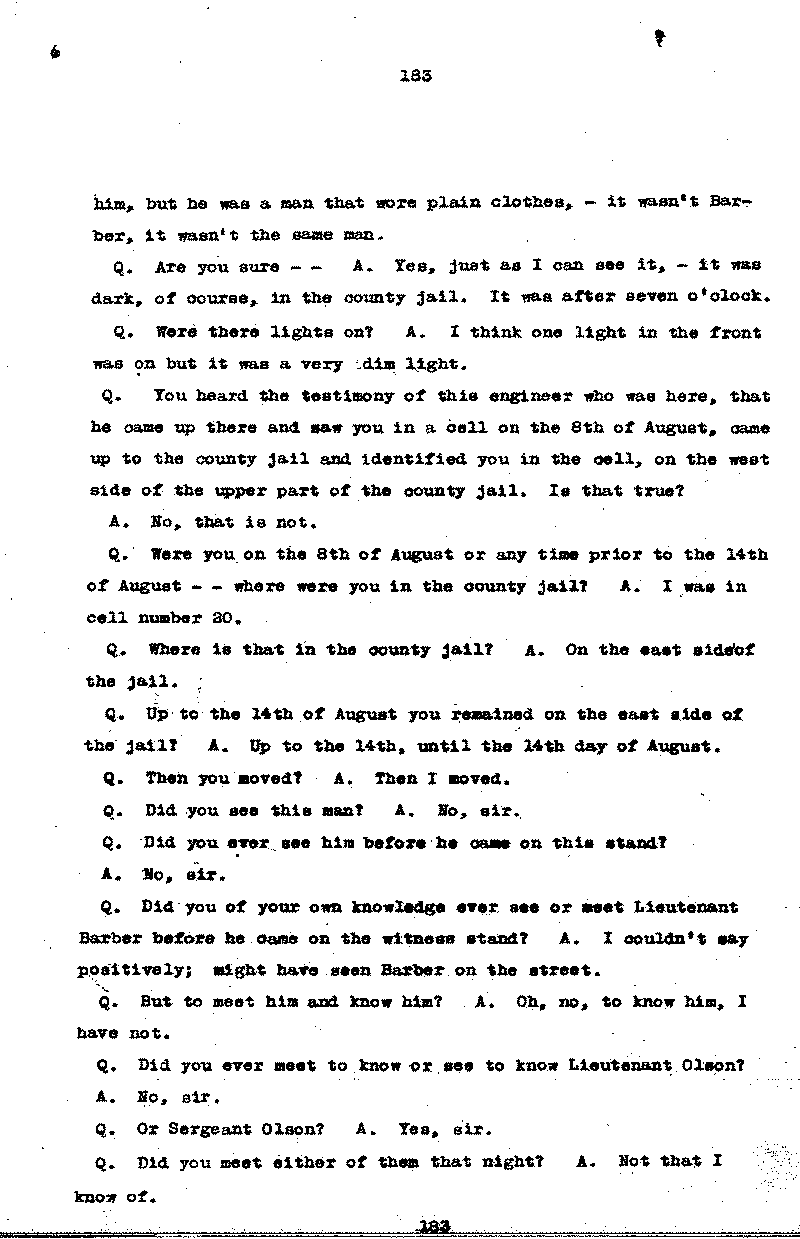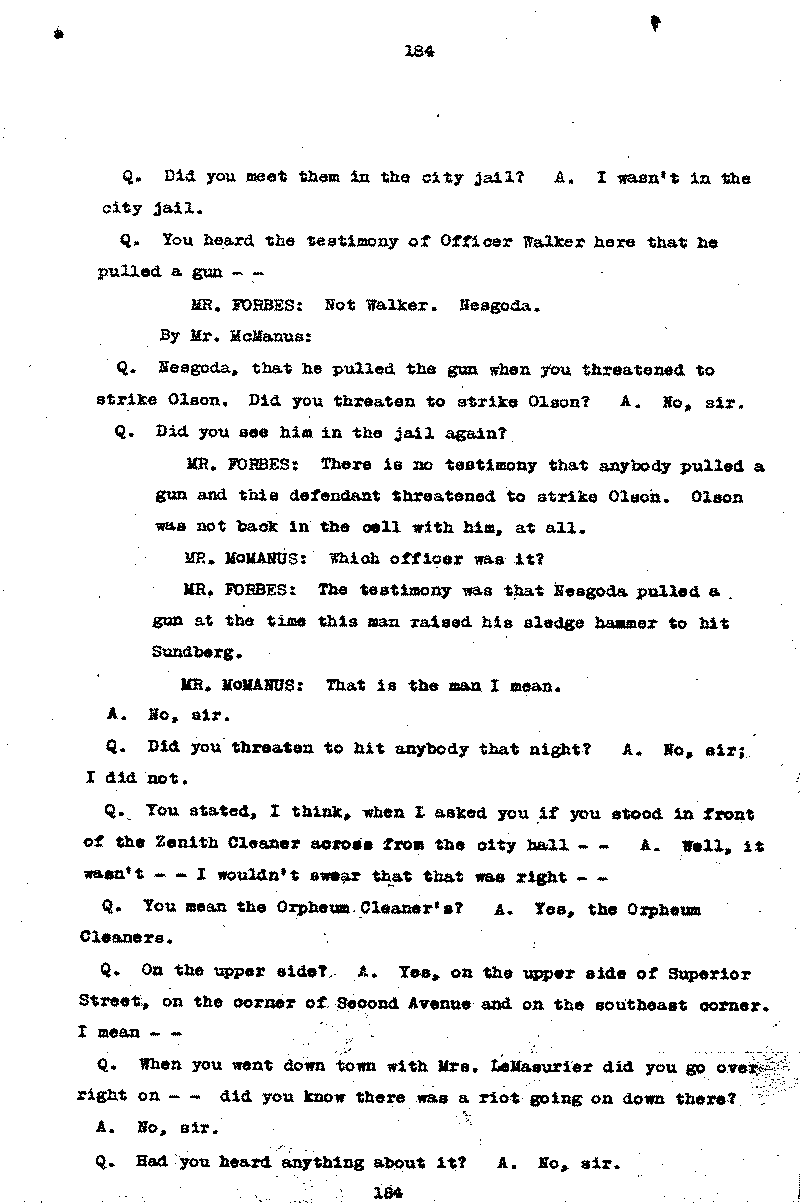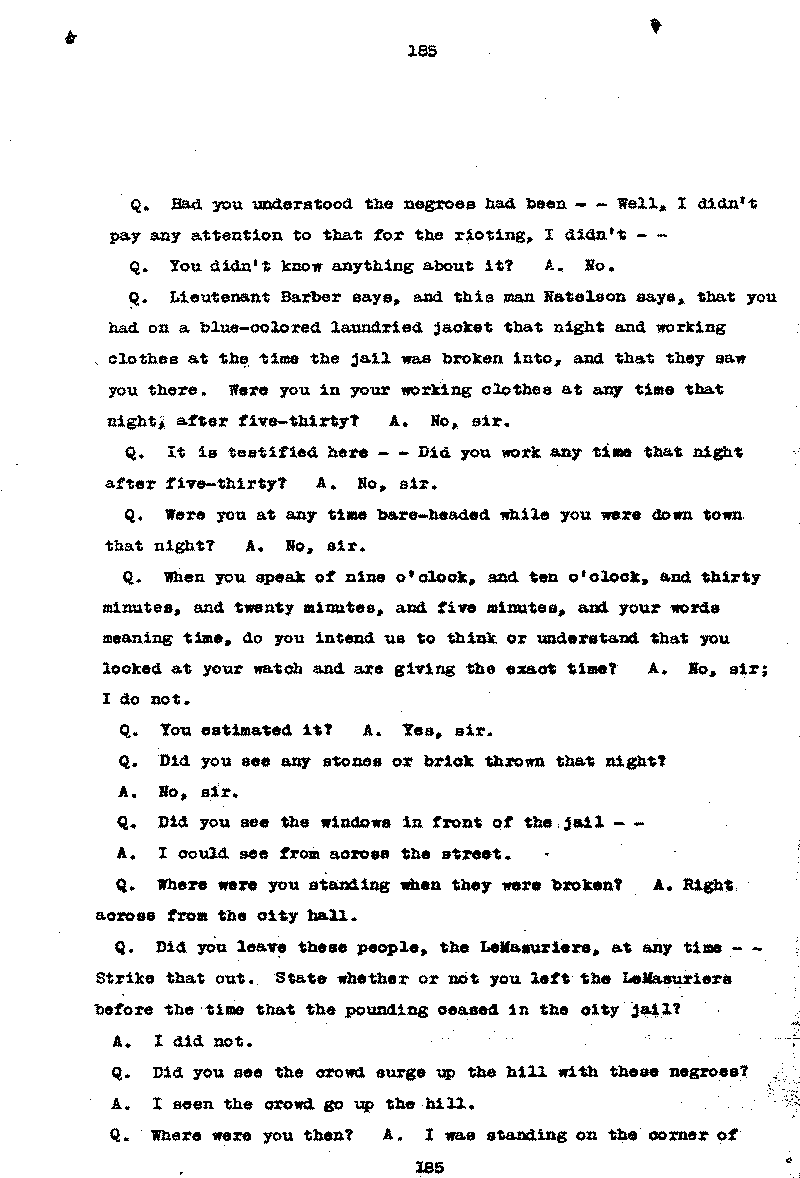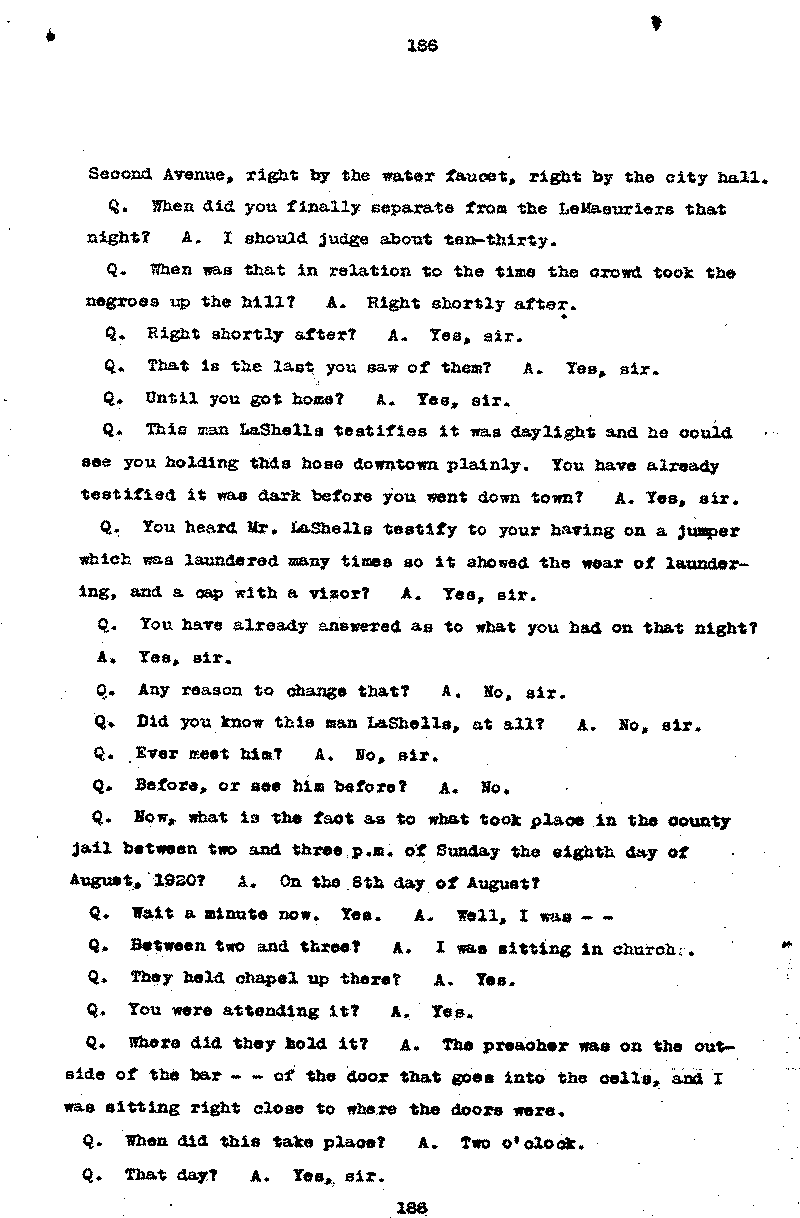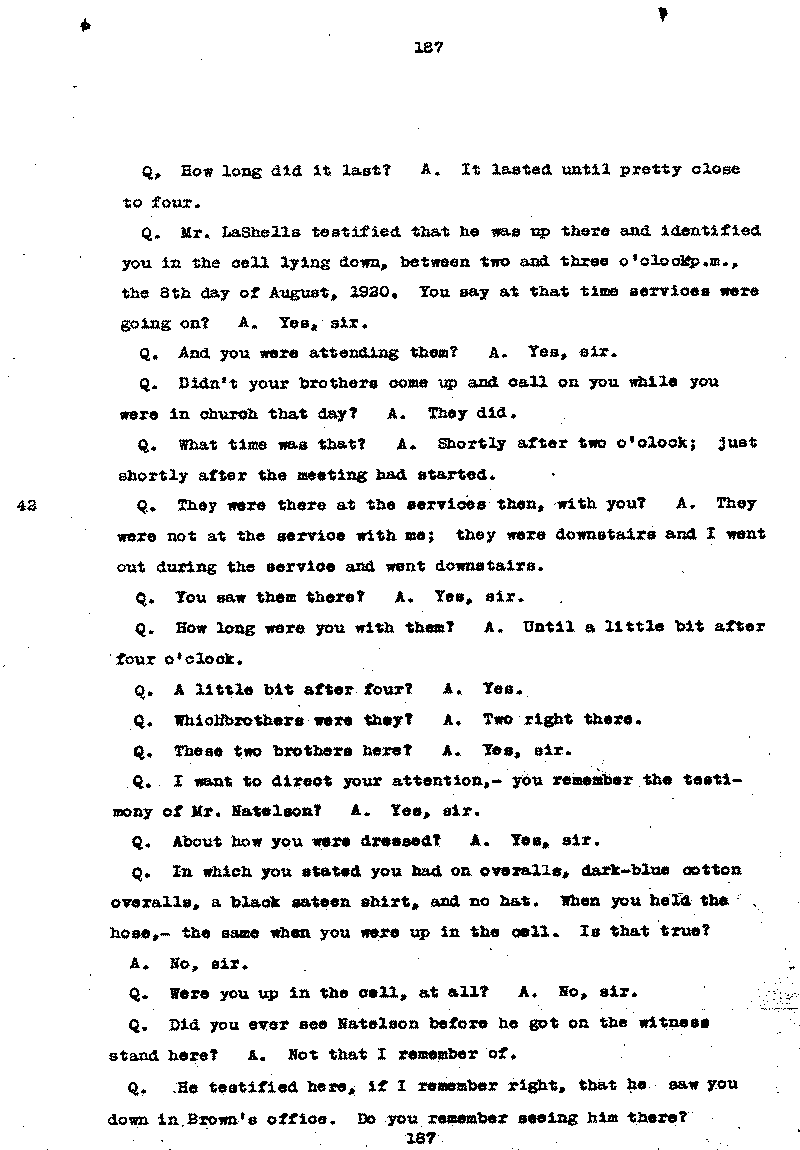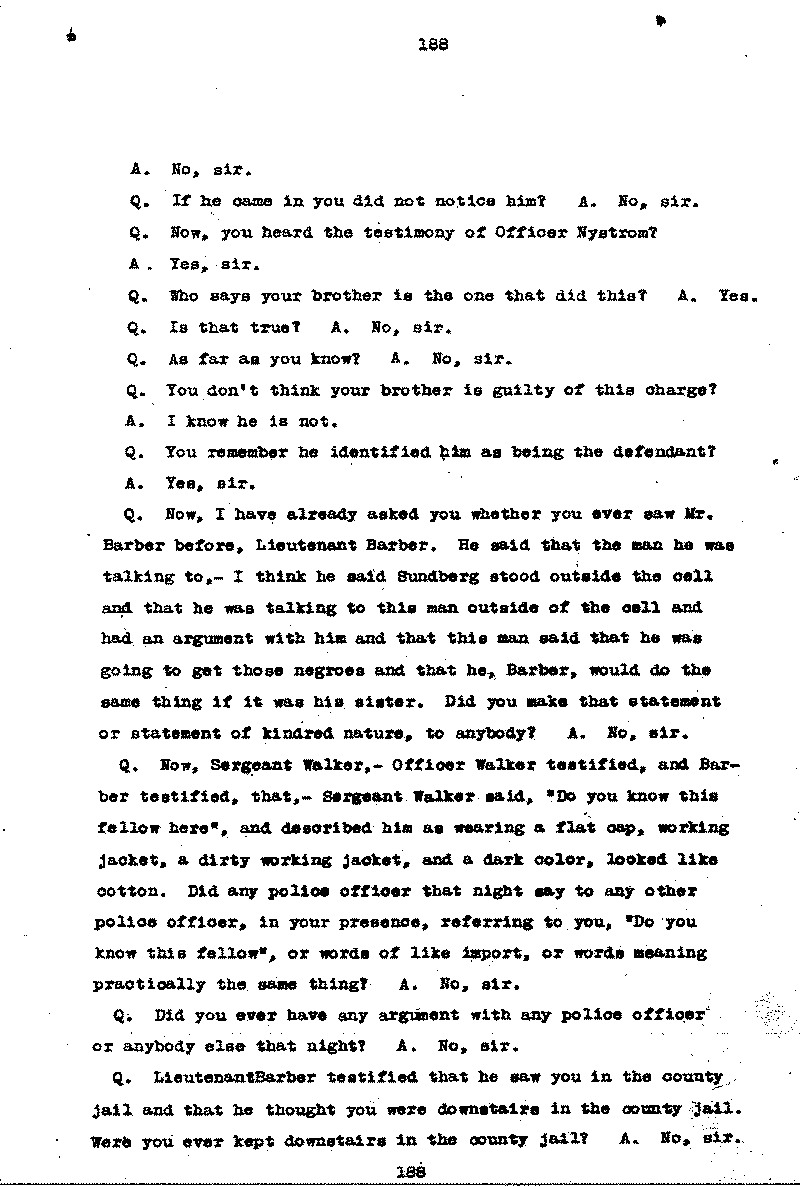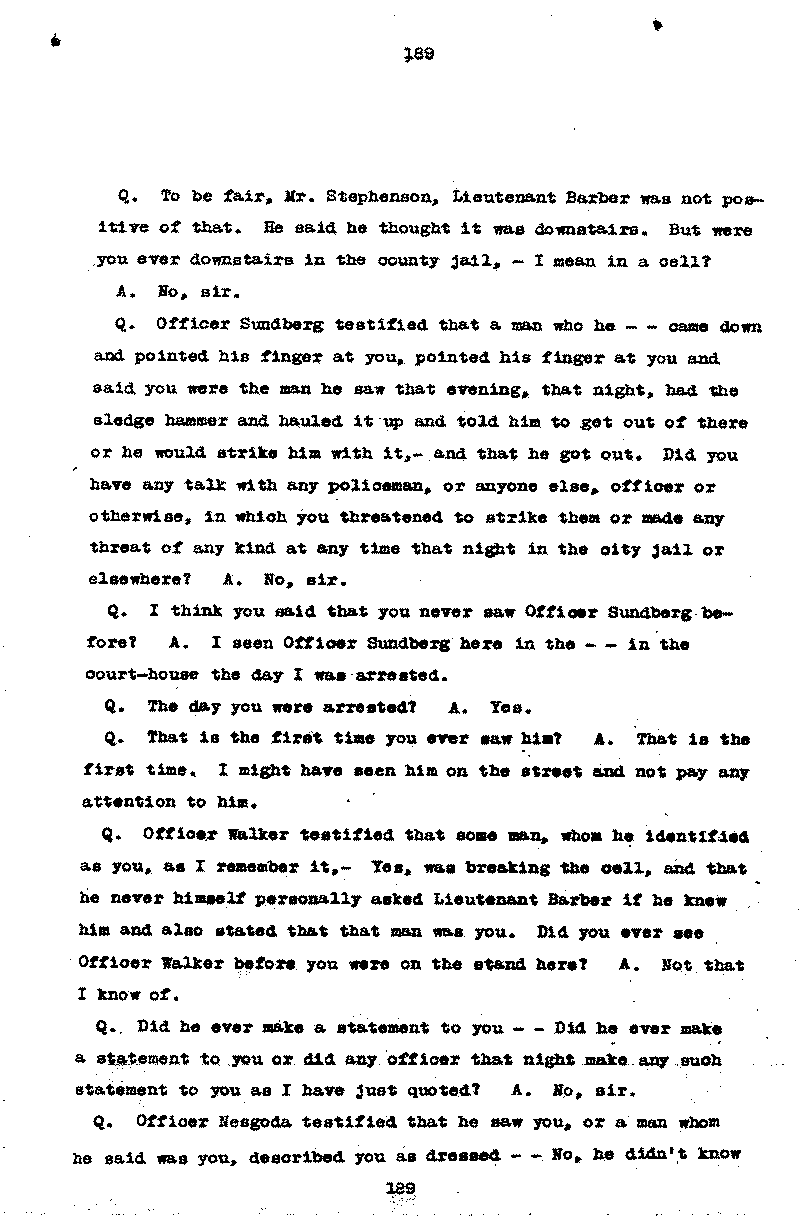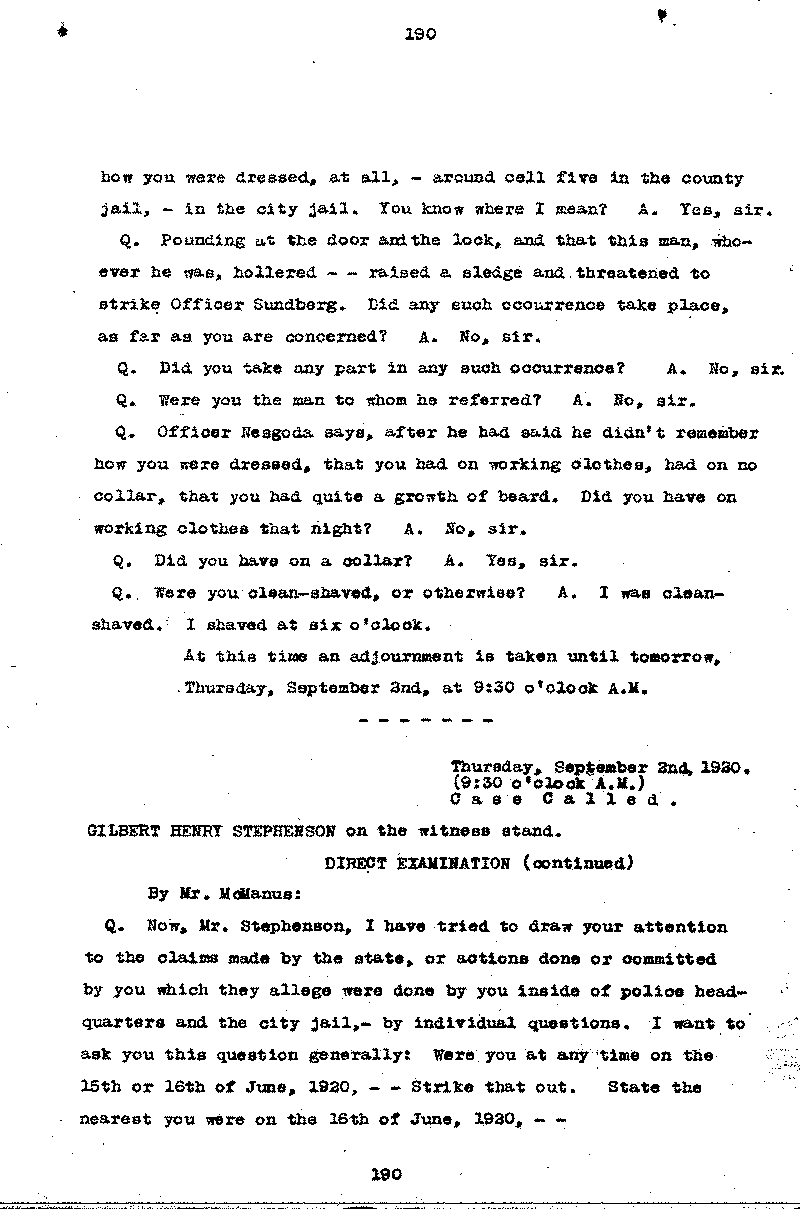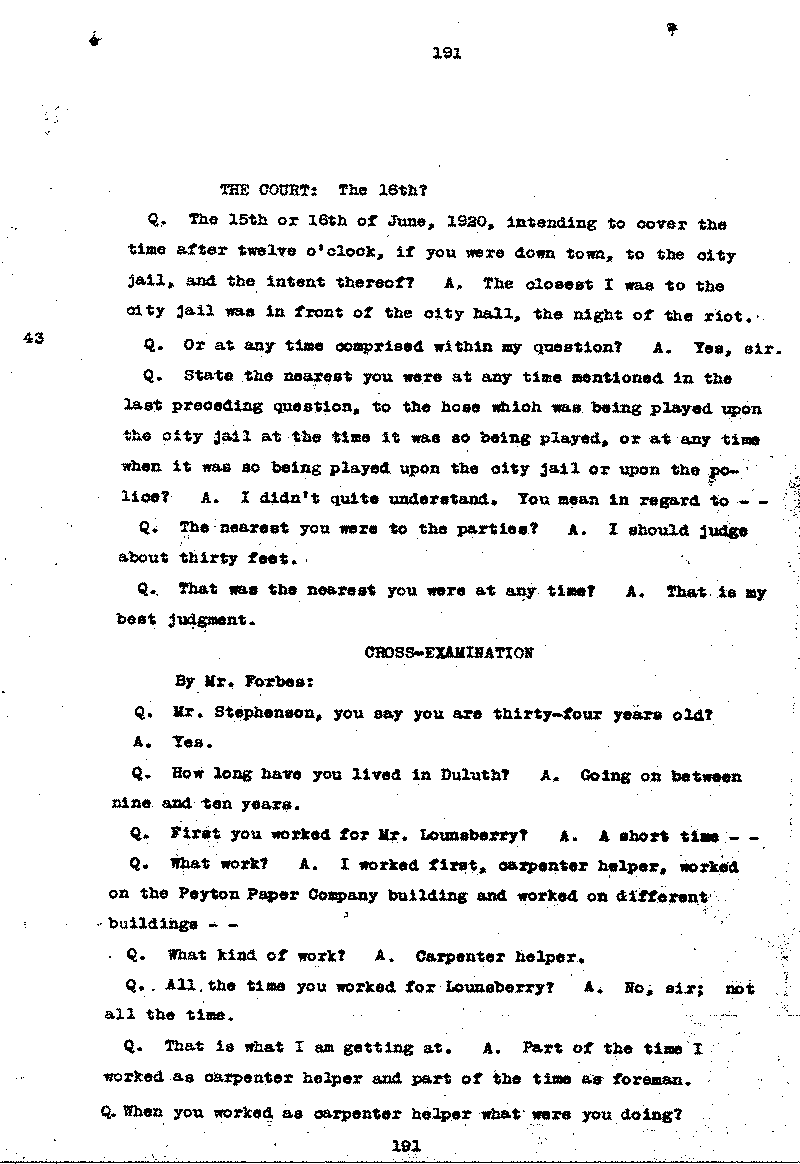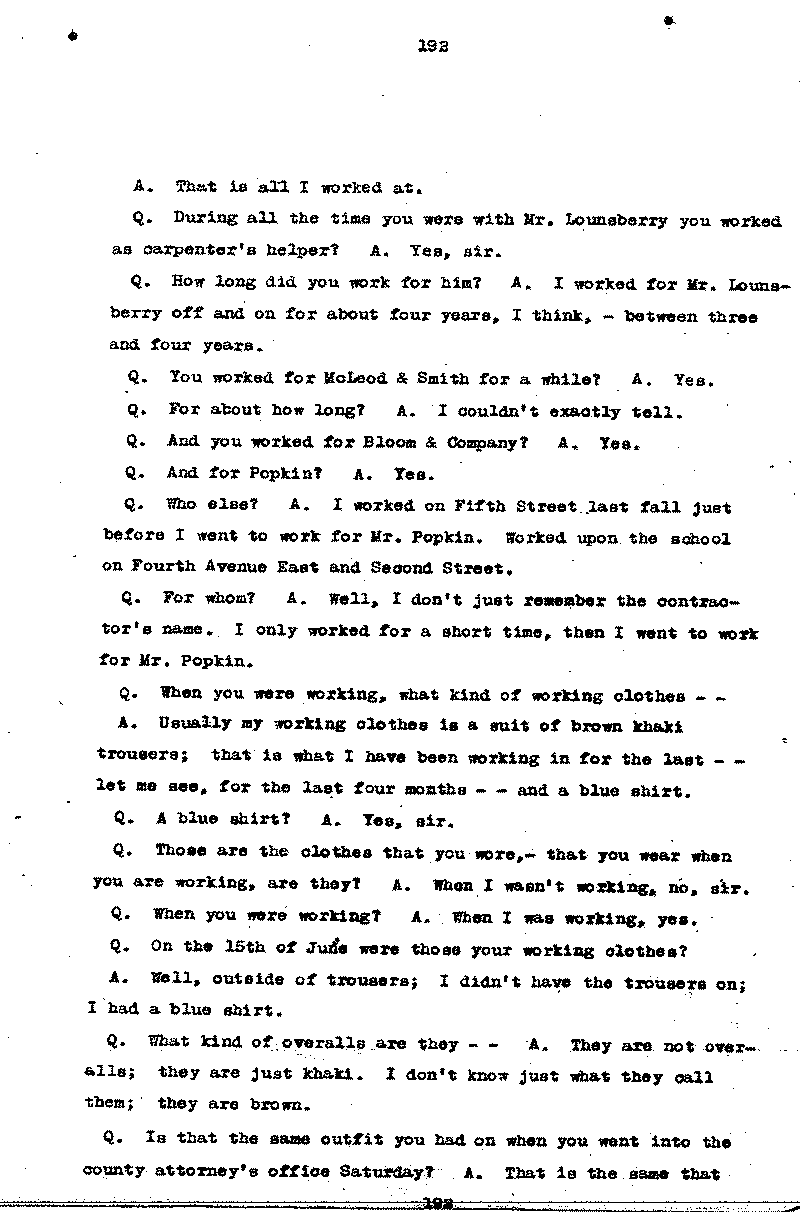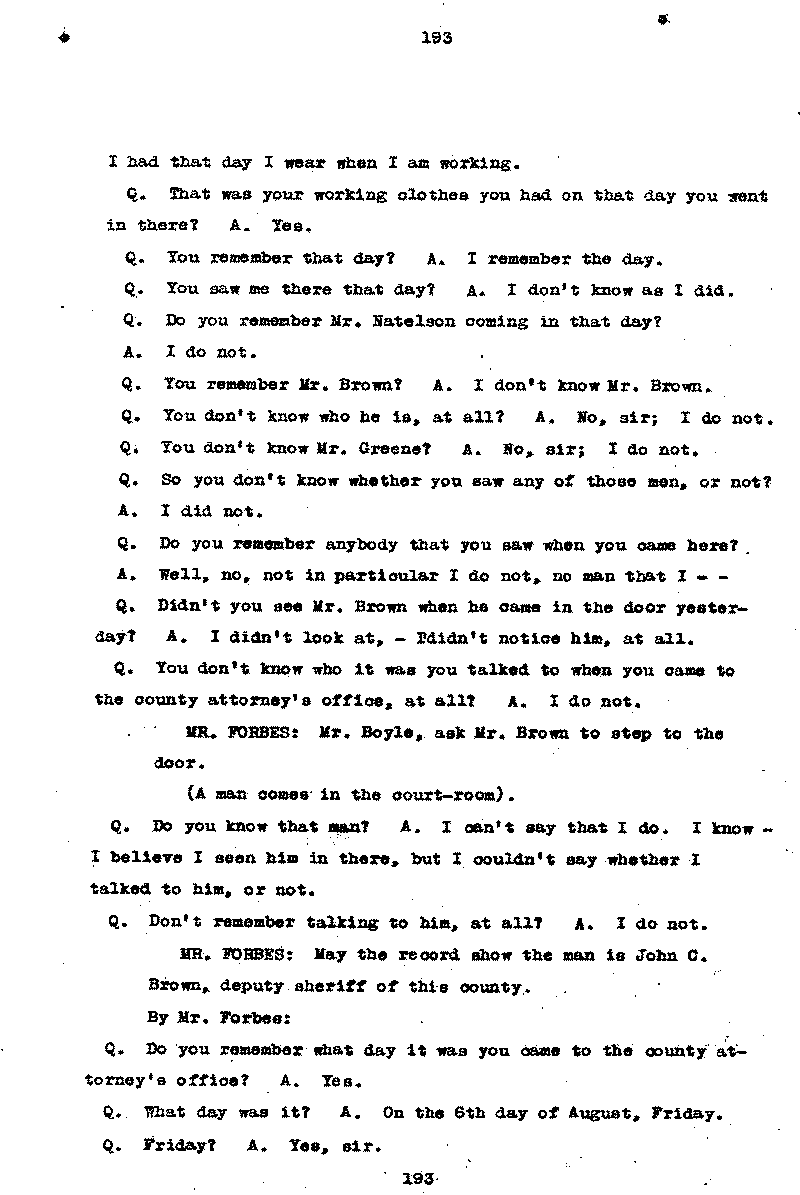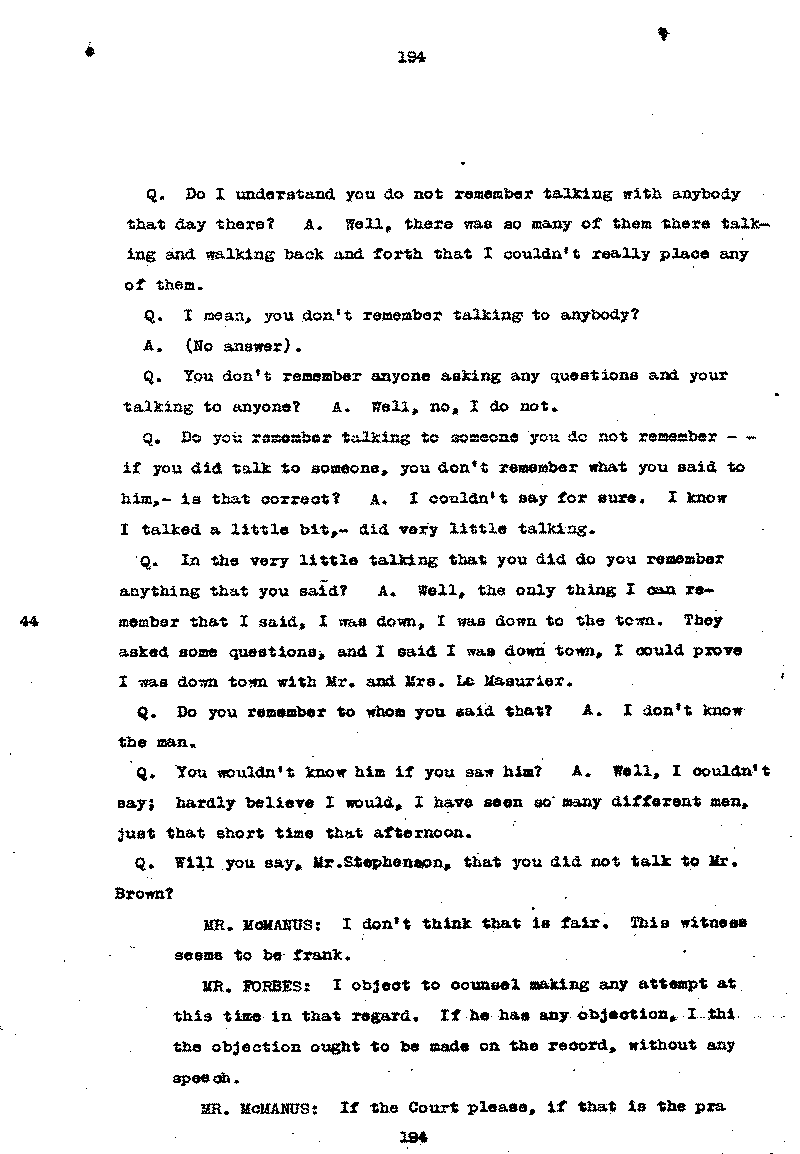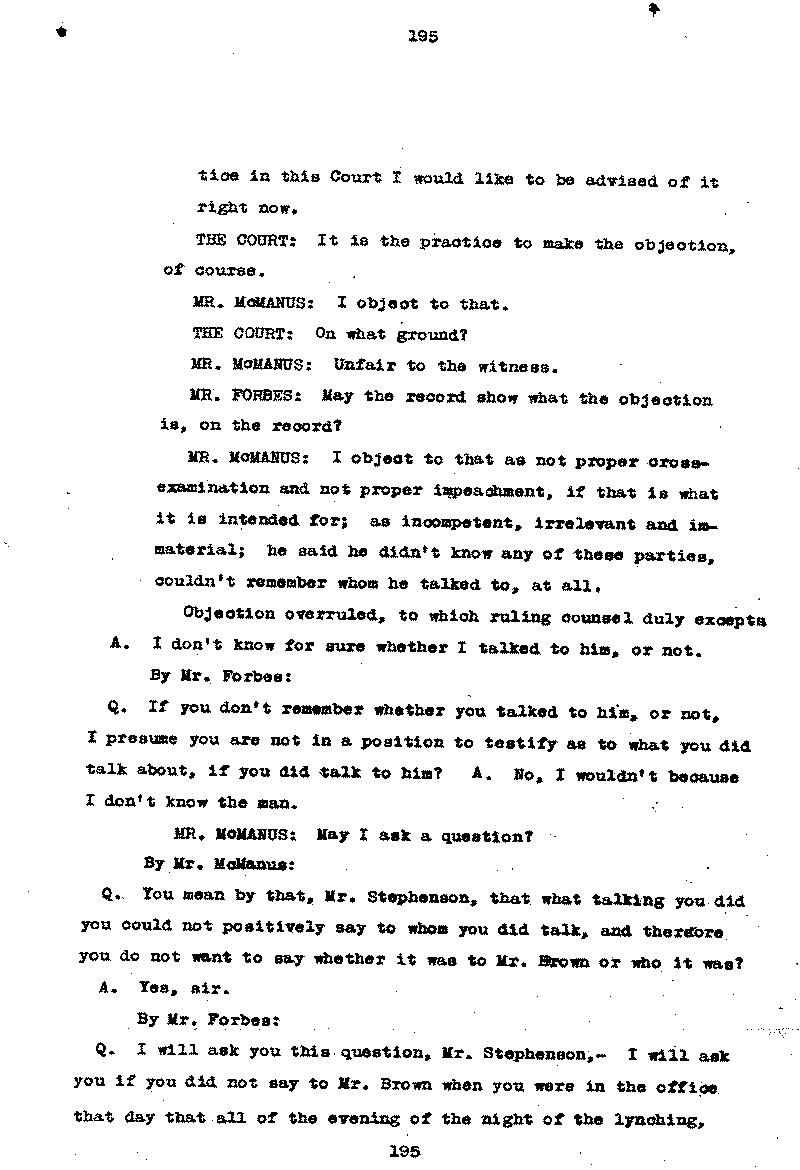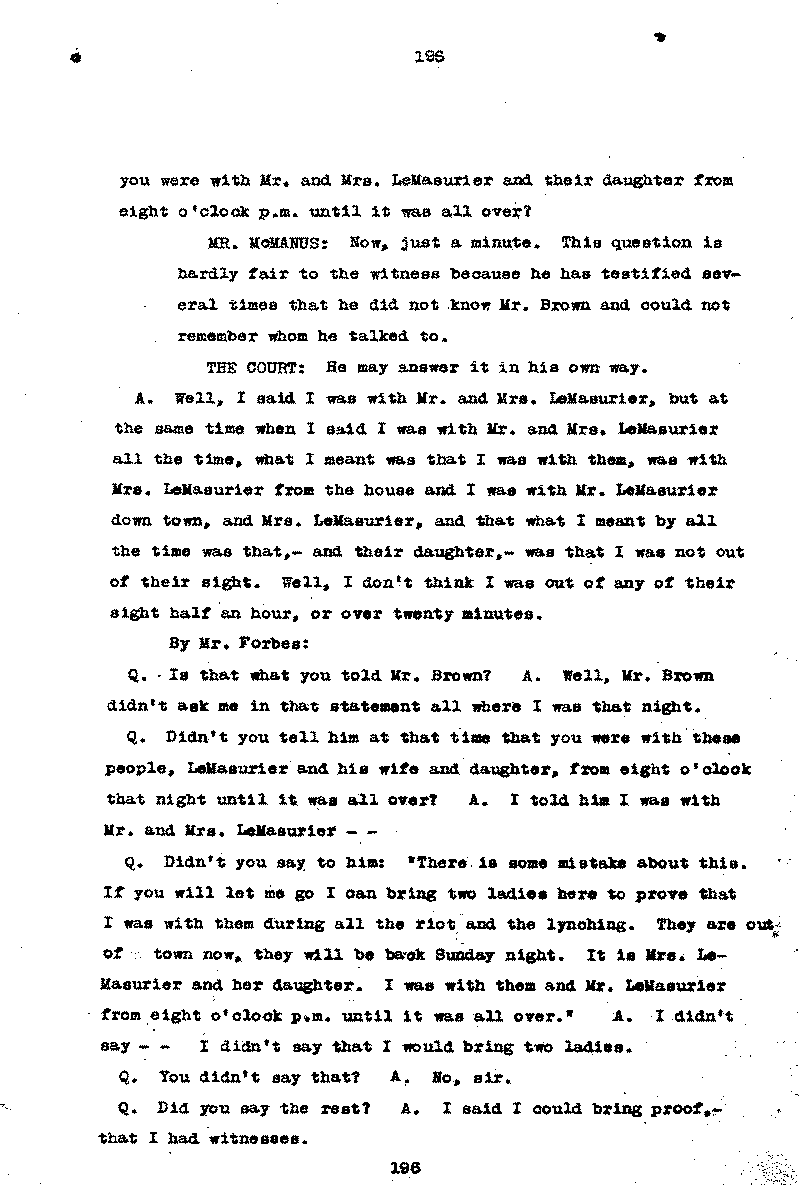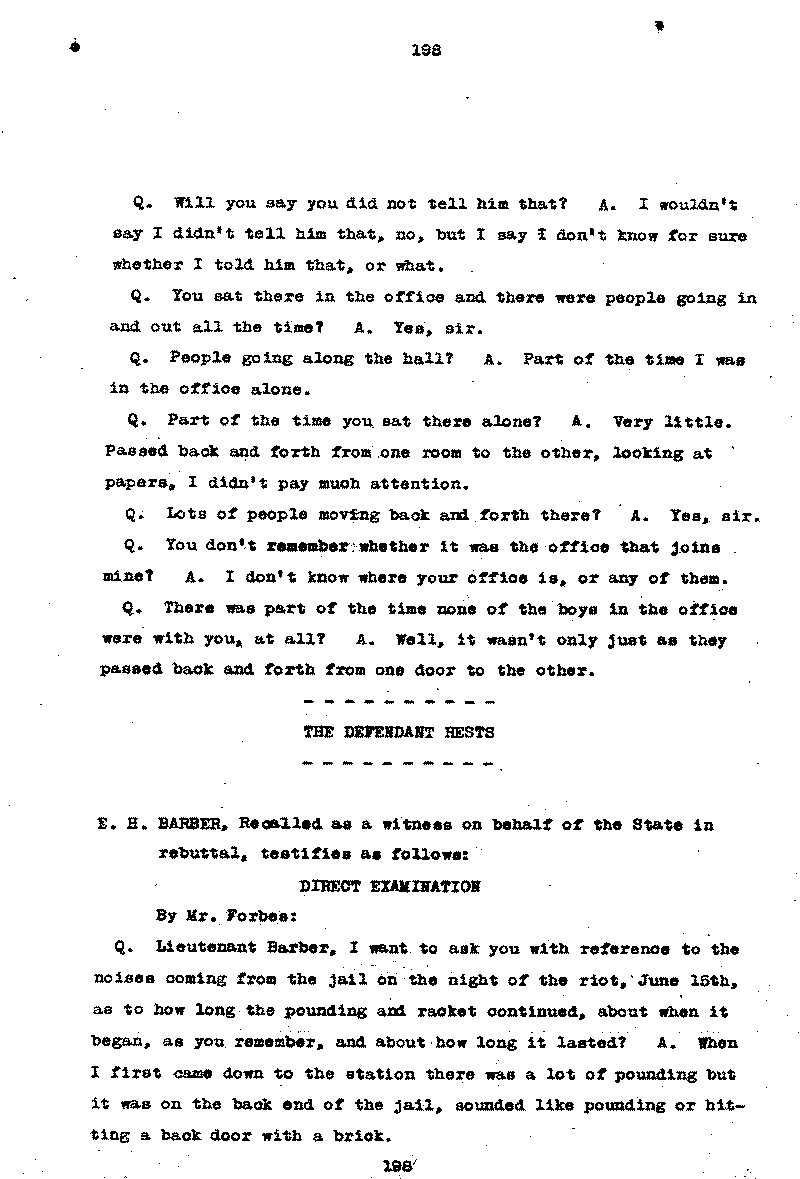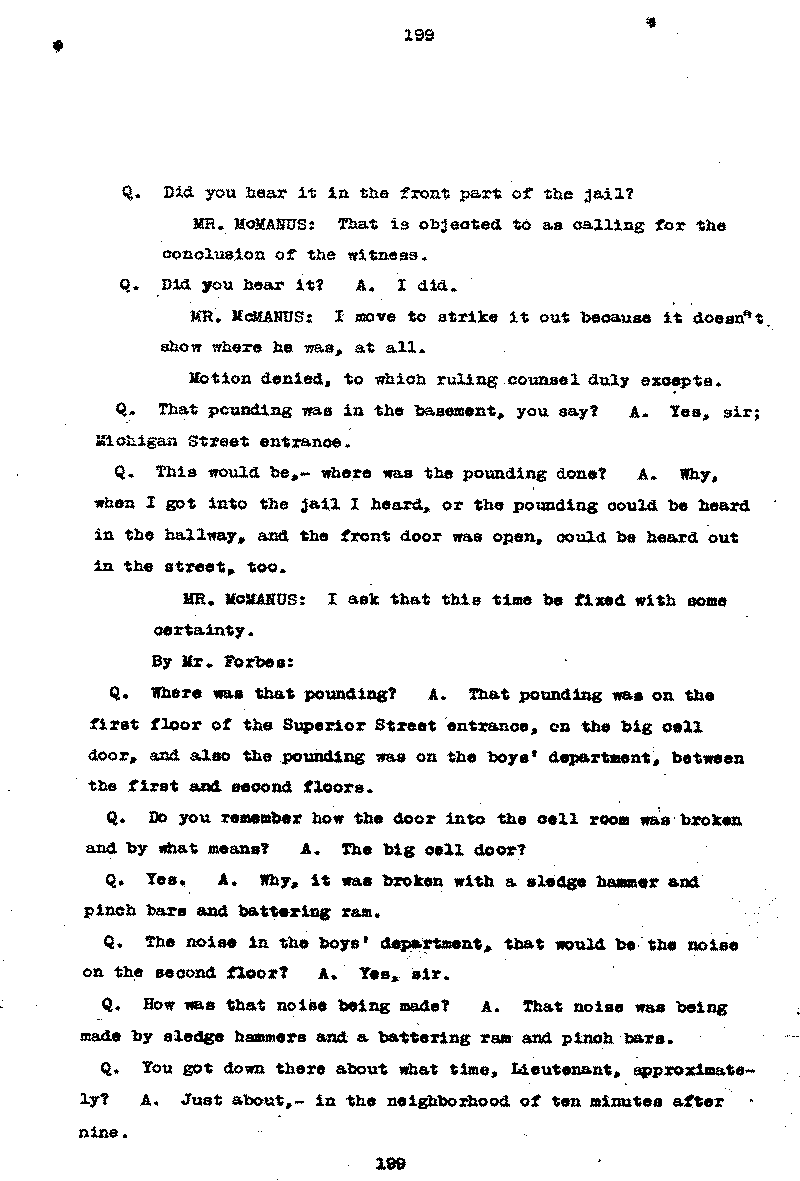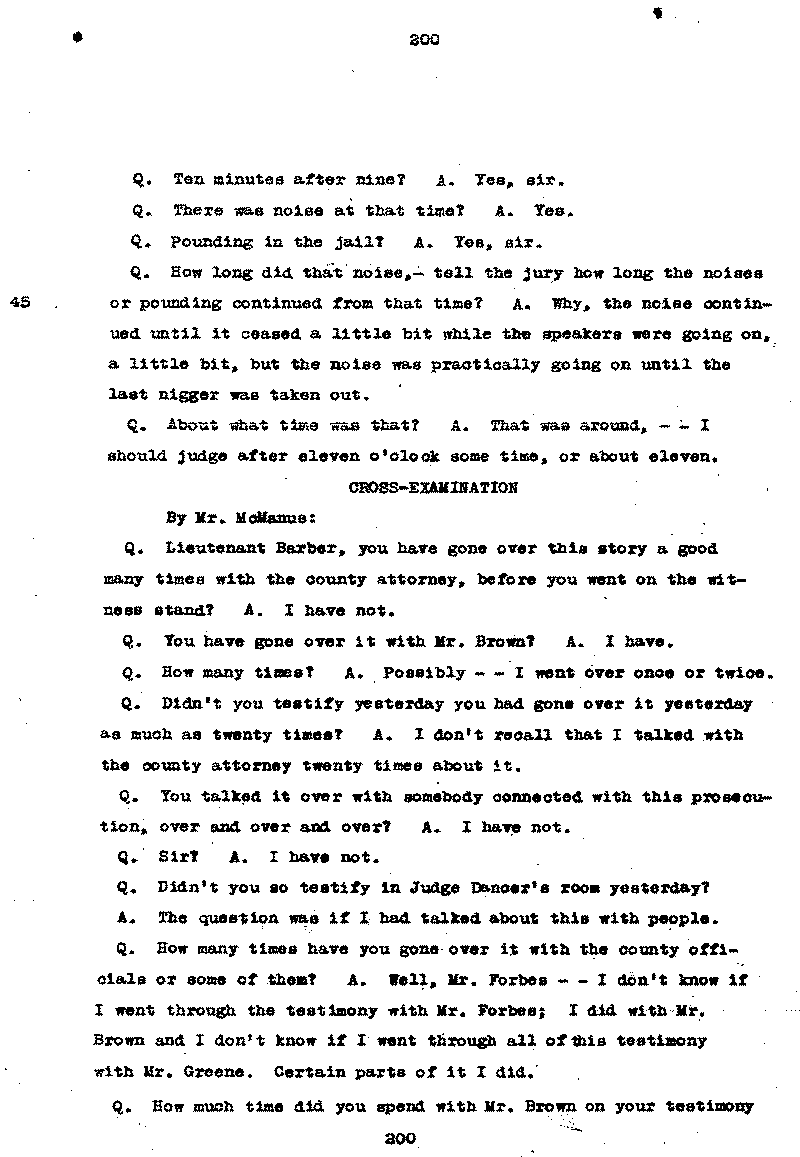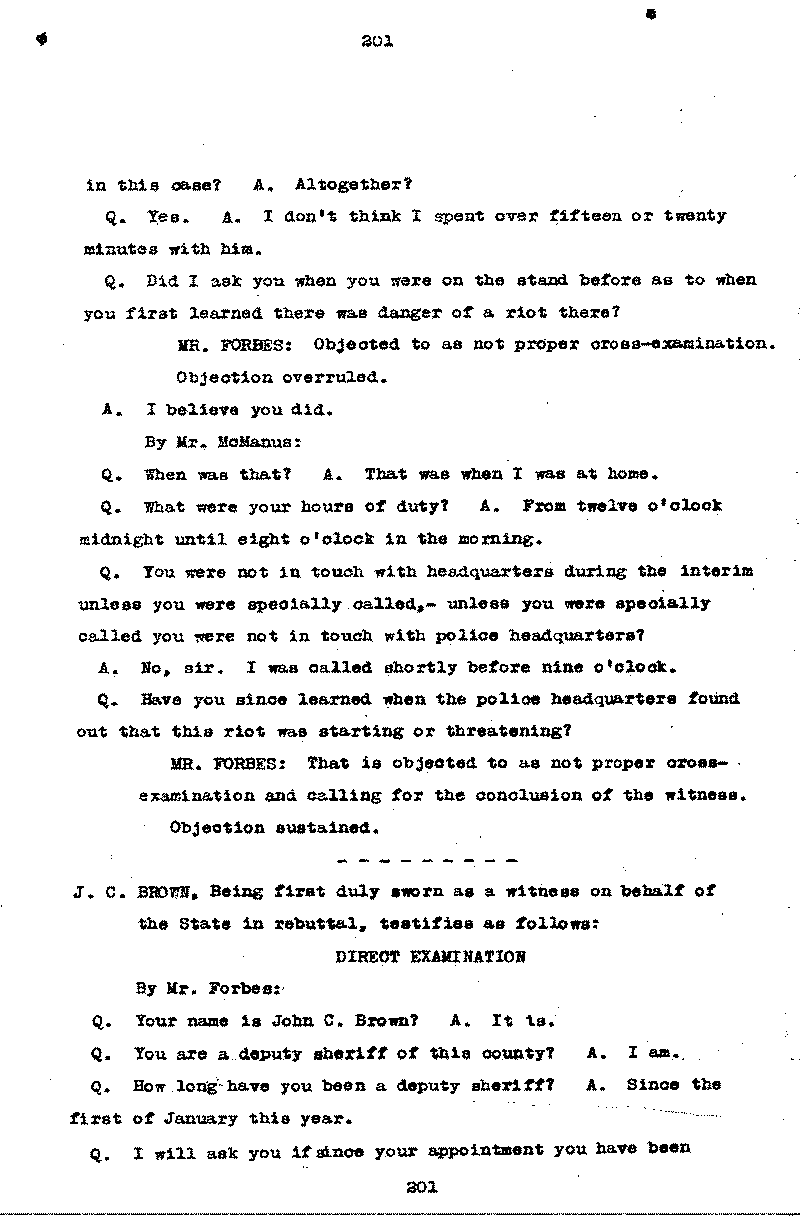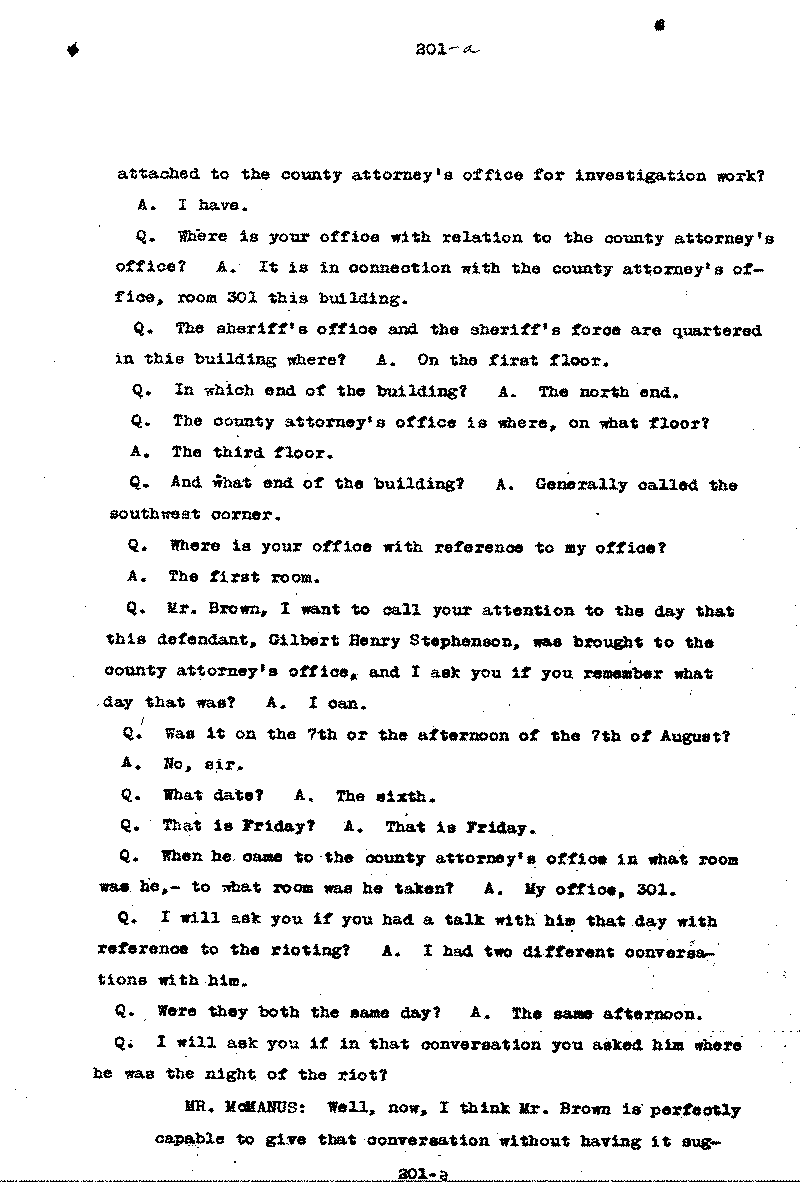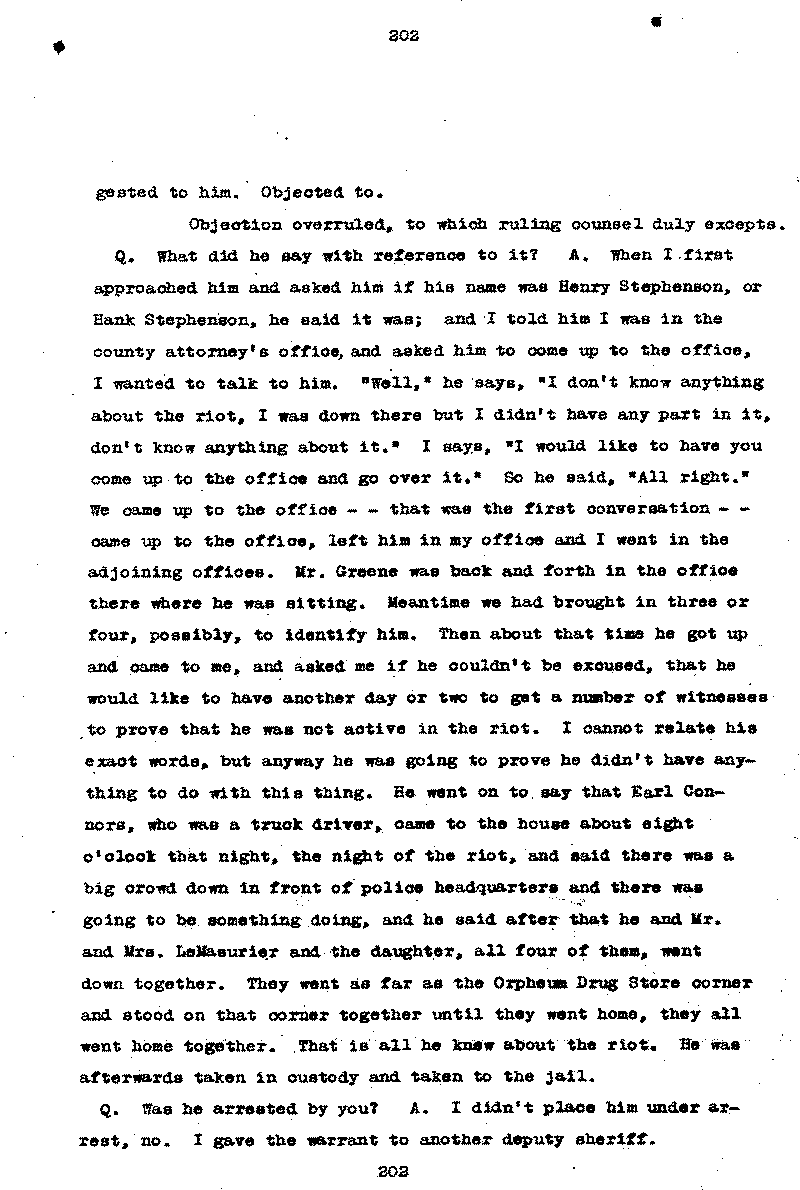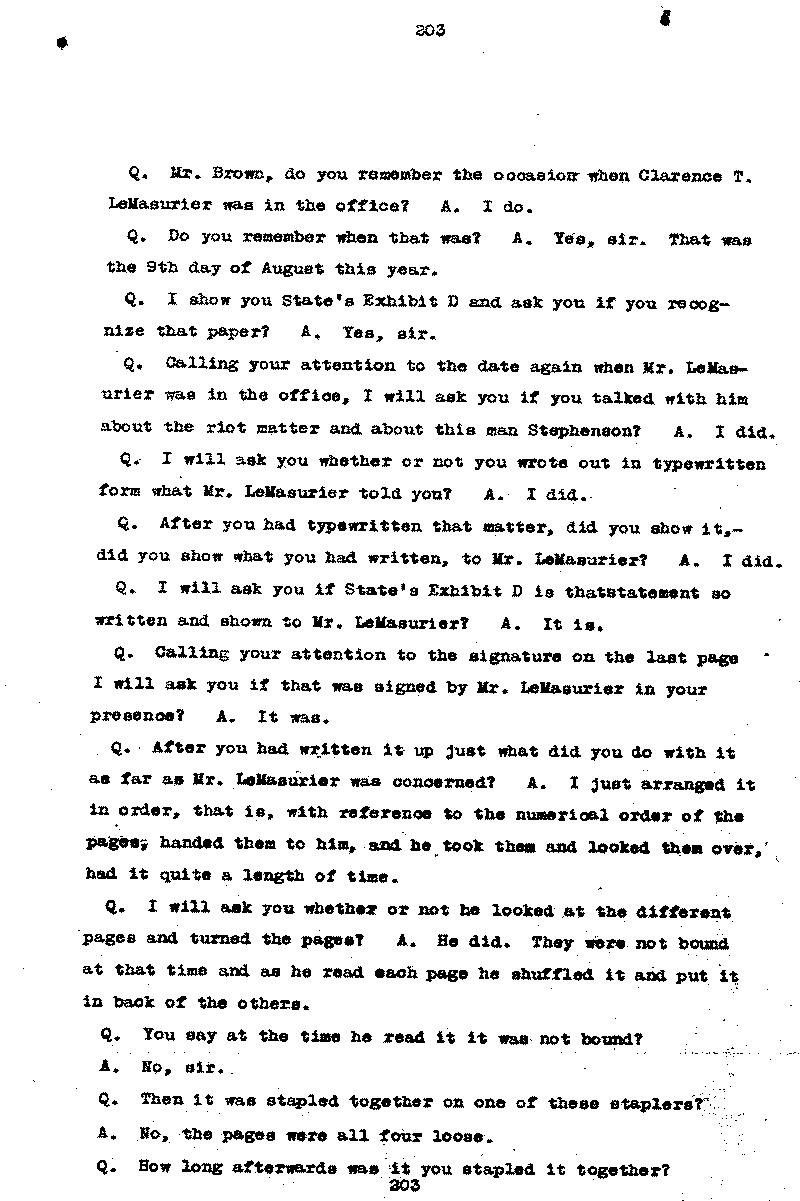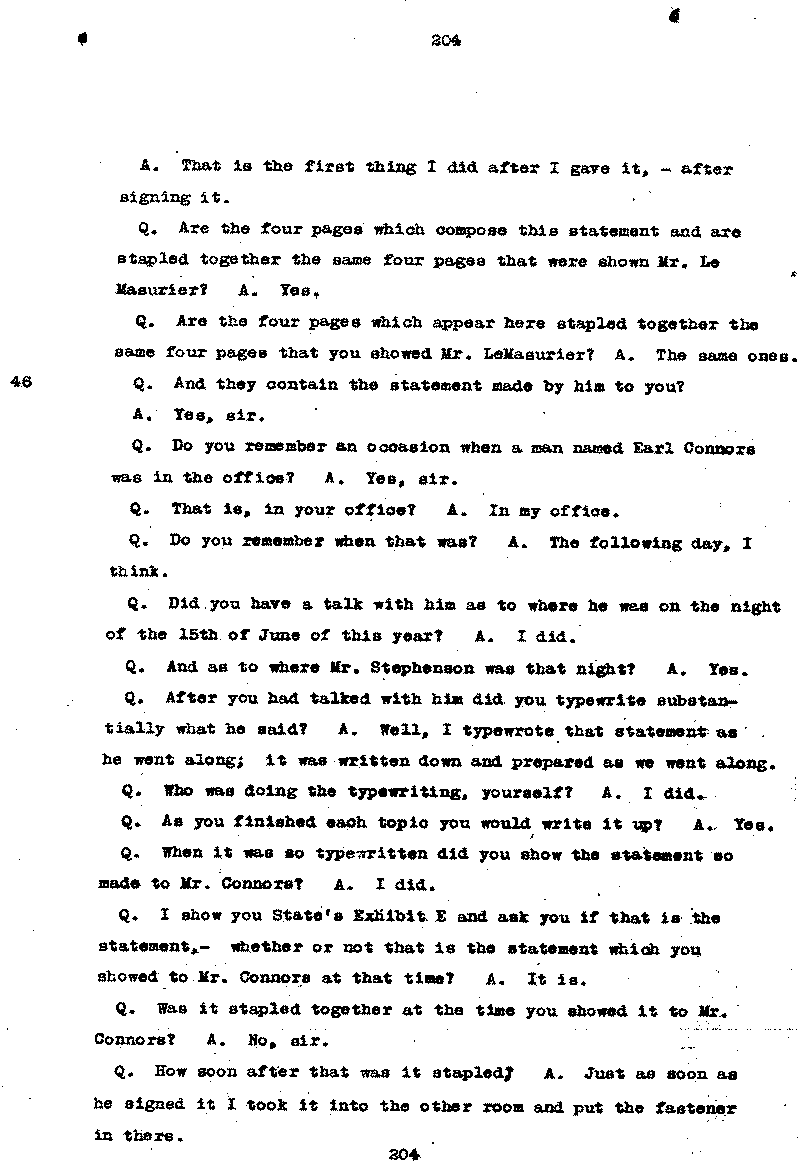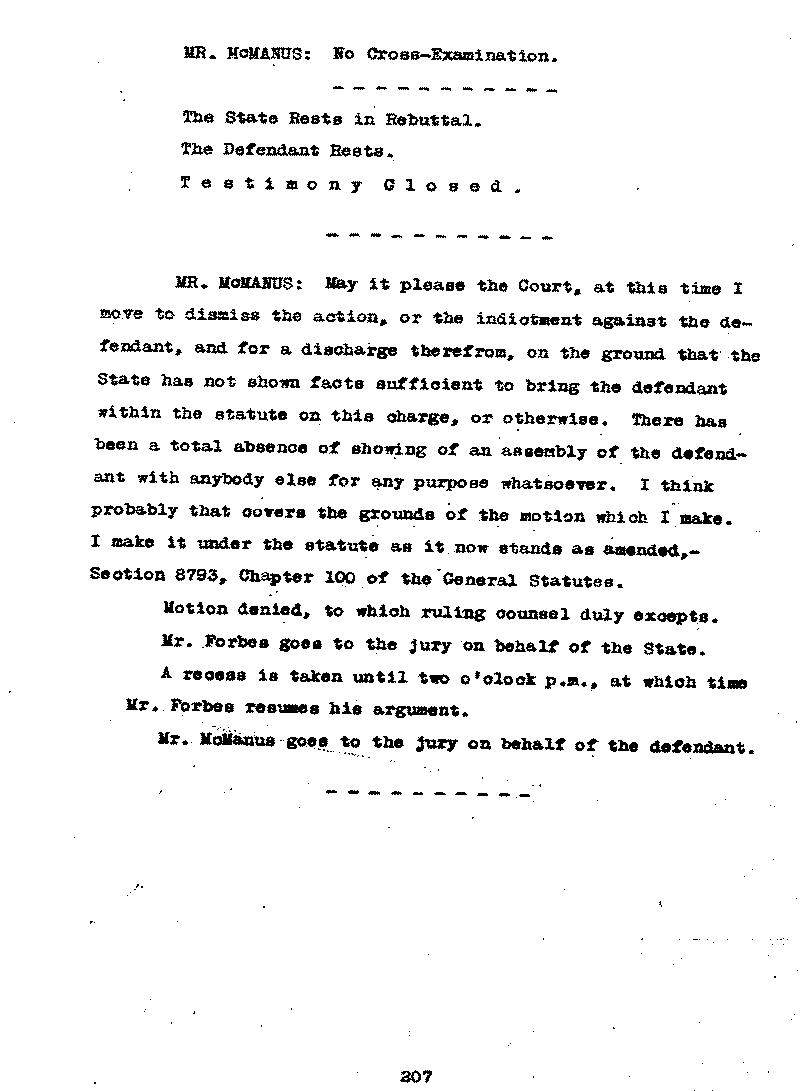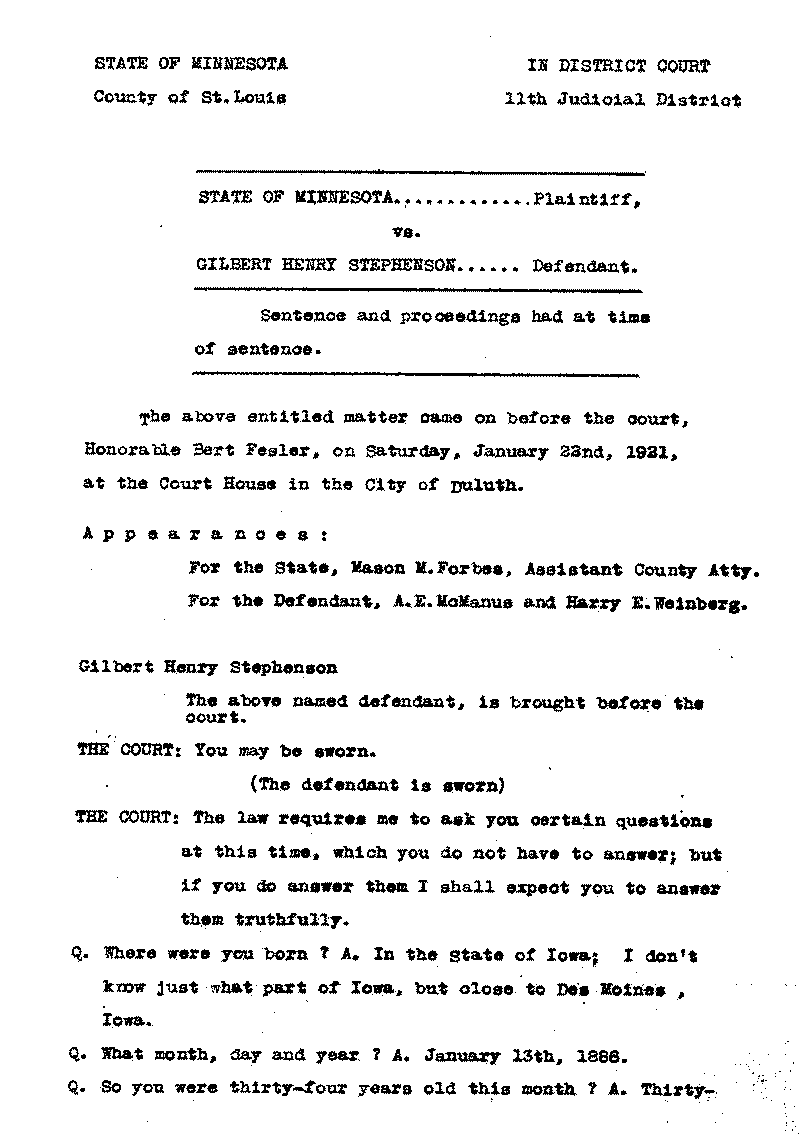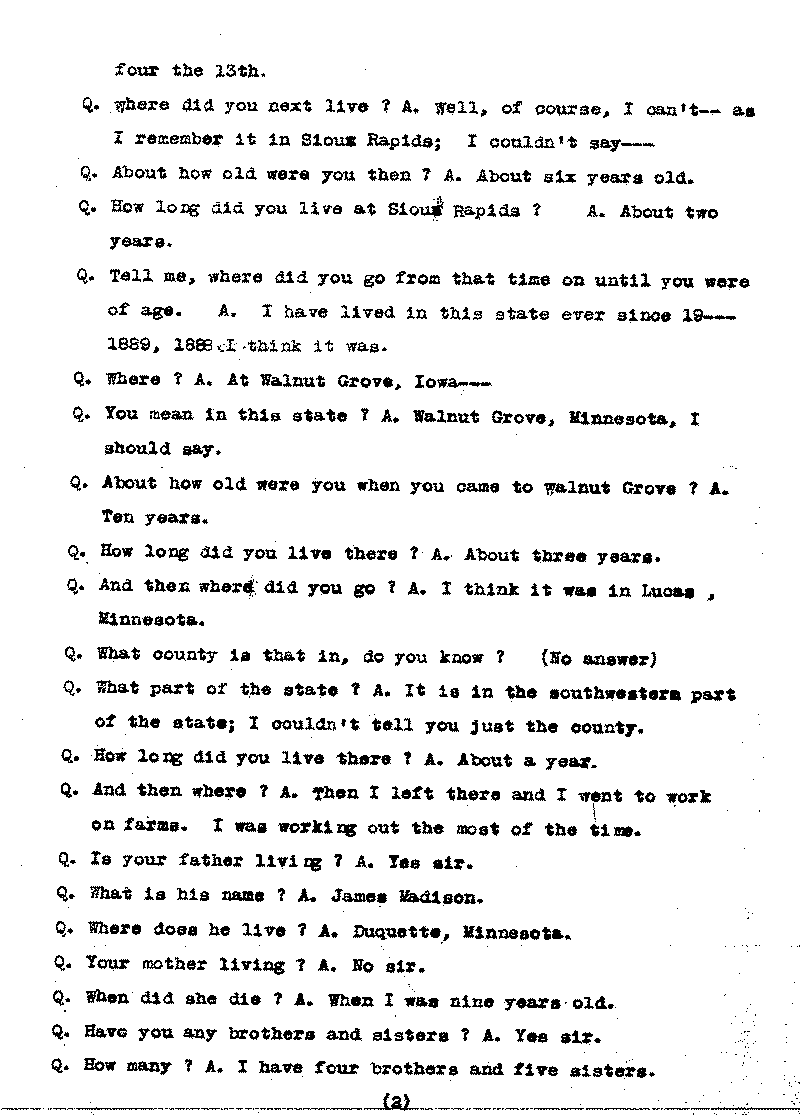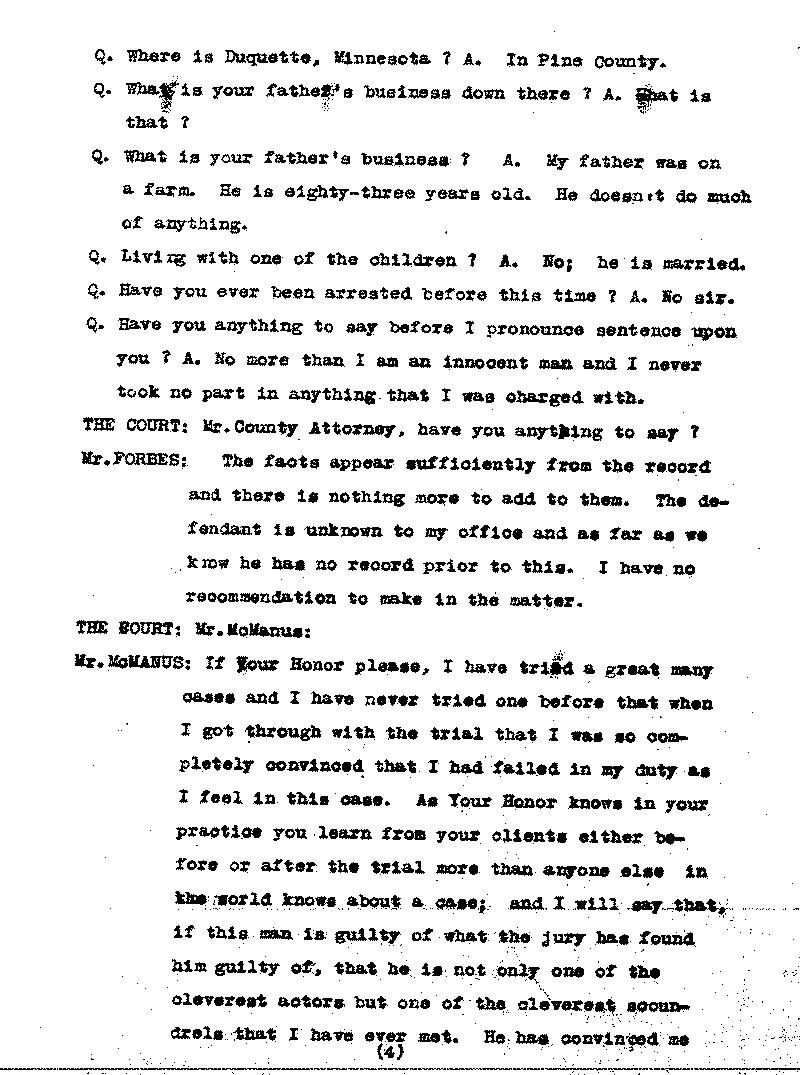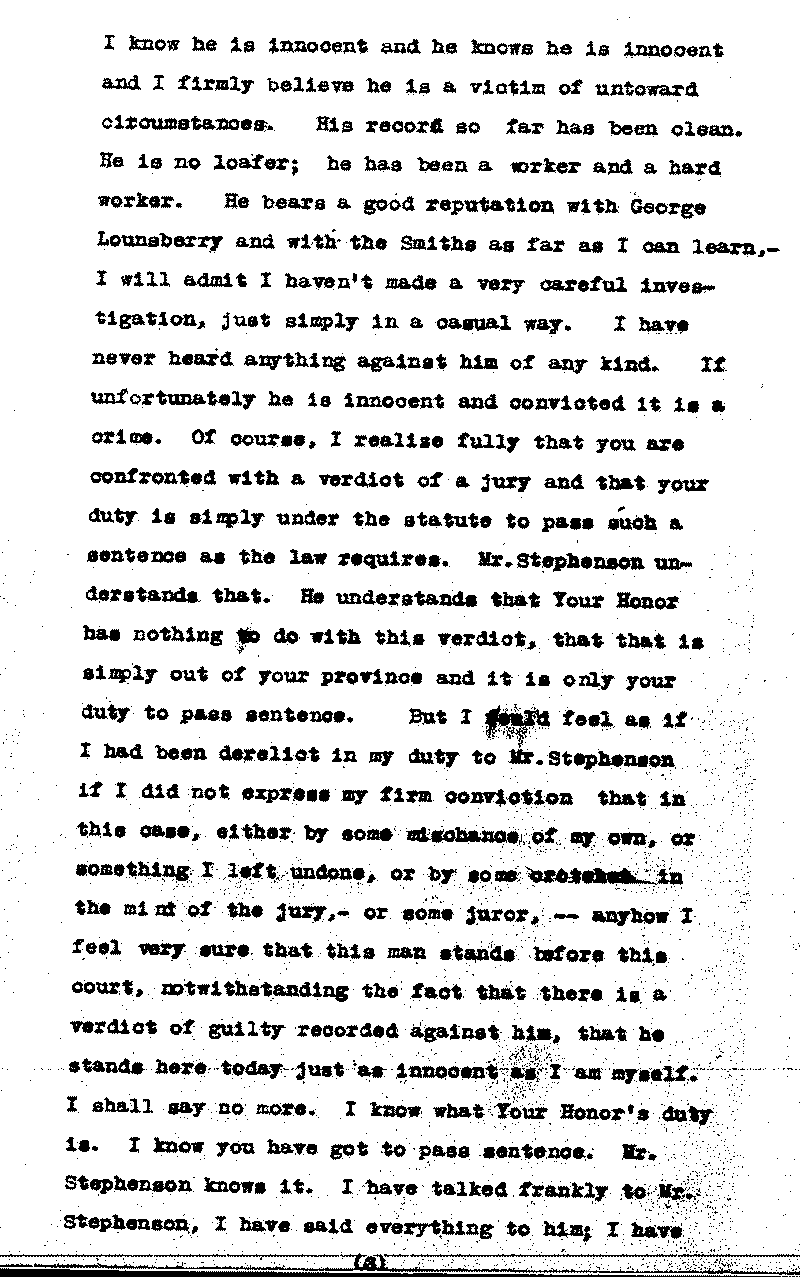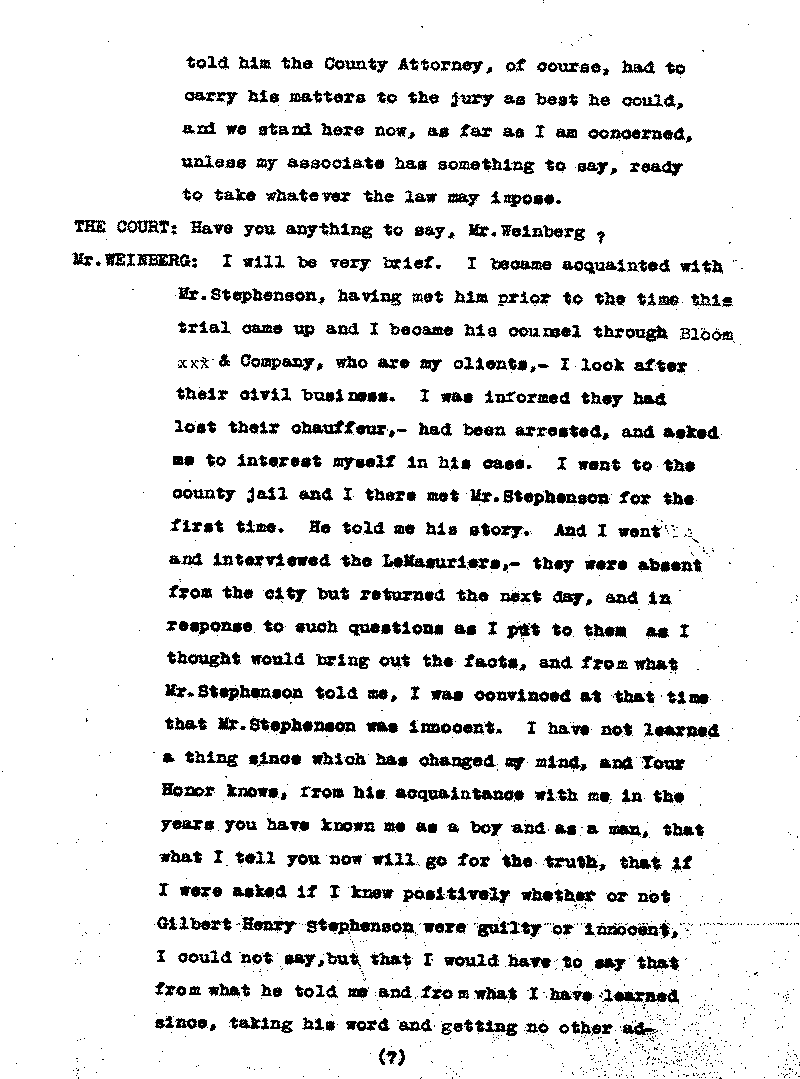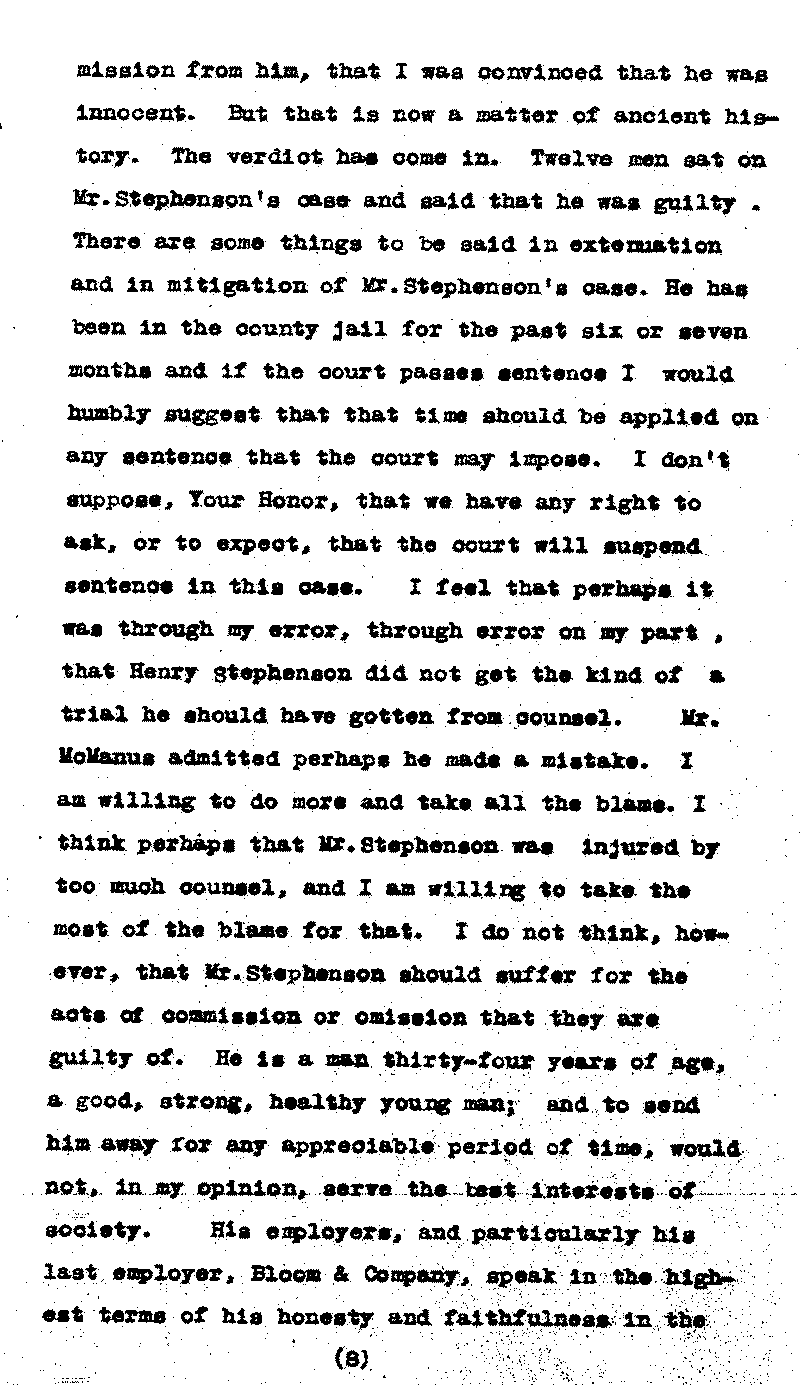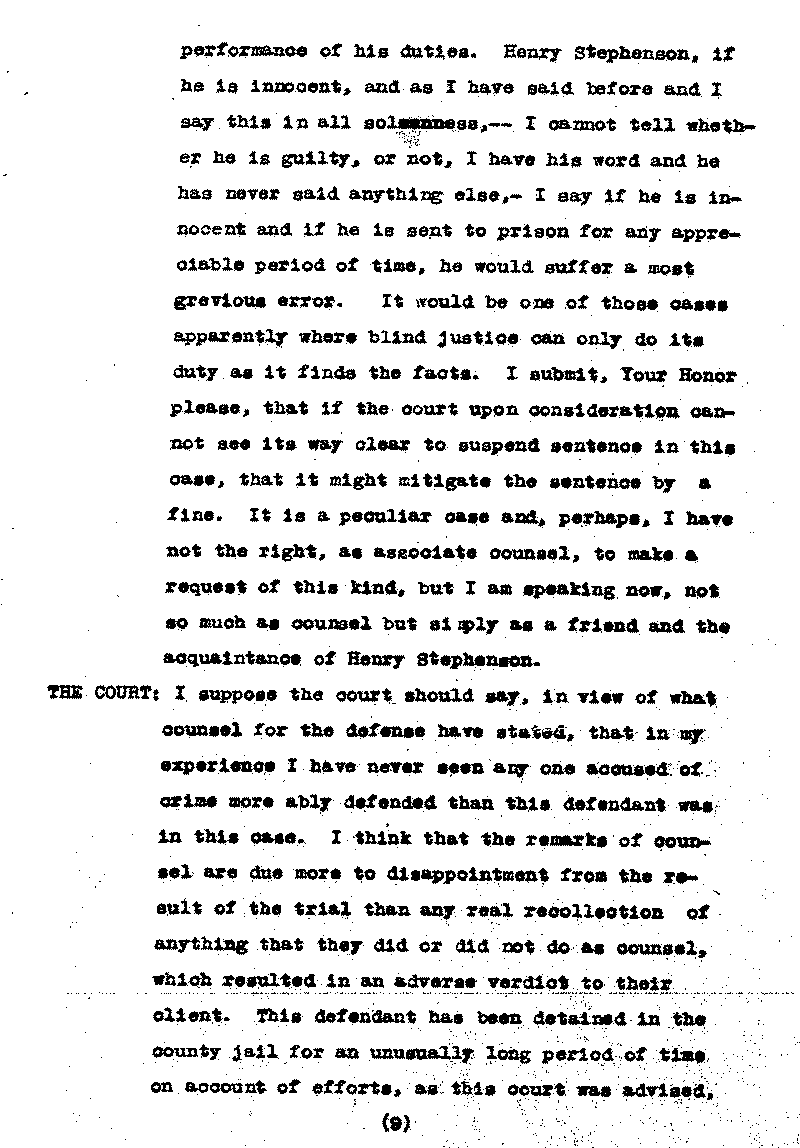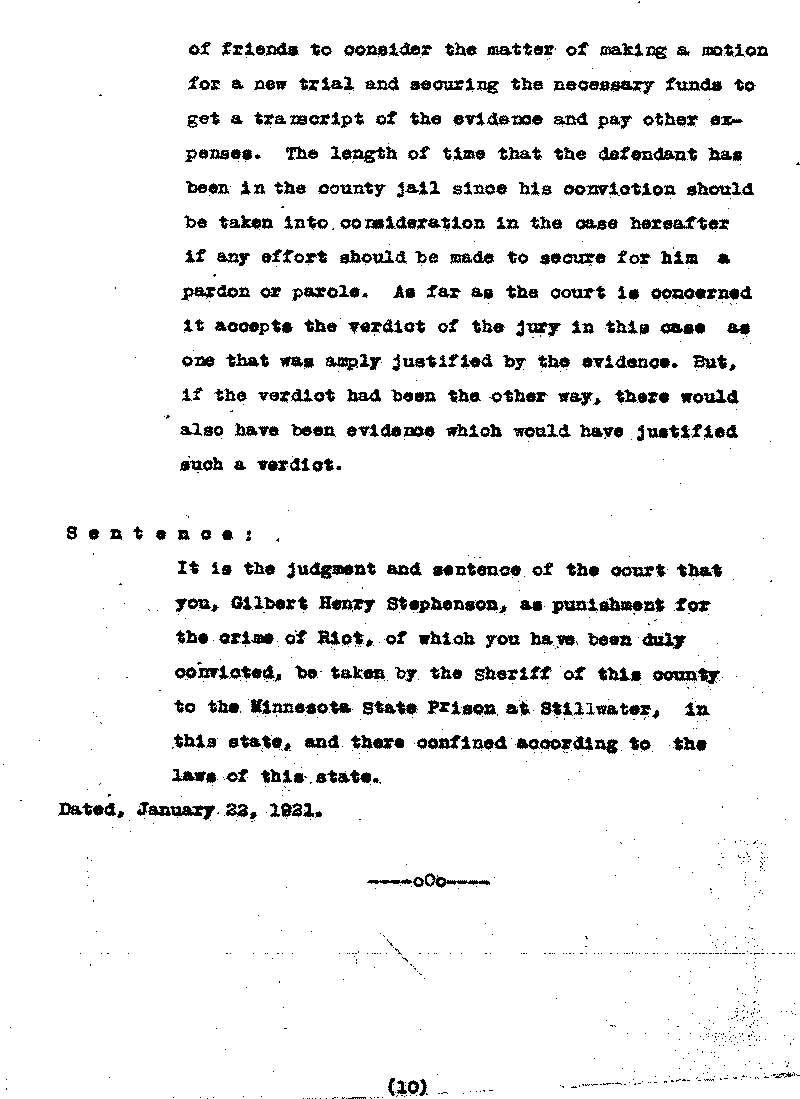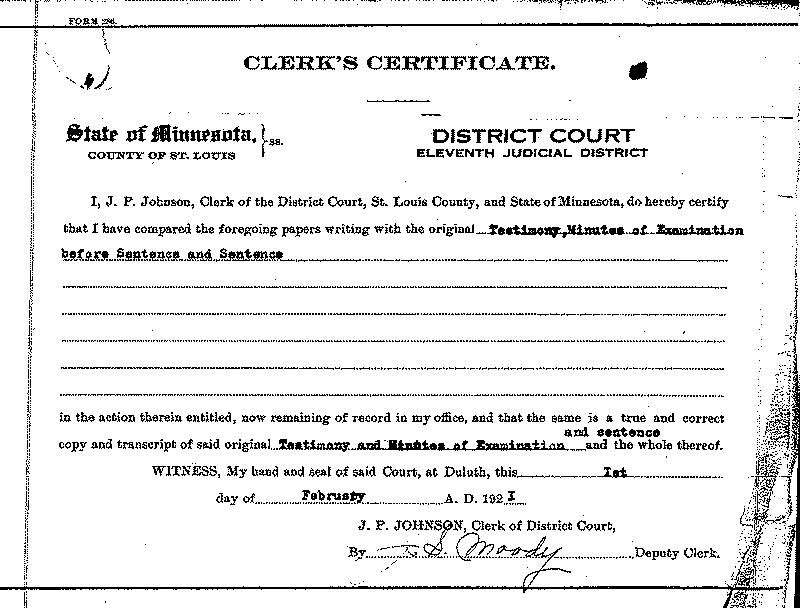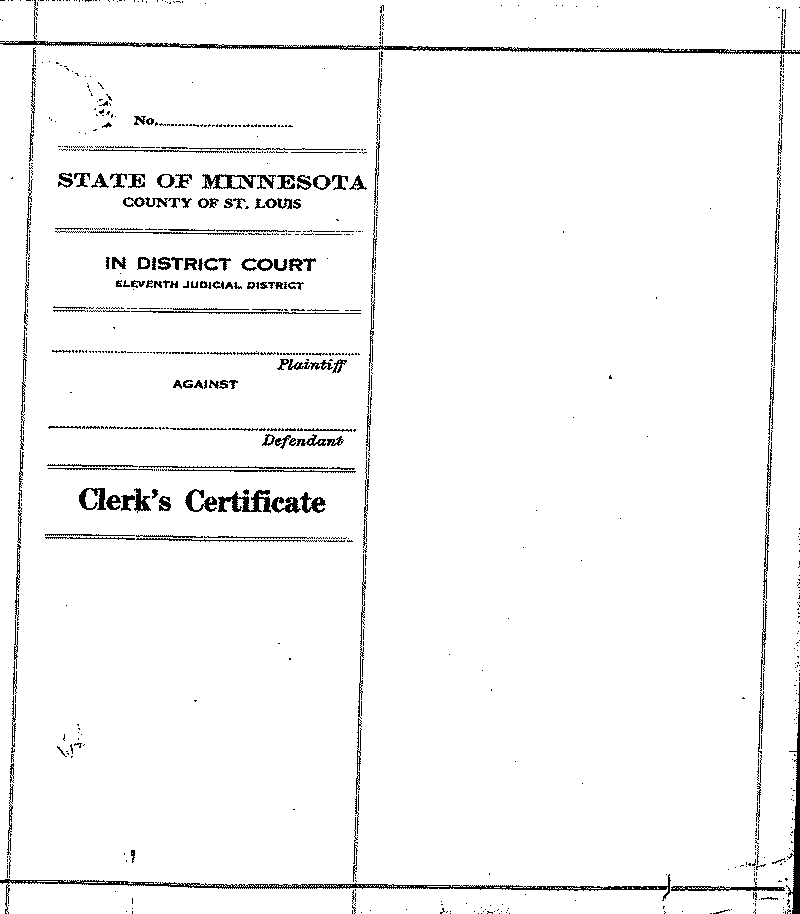Gilbert Henry Stephenson. No. 6598.
Type of event: Legal Proceedings
Location: Stillwater; Washington County; Minnesota; United States
Document date:
Document type: Gov't Record(s)
Document subtype: Trial Transcript
Documents: Gilbert Henry Stephenson. No. 6598.
Citation:
Minnesota State Prison (Stillwater, Minn.) [Stillwater State Prison].
Transcript of Trial of Inmate.
No. 6598: Gilbert Henry Stephenson.
Image text
JUDGES JUDGES
HON.
J. D. ENSIGN HON. H. A. DANCER
HON. W. A.
CANT HON. BERT FESLER
HON. MARTIN HUGHES HON.
EDWARD FREE
COUNTY OF ST.
LOUIS
OFFICE OF
CLERK OF
DISTRICT COURT
Duluth,
Minn., Feb. 2, 1921
J. P.
JOHNSHON
CLERK
C. S.
Reed, Esq.,
Warden of the State’s
Prison,
Stillwater,
Minn.
Dear Sir:
I am
sending by express the testimony and minutes of examination before sentence, in
the case of State of Minnesota, vs. Gilbert Henry Stephenson. The other
commitment papers having been delivered to you at the time the prisoner was
taken by the sheriff to the State’s
prison.
The Courts have been so busy the last two
or three months it has been impossible for the reporters to get out the records
in these cases, and the court has directed me not to delay the prisoners on that
account, and that is the reason you did not receive the complete commitment with
the prisoner.
Yours
truly,
J. P. JOHNSON,
Clerk,
By J. S.
Moody
Deputy.
JSM:K
State of Minnesota,
In district court,
County of St. Louis.
Eleventh Judicial District.
6598
STATE OF MINNESOTA,
Plaintiff.
Vs.
GILBERT HENRY STEPHENSON, Defendant.
Synopsis of
Testimony and Charge of Court.
This cause came on for trial at the May 1920 term
of the district court of
the Eleventh Judicial District of
the State of Minnesota, held at the
court-house in the city
of Duluth, Minnesota, within and for the country of
St.
Louis, and state aforesaid, on Monday, August 30th, before
Hon. Bert Fesler, Judge, and a jury.
APPEARANCES:
Mason
M. Forbes, Assistant county Attorney,
For the State.
Harry E. Wineberg and
A. E. McManus,
for the
Defendant.
_____________________________________
The case is called for trial and a jury impaneled
and sworn to try the
cause.
Mr. Forbes opened the case to the jury on behalf
Of the
State.
OSCAR OLSON, Called as a witness on behalf of the State.
1
2
MR. McManus; May it please the Court, the defend
Ant objects to the
introduction of any evidence under
the indictment on the ground that the same
does not
state a public offense. Second, on the ground that
The indictment
is so general in its terms and so gen-
eral in its charges that the defense
cannot properly be
prepared to meet these charges, -has not due
notice
thereof. The statement of the county Attorney does not
in all
things comport with the statement made in the in-
dictment, nor agree with
it. Furthermore, I ask that
all witnesses on behalf of the State, as well as
all
witnesses on behalf of the defense, please be excluded
from the
court-room during the trial of this case, ex-
cept those who are testifying
at the time.
The court: Mr. Olson, take the stand.
OSCAR OLSON is duly
sworn.
THE COURT: The objection of counsel will be insert-
ed at this
stage of the record and it will be overruled.
And the request of counsel for
the exclusion of witnesses
Made by him will be granted. Counsel will take
pains to
Identify th3e witnesses and the witnesses will retire
From the
court-room as their names are called by the
Counsel.
(Witnesses retire
from the court-room).
THE COURT: is there anyone in the court-room who
knows
Himself to be a witness in this case? If so he will
re-
Tire.
(No response).
MR. McMANUS: May I have an exception to the
ruling
of the court on the matter that the Court overruled?
THE COURT:
Yes.
2
3
DIRECT EXAMINATION
By Mr. Forbes:
Q. Your name is Oscar Olson? A. Yes, sir.
Q. You are a
police officer and have been connected with
the police force of the City of
Duluth for some time?
A. Yes, sir.
Q. You were acting in the capacity of police officer on
the 15th day of June of this year? A. Yes, sir.
Q. Where were you on duty that day? A. At the police
headquarters.
Q. What were the hours of your watch? A. From four o’clock
in the afternoon until twelve, midnight.
Q. Prior to that time how long had you been on the force?
A. Since the 1st of May, 1908.
Q. You are sergeant of police? A. Yes, sir.
Q. I will ask you, Mr. Olson, if on the 15th day of June,
1920, there was under your guard and in your custody and con-
troll three Negroes by the name of Issac McGhie, Elmer Jackson,
and Eli Clayton? A. Yes, sir..
Q. Where were they placed for safe keeping? A. They were
placed in the big jail in cells. The big jail is the jail on
the ground floor.
Q. How is that big jail – And is that big jail the big
jail belonging to the City of Duluth and in this county?
A. Yes, sir..
Q Do you remember when they ere brought in? A. Yes, sir..
Q When was it? A. Seven-thirty in the morning.
Q The morning of the 15th? A. The morning of the 15th,
yes, sir.
Q. Were they in cells when you went on watch at that time,
that day? A. That I don’t know.
Q. You took charge at what time? A I reported for duty
3
4
at 7:35 that afternoon.
Q. You were on duty from four until twelve that night?
A. Yes, sir
Q. These men were in cells in the cell-room in the rear of
the main floor of the city jail? A. Yes, sir.
Q. When that evening or during the afternoon or evening was
your attention first called to any disturbance, unusual dis-
turbance, in the neighborhood of the jail? A. Around near
seven o’clock.
Q. What called your attention to it? A. An unusual num-
ber of people passing by.
Q. That was about what time? A. Oh, around, - possibly
shortly before seven, or around seven o’clock.
Q. After that did the number of people around the jail in-
crease gradually? A. Why, yes, they did.
Q. Will you explain to the jury where the people were
gathering? A. Why, on the – on Superior Street and also
Michigan.
Q. Is there an entrance to police headquarters from Michigan
Street? A. Yes.
Q. Where is the garage located? A. On Michigan Street.
Q. On Michigan Street? A. Yes, sir.
Q Is there an entrance to police headquarters from Superior
Street? A. Yes, sir.
Q. And on what floor is that? A. It is on the ground
floor, that is on Superior Street.
Q. Will you just tell us in your own language what happened
there as the people gathered? A. Why, I noticed an unusual
number of people on the street, on Superior Street and also
Michigan Street, and that went on for a little while and shortly
after there was a large number of people there.
Q. What were they doing? A. They were yelling.
4
5
Q. Could you distinguish anything they were yelling? A. No,
I cannot.
Q. Making a loud noise? A. Yes.
Q. At both the Superior Street side and also the Michigan
side? A. Those I noticed only from Superior Street.
Q. Tell us what happened after that? A. The mob started to
throw bricks and stones.
MR. WINEBERG: Can’t you fix the time of this, Mr.
Forbes, - I mean the hour?
By Mr. Forbes:
Q. Can you fix the time
that was more definitely? A. I can
fix it – some time between
six-thirty and eight o’clock.
Q. go on and tell what happened? A. They
started to throw
stones and bricks, and the police fought off the mob on
the
Superior Street side and the mob then went to Michigan Street
and also
continued to throw bricks and stone, and they were
driven away from there and
then they come around to Superior
Street side again, and resisted the police
there for some time
until they finally overpowered the police and gained
entrance
to the police station.
Q. When was the hose, if the hose was
used, when was it first
used? A. After the mob began to use stones and other
things.
Q. What was done with the hose? A. Why, we had the hose
attached
to a hydrant out at Second Avenue East and Superior
Street. The hose was
brought into the hallway of the station
and we used it on the mob.
Q. You
turned the water on – A. Yes, sir.
Q. Squirted the water at them? A.
Yes, sir. And when we
beat them off the front they went around to the rear. A
little
narrow stairway there and we beat them off there and then they
came around on the Superior Street side again. They had out the
5
6
first hose and we had sent for more hose. The mob seized the
hose, or
took the hose from the firemen and attached it to the
water main on First
Street and Second Avenue East and used it
on the police.
Q. I will ask you
what if any windows were broken in front of
the jail? A. Yes, sir.
Q.
What windows? A. Nearly all the windows in the police
station, with the
exception of one or two small ones.
Q. Were they broken that night by the
mob? A. Yes, sir.
Q. What door ? A. The outside door and the inside bar
door.
Q. On the second floor of the cell room was there any attempt
made
there by the mob – A. Yes, sir.; a hole made in the wall.
Q. How big a
hole? A. Oh, possibly close on to three feet
long and maybe abut a foot and a
half wide.
Q. In what wall was that hole made? A. It was in the wall
west
of the entrance into the jail.
Q. On the second floor? A. Yes, sir.
Q. Was
that damage all done by the mob that night? A. Yes, sir.
Q. Did the crowd,
the mob that night obtain entrance to the
cell room where these three men, McGhie, Jackson and Clayton were
kept? A. Yes, sir.
Q. How did they get into that cell room? A. They broke in.
Q. How? A. Force.
Q. Do you remember what kind of an instrument they used?
A. They had a large timber that they used as a ram against the
outside of the jail door, of the big jail, and a crow-bar. Ham-
mers. Several other instruments.
Q. I will ask you whether or not the locks of the cells in-
6
7
side of the cell room were broken? A. Yes, sir.
Q. How many, do you remember? A. Four or five4.
Q. Do you know how they were smashed? A. I do not.
Q. How far did the mob extend along the street, how far?
A. As far as I could see from standing close outside the front of the building.
Q. As far east and west as you could see? A. Yes, sir.
Q. How far would you say they extended, as far as distance was
concerned, how far east on Superior Street? A. some distance
east on the easterly line of Second Avenue East.
Q. And how far west? A. On the westerly line of first Avenue West.
Q. And was the street densely packed with people. A. Yes, sir.
Q. During all that time were they yelling and calling?
A. Yes, sir.
Q. During those hours, I will ask you, Sergeant - -
MR. WINDEBERG: What hours, - fix the hours.
By Mr. Forbes:
Q. Between four o’clock in the afternoon and twelve o’clock
at night. Were you in charge there? A. Yes, sir.
(Recess for a few minutes)
Q. I will ask you, Mr. Olson, if J.N. Nyquist, Stantz Nes-
goda, E. H. Barber, Carl Sundberg and C.C. Walker are all po-
licemen connected with the police force? A. Yes, sir.
Q. Were they on duty that night at police headquarters?
A. They were called there.
Q. Do they all come down at night? A. Yes, sir.
Q. I will ask you if they reported there under your orders - -
A. Yes.
Q. What time, about, do you fix it as the time when the mob
7
8
got into the jail and broke the hole in the wall on the upper cell
room and broke the door in the lower big cell, - the big jail?
A. some time after ten-thirty; ten-twenty, something like that.
Q. I will ask you if these three men, who had been present un-
der your custody and under your guar, Isaac McGhie, Elmer Jack-
son and Eli Clayton, were removed by the mob from the jail?
A. Yes, sir.
Q. And were they hanged subsequently? A. Yes, sir.
Q. I don’t know, - were you hit with anything during the riot
down there? A. I don’t know whether I was hit, or not, but I
had several bruises the day following.
Q. Was the water turned on you, at all? A. Yes, sir.
Q. That was the water from the hose? A. Yes, sir; from the
mob’s hose.
Q. From the mob’s hose? A. Yes, sir.
Q. When the crowd got into the jail I will ask you whether or
not, - in the police headquarters, if the halls and corridors and
all places were filled with the crowd? A. Yes; packed.
Q Was anything done, Mr. Olson, that night, to try to keep
the mob quiet or disperse them? A. Yes, sir.
Q. By whom? A. By myself and other police officers.
Q. By any citizens? A. Yes, by one.
Q. Was there any – A. That I could see.
Q Were there any speeches made by anyone at that time to quiet
them? A. Yes.
Q. by whom? A. Myself, Attorney McClearn, and by a man who
I didn’t know.
Q. Was that prior to the time the cell room door was broken?
A. it was before the cell was broken, yes.
Q. And before the hole was made in the wall of the upper cell
room? A. Yes, sir.
Q. All this happened here in the City of Duluth, County of
8
9
St. Louis and State of Minnesota? A. Yes, sir.
MR. McMANUS: No cross-examination.
- - - - - - - - - - - - - - - - - - - - - - -
WILLIAM F. LASHELLS, Being first duly sworn as a witness on be-
half of
the State, testifies as follows:
DIRECT EXAMINATION
By Mr. Forbes:
Q. Your name is William F. LaShells? A. Yes, sir.
Q. Where do you live,
Mr. LaShells? A. 109 East Fifth.
Q. What do you do, what is your business?
A. Engineer.
Q. Where are you employed now? A. Missabe dock.
Q. Did you
come right from the dock? A. They took me right
off my engine.
Q. You
want to go back as soon as you can? A. Just as quick
as possible.
Q.
Calling your attention to the night of the riot here, the
fifteenth of June
of this year, I will ask you if you were in
the neighborhood of the police
headquarters during that disturb-
ance? A. I was.
Q. When was it you
first got there? A. About six-fifteen.
Q. Were there very many people there
then? A. There was a
few.
Q. How long after that before the crowd
reached a consider-
able size? A. Oh, abut a quarter from – six-thirty
until
nine o’clock, pretty good size eight o’clock.
Q. Did
you see a truck going up and down Superior Street
during that time? A. I
did.
Q. About what time was it you saw the truck? A. I saw the
truck going
along first, - just a few minutes after six.
Q. Were there many people on
the truck? A. There was about,
9
10
I should judge eight or nine, something like that; I never
counted
them.
Q. What were they doing, talking? A. Some of them was hold-
ing a
rope behind and some was on the truck calling to the people
on the street to
come and join a necktie party.
Q. Where did the truck go, in a general way,
as you saw it?
A. I was on First Avenue East and Superior Street when
it
first passed me; it turned around and come down, - it went down
the
street twice that I saw.
Q. Do you remember where the truck ultimately
stopped?
A. The last I saw of the truck it went on around the corner
of
First Avenue East and it was parked there.
Q. South of Superior Street? A.
yes, just a little.
Q. Where did the people go that were on the truck? A.
Well,
they had all left the truck before, come up and stay around
the
police station.
Q. At that time were there a good many people around
the po-
lice station? A. Quite a few, yes, sir.
Q. What were they doing?
A. Standing around the way a crowd
would usually in excitement.
Q. Were
you there when the officers were using the hose?
A. Yes, sir.
Q. Were
you there when the mob was squirting water against
the officers? A. Yes, sir.
Q. What time did that occur? A. Well, the
officer had the
hose first and the crowd didn’t get the hose until the
second
time that the wagon come up just outside of the police station
with
the hose, that is when the fireman gave the crowd the
nozzle, - that is where
he got the nozzle, gave it to him off
of the truck - -
Q. At that time
were there a great many people around police
10
11
headquarters? A. Quite a few, yes.
Q. had they started calling and
yelling at that time?
A. Some of them had, yes.
Q. Do you remember what
they yelled? A. “Get the Negroes”,
different things like that.
The same as fellows would holler.
Q. do you remember abut what time it was
that the mob got
their hose? A. As near as I could judge, not having a
time,
I guess it was along about eight or a few minutes after eight
that
the mob got control of the hose.
Q. Did you recognize anybody holding the
hose in the mob?
A. Yes, sir.
Q. Calling your attention to this
defendant I will ask you
if you saw him there that night? A. Yes, sir.
Q.
Whereabouts ? A. He was on the hose, on the nozzle, in
the middle of the
street, with another man.
Q. How far away from the police headquarters? A.
About the
middle of the street, a little past the center.
Q. What were
the police doing with their hose at that time?
A. They were holding the hose
on the two men that had the
nozzle and they couldn’t get the water
through it.
A. Did you see this defendant again that evening? A. I
did.
Q. Where did you see him? A. In the police station.
Q. About what
time was that, if you can remember the time”
A. Well, that was in the
neighborhood of, - I should judge
twenty, - twenty-five minutes after they
had got the hose. As
soon as they got the hose they drove the police
back.
Q. What happened to the police? A. They drove the police
back with
the water.
Q. What was the mob doing then? A. Some of them grabbed
the
police hose and pulled it out, - out of the way.
Q. Where did they
go? A. They used that hose to, - used both
11
12
hoses.
Q. Did the mob then get into the police headquarters?
A. Yes,
sir.
Q. Were there many people in there ? A. There was, after
they got
the water and drove them back, clean out of the office
there and broke the
windows, shot the water through the windows.
Q. When after that was it that
you saw the defendant Steven-
son? A. After they got - - got in control of
the police sta-
tion, of course, they abandoned the water, that was after -
-
they didn’t use the water any more after that, - after they
got
control of the situation.
Q. Was there much water around on the
floor? A. Yes, Sir.
Q. How deep? A. I couldn’t say whether - - how
deep it was.
But two hoses playing, it was pretty wet. Everything was
pretty
well soaked.
Q. I will ask you this question, if you saw the
defendant on
the hose outside, - and at that time where were you? A.
I
was right at the side of the door, on this side of police
sta-
tion.
Q. East or west? A. On the west side.
Q. I will ask you if
they went into the police station?
A. I did.
Q. Where did you go? A. I
went right in on the main floor.
Q. About what time was that, if you know?
A. Well, I should
judge that was in the neighborhood, - as close as I could
say,
nine o’clock.
Q. When you got inside of police headquarters
where did you
go? A. I went right on the main floor where the rest of
the
crowd was.
Q. Had the mob gotten into the cell room then? A. No,
sir.
Q. How long after that was it that they got in? A. Well,
12
13
that was, took them some time to break through.
Q. How did they get into
the main cell room? A. With
sledge hammers and bars.
Q. by breaking what?
A. By breaking the locks and the doors.
Q. I will ask you if they got into
the cell room? A. They
did.
Q. Did you go into the cell room? A. No, sir;
I stayed on
the outside.
Q. When was it after you got into police
headquarters that you
saw this defendant again? A. The first time I saw this
man
after I got in here, when he was breaking the lock with a
sledge
hammer.
Q. Which lock did they break? A. Well, now, I
couldn’t say
just what lock it was, because I don’t know, - I am
not acquaint-
ed with the place enough to know, but it was a cell lock. I
could easily show it if I had it, of course I don’t know how
the
cells are, - that is, I don’t know the numbers of the cells,
but it
was towards the back end of the station where the lock
was broke, the first
one.
Q. Where were you standing then? A. I was just back of
them, -
there was three or four.
Q. Was the lock you refer to, that the defendant
was breaking,
was that a cell lock? A. Yes, a lock of the cell.
Q. On the
cell door? A. Yes, sir.
Q. That was after they had gone through the big
door? A. Yes.
Q. Of the cell room? A. Yes, sir.
Q. Did you go down there
with them? A. I went there after
they had opened it, yes, sir.
Q. How
far away were you from the defendant when he was break-
ing the lock? A. Oh,
probably six or seven feet. As close as
I could crown up.
Q. You saw him
breaking the lock of the cell? A. I saw him
13
14
hitting it and finally gave away.
Q. Did you see him again that evening -
- A. No, I never
saw him any more after he broke the lock. I left and come
back
outside to the front door.
Q. Did you notice whether or not there
was any Negroes in that
cell that he was breaking? A. Yes, sir.
Q. There
were? A. Yes, sir.
Q. After you came out did you stay around there for a
while?
A. I stayed until one o’clock.
Q. Were you there when the
three colored men, McGhie, Jack-
son and Clayton, were brought out? A. I was
there, yes, sir.
Q. They were brought out by the mob, were they? A. Yes,
sir.
Q. And were they subsequently hanged? A. They were.
Q. by the mob?
A. Yes, sir.
CROSS-EXAMINATION
By Mr. McManus:
Q. When did you say you work for? A. I am working at
the
Missabe dock, for the Stack Construction company, on an engine.
Q.
What kind of an engine is it? A. Well, it is a steam-
engine.
Q. Are you
the engineer or the fireman? A. I am the engineer.
Q. have you a fireman? A.
No, sir..
Q. You fire the engine yourself? A. I do.
Q. Burns soft coal?
A. Yes, sir.
Q. A pretty smoky job you have got? A. Well, at times.
Q
You were down town that night, did you say, at six-fifteen?
A. I was.
Q.
You saw the truck going up and down the street? A. I did.
Q. What are your
hours as engineer? A. I work six – twelve
hours a day - - ten hours a
day.
Q. From when to when? A. Well, I leave my home at six - -
14
15
about six-five in the morning.
Q. And work until when? A. Work until six
– five-thirty at
night.
Q. Out at the Missabe dock? A. Yes,
sir.
Q. Where did you live, did you say? A. 109 East Fifth.
Q. You had
to go down town to get home? A. Yes, sir.
Q. What time did you usually have
your supper? A. Oh, about,-
supper is ready when I get home.
Q. What time
do you usually get home? A. About six o’clock.
Q. Did you get home
this night at six o’clock? A. I happened
to lay off for sixty days at
that time, wasn’t working, stayed
right at home, wasn’t working
there at that time, at all.
Q. Then you ere on sort of a vacation at that
time? A. I
was, - I had worked nine months straight and I took sixty
days
layoff.
Q. Are you working now? A. I am.
Q You were at First
Avenue East and Superior Street when you saw this truck drive by? A. Yes,
sir.
Q. With a rope behind it and that is in the papers - -
A. I am not
taking the paper, thank you.
Q. I am not asking you that. I say, you have
seen it described
in the papers, haven’t you? A. Well, I told you I
haven’t read
the newspapers but very little since I have been in this
town,
and my not believe it, but I haven’t - -
Q. Are you a
French Canadian? A. No, sir; I am a Yankee.
Q. Do you read? A. I do.
Q.
You haven’t read the papers about it, at all? A. Oh, my
wife has read
it quite a bit, yes, read to me a little bit.
Q. The truck passed you first
going east on Superior Street,
and the it passed you another time? A. Yes,
sir..
Q. Finally it went down to Second Avenue East, turned around
15
16
the corner and disappeared? A. No, sir.
Q. Where did it go to? A. It went
up to Second Avenue and
turned around and come back to First Avenue East.
Q. Then where did it go? A. Then they went up and down the
street again,
then it went off east of First Avenue East, - be-
tween Superior Street and
Michigan Street and parked there.
Q. Did you go down to look at it where it
was parked?
A. I was standing right on the corner.
Q. Where were you
standing when it first passed you?
A. Standing just on the corner, right
there, - just a door or
two from First Avenue East on Superior Street.
Q.
You must have followed them down - - A. It didn’t park
on Second
Avenue East.
Q. Parked on First? A. Yes, sir.
Q. You say about eight
o’clock the crowd got hold of a hose?
A. Well, no I didn’t say
it was eight o’clock.
Q. Was it dark then? A. Yes, it was getting good
and dark, -
towards dark when they got the first hose.
Q. When was it
the crown out this hose? A. As near as I
could tell, a few minutes after
eight.
Q. How long after the crowd got the hose did you see the
de-
fendant with the hose? A. The defendant was in the middle of
the
street with the hose as soon as they got the nozzle - -
Q. And that was
about eight o’clock? A. No, it was later
than eight, after they got the
nozzle.
Q. How long was it after eight, about? A. I would say fif-
teen
or twenty minutes - -
Q. Wasn’t it after nine o’clock when he
got that hose? A. No,
I couldn’t say.
Q. You swear it wasn’t
after nine o’clock before you saw the
defendant there? A. No, I
couldn’t swear to the time. I didn’t
have no time on me, I am
only guessing - -
16
17
Q. You don’t know? A. I don’t know the real time, no.
Q You
are sure you saw the defendant? A. I am positive.
Q. Did you ever meet him
before? A. No, sir.
Q. Ever see him since? A. No, sir; not until I saw him
here.
Q. Here in the court-room? A. That I know of.
Q. How was he
dressed that night? A. Well he had on some
kind of a jumper, - I don’t
know. He wasn’t dressed up, had on
some kind of a jumper. it had been
laundered.
Q. What color? A. Kind of, - looked to me like it was
overall jumper that had been washed.
Q. That was midnight on the
15th - - A. you would not
call it day time would you? After six
o’clock is night, after
sundown.
Q. if the sun is up at six - - A.
I don’t believe the
sun was up at that time.
MR. FORBES: the
record may show, I have no reason to
doubt that that is correct, counsel
asked me if I would
state it for the record, and I am willing to state
it,
and the record may show that I concede that.
MR. McMANUS: It would
be sunset that night at eight-
thirty-eight?
By Mr. McManus:
Q. Yes. Did you see what the
defendant had on? A. yes.
Q. It was an overall jumper, you think? A. I
believe it was.
Q. It had been laundered? A. I think so, yes.
Q. He had
on overalls, too? A. I can’t say what he was wear-
ing for
trousers.
Q. What kind of a hat did he have on? A. he had a cap.
Q. What
color cap? A. I couldn’t say what color cap he had on.
Q. Was it a
cap, or peak, or otherwise? A. Well, it
was - - I think it was just the
ordinary cap, with a little - -
17
18
Q. With a little vizor? A. Yes.
Q. Or peak, do you call it? A. I
don’t know what you call
it.
Q. how near were you to him? A. Well,
at one time I wasn’t
over - - crossing the street, when they had the
hose I wasn’t over seven or eight feet from him.
Q. In front of him or
behind him? A. Right across in front
of him.
Q he had hold of the hose?
A. he had hold of the nozzle.
Q. Two of them? A. Two of them at the time,
yes.
Q. Nobody else? A. Nobody was holding the nozzle at the time
because
the water wasn’t yet in there.
Q. How long before somebody else did
take hold of the nozzle?
A. Just as soon as they got the water through the
nozzle.
Q. Who else had hold of the nozzle besides him? A. I don’t
know who it was.
Q. Whom else did you see there that night that you
recognized?
A. Several others.
Q. Well, who? A. I couldn’t say
their names, I didn’t know
them.
Q. Who else have you now clearly
in mind that you saw that
night besides this man ? A. Who else did I see
there that was
mixed up in it?
Q. Yes. A. Quite a few of them that is
here, that I saw
there.
Q. Can you remember their names? A. I don’t
know abut the
individual’s names, - I don’t know about
anybody’s name.
Q. Would you know them again? A. I know lots of them,
yes.
Q. Would you know them again if you saw them? A. Yes, sir..
Q. Are
you going to be a witness in other cases against these
men who are charged
with this same offence? A. I don’t know.
Q. What were you doing there?
A. I was looking on.
18
19
Q. You were right in the cell? A. Yes, sir - - I wasn’t
in the
cell, though; I was in the jail.
Q. You said you were? A. No, I did
not.
Q. How? A. I did not.
Q “I stood on the outside. The first
time I saw the man was
where he was breaking the lock with a sledge hammer. I
went
through the opening and saw the niggers in there.” Did you
tes-
tify to that? A. I went through the door.
Q. Did you testify that
you went in through to the cell after
the cell was broken open and you saw
the Negroes in there?
A. I testified I went through the main door that was,
- to the
cell.
Q. Did you say you saw the Negroes in there? A. I saw
the
Negroes in there, yes, sir, through the door, but I didn’t go
through the door.
Q. Did you testify that you stood three or four feet
back of
him when he was breaking the door? A. I did.
Q. What part did
you take in this riot? A. I took the part
of a citizen to uphold law and
order.
Q. Did you do anything to sop them from breaking this door?
A. I
tried to.
Q. What did you do? A. I --- I came up and asked as
law-
abiding citizens to uphold law and order, and not damage
property.
Q. You say you saw this man holding this hose? A. Yes.
Q. And
you saw another man holding the hose with him?
A. Yes, sir.
Q. How was
the other man dressed? A. The other man was
dressed with some kind of a dark,
- dark cloth, I don’t know what,
I couldn’t say what it was; it
was dark cloth of some kind.
Q. Was he a larger man than this one, or
smaller? A. I be-
lieve he was smaller.
Q. How long did you see this
defendant hold that hose?
19
20
A. Oh, I guess he must have had the hose, anyhow it was, -
twenty
minutes before they got loose from it.
Q. Was the stream coming from it
during all that time?
A. Not all the time, no, sir.
Q. Any of the time?
A. Quite a bit of the time, yes.
Q. That was right - - A. They didn’t
get the water through
it for a while.
Q. How long was it before they got
water? A. I guess it
must have been at least ten minutes before they got
water through
it.
Q. Well, was it longer than that? A. No, I
don’t believe
it was.
Q. Did he hold it twenty minutes after that?
A. No, twenty
minutes altogether.
Q. He held it ten minutes before they
got water? A. I think
about ten minutes before they got water through
it.
Q. You have testified that it was about eight o’clock, or
maybe
a little after, before they got the hose? A. Well, I
don’t know just
exactly what time because I never had a time-
piece.
Q. About ten minutes
after the water came through the hose?
A. Ten minutes, about.
Q. Will
you say to this jury whether or not that occurred, -
that all occurred
between eight and eight-forty-five? A. Well,
I know it was right along there;
it wasn’t later, - it may be
nine o’clock and may have been a
little after nine. I didn’t
take it down.
Q. Could it have been
half-past nine? A. No, I don’t think
it could have been as late as
half-past nine.
Q. Would it have been nine when you last saw him with
the
hose? A. I couldn’t say right the time exactly, at all.
Q Would
it have been nine o’clock when he first got the hose?
20
21
A. Nine o’clock, well, it may have been, may have been
nine
o’clock, I can’t say that it was - -
Q. As a matter of
fact, you haven’t any very definite idea
about the - - A. Not the
correct time, no, sir.
Q. Were you in the court-room when the witnesses were
ordered
excluded from the room? A. I was.
Q. You went out? A. I
did.
Q. You say that when you saw the defendant after that it was
up in
the jail breaking the lock with a sledge hammer?
A. Yes, sir.
Q. You
remember that? A. Yes, sir.
Q. Could you see that distinctly? A. Yes,
sir.
Q. Did he have on the same clothes that he had on out in the
street?
A. Yes, sir.
Q. What were they? A. Some kind of a light jumper, -
I
think that was an overall jumper, had been laundered, some kind
of a
jumper that he had worn.
Q. Of that you are sure? A. Yes, sir..
Q.
Can’t be mistaken on that, at all? A. I don’t think I am.
Q. And
that is this defendant sitting here. A. Yes, sir.
Q. You had never seen him
before? A. Never saw him before.
Q. And never saw him since until you saw
him here? A. I never
saw him until I saw him walk out here.
Q. You
can’t remember the face of any other man that had hold
of the hose? A.
I have never seen him since, no, sir.
Q. You ever had seen this man until
yho7u came into court?
A. No, sir.
Q. You came into court ready to
identify him? A. Yes sir.
Q. You could identify the other man just as
readily? A. No,
I could not.
Q. Did you help take the Negroes out? A I
did not.
21
22
Q. How close were you to them when they were taken out?
A. I should
judge I was, - very close to them. The one that
was in ahead, that was very
close - -
Q. Do you know who he was? A. I don’t know him, no,
sir.
Q. Could you identify him? A. I would know him if I would
see him,
yes, sir.
Q. Have you been asked to identify him? A. No, sir..
Q. You
told this all to the country attorney and to the grand
jury? A. I did
not.
Q. Haven’t you been a witness before the grand jury? A. I
was
at the grand jury, but I never told where, - in regard to
this man
here.
Q. do you mean to say Mr. Forbes or Mr. Greene or Mr. McDevitt,
of
the country attorney’s office, never questioned you about what
you were
going to testify to in this case? A. I didn’t know
that I was going on
as a witness until this afternoon.
Q. And they didn’t know what you
were going to testify to?
A. I didn’t know that question was coming up
until this after-
noon.
Q. Had you told them what you have testified to?
A. No, sir.
Q. Have you told anybody? A. I told the grand jury what
I
done and what I seen down there, but I didn’t tell no names,
nor
didn’t know any names.
Q. How did the country attorney know you
were going to identify
this man when he put you on as a witness?
MR.
FORBES: That is objected to as incompetent, irrele-
vant and immaterial.
Objection sustained.
By Mr. McManus:
Q. Do you know how the
country attorney knew you were going to
identify this man?
22
23
MR. FORBES: That is objected to as being immaterial.
Objection
overruled.
A. I would like the question again. (Last question read)
Well,
- -
Q. answer Yes or No. A. Do I know how the county attorney
knew I was
going to identify this man, you say, - was that the
question?
THE
COURT: Yes.
A. I will have to answer it in this way, when I was up to
the
grand jury FI spoke - -
Q. Answer the question Yes or No. A. Do I
know how he knew, -
Yes, I know, if that is what you want.
Q. How did he
know? A. In my speaking in regard to the man
that held the nozzle on the hose
before the grand jury, I suppose
that is how he got it, knows it.
Q. That
is all that he knew about it? A. As far as I know.
Q. You never told him it
was Henry Stevenson? A. No, sir.
Q. You didn’t know what his name
was? A. No, sir.
Q. He was indicted under the name of - - A. What?
Q.
You knew he was indicted under the name of Richard - -
A. No, sir; I
didn’t know.
Q. Didn’t know anything about it? A. No,
sir.
Q. You just come here to testify, to identify this man - -
A. No,
I saw the man. I saw the man on the hose, and I am
positive that is the
gentleman sitting right there. The face
don’t deceive me.
Q. How do
you identify this man as the man you saw down there?
A. I know by his face,
his appearance.
Q. Did he have a mustache that night? A. No, I don’t
think
he did.
Q. And no beard? A. No. Might have had a few days’
growth.
Q. have you talked with Mr. Brown, a deputy sheriff connected
23
24
with the country attorney’s office, about this case? A. About
this
man?
Q. This gentleman sitting right here.
MR. FORBES: Where?
MR.
McMANUS: Isn’t this Mr. Brown?
MR. FORBES: Mr. Brown is one of the
men you put out.
MR. MCMANUS: I didn’t put him out.
MR. FORBES: he was one of the
witnesses.
By Mr. McManus:
Q. The deputy sheriff that is connected
with this case? A. No.
Q. You have no way of identifying this man at all
except you
saw him that night with a laundered shirt, colored overall
jumpers
on, and holding a hose, and - - A. Yes, sir.
Q. And
haven’t seen him since? A. No, sir.
Q. And never knew what his name
was? A. No, sir.
Q. And you identify this man as the man you saw - -A.
I
would know that man in ten dozen.
Q. You are doing better than that -
- A. I would know him
if I saw him ten years from today. you couldn’t
deceive me.
Q. You identified him positively just the other day?
A.
Yes, sir.
By Mr. Forbes:
Q. You never have talked to me until you
took the witness stand?
A. I didn’t know who you were, I never saw
you, didn’t know you
until - -
Q. I will ask you if you went with
me to the grand jury - -
if you said you could identify the heavy-set man
who was holding
the hose out in front of the police station if you were given
a
chance to see him? A. I did.
Q. Then were you shown this man and id
you identify this as
the? A. Yes, sir.
24
25
By Mr. McManus:
Q. Didn’t you tell me you never had seen this man
since that
night until today? A. I never seen that man since
identifying
him at the court-house, at the jail.
Q. Why didn’t you
tell me that? A. I didn’t know you wanted-
ed to know that.
Q. I
asked you plainly, Mr. LaShells, if you had ever seen
that man from the night
he held that hose until you saw him
here, and said that you had not? A. Well
yes, I saw him
when I identified him at the jail.
Q. When was that? A.
That was - - Now, that was three or
four - - that was after the lynching,
they took me up to the
jail - - No, lets see; I don’t know just what
day it was, but
anyhow - -
Q. How long was that after the lynching? A. I
couldn’t say.
Q. Well, now, you certainly have got to try to do better
than
that. A. I am doing the best I can. I am not an educated
attorney
like you are to know all those things.
Q. You are a man that knows time. How
long after this oc-
curred was it before you saw him in the jail? A. I never
took
no notice of the time because I didn’t really know I was going
to
be brought in as a witness on this.
Q. Was it a week? A. Well, it
might have been; it might have been a week.
Q. Was it two weeks? A. I tell
you I don’t know.
Q. Was it a month? A. I don’t know - - No, it
wasn’t a
month, I agree to that.
Q. You surely don’t mean
that you don’t know within a month of
when it was. Was it as early as a
month after the fifteenth of
June? A. No, it was - - I should judge - - as
near as I can
judge I would say it was about, - - probably fours, - five
–
between four and five days after the lynching, that is as
near
25
26
as I can judge. I won’t say; I don’t know the dates.
Q. You
saw the man at the jail four or five days. I realize
you are trying to tell
us as nearly as you can. You understand
we are all trying to tell us as
nearly as you can. you understand
we are all trying to get this date and
trying to find out what
the facts are. Are you sure it was not as much as two
weeks
after the hanging? jut stop and think a minute? A. no,
it
wasn’t two weeks.
Q. You would be very positive of that? A. Yes.
Q. You went up to the county jail and identified there at the
county
jail the man whom you believe to be the man you have in
mind now? A.
yes.
Q. The man who you then believed - - A. Yes, sir.
Q. And he was
in the county jail then? A. Yes, sir.
Q. You are sure it was not more than
two weeks after the hang-
ing? A. (No answer).
Q. You thought four days,
but you are sure it was not more
than two weeks? A. I don’t know the
time, not paying any at-
tention to the time I couldn’t say how long it
was just exactly,
or near, but I want to tell the truth as near as I
can.
Q. It is important to he court and jury, - we all want
to
know.
MR. FORBES: I do not see the materiality of the time
when
he was at the jail when he identified him.
MR. McMANUS; It is very
material, Your Honor.
MR. FORBES: it is a catch question.
MR. McMANUS:
it is not, - I beg your pardon.
THE COURT: The question is all
right.
A. Well, I told you I thought it was between five and six days,
I
believe that is what I told you.
By Mr. McManus:
Q. let me see if
I can help you out. How long had you been on
26
27
this vacation of yours when this thing happened? A. Well,
let’s
see: I was engineer at the Yale Laundry for seven months.
I left there on May
8th and I never done any more work until, –
let’s see
– may the 8th is when I left the laundry, and I
never done
any more work until along about, - some time in
July - - I could tell if I
had the time-book here.
Q. Can you get your time-book? A. I can get it at
home.
Q. Are you sure it was as late as July when you went to
work? A.
yes.
Q. About July what? A. Well, let’s see, I should say it
was
July.
Q. Maybe the 4th? A. No, I went to work after the
fourth.
I think somewhere along the 18th of July I went to work
again.
Q. Were you at work when you identified him? A. No, sir.
Q. it
was before you went to work? A. Yes, sir..
Q. You are sure of that? A. I am
positive.
Q. You saw him again at the county jail at some time, you
think
it was about four days after? A. No.
Q. Now, wait, I will tell you what I
have got here. You say
you left the Yale Laundry May 8th and you
didn’t work again until
about July 18th? A. I think it was
along - -
Q. You identified him between the time you left the Yale
Laund-
dry and the time you went to work again? A. No, I didn’t say
I
identified him between the time that I left the laundry and went
to work
because this had not happened when I left the Yale Laun-
dry.
Q. You
left the Yale Laundry the 8th of May? A. Yes, sir.
Q. And you
began work on the 18th of July ? A. Somewhere
along there.
Q.
it was between those two times that the lunching happened?
A. Yes.
27
28
Q. And it was between those two days you went up to the jail
and saw him
- - A. Yes.
Q. Is that right? A. Yes, sir..
By Mr. Forbes:
Q.
When you referred to going through a door and seeing this
defendant breaking
the cell door, what door did you refer to?
A. I referred to going through
the door of the police station
there.
Q. Over the police headquarters
into the cell room? A. Yes,
sir.
Q. These cells are arranged along in
there? A. Yes, sir.
Q. do you r3emember when you testified before the grand
jury,
what time it was? A. Sir?
Q. Do you remember what date it was you
testified before the
grand jury? A. no, I couldn’t say to the date that
I was at
the grand jury, offhand; I have a book that - - for the last
ten
years back, I can tell what I done every day. I put those
down, - I could
tell by looking at that book.
Q. Will you get that book tonight? A. Yes,
sir..
Q. And bring it in the morning when you come? A. Yes, sir..
Q. You
get that date and find out when you testified before
the grand jury, when it
was you went up to the jail and identi-
fied that man? A. Yes, sir.
Q.
And bring that book in the morning when you come? A. Yes.
At what time in the
morning?
Q. At nine-thirty. A. Well, now, then, I suppose this is a
proper question to ask, - I left my engine down there without a
licensed
man with it and that is strictly against the rules and
the laws of the State
of Minnesota.
(At this time an adjournment is taken until tomorrow,
Tuesday, August 31st, at 9:30 o’clock a.m.)
- - - - - - - - - - - - - - - - - - -
28
29
Tuesday, August 31st, 1920
9:30 a.m. Case
Called.
WILLIAM F. LaSHELLS on the witness stand.
THE COURT: Anyone who knows himself to be a witness
in this case, under the order of the court made yester-
day, must leave the court-room.
By Mr. Forbes:
Q. Mr. LaShells, last night we were asking you about
the
date when you were up to the jail. You stated you had a book
in which
you kept a record of your time and what you did, on
various days. have you
consulted that book? A. I have.
Q having refreshed your recollection from
that book, can
you now testify the days you were up at the jail? A. Yes,
sir.
MR. McMANUS; Of course, he testified positively that
the book had
the times he was up there.
THE COURT: There is no question pending.
By
Mr. Forbes:
Q. You testified yesterday you were up there at the
jail
about four days after the lynching? A. Yes, sir.
Q. Is that correct?
A. it was correct, but my memoranda,
it was on another case.
Q. Did you
see this defendant Stevenson when you were up there
four days after the
lynching? A. No, sir.
Q. Were you up to the jail after that date? A. Yes,
sir..
Q. What day? A. I was up there on the 18th - - on the
8th
day of August.
Q,. Of August? A. Yes, sir..
Q. I will
ask you if at that time you saw this defendant in
jail? A. I did.
Q. Was
that the first time you had seen him after you saw him
down at the police
station on the night of June 15th?
29
30
A. Yes.
Q. And the next time you saw him was when? A. August
8th.
Q. This is the same man you saw in the jail on August
8th?
A. Yes, sir.
Q. And that you saw at the police station
as you have testi-
fied? A. Yes, sir.
By Mr. McManus:
Q. This
information you have taken from this book?
A. (No answer).
Q. Have you?
A. From my diary, yes, sir.
Q. Where is that diary ? A. It is - - Mr.
Forbe’s office.
Q. In his office? A. Down in the office; I left it
there
as I brought it up.
Q. You have no recollection of the date except
what you get
from that book? A. Well, I couldn’t just set the dates
off-
hand, no, sir, without referring to my record.
MR. McMANUS: I move
to strike out all of this wit-
ness’s testimony in relation to this
date unless this
book is produced.
THE COURT: I presume there should be a
request for
the book.
MR. McMANUS: I request the book.
MR. FORBES: I
would be glad to furnish the book, but
it is not material.
By Mr.
Forbes:
Q. Do you remember the day of the week independently of the
book?
A. Yes; it was Sunday.
Q. Did you, at the time you testified yesterday,
remember of
having been up there - - A. Yes, sir..
Q. The second time
was on a Sunday? A. Sunday I was there, -
30
31
the second time was on Sunday.
Q. Do you remember what month that was in?
A. August.
MR. FORBES: We will be glad to furnish the book, al-
though
it is not material.
THE COURT: I think the book should be
furnished.
MR. FORBES: Mr. LaVaque, will you go down and bring
up that
book? May an objection be noted, on the part of
the State, to the order
directing the State to produce
the book, on the ground that is immaterial? it
is in-
competent for any purpose and not proper cross-examine-
tion, and
cumbering up the record with immaterial matter.
( A book is produced and the
witness shows the same to
the court).
A. At the bottom.
MR. McMANUS:
I am not going back beyond a certain date.
A. I have no objection.
by
Mr. McManus:
Q. Now, Mr. LaShells, directing your attention to this
book
which you have produced here as a book in which you enter im-
portant
matters, - do you enter into the book those things which
you consider of
importance, or do you enter in there everything
that occurs? A. Just enter
sufficient to show what I was doing,
that is all.
Q. Drawing your
attention to page 182 of this book and to the
date, June 15th, I
will ask you if you entered in this book all
that is indicated in relation to
this riot or this hanging?
A. No, I did not - -
Q. You did not. You
have answered the question. A. No, sir;
I didn’t think it was
necessary.
Q. And the next day, the 16th, or the 17th,
there are no en-
tries in relation to it, at all? A. Well, you see - -
31
32
Q. I say the 16th and 17th ? A. The 16th -
-
Q. Yes or No. A. Whenever there is nothing, that is when
I loafed, I
didn’t do nothing.
Q. On the 18th you have an entry there,
went to jail to see
a man? A. Yes, sir.
Q. That is the 18th of
June? A. Yes, sir.
Q. You went to jail to see a man again, you say, on the
8th
of August? A. Yes, sir.
Q. Between the time that you
testified here yesterday - -
at the time you testified here yesterday you
didn’t know the
date when Mr. Stevenson was put in jail, did you? A. I
didn’t –
I didn’t know the date that I went there, -
-
Q. Answer my question, please. A. No, I don’t know exactly
the
day.
Q. You didn’t know it until after you left the witness
stand
last night and the county attorney told you, did you? A. No,
the
country attorney didn’t tell me.
Q. Has never told you? A. No,
sir.
Q. Has anybody told you ? A. No, sir.
Q. You don’t know now
when the went o jail? A. No, sir.
MR. FORBES: May the record show that I
don’t know,
either, - the country attorney didn’t
know.
MR. McMANUS: I take an exception to that remark, may
it please the
Court, as wholly without the record and an
attempt on the part of the state
to interject into this
testimony something for the purpose of prejudicing
the
right of my client. I ask the Court to instruct the
jury to disregard
it.
MR. FORBES: I simply said I would be glad to testify
that I
didn’t know when the man was arrested.
MR. McMANUS: I except the
remarks of counsel as pre-
32
33
judicial and as intended to be prejudicial to the
right of this
defendant.
THE COURT: It may be stricken from the record.
MR. McMANUS:
Will the court instruct the jury that
it be disregarded?
THE COURT: The
jury understands it is only to take
the testimony coming from the witness
stand.
by Mr. McManus:
Q. Now, you have an entry made her in your book on
Sunday,
went to jail to see a man Sunday, and it is under August
8th.
When was it made? A. That is entered up there every
Saturday
night after I complete my week’s work.
Q. Then you made
that entry on Saturday, the 14th day of
August? A. Every week as I
come down.
Q. A week afterwards? A. (Referring to book) Every Satur-
day
night I put down what has gone on in the week, every night - -
Q. Just a
minute. A. I would like to ask Mr. Forbes if it
is all right - -
THE
COURT: No, answer the question.
A. I make an entry every week, - every night
I put - -put it
down in a small book, just a day-book, a little book, then
I copy
from that book to this book.
Q. Then this is not an original entry
of that matter ? A. This
is the original book that I keep all the time.
Q. This entry in this book, it is not made at the time, - it
was not
made at the time you went to the jail? A. It is put
down every Saturday night
in a book.
Q. Where is that book? A. in my pocket.
Q. You may produce
that.
MR. FORBES: Now, counsel is going - - I object to it
on the
ground it is not proper cross-examination.
33
34
MR. McMANUS: I withdraw the request and I now move to
strike out all the
evidence as incompetent, irrelevant and
immaterial and having no proper
foundation in evidence.
THE COURT: The motion is denied.
MR. McMANUS:
I again renew the request for this original.
I take exception to the ruling .
I now ask the defendant to
produce the original book from which this entry is
made.
MR. FORBES: The State objects to it as being improper,
not called
for, and immaterial.
THE COURT: The witness may produce the book.
MR.
FORBES: It seems to me we are consuming a lot of
time in reference to a
matter that is immaterial.
By Mr. McManus:
Q. Will you turn to the entry
in this book which shows that
you went to he country jail on Sunday, the
8th day of August,
1920? A. I will show it if you give me a little
time to find
it.
MR., FORBES: May this all go in over my
objection,
as being immaterial and not proper cross-examination,
and not
referring to a book which the witness testified
he used in refreshing his
recollection?
THE COURT: Yes.
By Mr. McManus:
Q. Have you got
any mark - -A. I will just mark it so - -
THE CORUT: Do not make any
marks.
A. Went to house, - jail, country jail, I put that there for, -
jail, county jail, I put “C” for county. I started to put
court-
house and then I corrected myself - -that is after I went to
haul
wood, - that is where I went in loading wood.
Q. this you say means that you
went to the county jail - -
A. Yes, sir.
34
35
Q. - - on the eight of August? A. Yes, sir.
Q. When was that entry
made? A. That was made - -these en-
tries are made every night.
Q. And
then on Saturday night you transcribed it to your book?
A. Yes, sir.
Q.
When you got to the county jail you went in to see -
whom did you meet
there? A. I didn’t know just exactly who he
is, - a tall young
man.
Q. He was the jailor? A. I believe so.
Q. Where did you go after
you got into the jail building?
A. I went - - I went into the jail building,
it has an of-
fice across there, and the steps takes me, - take me on this
side,
steps that bring me up on the floor.
Q. Went up on the next floor?
A. Yes, sir.
Q. Upstairs? A. Well, I would call it upstairs, - I
sup-
pose they do, I suppose you would call it upstairs, up the steps.
Q.
When you come in off the street you go up two or three
steps, - you
don’t mean that? A. No, sir..
Q. Then you go through barred door? A.
Yes, sir.
Q. Then you were in the jail office? A. Yes.
Q. The jail
office is a place about twenty by fifteen, is it
not? A. I don’t know
what size it is.
Q. There is a desk there that faces to the north? A.
It
faces the door.
Q. And the jail faces north? A. Yes, sir.
Q. The
entry is on the north side off of Third Street?
A. Yes, sir.
Q. You walk
into the jail office, - you walked into the jail
office and there you were
let in by this jailor, who unlocked
the door and let you in? A. Yes,
sir.
Q. Who was with you? A. I was alone.
35
36
Q. Who asked you to go up there? A. No one.
Q. Went up yourself? A. Yes,
sir.
Q. Nobody asked you to go up and identify anybody?
A. They did not.
Q. When you went into the jail you say you turned to your
left, after
getting inside of the door?
MR. FORBES: May this testimony be admitted over
my
objection on the ground it is not proper cross-examina-
tion? It was not gone into on the part of the State.
THE COURT: Didn’t you ask him if he identified him
at the jail?
MR. FORBES: It was developed on cross-examination.
Mr. McManus developed that on his cross-examination.
THE COURT: the objection is overruled.
By Mr. McManus:
Q. As you came into the jail you faced to the south and the
desk was right in front to you? A. Yes, sir.
Q. You walked in there then and turned your face to the east
and went up the stairs there were there that went up on the next
floor? A. Yes, like this was the desk there. (Last question
read). Yes, sir.
Q. When you got up on the next floor there were some cells
to the west side of the jail and there was a door going into
the main part of the jail that went over towards Second Street,
was there not? A. may I be allowed to state this, so as I
can understand how I am saying this?
THE COURT: I think so.
A. As I walk in there, the door is right straight in front
of me.
Q. Then upstairs? A. Yes. The door right straight in front
of me. There is a hall goes this way, - cells along this side.
Q. That is right? A. And the cells, I believe, through here.
36
37
Q. Now, where did you go? A. I went right around down this
way.
Q. indicating the west side of the jail. You know that does
not indicate anything on the record? A. I went all through, -
first I went around this side, - the west side.
Q. The right side. Facing south? A. Yes.
Q. It would be the west side of the jail? A. Yes.
Q. Go on? A. Went down that side, to the end of the corri-
dors.
Q. You first went through the main door into the main jail?
A. Yes, the west side of the cells.
Q. Did you ask the jailor for any particular person?
A. No, sir.
Q. You walked around the west side of the jail. What did you
do then? A. Then I turned around and come back.
Q. Then where did you go? A. I looked through there and I
came back out. I looked through the center aisle and walked back out.
Q. You looked down the center aisle. That is, the jail has
two cells, on the west side and cells on the east side, and then
an aisle running down between those two rows of cells. You did
not go down that on the east side - - A. I went - -I came
up here. There are three aisle way. One has a door across
it.
Q. Did they let you in there? A. Unlocked, - pulled that
lever and unlocked it.
Q. You went in? A. Yes, sir..
Q. Did you go down the east corridor, at all? A. On this
side.
37
38
Q. The east corridor, I mean, that is the one towards the
east side of the jail. Did you go down that corridor, at all?
A. On the further corridor?
Q. On the east side? A. I went down as far as I could go
on that side.
Q. Did you look at the prisoners? A. I looked at all.
Q. How long were you altogether in the jail at that time?
A. Oh, it wasn’t but just a very few minutes; I didn’t linger
very long.
Q. See if I have this right. “I went into the main corridor,
I went down the west corridor, and I went on, - I went down the
west side, then the jailor opened the center and I went down
there, I then went down the east corridor as far as I could.” Is
that right? A. Yes, sir.
Q. Now, where did you find the defendant? A. I found him
on the west corridor there at that time.
Q. About how far back? A. Well, I should judge it was - -
oh, probably three or four cells. It was somewhere along near
the center, as near as I can recollect.
Q. How was he dressed? A. Well, I couldn’t say just how
he was dressed; he was laying on the cot there, looking out
towards the west side.
A. Did you speak to him? A. No, sir; just walked - -
Q. Did you recognize him then? A. I did.
Q. Why did you then ask the jailor to open up the center
place so you could look in there? A. I was looking - -
Q. You were not up there to identify anybody? A. I wasn’t
sent there to identify him. I went up to see if he as the man
that was really on the hose, to see if I could see him that is
what I went for.
Q. And you recognized him? A. Yes, sir.
38
39
Q. You don’t remember how he was dressed at that time, at all?
A. He was laying down; if my recollection is right, I believe
he had on, - was in his undershirt.
Q. What time of the day was it? A. Well, it was about - -
as near as I could say it, I guess it was between two and three.
Q. In the afternoon? A. Yes, sir.
Q. When you speak of the west side of the jail you mean the
side facing this way, towards Sixth Avenue? A. That would be
facing the side - this side of the house.
Q. Well, the Sixth Avenue side? A. Yes, sir.
Q. I am going to encroach a little on the rules of cross-
examination to go back. Yesterday in testifying you said that
you could not give the exact time when you first saw Mr. Ste-
venson and you seemed to be quite indefinite and uncertain as
to the exact hour, but you were very certain that you saw him
plainly. That is true? A. Yes, sir.
Q. Was it dark or was it light when you saw him? A. It was
light.
Q. Daylight? A. Yes. That is, you are speaking at the jail?
Q. At the jail? A. Yes, sir.
Q. No, no, down when the riot occurred, when he had the hose?
A. Well, you might call it dark; it was - - Now, as I said,
I don’t know just the exact time.
Q. Never mind the time. Was it dark or was it late, is the
question? A. Well, it was by the light, with the lights that
was around, the lights was lit, and it was barely light.
Q. Well, was it daylight? A. Well, I don’t know as you
would call it daylight at that time - -
MR. McMANUS: Now, Mr. Forbes, yesterday in fixing the
time of the sunset a that time I inadvertently read the
New York column, - I read the wrong column. Instead of
being 8:38 it is 7:38, the time of sunset. And the record
39
40
should be corrected in that regard, so that the jury may know
the time that the sun set on that day. May that correction stand?
THE COURT: It stands the same as the other statement,
Mr. McManus.
By Mr. McManus:
Q. Now, you say it was partially daylight? A. I
couldn’t
say it was exactly dark nor I couldn’t say it was
exactly light,
because that would be, - that would be some time, - quite a
bit
after sundown, and it would not, - with the lights burning, I
believe
they turn those lights on at eight o’clock. Don’t they?
Q. Was
it twilight? A. It was light enough to se.
Q. Without the aid of lights? A.
Well, I don’t know as it
was quite light enough to see without the
light.
Q. Was it dark enough so you could not see without the eclec-
tric
lights? A. No, I don’t believe it was. I don’t believe
it was so
dark you could not recognize a man if the light had
not been lit.
Q. You
think it was probably twilight, so you could recognize
a man before the
electric light had been lighted? A. Yes, Sir.
Q. And you recognized him by
what light there was there?
A. Yes, sir.
Q. Now, are you sure of that?
A. I am positive; if I wasn’t,
I wouldn’t say so.
Q. Yu
haven’t got a book that will change that on us? A. no.
MR. FORBES:
May that be stricken as argumentative?
MR. McMANUS: If he has nay other
book, I have a right
to know it, on cross-examination.
THE COURT: It
was probably a comment rather than a ques-
tion. It should be
stricken.
MR. McMANUS: Very well. I meant it as a question.
40
41
By Mr. McManus:
Q. Now, Mr. LaShells, how long have you lived in
Duluth?
A. it will be a year the night day of next month since I
came
here.
Q. Where did you live before that? A. San Francisco.
Q.
What did you do in San Francisco? A. The same as I do
here, work with an
engine.
Q How long did you live in San Francisco? A. About forty-
one
years.
Q. You wee born there, then? A. I was.
Q Are you a married man?
A. I am.
Q Your family here, then. A. They are.
Q Are those the only two
places you have ever lived?
A. Oh, well I - - a little time at Portland,
Oregon, off and
on.
Q. That was on the way here? A I used - -I usually
went
up there, - relatives there.
Q. But your home was in San Francisco?
A. My home was in
San Francisco.
- - - - - - - - - - - - - - - - - - - - - - --
NATE NATELSON, Being first duly sworn as a witness on behalf of
the Sate,
testified as follows:
DIRECT EXAMINATION
By Mr. Forbes:
Q. You name is Nate Natelson? A. Yes, sir.
Q. Is that
first name right? A. Yes, sir.
Q Where do you live? A. 1905 West
Second.
Q. What is our business ? A. Jeweler.
Q. How long have you been
working at that? A. Since the
first of March.
Q. How long have you lived
in Duluth? A. off and on about
41
42
ten years.
Q. Mr. Natelson, at the present time you are under
indict-
ment in connection with this affair - -A. That is right.
Q. you
were down at police headquarters that night? A. I
was.
Q. What time did
you first go down? A. About nine-fifteen.
Q. I will ask you if that night
you saw this defendant Ste-
venson there? A. I did, sir.
Q. Where was he
when u first saw him? A. On the outside.
Q. How far from police
headquarters, from the door? a. As
I first saw him he was - -
Q. How
far away? A. Across the street.
Q. What was he doing? A. He had the hose in
his hand.
Q. What kind of a hose was that? A. Fire hose.
Q. Which way
was he facing? A. Facing the police station.
Q. Was the water tuned on at
that time? A. it was.
Q. Which way was he directing the water from the
hose?
A. To the door.
Q. Towards the door of the police headquarters? A.
Yes, sir.
Q. Where did you see him after that? A. In the cell room.
Q.
In the cell room of the city jail of this city? a. Yes,
sir.
Q. That is
on the main floor? A. On the main floor.
Q. What was he doing at the time
you saw him then? A. He
was breaking in the locks.
Q. What locks? A. The
locks of the cell room door.
Q. What did he use? A. A sledge hammer.
Q.
A big sledge hammer? A. (No answer).
Q A regular sledge? A. A regular
sledge.
Q. With the manner part eight inches or so long? A Yes,
just
about.
42
43
Q. And a long handle to it? A. Yes, sir.
Q. It was the usual sledge
hammer? A. The usual sledge
hammer.
Q. What locks did you see him break?
A. I saw him break
the lock on the door to the left.
Q. Were there any
colored men in that cell? A. There was
one.
Q. Afterwards did you see
this defendant have some trouble
with one of the police officers? A. I did
not, sir.
Q. The last you saw of ;him he was breaking the cell lock?
A.
Yes, sir.
Q. You are sure this defendant is the same man? A. Yes,
sir.
MR. FORBES: You may cross-examine.
CROSS-EXAMINATION
By Mr. McManus:
Q. You are under indictment as one of the parties who
killed
these, - hung these Negroes? A. Yes, sir.: I am under
indict-
ment.
Q. have you been promised immunity by the state in case
you
testify here in this case? A. No, sir.
Q. No promise of any kind
made? A. No, sir.
Q. Indirectly nor directly? A. No, sir.
Q. Do you
know whether such promise has been made to your at-
torney? A. I don’t
know, sir.
Q. How long have you known Mr. Stevenson? A. Don’t know
him
at all, sir.
Q. How as he dressed that night? A. he was dressed in
over-
alls, sir.
Q. What colored overalls? A. They were dark blue,
sir.
Q. Did they look as though they had been washed? A. No, sir.
Q. New
overalls? A. No, - old. I couldn’t say jut sure
43
44
they were overalls.
Q. But they looked like them? A. They did to
me.
Q. What time of the night was this you saw him? A. At about
ten
o’clock.
Q. Holding the hose? A. Yes, sir.
Q. How do you know it
was ten o’clock? A. I should judge it
was about then o’clock,
because - -
Q. Was it dark? A. Was it dark?
Q. Yes. A. Yes, it was
dark.
Q. You say you had never seen him before? A. Never before.
Q. Have
you ever seen him since? A. At what time?
Q. When. A. At the county
attorney’s office here.
Q. When was that you saw him in the county
attorney’s office?
A. About four weeks ago.
Q. Sir ? A. About four
weeks ago.
Q. That would be about the third of fourth of August?
A. A
little later than that.
Q. Can you fix that date? A. I cannot, sir.
Q.
You fixed the date, and it was about four weeks ago?
A. I would imagine
about four weeks ago.
Q. Were you taken there for the purpose of identifying
him?
A. Yes, sir.
Q. You knew Mr. Stevenson was there at that time, -
that is,
the man here? A. Yes, sir.
Q. Confronted with him in the
country attorney’s office and
asked if that was the man that you saw
with the hose?
A. That is right.
Q. And you told him it was? A. Yes,
sir.
Q Never had seen him ;before except that once? A. That
evening, that
was the only time.
Q. How was he dressed when he came into the county
attorney’s
44
45
office? A. he had his working clothes on, sir.
Q. The same clothes he had
on that night? A. I can’t say
as to that.
Q. They looked generally
the same? A. Generally the same.
Q. How long were you with him in the county
attorney’s of-
fice? A. About the minutes, sir.
Q. Did you talk to
him there? A. I did not.
Q. How close did you go to him? A. About the same
distance
I am away from you, sir.
Q. In making that identification was he
facing you?
A. He was, sir.
Q. Did he know that you were there for that
purpose?
A. I don’t think he did.
Q. Was that in the country
attorney’s office or in the general
office? A. I think it was the
general office.
Q. What is that gentleman’s name that is in that
office?
MR. FORBES: Mr. Brown.
Q. In Mr. Brown’s office? A. Yes,
I think so.
Q. Mr. Brown it was that took him down there for you to
iden-
tify? A. Took me down there to identify him.
Q. Were you in jail at
he time? A. No, sir; I was down
in the store.
Q. You were out on bond? A.
Yes, sir.
Q. You were bonded out immediately after you were arrested?
A. About five days, sir.
Q. What were you doing down at this police
headquarters at
\this time? A. What was I doing?
Q. Yes. A. I refuse to
answer.
Q. Oh, no, you don’t ? A. Yes, sir.
MR. McMANUS: May it
please the Court, this man has gone
too far, to refuse to answer.
45
46
MR. GOLDBERG: May it please the Court, I represent
Mr. Natelson on two
indictments that are returned against
him, arising out of the transaction
that took place the
night of the 15th day of June, 1920. I have
advised Mr.
Natelson to stand upon his constitutional rights and re-
fuse
to answer any questions that might be put to him
which would incriminate him.
is that what you wish to do?
THE WITNESS: Yes, sir.
MR. GOLDBERG: Is
that why you refuse to answer?
THE WITNESS: Yes, sir. I refuse to answer
because it
may incriminate myself and I stand upon my
constitutional
rights.
MR. McMANUS: He has already come in here and
volun-
teered enough, and his counsel is late in interposing
this
objection. If he takes the stand here voluntarily
he opens up the case for
examination for everything.
THE COURT: My impression is you are too broad in
your
statement of the rule. I would be glad to hear you if you
have any
authorities.
MR. McMANUS: I haven’t the authorities at this
time.
this is a complete surprise to me.
THE COURT: I will give you an
opportunity. I will
hold the witness under subpoena until you can look
up
the authorities, if you have any , so you can do that later
on. For the
present I will sustain the refusal of the
witness, on the grounds as stated
by him, but will hold
him under subpoena.
By Mr. McManus:
Q. You were
down at the city jail that night? a. I was, sir.
Q. You were in the cell? A.
I was, sir.
Q. You ere in the cell where the Negroes were that
night?
46
47
A. (No answer).
Q. Where they were taken from? A. The cell room?
Q.
Yes. A. I was in the cell room.
Q. You were there until how late? A. Until
about 11:30.
Q. Sir A. Until about 11:30.
Q. You went out there where
the Negroes were? A. (No answer).
Q. You went out with them? A. (No
answer).
MR. GOLDBERG: I request witness to refuse to answer if
he so
desires.
THE COURT: The same ruling as on the previous objection.
By
Mr. McManus:
Q. You were present, - you were helping one of those who
helped
take the Negroes up to the place where they were hung? A. I
refuse
to answer, sir.
MR. FORBES; Just a moment. I don’t want to get
nay
error in the record. I will cite some authorities to
the
Court.
(Recess for a few minutes).
At this time a recess is taken
until two o’clock p.m.
- - - - - - - - - - - - - - -
2 P.M. Case Called.
NATE NATELSON on the witness stand.
MR. FORBES; Before the Court rules,
may I ask the wit-
ness one or two questions?
THE COURT; There is no
matter pending before the Court.
We took a recess on the Court’s
statement that there would
be an investigation of the question.
MR.
McMANUS: then may I proceed, and I will bring some-
thing before the Court -
-
THE COURT: Very well.
MR. FORBES: Before that may I ask the witness a
question
47
48
or two?
THE COURT: Very well.
By Mr. Forbes:
Q. Mr.
Natelson, this morning you were asked some questions
by counsel for the
defendant Stevenson in this case and you re-
fused to testify, on the ground
your answers would tend to in-
crimmante you. I will ask you if you are
willing to answer
those questions at the present time. A. Yes, I am,
sir.
Q. I will ask you if you are willing to waive our consti-
tutional
rights? A. Yes, sir.
MR. FORBES: You may proceed.
By Mr.
McManus:
Q. What were you doing down in this cell at the time you
claim
to have seen the defendant there? A. Standing alongside look-
ing
into the cell.
Q. Standing alongside? A. Yes, sir.
Q. Did you go in
there voluntarily? A. No, sir.
Q. How did you happen to go in there? A.
Well, under the
orders of Lieutenant Barber.
Q. What orders did he give
you? A. he said those Negroes
ought to have a fair chance, and he wanted some
men to listen
to what they had to say. And some volunteered to go in
there
to hear what they had to say.
Q. Did Lieutenant Barber speak to
you? A. Yes, sir.
Q. Particularly to you? A. Yes, sir.
Q. Asked you to
go in there? A. Yes, sir.
Q. Just tell the jury what he said to you? A. (No
answer).
Q. To you now, particularly? A. I don’t know if it
was
exactly to me, sir, but I took it in that way.
Q. What were you doing
there before Lieutenant Barber spoke to
you? A. Nothing at all, sir.
48
49
THE COURT: if there are any witnesses in the court-
room in this case,
- anyone that knows themselves to be
a witness, they should retire from the
court-room.
By Mr. McManus:
Q. How did you come to go thee? A. just as
one of the
curiosity seekers.
Q. Where do you live? A. 1905 West
Second.
Q. Did you go down with the truck? A. No, sir.
Q. Where were you
about five o’clock that evening?
MR. FORBES: That is objected so as
not being proper
cross-examination.
Objection sustained.
Q. When did
you first get there to police headquarters?
A. About 9:30, sir.
MR.
McMANUS: May I have an exception to the ruling
of the Court in that other
matter?
THE COURT: Yes.
By Mr. McManus:
Q. About 9:30? A. Yes,
sir.
Q. Where were you before that, during the evening? A. At
the
store.
Q. Where ? A. At the store where I am employed.
Q. Where is that?
A. Spalding Jewelry, 428 West Superior
Street.
Q. Is that the Albert
Company? No, sir. Spalding Jew-
elers.
Q. The lower side of the street?
A. Yes, right in the hotel.
Q. Abut nine o’clock were you uptown? A.
About 9:15.
Q. You went down to police headquarters? A. Yes, sir..
Q.
When you got down there was it dark? A. Getting dark,
sir.
49
50
Q. How do you know it was 9:15? A. I left the store about
nine
o’clock, sir.
Q. I ask you how you knew that? A. That is my usual
hour
to close.
Q. And did you close at the usual hour? A. yes.
Q.
Just nine o’clock. A. Yes, sir..
Q. Then you didn’t leave the
store before nine o’clock?
A. No, sir.
Q. How did you go down to
the police headquarters? A. I
walked down.
Q. It is six blocks? A. Yes,
sir.
Q. Did you go directly to the police headquarters? A. Yews.
Q.
Walked an ordinary gait? A. Slow.
Q. Took you about fifteen minutes, you
say, to get down there?
A. Just about fifteen minutes.
Q. So it was
fifteen minutes after nine before you got down
there? A. Yes, sir..
Q
Then it was after, - it was after that that you saw this
man holding the
hose? A. After that, yes,
Q. You are sure it was that late, at least? A.
Yes, sir.
Q. When you were down there the 15th of June? A. Yes,
sir.
Q. It is in evidence here, agreed by all parties, that the
sun set
at 7:38 that night. So, fifteen minutes after nine
would be an hour and
three-quarters, almost, after the sun was
down. Then it would be as dark as
it ever would be that night
at that time ? A. Yes, sir..
Q. That is
right? A. That is right.
Q. That is the first time that you saw anybody in
connection
with this riot? A. it is, sir.
Q. How soon after you got down
there did they commence to use
the hose? A. (No answer).
Q. The crowd? A.
I would imagine abut half an hour or so.
50
51
Q. Then it would be at least a quarter of ten o’clock before
they
were using the hose? A. Yes, sir.
Q. You are sure they didn’t use it
before that? A. I didn’t
see it, no, sir.
Q. You saw the crowd
using he hose on the police? A. Yes,
sir.
Q. And that was abut a quarter
of ten o’clock? A. Yes,
sir; around that time.
Q. By that time it
was dark - - A. Yes.
Q. - - if it ever was dark that night? A. Yes,
sir.
Q Where were the lights on the corner there art Second Avenue
West
to illuminate that scene? A. I think there was an arc
light up there.
Q.
Sir? A. I think there was an arc light at Second Avenue,
and the usual lights
that they had on the street.
Q. Do you remember whether there was a moon? A.
I can’t
recall it.
Q. It is agreed that there was a new moon the
next day, as
far as the calendar goes. No moon at all that night.
A. (No
answer).
Q. A new moon the 16th. That being the fact, there was
no
moon that night, all the light that was there was the artificial
light, whatever it was that happened to be on the street at that
time?
A. That is right, sir.
Q. How long was it after they used the hose before
you saw
Mr. Stevenson in the cell? A. I would judge about half an
hour,
sir.
Q. When was it that Lieutenant Barber requested, - made a
re-
quest that you speak of, that somebody go in and hear these
ne-
groes’ story? A. How long after?
Q. What time was it? A. Well,
I would judge about a quarter
to eleven or ten-thirty.
51
52
Q. That was at least three-quarters of an hour to an hour
later than the
hose was used? A. Yes, sir.
Q. Had they then broken into the jail? A. When
Lieutenant
Barber spoke to me?
Q. Yes. A. Yes.
Q. I thought you
said he did not speak to you, - he just
spoke generally? A.
Generally.
Q. They had broken into the jail? A. Yes, sir..
Q. Were they
in where the Negroes were? A. Yes, in the
corridor, sir.
Q. Did you form
one of that so-called court that the news-
paper talked about? A. What?
Q. The Court to hear them? A. Did I form it?
Q. Were you one of the
judges? A. yes.
Q. You are one of those? A. I was one of them.
Q. Gave
your decision as to who should be taken out and
which one did not? A. I did
not.
Q. What did you do? A. I listened to what they had to
say,
sir.
Q. Then what did you do? A. Didn’t do anything,
sir.
Q. You just stood there and listened and said nothing. Did
you
protest against the others taking them out? A. I did.
Q. Who? A. To the
mob.
Q. Who in particular? A. I don’t know of any one in
par-
ticular; the mob.
Q. How long have you lived in Duluth? A. About
ten
years.
Q. You know a lot of young men here? A. I do.
Q. Did you
see Elmer McDevitt there? A. I did not.
Q. In the jail or near the cell? A.
I don’t know him.
Q. Did you see Lawyer Mclearn near the jail cell
when you
were in there? A. No, sir.
52
53
Q. Do you know whether or not he was there? A. I don’t
know the
gentleman if I would see him.
Q. You have lived here ten years? A. yes, on
and off.
Q. Didn’t you recognize anybody in that crowd, at all?
A.
Not that I can recall.
Q. Except this defendant? A. That is all that I
recognized
so far.
Q. Never had seen him before? A. Never.
Q. Never
saw him since except this one time you say you saw
him down in the county
attorney’s office? A. That is right.
Q. You say that the only time
that you saw the defendant you
saw him about ten minutes in the excitement
that was going on?
A. Yes, sir.
Q. Quite a lot of excitement there? A.
Yes, sir.
Q. You were acting as one of the guardians of the peace
to
protect these Negroes from violence? A. Yes, sir.
Q. This indictment
against you is too bad, isn’t it?
MR. FORBES: That is objected to - -
all right.
By Mr. McManus:
Q. Didn’t you, after this thing was
over, tell the police that
you were one of the judges who agreed, - decided
which one of
the Negroes should be hung and which one should not?
A. No,
sir.
Q. You did not. Are you sure of that? A. Yes, sir.
Q. Told that to
nobody? A. No, sir.
Q. You don’t remember any other single man that
was there ex-
cept this one man? A. That is all that I recognized.
Q. Use
your mind. Can you think of anyone else that was
there at that time? A. No, I
can’t say.
Q. You cannot, - is that your answer? A. That is my
answer.
Q. Only this one man. And you never saw him before?
A. Never saw
him before.
53
54
Q. What time was it you were at the jail, in the county jail
office A.
About 4:30.
Q. In the afternoon? A. Yes, sir.
Q. In August? A. July or
August.
Q. About four weeks ago? A. About four weeks.
Q. Did you tell
the county attorney all this without Lieutenant
Barber asking you to act as a
judge in there? A. Quite sure
I did.
Q. Did you also tell him that
Lieutenant Barber was present
when you went in there? A. yes, because there
was a gentleman
that stepped in between Lieutenant Barber and I, - he
didn’t step
in between us, I stepped in between when this fellow was
going
to hit Lieutenant Barber.
Q. Who was that tallow: A. Well, that
was the fellow I
haven’t seen as yet.
Q. What kind of a looking man
was he? A. A big, heavy
fellow, about six foot three.
Q. Young or old? A.
Old looking.
Q. How old? A. Oh, I should judge around forty.
Q. How was
he dressed? A. Kind of working clothes and had
a slouch hat on - -No he had
a hat on - -
Q. Any beard? A. No; clean-shaved.
Q. What was the color
of this eyes? A. I don’t know.
Q. Haven’t seen him since? A. No,
sir.
Q. Have you ever been asked to identify - - A. No, sir..
Q. Did
you tell the county attorney that? A. yes.
Q. Have you talked with
Lieutenant Barber about this testi-
mony you were going to give here today?
A. No, sir..
Q. Did you talk with the county attorney about it?
A. No,
sir.
Q. Not as all? A. No, sir.
54
55
Q. Not a word? A. No, sir.
Q. He didn’t know what you were going
to testify to?
A. No, sir.
Q. Mr. Forbes never asked you a question? A
(No answer).
MR. FORBES: just a minute - -
A. Beg your
pardon?
MR. FORBES: I think you used the words “county
attor-
ney” in testifying, as referring to Mr. Greene, and I
think
the witness is confused in reference to that . I am not the
county
attorney.
MR. McMANUS: may it please the Court, we except to
the
statement of counsel as an unwarranted interpolation and
only for the
purpose of waning the witness against his
testimony. it cannot be used for
any other purpose than
for the purpose of prejudicing this jury. I ask the
Court
to instruct the jury to that effect.
THE COURT: I have heretofore
stated that some of the
remarks of Mr. Forbes were not proper, and I will
state
at this time that that remark was perfectly proper. It
will not be
stricken.
By Mr. McManus:
Q. Have you talked with anybody, - told
anybody what you were
going to testify to here? A. have I told
anybody?
Q. Yes. A. My attorney, sir.
Q. Mr. Goldberg: A. Yes,
sir.
Q. Nobody else? A. Mr. Forbes.
Q. You went over this thoroughly
with Mr. Forbes? A. No, sir.
Q. Did you tell the all you were going to
testify to?
A. He told me that - - he would ask me these questions and
I
would answer them according to the knowledge I had of them.
Q. When was
this agreement between you and Mr. Forbes -
55
56
MR. FORBES; That is objected to as assuming a state of
facts not in
evidence. There is no agreement.
THE COURT: Sustained.
By Mr.
McManus:
Q. When was this conversation with Mr. Forbes? A.
Conversa-
tion, - yesterday.
Q. And that is the first time? A. Yes,
sir..
Q. What time yesterday? A. It was yesterday afternoon.
Q. Then
when Mr. Forbes called you as a witness yesterday morn-
ing he did not know
you were going to testify to this case?
MR. FORBES: That assumes a state of
facts not in evi-
dence, as we didn’t have any witness to call
yesterday
morning.
MR. McMANUS: My recollection is Mr. Forbes
yesterday
morning announced who his witnesses were going to be.
By Mr.
McManus:
Q. You never communicated with Mr. Forbes anything abut what
you
were going to testify to on your afternoon yesterday, - is
that true? A. That
is true, sir.
Q. Did you ever communicated to anybody else, except Mr.
Gold-
berg, your attorney, what you were going to testify, before
yes-
terday afternoon? A. No, sir.
Q. Never told Mr. Brown or anybody
from the sheriff’s office
or anybody so they could communicate it,
except you told Mr. Goldberg? A. that is all, sir.
Q. After this holding of
the hose you say you went up, at
Lieutenant Barber’s request, and went
into the cell, and the
Negroes were brought before you and questioned as to
their guilt
or innocence. is that right. A. That is right.
56
57
Q. Who else acted with you as those judges? A. A fellow
by the name of
Burr.
Q. What is his first name? A. I guess it is John, or jack;
I am
not sure.
Q. John Burr? A. Burr.
Who else? A. Carson.
Q. Whom else?
A. Two other gentlemen I didn’t know.
Q. Had you known Carlson and
Burr before that? A. Never.
Q. You have met them since? A. Yes, sir..
Q.
Are they indicted? A. Burr is.
Q. Is Carson? A. No, sir.
Q. Did you tell
this to the country attorney, about Carlson?
A. He was - - that I was
examining in the city Hall?
Q. You were examining them in the city hall? A.
Yes, sir..
Q. About this riot? A. Yes, sir.
Q. Who by? A. By the county
attorney.
Q. Did you tell him anything about this? A. About what?
Q.
About what you seeing there that night? A. Yes, sir..
Q. All about it? A.
Yes, sir..
Q. Did you tell him how you were going to testify if you
tes-
tified at all? A. No, sir.
Q. He didn’t know that? A. No,
sir.
Q. Was there, Mr. Natelson, any reason why you should testify
there
against this man? A. No reason, at all.
Q. No reason, at all, except your
desire to tell the truth?
A. I was subpoenaed as a witness.
Q. Yes, but
can you imaging how you happened to be subpoenaed
when the county
attorney’s office knew noting about what you
were going to testify
to?
MR. FORBES: That ;is objected to as being highly specula-
tive,
incompetent, irrelevant, immaterial, and calling for
57
58
the conclusion of the witness.
Objection overruled.
(Last question
read to witness).
Q. do you know? A. I don’t quite
understand.
(Last question again read to witness).
MR. FORBES: Also
the further objection, assuming a state
of facts not in evidence.
THE
COURT: Objection sustained.
MR. McMANUS; An exception.
By Mr.
McManus:
Q. When you examined these Negroes, - how many were in the
cell?
MR. FORBES; That is objected to as not being
proper
cross-examination, incompetent, irrelevant and immaterial.
THE
COURT: how many were in the cell?
A. Five.
Q. And the crowd stood
outside? A. Yes, sir.
Q. The cell door was closed? A. Yes, sir.
Q. When
you got through what happened? A. I stayed in the
cell with the three Negroes
that were hung and turned them over
to Lieutenant Barber and two or three
other officers.
Q. How did you turn them over, -put them out of the cell?
A. No, sir; left them in the cell.
Q. Lieutenant Barber came in? A. No,
sir.; I told Mr. Bar-
ber when we left the cell that I didn’t think
these three Negroes
were guilty, and they should be protected.
Q. What
did he say? A. He didn’t answer me. I went out.
Q. Where was the
defendant when you told Barber that?
A. Which man is that, the defendant
there? Where was he?
Q. Which one of these men is the defendant, do you
know?
A. Yes, that one fight there alongside of you.
Q. The one sitting
beside me? A. Yes, sir.
Q. Where was he when that happened? A. I don’t
know.
58
59
Q. Didn’t see him then? A. No, sir.
Q. When you came into this
cell it had been broken open?
A. The cell I went in was open.
MR.
FORBES; may the record show that the witness does
designate the defendant on
trial when he says “ that one
right here.”
By Mr.
McManus:
Q. let me see if I have got your testimony about right. You
left
the store at nine o’clock, or a few minutes after not be-
fore, and
arrived at police station at 9;15. Now, of course,
a minutes or so there will
not cut any ice. Hose squirted at
9:45, - or was it 10:45? A. 9:45.
Q.
9:45. Cell broken into at 10:45? A. About.
Q. When was this, - what time
was the moot court held, or the
court, whatever you call it? A. About 11:15,
around that time.
Q. After they had broken into the cell, then they went
out,
did they?
MR. FORBES: That is objected to as indefinite.
THE
COURT: Who?
MR. McMANUS: The mob.
THE CORT: You may answer.
A. I
went under the cell there, - where the examination was
held, and it was about
11:30 when I got out of there.
Q. The cell was broken into at 10:45? A.
Yes, sir.
Q. And you went in at 11:15? A. A different cell.
Q. What? A.
A different cell. A. Yes, sir.
Q. What cell was it that was broken into at
10:45? A. The
first one on the left.
Q. The first cell on the left. On
the left as you go in?
A. Yes, sir.
Q. Was anybody taken out of there?
A. I don’t known, sir.
59
60
Q. Did the mob just break into that cell and then go away
and leave it,
or did they take anybody out of thee? A. They
couldn’t get the locks
open, and by that time they had a couple
of Negroes out, and we went around
on the other side, - and that
is where the trial was.
Q. Did they take
those Negroes in the other cell and try them?
A. Yes, sir.
Q. Took two
Negroes out of the first cell into the second cell
and tried them, - is that
right? A. Well, they brought them in
one at a time.
Q. One at a time.
When was it you saw the defendant, exactly?
A. Around about ten
o’clock with the hose, and on the inside
about - -
Q. Saw the
defendant - - that is the first time? A That is
the first time.
Q. At
ten o’clock. Where was he? A. In front of the police
station.
Q.
How far from the police station? A. Across the street.
Q. Where were you? A.
About ten feet away.
Q. Well, wait a minute. You say across the street. Do
you
mean clear across the street? A. Almost to the curb.
Q. Where did
you stand? A. On the sidewalk.
Q. You were on the south side of the street?
A. No, I was
right in front of the police station across the street - - that
- -
Q. You were also across the street then? A. Yes, sir.
Q. Ten feet
away from him then feet back of him? A. At the
left.
Q. What is that? A.
to the left of him ten or fifteen feet;
I don’t know the exact
distance.
Q. Ten or fifteen feet. Now, was water coming from the hose?
A. Yes, sir.
60
61
Q. Immediately? A. Immediately.
Q. When he first took hold of that hose
did the water immed-
iately start - -A. No, sir.
Q. How long was it
before it started to gush out? A. About
five minutes.
Q. And he still
held onto it? A. Yes, sir.
Q. Where did they get the nozzle for that hose?
A. I don’t
know.
Q. You didn’t see that? A. No.
Q. how
many men were holding on that hose? A. I would judge
about
twenty-five.
Q. At that time the defendant had hold of it? A. Yes,
sir.
Q. What part of it did he have hold of? A. The nozzle.
Q. Who else
were on the nozzle with him;? A. About twenty-
five other men, sir - - not on
the nozzle, the hose.
Q. The nozzle? A. I think there was several of them
there.
Q. There were several? A. Yes.
Q. Had their backs to you? A.
Yes, sir.
Q. And it was dark? A. Yes, sir.
Q. Yet you swear that you
positively identify this defendant
as the man that had hold of the hose? A. I
thought that was
the one, sir.
Q. You thought it was, - is that right?
A. Yes, sir.
(The defendant stands up).
Q. I want you to look at this
man now and tell the jury, having
in view the fact the time had elapsed, the condition of his ap-
pearance, the excitement, and everything, whether or not you can
now
positively and absolutely identify him as the man that had
hold of that hose
without any possibility of mistake?
A. (After waiting): Well, it was kind of
dark; I really
couldn’t say for certain that he was the man at the
hose, but -
61
62
MR. McMANUS: That is all.
By Mr. Forbes:
Q. How about inside when he
was breaking the lock? A. yes,
I can identify him.
Q. Can you identify him
without any equivocation whatever - -
MR. McMANUS: That is objected to as
leading and sugges-
tive.
THE COURT: The objection is
overruled.
MR. McMANUS: An exception.
A. Yes, I can identify him as the
one in the cell.
By Mr. Forbes:
Q. Positively? A. Positively.
Q. In
reference t the man that held the hose, I will ask you
if the man that held
the hose that night, that you thought was
this man, if you still think it is
the same man? A. I thought
he was, sir.
Q. I will ask you whether or not
if, when these things were
happening outside of the police headquarters all
the lights were
on in police headquarters? A. Yes, they were on.
Q. Do
you remember whether or not, in front of police head-
quarters there is a
white light hangs there? A. I can’t recall
it.
Q. How far were you
away from the defendant Stevenson when he
was breaking the cell locks? A.
Just a few feet.
By Mr. McManus:
Q. How far? A. A few feet.
By Mr. Forbes:
Q. The other man you referred to, whom you described as
being
a tall man, six feet and over, was he light-complexioned or
dark?
A. I think he was light.
Q. And have you since been called on to
identify him? A. No.
Q. I will ask if you were called on to identify tow or
three
62
63
other men as being men that broke the cell lock, - if you were
shown
various men aside from this defendant? A. Yes.
Q. Did you say they were not
the men who were breaking the
locks? A. Yes, sir.
Q. Your talk with
reference to this defendant was entirely
with Mr. Greene, the county attorney
of this county, as to who
he was, your identification of him in the county
attorney’s of-
fice? A. Yes, sir.
Q. Did you ever at any time talk
to me about him prior to
yesterday? A. No, sir.
Q. Did you ever at any
time talk to me about this case, what
you were going to testify to prior -
-A. No, I didn’t meet
you until yesterday.
Q. Did I ever talk to
you about him except at the Orpheum
ticket window when I was buying some
tickets? A. That is the
only place.
Q. When talking to you about what
you were going to testify
to I will ask you whether or not I asked you about
it any more
than to testify in reference to the identify of this
defendant?
A. That is all.
Q. Did I ask you about anything else that
occurred down there
or ask you to testify to anything else? A. Only that he
was
the gentleman that broke in the cell-room doors and on the locks.
Q.
When you talked to Mr. Goldberg abut what you were going
to testify to in
this case did you have any talk with him except
as to the testimony as to the
identity of this defendant?
A. That was all. it was his advice that I should
testify, -f
so I cold hold my rights.
Q. When this defendant Stevenson
got through breaking the locks
on the cell what did he do with the sledge? A.
he handed it to
this big Finlander.
63
64
Q. And the Finlander is the fellow you referred to as the large
man who
was near the defendant? A. That is right.
MR. FORBES; That is all.
By Mr. McManus:
Q. Now, you say in the cell the light was good and you
were
only a few feet away from Stevenson so you could see him plainly, -
is that right? A. Yes, sir.
Q. What kind of a coat did he have on? A.
I don’t think he
had a coat on.
Q. What did he have on? A.
overalls.
Q. Overalls and smock? A. A shirt.
Q. And over the smock? you
know, I man one of these jackets - -
A. No, I think just shirt and
breeches.
Q. Overalls, pants? A. Pants.
Q. What kind of a shirt? A. I
think it was a black sateen
shirt, - of sateen.
Q. And a black sateen
shirt. you saw that plainly, did you?
A. Yes, sir..
Q. You are just as
positive of that as you can be? A. I am
positive.
Q. What kind of a hat
did he have on? A. I don’t think he
had a hat.
Q. He had no hat on.
Did you notice what kind of a hat this
fellow had on that you say was the
same man that had hold of the
hose? A. What kind of a hat?
Q. Yes. A. I
don’t think he had any hat.
Q. When he had hold of the hose there. You
mean his head was
bare? A. Yes, sir.
Q. You never saw him with a hat on
that night, at all?
A. I did not.
Q. And he had none on? A. I
don’t think he did.
Q. You mean he was bare-headed? A. That is right.
64
65
Q. How was he dressed when he came down to the county attor-
ney’s
office, at the time you identified him - -A. he had
his working clothes on.
I don’t know if he had a hat or cap.
he was on the inside when I got up
there.
Q. Whatever he had, he would have it off? A. Yes, sir.
Q. Did
have anything on his head then, either? A. No, sir.
By Mr.
Forbes:
Q. Was he dressed gene5rally about the same as you saw him in
the
county attorney’s office, as he was the night of the riot?
A. I would
imagine so.
Q. About the same working clothes? A. I would imagine so.
Q.
After the defendant turned the sledge hammer over to the
fellow you called
the Big Finn, what did he do with it?
A. He was starting - -
MR.
McMANUS: That is immaterial.
THE COURT: Overruled.
By Mr.
Forbes:
Q. What did he do with it? A. Started breaking in, - finish-
ing
the job of breaking in the lock.
MR. McMANUS: I move to strike that out as
incompetent,
irrelevant and immaterial.
THE COURT: Denied.
MR.
McMANUS: An exception.
- - - - - - - - - - - - - - - - - - - - -
J. N. NYSTROM, being first duly sworn as a witness on behalf of
the
State, testifies as follows:
DIRECT EXAMINATION
By Mr. Forbes:
Q. Your name is J.N. Nystrom? A. Yes, sir.
Q.
Where do you live, Mr. Nystrom? A. 130 East Fifth Street
Q. You are a police
officer and have been connected with the
police force of this city for some
time? A. Yes, sir.
Q. For how long? A. Going on my sixth year.
65
66
Q. On the 15th of June of this year where were you on
duty?
A. Why, during the day I was on duty on Lake Avenue south,
from
Superior Street to the Canal.
Q. What was your watch that day? A. From eight
o’clock in
the morning until four o’clock in the
afternoon.
Q. Did you go off duty at four o’clock in the afternoon?
A. Yes, sir.
Q. You would be off until eight o’clock the next
morning?
A. Yes, sir.
Q. That night, Mr. Nystrom, were you at the police
headquar-
ters? A. Yes, sir..
Q. How did you happen to be at police
headquarters? A. I
had a call to come down there in full uniform.
Q. And
did you go down in full uniform? A. Yes, sir..
Q. Where ere you called from
? A. From home.
Q. From your home? A. Yes, sir.
Q. But where did the cal
come - - A. From police head-
quarters.
Q. What time was it you got down
there? A. Oh, I got down
there about seven-thirty.
Q. Was there any
gathering of people outside of police head-
quarters then? A. No, sir.
Q.
Were there officers there called in for duty - -
A. Yes, sir.
Q. Do
you remember what other officers? A. I remember a few
of them.
Q. Was
Officer Nesgoda there? A. Yes. sir.
Q. Officer Barber? A. Yes, sir.
Q.
Officer Sundberg? A. Yes, sir.
Q. And Officer Walker? A. Yes,
sir..
66
67
Q. How long after you got there before the crowd began to
gather in
front? A. oh, about forty minutes, I should judge.
Q. About forty minutes
A. just about.
Q. A big crowd gathered out in front? A. At first
the
crowd wasn’t very large, but it kept on gathering and
gathering
gradually little by little.
Q. What were they doing out there,
were they yelling?
A. Yes, a little.
Q. At the start? A. Yes,
sir.
Q. Did you understand anything that they were yelling or what
they
were saying? A. Well, they were hollering, “ Let’s get
the
niggers. We got a rope.”
Q. When you got down thee where were you
stationed?
A. I was stationed right in the main entrance.
Q. The main
entrance on Superior Street? A. On the outside.
Q. On the Superior Street
entrance? A. Yes, sir.
Q. Were the lights on at police headquarters? A.
Well, not
at the beginning, no. It was rather light.
Q. After the crowd
had gathered and reached considerable size
were the lights turned on in
police headquarters? A. Yes.
Q. Do you remember whether or not there is a
gig light just
outside the bay window at police headquarters? A. yes.
Q.
Was that lighted, also. A. Yes, it was.
Q. MR. McMANUS: I assume this was
after it got dark?
MR. FORBES: Yes.
Q. I will ask you, Mr. Nystrom, if
that night, June 15th of
this year, you saw this defendant, Henry
Gilbert Stevenson?
A. Yes, sir.
Q. Where was he when you first saw him?
A. He was on the hose.
67
68
Q. How far was he from police headquarters? A. Why, I
should judge about
fifteen or twenty feet.
Q. What were they doing with the hose? A. They were
di-
recting the hose on Sergeant Olson and Officer Sorrenson, and
also
around the window, that is with this steam of water.
Q. Where on the hose,
what part of the hose did this defendant
have? A. he held hold of the
nozzle.
Q. About what time was that, - in a general way? A. That
was
around eight o’clock, perhaps a little better.
Q. Was it dark at that
time so the lights had been turned on?
A. It was getting dark about that
time.
Q. Do you remember whether the light had been turned on at
that
time, or not? A. I couldn’t say for sure whether they
had been.
Q.
After they squirted this water against the police headquart-
ters and broke
the window and squirted it on Oscar Olson and Of-
ficer Sorrenson what did
they do, - the mob? A. They kept
the hose right on Sergeant Olson, and
directed a stream through
the door and through the window there.
Q. The
force of the water broke the windows in front to the
police station? A.
Yes.
Q. What was the situation inside of the police headquarters
as to
being filled with water? A. All the windows were broke
and they kept on
keeping the hose right through the window and
the door and had a lit of water
on the floor there all over,
and those inside had to fall back to a certain
extent, they
couldn’t stand the stream.
Q. Did they fall back? A.
Yes, sir.
Q. What did the mob do? A. They rushed right through,
through
the windows - -
Q. And through the front door? A. Yes,
Q. Where were
you then? A. I was right in front out on the
68
69
sidewalk.
Q. Do you remember who the first man was to go through
the
door? A. Yes.
Q. Who was it? A. It was Mr. Stevenson.
Q. The
first man to go through the door - - A. Yes.
Q. - - into police
headquarters? A. Yes, sir.
Q. How far were you away from him when he went
in? A. Per-
haps about ten feet.
Q. Did you see him afterwards inside? A.
No, I did not.
Q. You did not see him after that? A. No, sir.
Q. Do you
remember whether or not the mob broke the front
door of police headquarters?
A. They kept taking the hose
away, - and a section of the hose got caught on
the side, on the
edge of the door, and the crowd kept pulling the hose out,
so
that way they tore the door off the hinges.
Q. One big panel of the
front door? A. Yes.
Q. And when they went through was only one door
open?
A. Yes, sir.
CROSS-EXAMINATION
By Mr. McManus:
Q. How long have you known Stevenson? A. I never
saw him
before I can think of.
Q. Do you remember - - have you ever
seen him since that time
until today? A. Yes.
` Q. When ? A. I
don’t remember the date, but I seen him in the
county jail.
Q. When
was he arrested? A. A few days before I seen him
up there.
Q. Now, Mr.
Nystrom, can you tell us about how long ago it was
69
70
you saw him in the county jail? A. Why, it isn’t very
long
ago.
Q. About how long? A. it would be almost impossible to
tell
the number of days.
Q. Was it as much as two weeks? A. In the neighborhood
of
two weeks.
Q. Where did you see him? A. I seen him in the county
jail,
back of the bars.
Q. And back of what bar? A. There is a kind of a
hallway
between the cells up there, and he was loose amongst several
other
prisoners in there.
Q. In the hallway, - in the center? A. Yes,
sir.
Q. Where the prisoners exercise? A. Yes, sir.
Q. You saw him among
the rest? A Yes, sir.
Q. How long did you look at him there? A. I
didn’t look
at him very long.
Q. Just to identify him? A. Just to
make sure it was the
same one.
Q. Were you told which man they wanted you
to look at?
A. I told the jailor whom I cam up to see.
Q. And he old you
who that man was? A. There was four or
five men standing there.
Q. And
the jailor took you up and told you which was Stevenson?
A. He didn’t
point him out.
Q. Did he call out? A. he says, “Mr. Stevenson,”
and I was
at the door.
Q. Did the jailor cal him? A. It wasn’t
necessary to call
him, because he as right at the door.
Q. Did he cal
him? A. Not that I can think of.
Q. You saw him that night, you say,
holding the hose?
A. Yes, sir.
70
71
Q. He was the first man to go through the door of the police
station? A.
Yes, sir.
Q. How was he dressed? A. I don’t remember just how he
was
dressed; I looked more at his face than anything else.
Q. Can’t
remember how he was dressed, at all? A. Not very
well, no.
Q. Can you
tell? A. I say No.
Q. Can’t remember how he was dressed. Did he have
on a hat?
A. I don’t remember.
Q. Was he dressed in working
clothes?
MR. FORBES: That is objected to as not being proper
cross-examination. The witness testified he doesn’t know
how he
was dressed.
THE COURT: Overruled.
A. I can’t answer that
question.
By Mr. McManus:
Q. You don’t know? A. I
don’t remember.
Q. You never saw him before? A. No, sir; not that I
can
think of.
Q. When he had hold of this hose about where did he stand?
A. he was standing right in front of the police headquarters
there.
Q. how far away from you? A. About ten or fifteen feet
away from the
police headquarters.
Q. Right up close to the curb of the sidewalk? A
Almost,
yes.
Q. Wasn’t he across the street? A. No, sir.
Q.
Sure of that? A. Yes, sir.
Q. Wasn’t he more than halfway across the
street? A. Well, at times, yes, sir.
Q. At first, when he picked up the
hose, wasn’t he across the
street? A. No, sir.
71
72
Q. At one time he was driven back? A. Several times he was
driven back.
Q. You mean the south curb, the lake side of Superior Street?
A. The
south - -
Q. The side closest to police headquarters? A. Yes, sir
Q.
That is the one you mean? A Yes, sir.
Q. You saw him take the hose? A. Yes,
sir.
Q. When he first got it? A. I didn’t see him take it up.
Q.
You saw him when he first got hold of it? A. I saw him
on the hose.
Q.
You don’t know where he got it, then? A. No, sir.
Q. Do you know where
the hose nozzle came from that was put
on the hose? A. No, sir.
Q. You
don’t know where the crowd got that? A. No, sir.
Q. Did you ever
hear?
MR. FORBES: Objected to as hearsay.
objection sustained.
By Mr. McManus:
Q. He was standing almost up to the curb - -A. They
were
back there, - within ten or fifteen feet.
Q. But they never got
beyond the middle of the street, always
kept on this side of the street-car
track? A. During the time
I saw him he was not.
Q. They were always on
the south side of the car track when
you saw them? A. Yes, sir.
Q. Now,
if you cannot remember what his clothing was nor can’t, -
nor cannot
remember the hat he had on, what was there about this
man (I want you to
look at him now), what was there about him that
night that enabled you to
remember him distinctly? A. It is
his face more than anything else.
Q
You are speaking about this man here, aren’t you? A. Yes,
sir.
72
73
Q. Which one? A. The defendant there.
Q. Which is the defendant? A.
Over in the chair there.
Q. The further one? A. Yes, sir.
Q. Standing
up? A. The man standing up.
Q. This is the man you saw with that hose that
night.
A. Yes, sir.
By Mr. Forbes:
Q. Are you sure that is the
right man?
MR. McMANUS: That is leading.
THE COURT: Yes.
by
Mr. Forbes:
Q. You are not quite sure this is the one sitting
alongside
of Mr. McManus?
MR. McMANUS: Objected to as leading and
suggestive.
THE COURT: Well, you may answer the question.
A. That looks
like the one.
- - - - - - - - - - - - - -
E. H. BARBER: Being first duly sworn as a witness on behalf of
State, testifies as follows:
DIRECT EXAMINIATION
By Mr. Forbes:
Q. Your name is E.H. Barber? A. Yes, sir.
Q. You are lieutenant of
police? A. Yes, sir.
Q. Connected with the police force of this city? A.
Yes,
sir.
Q. And have been for some time? A. Yes, sir.
Q. How long?
A. Eighteen years and a half.
Q. Were you on duty the 15th of
June this year? A. Yes, sir.
Q. Where were you on duty that day? A. Police
headquarters.
Q. What was your watch down there? A. I didn’t go to
work
until twelve o’clock at night on my regular watch; until eight
o’clock
73
74
in the morning.
Q. What would be hour hours? A. From twelve o’clock
at
night until eight in the morning.
Q. From twelve at night until
eight in the morning? A. Yes,
sir.
Q. You served from midnight of the
14th till eight o’clock the
morning of the 15th,
did you. A. Yes, sir.
Q. When did you next return to police headquarters? A.
Short-
ly after nine o’clock on the night of the 15th.
Q. What called you down there? A. I was called on the tel-
ephone to go
down to headquarters.
Q. Did you go down? A. Yes, sir..
Q. What time
did you go down there? A. I got down there
probably about ten minutes after
nine.
Q. When you got down there was there much of a crowd out in
front? A. Yes, there was quite a crowd.
Q. What were they doing, the
crowd out in front? A. Why,
they were standing on Second Avenue East, of the
avenue, and
across the street.
Q. Had they brought out any hose at that
time? A. There were
hose stretched into the police station.
Q. Was it
being used? A. Not at that time.
Q. How soon was it that they began to se
the hose?
A. Probably about fifteen or twenty minutes, something
like
that.
Q. What is our best judgment as to about the time when
the
crowd got into the police headquarters? A. I don’t know
just
exactly; it was very near dark.
Q. Did they get through into the
cell room? A. Yes, sir.
Q. How did they get through the cell room, - into
that room?
A. They went through he front door, some come through the
74
75
toilet window and some went up the fire escape and came in through
the
battery room.
Q. How did they get through that door in the cell room?
A. Broke down the door.
Q. how much of a crowd got into the cell room?
A. Why, the
cell room was, I should judge, half filled up. The big jail.
By Mr. Forbes:
Q. Did you see this man Natelson in there? A. Yes, sir.
Q. I will ask you what other officers were in there?
A. Why, Officer
Walker, Officer Sundberg, and Officer Nesgoda;
and there were several
others, I don’t know whether they got in,
or not.
Q. Did you get
in there with these officers or after the door
to the cell room was broken?
A. I got in there after the cell
room door was broken.
Q. Do you
remember what officers went in with you? A. Those
officers that I described.
I called several officers to go with
me. I did notice Walker and Sundberg
and Nesgoda in there.
Q. Calling our attention to the defendant Stevenson,
- the
last man over there, - I will ask you if you saw him there
that
night? A. I did.
Q. Where was he when you first saw him? A. he was
on the
left-hand side as you go into the big cell room, in near the
corner
of the cell.
Q. What was he doing ? A. He was pounding the lock of the
cell door with a sledge hammer.
Q. What cell was that? A. That was the
first cell on the
left-hand side of the big tier of cells. Two rows of cells;
the first cell on the left-hand side.
75
76
Q. Did he break that lock? A. I don’t know whether he
broke it off,
or somebody else broke it off, but he was pound-
ing the lock.
Q. Was it
broken? A. It was broken off.
Q. Did those officers continue to stay in the
cell room?
A. No, sir. This fellow up here, well, I remember
distinctly
it was in front of Sundberg, and he shoved him and squeezed
me
with him, and they shoved the policemen outside. Later I let
in the
cell room with Officer Walker.
Q. Then you and Walker were the only officers
inside then?
A. Yes, sir?
Q. Do you remember the defendant - - A. I
do.
Q. What called your attention to him that night? A. Why,
I was
talking to him outside of the cell, - outside of the cell
room before they
broke in, had a talk with him and had an argu-
ment with him.
Q. What
was the argument about? A. The argument was about
breaking down the door and
taking the Negroes out.
Q. What did he say? A. Well, they were going to get
the
Negroes and that I would do the same thing if it was my sister.
Q.
What did you say? A. I told him that hey; should wait
until after they
brought the rest of them down from Virginia,
that it wasn’t right, -
some of those in there were innocent.
Q. It was after that you saw him
inside? A. I did, yes, sir.
Q. Do you know his brother, who sits here with
him?
A. No, sir.
Q. Did you ever see him before? A. No, not that I know
of.
Q. you are sure this defendant Stevenson is the man you talked
to
there? A. Yes, sir..
Q. And you are sure you saw the man who was breaking
the cell
door? A. Yes, sir - -
76
77
Q. Afterwards did you talk with Patrolman Walker in the pres-
ence of the
defendant Stevenson, - calling hour attention to
Stevenson? A. Yes,
sir.
Q. What was that talk? A. he says, “do you know this fel-
low
there?” - pointing to Stevenson.
Q. Who said that? A. Walker. I said,
“No, sir; I don’t
know him.”
CROSS-EXAMINIATION
By Mr. McManus:
Q. Now, you say you have been eighteen years on the
police
force, Lieutenant? A. Yes, sir.
Q. That night who was in charge of
the police headquarters?
A. Sergeant Olson.
Q. Where was the chief? A. I
was told he was in Virginia.
Q. Where was the Captain? A. I was told he was
in Virginia.
Q. Where was the next in charge, - that was yourself?
A.
No; chief of detectives.
Q. Schulte? A. Yes, sir.
Q. Where was he? A. He
was supposed to be in Virginia.
Q. You were on duty you say how long that
day? A. I got off
duty in the morning at eight o’clock; then I was
called down
to the station shortly before nine o’clock. I took the car
that
brought me down to the station about, - in the neighborhood of
about
ten minutes after nine.
Q. When did you first hear there was threat of a
riot at
police headquarters? A. When they telephoned to me.
Q. You
hadn’t hear a word about it before ? A. No, sir,
except I - -
Q.
When did you first hear of this outrage on this little girl?
A. Why, I
learned of that in the morning, about two o’clock in
the morning.
77
78
Q. You heard no report or rumor of any riot - -you heard no
report or
rumor of anybody raiding police headquarters until you
got down there - -A.
No, I did not, except what I see - -
I read the account of it in the
evening paper.
Q. You know now that the police department knew of this
in-
tended raid along in the middle of the day, do you. A. I
learned that
they did, yes. I didn’t know of my own knowledge,
though.
Q. Was
any shooting done thee that night? A. No, sir.
Q. Was there any firearms
among the police? A. I don’t know;
I had my gun that night.
Q.
Were there any orders not to shoot? A. Some policeman
told me there that
night, I don’t know what policeman it was, we
wasn’t to do any
shooting.
Q. Did you have your clubs? A. Why, I suppose some of
them
did, I don’t know.
Q. Did any of the police use clubs to beat
the mob back?
A. Not that I know of.
Q. Either inside of the jail or
outside? A. I didn’t see
any.
Q. Did nay of the policemen use any
force, at all, to stop
that mob, except by squirting water on them? A. They
did make
an attempt to keep the mob back.
Q. But only half-heartedly? A.
Yes, sir.
Q. As a matter of fact, didn’t you hear conversation among
the
policemen consenting to the taking of the Negroes out of here?
MR.
FORBES: That is objected to as incompetent, irrele-
vant and immaterial, and
not proper cross-examination.
Objection sustained.
By Mr.
McManus:
Q. had you ever seen the defendant before? A. This man here?
Q.
Yes. A. No, I don’t think I did.
78
79
Q. Never had seen him before? A. Not that I know of. Might
have seen him,
though.
Q. Didn’t know him? A. Didn’t know him, no.
Q. You
noticed him particularly that night, you say? A. Yes.
Q. Probably you will
be able to tell us how he was dressed
then? A. I don’t know as I paid
particular attention to his
dress.
Q. Step and think. A. I believe he had
some kind of a
cap, felt cap that was known on his head, and he had some
kind of
a working jacket on, working cloches, looked as though he
had
working clothes on.
Q. A working jacket? A. Yes, sir.
Q. What
color? A. I think it was kind of a dirty brown, or
dirty black, or something,
- I am not certain on that.
Q. Anyhow, it as dirty? A. Looked that
way.
Q. What kind of trousers did he have on? A. I don’t know.
Q.
That is, as nearly as you can remember? A. I didn’t pay
any particular
attention to it.
Q. Lieutenant, do you have any idea what the material
was?
A. It looked as though it might be cotton: I don’t know.
Q.
Ducking, or denim? A. It might be blue jeans, or some-
thing like
that.
Q. That is the material that overalls are made of?
A. Yes,
sir.
Q. Is that all he had on that you saw? A. Well, might be,
I
don’t know - -
Q. Just a minute? A. I tell you I am absolutely - -I
don’t
know. As I remember, he had on some kind of a jacket, and
it
looked to me, from what I can remember now, as though it was kind
of
dark, - I don’t know just what, but it looked as though he
had
working clothes on. he was not dressed up.
79
80
Q. Working clothes? A. Yes.
Q. Now, Lieutenant Barber, isn’t it a
fact, - I will not
ask for any names, - but isn’t it a fact there
were only two
police officers in the city that make any attempt, at all,
to
protect those Negroes?
MR. FORBES: That is objected to as
incompetent, irrele-
vant, immaterial, and not proper
cross-examination.
Objection sustained.
Q. Have you seen this man since
that night? A. I saw him
up in the county jail.
Q. Do you remember when?
A. It was the day I believe he was
arrested.
Q. You know the day he was
arrested? A. They called me up - -
Q. About how long ago? A. It must have
been a month ago. I
don’t remember the date.
Q. Where did you see
him? A. County jail.
Q. Where was he when you saw him? A. he was in; the
gig
cell room up at the county jail.
Q. Was it upstairs or down? A. I
believe it was downstairs.
I am not certain whether it was upstairs or down
stairs. I be-
lieve it was downstairs.
Q. Was it the day he was arrested?
A. Yes, sir.
Q. What I want to get at, was he in the cell or was he
walk-
ing around the corridor? A. He was there in kind of a corridor
with
the cells.
Q. Between the two cells? A. Yes, sir.
Q. Where the prisoners
exercise? A. Yes, sir.
Q. That is the door that he pulls the lever and ceils
them out
of the cell - - A. I believe so, I think so.
Q. How close did
you come to him then? A. I shook hands
with him.
Q. And spoke to him? A.
Yes, sir.
80
81
Q. What did you say to him, if anything? A. I asked him
if he remembered
me down there that night.
Q. What did he say? A. He said he did not.
Q. He said he did not? A. No, sir.
Q. What did you say? A. Then I
called his attention to
different things that - - down there, but he denied
that he
knew me, at all.
Q. Is that the only time you have seen him,
those two times
and then today? A. That is all.
Q. That is all? A. Yes,
sir.
Q. What time of the day was it you were at the jail? A. In
the
afternoon, - after supper, in the evening.
Q. After supper? A. Yes,
sir.
Q. That is - - A. After six o’clock.
Q. And before when? A.
Before eight.
Q. Between six and eight o’clock? A. Yes, sir..
(Recess for a few minutes)
Q. Lieutenant Barber, I want to have you if you please, try
to remember
where you went that night you went to the country
jail, and just where you
found the man who shook hands with you
that you speak about. You went into
the county jail I the main
office. You had been in there a good many times, I
suppose?
A. Yes, sir.
Q. And you met there the jailor who opened the
door?
A. Yes, sir.
Q. Now, did you go in the jail downstairs or did you
go up-
stairs? A. I believe it was downstairs.
Q. It is important to know
as nearly as possible and as cer-
tainly as possible, Lieutenant Barber. I
wish you would think
and see if you cannot fix it positively? A. Well, for
that
mater, I went to the county jail and saw this man there. I
don’t think it is very important whether it was downstairs.
81
82
I saw him there and shook hands with him and talked to him.
Q. Can you
not remember where it was in the county jail that
you saw him? A. Well, it
was - -it wasn’t in the police; it
was in the jail part and he was
behind the bars. Whether it was
downstairs or upstairs I don’t just
remember which, but I believe
it was downstairs.
Q. That is your best
recollection? A. As far as - - I
didn’t pay any attention to it, but
it might have been downstairs
and might have been upstairs, but I aw him
there and talked to
him.
Q. Was he led out into the corridor or did you
go into the
hallway? A. I went into the hallway.
Q. The jailor opened the
door and you walked into the hallway
between two rows of cells? A. Oh, no; I
went in the hallway
that goes down this tier of cells.
Q. Did he come
out? A. I shook hands with him through the
bars.
Q. In his cell? A. I
don’t think thee was any cell there.
I think it was in the corridor. It
looked like it. Might have
been a cell, I am not certain.
Q. Now,
Lieutenant Barber, you have been on the police force
for eighteen years and
at first you were not lieutenant, were
you? A. No, sir.
Q. Just an
ordinary officer, - did police duty? A. Yes, sir.
Q. Many times you have
been in the county jail? A. Yes, sir.
Q. You know how it is fixed, how it is
built in there, don’t
you? A. Yes, sir.
Q. You know that there are
cells and corridors between the
cells? A. Yes, sir.
Q. On the lower
floor, and the same on the upper floor?
A. Yes, sir.
Q. Been in that
many times? A. Well, I have been in it a few
82
83
times, not many times.
Q. How many? A. Probably a dozen times in my
life.
Q. You are familiar with the way they are built? A. Yes,
sir.
Q. Isn’t it a fact that when you go into the main office you
go
through a barred door? A. Yes, sir.
Q. And enter into a corridor that runs
clear around - -
A. Yes, sir.
Q. Then there is a row of cells on the
east side and a row of
cells on the west side and the corridor between the
two rows of
cells? A. Yes, sir.
Q. Where was he? A. he might have been
in the corridor - -
Q. I didn’t ask you where he might have been.
Where was he?
A. He was in the jail.
Q. Where was he, what part of the
jail was he in? A. Up-
stairs or downstairs?
Q. Leave that out. Was he in
the corridor or was he in the
cell or was he in between the two rows of
cells? A. He was
there in the corridor - - he was either in the corridor or
in
the cell, I am not sure which, but he was behind the bars, and
I shook
hands with him through the bars.
Q. It was after night? A. Yes, sir.
Q.
There was very little light? A. Electric lights.
Q. There ware only three or
four in the whole corridor?
A. I don’t know how many.
Q. When he
come out in the jail office you admitted that you
had nothing whatever on the
man? A. I don’t recall saying that.
Q. Didn’t you tell that to
the jailor? A. I don’t remember
if I did, or not.
Q. Did you go up
there in uniform? a. I believe I did.
Q. Can’t you remember? A. I am
not certain.
Q. You were off duty, weren’t you? A. Yes, sir.
83
84
Q. When off duty don’ t you generally take off your uniform?
A.
Sometimes.
Q. Did you that night? A. I don’t think I did.
Q. You
went there in uniform? A. yes - - I might have went
there in civilian
clothes and I might have went in uniform.
Q. Can’t you see that his
evidence of hours is very indefi-
nite except one thing, you identify this
man? A. I identify
him, - I identified him, and I was talking to him
thee.
Q. When you came out did you tell the jailor that you had
nothing
on him, at all? A. I don’t remember saying that.
Q. Didn’t you
think that when you came out of that?
A. I might have thought that,
possibly.
- - - - - - - - - - - - - - - - - - - - -
CARL SUNDBERG, Being first duly sworn as a witness on behalf
of the
State, testified as follows:
DIRECT EXAMINATION
By Mr. Forbes:
Q. Your name is Carl Sundberg? A. Yes, sir.
Q.
You are a police officer connected with the police force
of this city? A.
Yes, sir.
Q. And have been, Mr. Sundberg, for how long? A. I started
in
the 13th of September, 1910, and it will be 10 years the
13th
of next month.
Q. Where was you beat on the
15th of June of this year?
A. My beat was on First Avenue East
and lake Avenue, from
superior Street down to the canal.
Q. What hours
did you work each day? A. From four o’clock
in the afternoon to twelve
o’clock at night.
Q. Were you at police headquarters that night? A.
Yes, sir.
Q. What time did you go down there? A. Between eight
o’clock
and nine o’clock.
84
85
Q. How did you happen to go there? A. I had a call.
Q. When you got
there had the mob gathered there very much out
in front? A. Yes.
Q. Were
there a good many people there at that time? A. Yes.
Q. Were they using the
hose at that time? A. No, sir.
Q. They had not started that? A. No,
sir.
Q. Had they stretched the hose in the police headquarters at
that
time? A. Yes, sir.
Q. Had Officer Olson started to use the hose on the
crowd?
A. No, sir.
Q. Do you remember about when it was they started to
use the
hose? A. Yes, pretty near, just between nine and ten o’clock.
Q. Were you inside of police headquarters the most of the time?
A.
Yes.
Q. Were you there when the mob broke down the door leading
into the
cell room? A. I was down in the basement.
Q. You were in the basement then?
A. Yes, sir.
Q. The door, was that broken down when you went into the
cell
room? A. (No answer).
Q. Had they already broken the door down? A.
Down in the
basement?
Q. In the cell room door. A. Yes, sir.
Q. What
other officers were in the cell room with you?
A. Officer Nesgoda.
Q.
Did you see Barber in there? A. Yes.
Q. Was Officer Walker in there? A. I
didn’t see Walker.
Q. You didn’t see Walker? A. No, sir.
Q.
When you got in the cell room did you see this defendant?
A. (No answer).
Q. Did you see this defendant? A. Yes, sir..
Q. Where was it you saw
him? A. I saw him close at the door
where he was going into the cells.
85
86
Q. What was he doing then? A. well, he stood right in front
of me.
Q.
And what happened? A. He had a sledge hammer in his hand.
Q. What did he do
with it? A. Well, then I stood in front
of him, he raised the hammer up, and
I looked at him and he dropped
it down, then he hoisted it again and he says,
“Get out of here.”
Q. Did you get out? A. Yes, sir.
Q. Did
he strike you with it? A. No sir.
Q. Just threatened to strike you? A. Yes,
sir.
Q. What else did he say? A. Not any more that I know of.
Q. Was
there quite a crowd in there? A. Yes, sir.
Q. Will you come down here and
identify which man it was that
raised the sledge hammer and threatened you
with it?
A. (Witness does so).
MR. FORGBES: May the record show that
he pointed to the
defendant in this case?
Q. You are sure that is
the man? A. That is the face.
Q. do you know is brother sitting alongside of
him, - did you
ever see him before? A. No, sir; I don’t know
him.
Q. You are sure this defendant is the man that raised the
sledge
hammer and threatened you with it that night? A. Yes,
sir.
MR. McMANUS:
At this time may I have the record show
that Officer Nystrom identified as
the defendant the brother
of the defendant, - not the defendant?
MR.
FORBES: That is, Officer Nystrom did?
MR. McMANUS: Yes.
MR. FORBES:
Yes, sir.
By Mr. Forbes:
Q. Was that the only time you saw the
defendant? A. Yes, sir.
Q. Which cell was he working at when u first saw
him?
MR McMANUS: Just a minute - -
86
87
MR. FORBES: I recall that.
CROSS-EXAMINATION
By Mr. McManus:
Q. Had you ever seen this man before? A. Not that I
know
of, sir.
Q. had you ever seen him since? A. Yes, sir.
Q. Before
today? A. Yes, sir.
Q. Where? A. I was called up there to the county jail
wait-
ing room to look at him.
Q. When? A. I can’t exactly say the
date, but it was a few
days ago.
Q. this week? A. This month, but I
should judge about two
weeks ago, or three; I can’t say exactly the
date.
Q. Was he pointed out to you by anybody in the county jail
waiting
room? A. No, sir.
Q. Was anybody else there with you except him? A. He
was
all alone.
Q. All alone. Were you asked to identify him? A.
yes.
Q. And you went in and looked at him and identified him?
A.
Yes.
Q. He was the only man there? A. Yes, sir.
Q. Then to identify
anybody you had to identify him?
A. (No answer).
Q .Is that right? A.
He did not - -
Q. They didn’t ask you to pick him out from the
crowd?
A. No.
Q. Just brought this man down from the jail, in the room,
and
told you that was Stevenson, and to go in and identify him?
A. I
didn’t know where they brought him from.
Q. What did they tell you? A.
told me to go up and take a
look at him.
Q. Say the man was Stevenson?
A. Yes, sir.
87
88
Q. And you went and took a look at him? A. Yes, sir..
Q. You were
prepared to see him when you went up? A. Yes.
Q. Expected to see him? A.
Yes.
By Mr. Forbes:
Q. Now, Mr. Sundberg, are you positive that the
man that you
saw in the waiting room of the county jail about a month ago,
as
you testified, is the same man that you have identified here to-
day
and the same man that you saw raise this sledge over your
head in police
headquarters on the night of June 15th?
MR. McMANUS: I object
to that as repetition, as leading,
and as self-serving, and as highly
improper.
Objection overruled, to which ruling counsel duly excepts.
A.
Yes, sir. Answer Mr. Forbes’ question?
THE COURT; Yes.
A. Yes,
sir.
Q. How was this man dressed when you saw him in the cell
room? A. I
didn’t pay so much attention to the clothes, just
because he was quick
in his movements, so I didn’t pay much at-
tention to his clothes; I
just looked him right in the face.
Then he hoisted the hammer.
Q. Did he
have a hat on? A. I couldn’t exactly say about
that; I don’t
know about his clothes.
Q. Couldn’t be sure of that? A. No.
Q. You
were pretty excited there that night, weren’t you,
Officer? A. yes, I
will not deny that.
Q. Everybody was excited? A. I guess so.
Q. There
were men there who were excited and men who were
not? A. That is more than I
know.
Q. But you were excited: A. More or less.
Q. Quite a little bit
more than less, weren’t you? A. Well,
I couldn’t exactly answer
on that question.
88
89
Q. You saw other men there? A. Yes, sir.
Q. Do you remember who they
were? A. Some of them.
Q. Identify any of the other men that were there that
night, -
did you? A. Yes, there was a man there that - - citizens,
policemen, and so on.
Q. Do you remember any of the rest of them? A.
Sir?
Q. Do you know who any of the rest of them were? A. Well,
I seen -
- I seen Judge Cant there; I seen Lieutenant Barber;
I seen Sergeant Oscar
Olson; I seen Officer Neagoda; I seen
Sergeant Hunter; I seen Nels –
another officer, and another
officer.
Q. Those are men that you know very
well? A. Yes, sir.
Q. Tell me about some of the strangers you saw that you
re-
member? A. (No answer).
Q. Judge Cant you knew very well, and you
know these police
officers. Tell us about - - A. I seen Mr. Murnian,
there.
Q. He is another man, he is chief, above your chief?
A. Yes,
sir.
Q. Who else of strangers, - somebody you never saw before, who
else
can you remember that you saw there that night? A. I
haven’t seen - -
Q. You can’t do it? A No.
Q. You were on of these men protecting
that jail and yet you
cannot remember - - A. There was lots of faces I could
see,
but I don’t remember, - I don’t know their names.
Q.
Didn’t any of the rest of them do any pounding there or
squirting of
the hose? A. There was a bunch of them doing it,
all right. I heard the
noise, but I didn’t see them doing it.
Q. You don’t remember who
they were? A. I didn’t see them,
either.
Q. You only saw one man
outside of these officers that you
speak of? A. I seen lots of people there,
yes.
89
90
Q. I mean, that you remember. A. I gave you the names now
of lots of
them.
Q. But they are all your friends? A. how do you know they
are my
friends?
Q. Whom do you remember that were strangers, that you didn’t
know before? A I can’t remember.
Q. Describe somebody else to me,
how they were dressed, other
than these men, - some other men that were
pounding on the door
or squirting water? A. I seen a man up in the corner
there
that was trying to make a speech, talking in favor of the
lynch-
ing.
Q. In favor of the lynching? A. Yes.
Q. You remember him?
A. Yes.
Q. What kind of a looking man was he? A. He was a man, kind
of a
healthy, stout man, with blue clothes, - blue serge suit, I
guess, and a
hat, a soft hat, a light shirt and necktie.
Q. He was against the lynching
did you say? A. He was in
favor of the lynching; he was speaking for the
lynching.
Q. You can describe his clothes? A. Yes.
Q. But you cannot
tell us a thing that the defendant had on?
A. Oh, this man, I gave you a
description of just now - -
Q. He didn’t try to strike you with
anything? A. I don’t
know whether the - -he was too far away from me
then.
Q. Who drew your attention to him, striking you or trying to
hit
you with the hammer or - - A. Who?
Q. This other man? A. No. The hall was
full of people there
then, and I stood about 75 feet away from him.
Q.
When you and the defendant were standing pretty close to-
gether wasn’t
there a lot of people there then, too? A. Yes.
Q. Everybody excited and
yelling? A. Yes, they was.
Q. And you went up to identify him and id
identify him?
A. Yes, on account he stood in front of me with a sledge
hammer.
90
91
Q. That is all you know about this, Officer Sundberg? A. Yes.
Q. You
can’t remember anything he had on? A. (No answer).
Q. Did he have on a
white collar? A. No, - I don’t know.
Q. Did he have on dark clothes,
or light? A. Well, I can’t
exactly say anything about that.
Q. You
want to be as near right as you can? A. I want to
tell the truth.
Q. I
don’t doubt it, at all, but you r memory isn’t very good,
is it?
A. Well, sometimes it is and sometimes not.
Q. When you were told this man
who had threatened you with
the sledge hammer was in the jury room, you went
up there expect-
ing to see him there, didn’t you? A. I was called to
go and
take a look at him.
Q. You were told who it was? A. No.
Q. You
were told it was Stevenson, wer4en’t you? A. No, sir.
Q. What were you
told? A. I was told to go up and take a
look at that man, if I knew him
– see him.
Q. Was that all you were told ? A. Yes.
Q. You were not
told what he was accused of? A. No.
Q. You didn’t know? A. No.
Q.
You went up expecting to find him there? A. Yes, sir.
Q. You looked at him
and immediately recognized him? A. Yes.
Q. What kind of clothes did he have
on when he was in the grand
jury room? A. I don’t remember, - - He had
on, what I remem-
ber, a dark, short coat and light shirt like I have, but
more - -
Q. - - -khaki? A. No vest on.
Q. Khaki clothes? A. (no
answer).
Q. You know what I mean? A. What?
Q. You know what I mean? A.
Fireman’s shirt.
Q. Like what the soldiers wore, was it? A. I
didn’t pay so
much attention to the clothes. It was more the face, -
the face
91
92
I was more interested in. I didn’t pay so much attention to
the
clothes.
Q. Was it the same man that you saw make the speech?
A.
Who?
Q. The defendant? A. No.
- - - - - - - - - - - - - - - - - - - - - -
C. C. WALKER sworn and testifies as a witness on behalf of the
State.
- - - - - - - - - - - - - - - - - - - - -
92
93
STANS NESGODA, Being first duly sworn as a witness on behalf of
the
State, testifies as follows:
DIRECT EXAMINATION
By Mr. Forbes:
Q. Your name is Stans Nesgoda? A. Yes, sir.
Q.
You are an officer connected with the police force of this
city? A. Yes,
sir.
Q. You have been for some time? A. Yes, sir.
Q. Where were you on
duty the fifteenth of June of this year?
A. From First to Third Avenue
West.
Q. What watch were you on? A. On the twelve o’clock.
Q. From
twelve - - A. to eight in the morning.
Q. Were you down at police
headquarters that night? A. Yes,
sir.
Q. What time did you go down
there? A. About 9:30.
Q. How did you happen to go down? A. I was called on
duty.
Q. Did you report in uniform? A. Yes, sir.
Q. When you got down
there had the crowd gathered in front of
the police station? A. Yes.
Q.
Was there any crowd inside of the police station?
A. No, sir.
Q. had
they started to use the hose, - had the police started
to use the hose
against the mob at that time? A. Yes, sir.
Q. Had the mob started to use
their hose against the police
headquarters? A. Yes, sir.
Q. What happened
when they turned the hose on the police head-
quarters, - what did they do
with the water? A. Both fought
against one another until they couldn’t,
- the police couldn’t
get any more water. Somebody cut the hose.
Q.
Did the mob afterwards get into police headquarters?
A. Yes, sir.
93
94
Q. Were you there when they got in? A. Yes.
Q. Did you go back in the
cell room? A. yes.
Q. Did you go back there before the door was broken open
or
after? A. After.
Q. You didn’t see the door broken open? A. No,
sir.
Q. When you got in the cell room I will ask you if you saw
this
defendant in there? A. Yes, sir.
Q. Where was he at the time that you saw
him? A. Why, he
was around that cell number five.
Q. Which one is that
as you go in? A. That is on the left-
hand side.
Q. What was he doing? A.
he was using a sledge hammer.
Q. What did he use that sledge hammer on? A. I
saw him
pounding at the door there.
Q. Did you see some trouble between
him and Officer Sundberg?
A. Yes.
Q. What was that? A. he raised the
sledge hammer at Sund-
berg, he was going to hit him with the sledge
hammer.
Q. Where were you when that happened? A. Up in the middle
of the
building.
Q. Did the police officer afterwards, - were they
afterwards
put out of the cell room? A. Yes, sir.
Q. Do you remember what
officers remained in there? A. Bar-
ber is one of them.
Q. He was still
in? A. Yes.
Q. Will you come down there to the desk and pick out the
man,
the one with the sledge hammer? A. That is the man right there.
Q.
Which one? A. Right there.
Q. You are sure abut that? A. Yes, sir.
MR.
FORBES: May the record show he indicates the defend-
ant on trial in
this case?
Q. Did you ever see his brother, who sits on the other side
of
94
95
him? A. I don’t remember.
CROSS-EXAMINATION
By Mr. McManus:
Q. Mr. Nesgoda, before you came into the court-room
did any-
body tell you who these men were sitting in here - -
A. No,
sir.
Q. - -today? A. No, sir.
Q. Nobody told you anything about it, at
all? A. No, sir.
Q. Didn’t talk to you about it? A. No, sir.
Q.
Didn’t Mr. Brown? A. No, sir.
Q. You say that when you got into the
police headquarters, you
did not go in until after the cell was broken open?
A. Yes,
sir.
MR. FORBES: The cell door.
MR. McMANUS: If you will
be kind enough not to help this
witness I think we will get along
better.
MR. FORBES: Oh, very well. My remarks may be stricken.
Just
a minute. I object to that question as assuming a
state of facts not in
evidence. There is no evidence this
man ever went into the cell, at
all.
THE COURT: The answer is in.
Q. You said you didn’t see the
cell broken open? A. No, sir.
Q. That is what you testified? A. Not the
first door.
Q. Did you see any cell broken open? A. I saw him working
on
the second door in the inside of the jail.
Q. Had you ever met this man
before, the defendant?
A. No, sir.
Q. How far were you from him that
night at any time? A. Within
a foot.
Q. Within a foot. he was fight in
there where you were?
A. Yes, sir
95
96
Q. Quiet in there? A. No, sir.
Q. No excitement going on? A. yes.
Q.
You were pretty excited, weren’t you? A. No, sir.
Q. Not a bit? A. Not
a bit.
Q. Had you ever seen him before? A. No, sir.
Q. Didn’t see
him? A. No, sir.
Q. Have you ever seen him since? A. never seen him, at
all.
Q. Never saw him since, at all? A. No, sir.
Q. And that is two
months and a half ago? A. Yes, sir..
Q. Only saw him once? A. Yes,
sir.
Q. And you have never seen him since, at all? A. No, sir.
Q. You
are sure of that? A. Sure of it.
Q. Since that night you have never seen
this defendant until
today? A. I seen him yesterday.
Q. And
yesterday.
Q. Did you notice how he was dressed that night? A. No, sir.
Q. Didn’t notice, at all? A. No, sir.
Q. What kind of a hat did
he have on? A. I don’t know.
Q. What kind of a coat did he have on? A.
I don’t know.
Q. How long were you looking at him altogether that
night?
A. Why, a couple minutes.
Q. Do you know how long a couple
minutes are, Officer Nesgoda?
A. That is about as long as I remember -
-
Q. You mean just a little while, - you don’t mean couple
min-
utes. One hundred twenty seconds? A. Well, maybe a little
longer than
two minutes.
Q. You were looking at him all the time? A. yes.
Q.
Weren’t you looking at anybody else? A. No, sir.
Q. Why were you
looking at him all the time for two minutes?
A. Why, because he was going to
use that sledge hammer, - he
raised the sledge hammer to Officer
Sundberg.
96
97
Q. You had your gun on you? A. I pulled my gun, yes.
Q. You had your
billie on? A. Yes.
Q. Your club. Did you use either one of them? A. No,
sir.
Q. Did you make any attempt to stop him from striking
Officer
Nesgoda, at all? A. When he raised the sledge hammer I pulled
my
gun.
Q. Point it at him? A. No, sir.
Q. Did you pull your club?: A. I
had my club in my hand all
the time.
Q. You were a police officer of the
City of Duluth? A. Yes,
sir.
Q. Sworn to preserve the peace? A. Yes,
sir.
Q. These Negroes were in the custody of the City of Duluth?
A. Yes,
sir.
Q. Did you know these men who came to take them out of there?
A.
No, sir.
Q. Did you know they wanted to take them out of there?
A.
Yes.
Q. They said they did, didn’t they? A. That is what
they
said.
Q. Weren’t they yelling they were going to get the
Negroes?
A. Yes.
Q. What is any steps did you take to stop them? A. Why,
I
tried everything; they didn’t give up no chance after we got
in
there, - just shoved us right out.
Q. You had your gun and you had
your club. Did you use either
one of them? A. Why, no.
Q. Were you
ordered not to use your gun? A. No, sir.
Q. Were you ordered not to use your
club? A. No, sir.
Q. You were sworn in as a policeman, weren’t you? A.
Yes, sir.
Q. Sworn to preserve the peace?
97
98
MR. FORBES: that is objected to as having been gone
over.
Q. You
knew these Negroes were in that jail?
MR. FORBES: The same
objection
Objection overruled.
A. What is that?
Q. (Last question
read). A. yes.
Q. You knew what they were accused of? A. Yes, sir..
Q.
Then when you got down there at headquarters that night you
were told there
was danger of there being a lynching?
Objection.
Q. I believe you so
testified, all right.
MR. FORBES: objected to as not proper
cross-examination,
incompetent, irrelevant and
immaterial.
Objection sustained.
Q. You didn’t notice anything
this man had on, at all?
A. No, sir.
Q. Whether his clothes were light
or dark? A. Why, he had
just working clothes on.
Q. You did notice that,
then. Did you notice the color they
were? A. No, sir.
Q. You looked at
him for two minutes? A. Yes, sir.
Q. Did he have on a collar? A. No,
sir.
Q. Did he have on a hat? A. I don’t know.
Q. He had no
collar. Did you notice whether he had on a shirt
or jacket? A. I don’t
know.
Q. You said you didn’t know before, but yet you have told
me
a lot since then.
MR. FORBES; that is objected to as a statement of
coun-
sel, - not a question.
THE COURT: There is no question
pending.
98
99
Q. You cannot remember anything else he had on, at all?
A. No,
sir.
Q. How tall a man is he? A. I should judge he is about
five foot
eight.
Q. Stand up, Mr. Stevenson (referring to the defendant).
(The
defendant stands up). I want you to look at this man now.
In view of the fact
that you have not seen him, until yesterday,
for two and one-half months and
that you never saw him before
then, I want you to tell this jury if this is
the man you saw
there that night? A. That is the man I saw there that
night.
Q. You have no doubt of that, whatever? A. That is the one.
Q. By
what do you identify this man? A. By his face.
Q. And that is all? A. Yes,
sir.
Q. Do you remember whether he was shaved, or not? A. Why,
he was
not clean-shaved, no; a little growth of whiskers.
Q. He was not
clean-shaven. Do you remember anything else
about him? A. No, sir.
Q. Did
he have a cut on the side of his face from which he
was bleeding? A. I never
noticed.
Q. You didn’t notice? A. No, sir.
Q. Did you notice if
one of his arms was disabled?
A. No, sir.
Q. You didn’t notice
that, either. Might it have been?
A. Not the way he handled that sledge
hammer.
Q. And you don’t remember anything else about him except
what
you have told me? A. That is all.
- - - - - - - - - - - - - - - - - -
At this time an adjournment is taken until tomorrow,
Wednesday, September 1, 1920, at 9:30 o’clock a.m.
- - - - - - - - - - - - - - - - - -
99
100
Wednesday, September 1, 1920.
9:30 a.m.
Case called.
E.H. BARBER, Recalled as a witness on behalf of the State,
testifies as
follows:
Picture marked Exhibit A.
Picture marked Exhibit
B.
Picture marked Exhibit C.
By Mr. Forbes:
Q. Lieutenant Barber,
I think you testified that you had been
connected with the police department
for a great many years?
A. Yes, sir.
Q. During the last few years that
you have been attached, -
during the last few years have you been attached
at the head-
quarters? A. Yes, sir.
Q. In what capacity there, - as
office man? A. Yes, sir.
Q. You are familiar with the jail and the plans of
the jail?
A. Yes, sir.
Q. And of the headquarter department? A. Yes,
sir.
Q. I show you State’s Exhibit A. and ask you if that is a pic
–
ture of the, - same room in which the cells are located on
the
main floor at headquarters? A. Yes, sir.
Q. I show you State’s
Exhibit C and ask you if that is a pic –
ture of the front of police
headquarters? A. Yes, sir.
Q. Now, Lieutenant Barber, calling your attention
particularly
to State’s Exhibit C I will ask you if you remember, when
the mob
got through with putting water against the front of
headquarters
and throwing bricks and rocks, what windows were broken?
Q.
Well, very near all the windows in the front of the chief’s
office and
the front office of the police station was broken.
The windows down below
here in particular were all broken because
we had the curtain on to keep the
wind out that night. And some
100
101
of the top windows were also broken, but I don’t know if they
were
all broken, but some of them were.
Q. Which are the windows in the picture
which you refer to
as the windows in the Chief’ office? A. The down
windows,
the windows on the lower sash.
By Mr. McManus:
Q.
Further over to the left? A. Yes, sir.
Q. Can you indicate which one of the
doors of police headquar-
ters were broken? A. Yes. it was off for quite a
few days
after. It shows off there now.
Q. When the testimony refers to
this defendant breaking the cell
locks, - I will ask you if this particular
photograph, State’s
Exhibit A, shows cell five? A. no, it does
not.
Q. Are the cells on the other side the same? A. Yes, sir..
Number
five would be over on the farther corner.
Q. And the cell door would be
about, - is what door?
A. The door is the door leads into the cell.
Q.
This picture is taken - - A. From the rear of the po-
lice station, looking
towards the front on the west side of the
jail. There is another tier of
cells just like these, on the
other side.
Q. That is on the east side? A.
yes.
Q. Where is cell five? A. Cell five would be beginning over
on the
north side, - on the east side of this corridor here.
Q. That would be the
cell directly opposite to this cell?
A. The cell directly opposite number
one.
Q. I show you State’s Exhibit B and ask you what that is a
picture of? A. That is a picture of the boys’ department of
the
jail.
Q. It is taken from which way? A. The picture is taken from
the
south side of the jail, looking north on the west side.
101
102
Q. I call you attention to this aperture. A. That is a
hole that was
broke through by the mob; leads into the room
just north of the boys’
department.
Q. Is that the hole by which the mob got into the second
floor
cells? A. Yes, sir.
MR. FORBES: I offer in evidence State’s
Exhibits A, B,
and C.
MR. McMANUS: As I understand, the State is
introducing
these more to assist the jury than to actually represent,
-
an actual representation of the cells?
MR. FORBES: Yes, I think that
is true. I simply wanted
the jury to get an idea of the layout of the front
of po-
lice headquarters.
MR. McMANUS; Well, with that understanding,
there is
no reason for them to be kept out, as all.
THE COURT: They
will be received.
- - - - - - - - - - - - - - - - - - - - - - - - -
THE STATE
RESTS
- - - - - - - - - - - - - - - - - - - - - - - -
-
102
103
CLARENCE T. LeMASURIER, Being first duly sworn as a witness on
behalf
of the defendant, testifies as follows:
DIRECT EXAMINATION
By Mr. McManus:
Q. Your full name is Clarence T. LeMasurier? A.
Yes, sir.
Q. Where do you live? A. 326 East Second.
Q. You are a
married man and live with our family there?
A. Yes, sir.
Q. How long
have you lived there? A. Lived there a little
over two years.
Q. And in
Duluth? A. And in Duluth abut 15 years.
Q. What is your business? A. I am
driving a truck for St.
Germain Brothers.
Q. How long have you been
employed by them? A. About four
months.
Q. They are glass men down here
who make - - A. Number 12
West First Street.
Q. One of the old firms
here? A. Yes, sir.
Q. Do you know the defendant in this action, Mr. Henry
Steven-
son? A. Yes, sir.
Q. How long have you known him? A. Well, about
- - about
two years.
Q. Is he any relation of yours? A. No, sir.
Q.
He rooms at your house, does he not? A. Yes, sir.
Q. How long had he roomed
there? A. Well, pretty close to
two years.
Q. Have you known him pretty
intimately during that time?
A. Well, as a roomer, yes, sir.
Q. Where
were you about half-past eight o’clock on the night
of the
15th day of June, 1920? A. About that time I was down
at the
Liberty Theater.
103
104
Q. Where is that located? A. That is between first and
Second Avenues, I
believe, on the - - in the center of the block.
Q. Which side of Superior
Street? A. On the lower side.
Q. How far from police headquarters? A. I
think the Liberty, -
I may be mistaken, - the Liberty I think is between Lake
and First
Avenue East, sir.
Q. Yes, that is right, between Lake - - A.
And first Avenue
East.
Q. How far is that from police headquarters? A.
Well, that
would make it about two blocks and a half.
Q. About a block?
A. About a block and a half, about a
block and a half.
Q. A little over
a block? A. Yes.
Q. West? A. Yes, sir.
Q. Were you at the performance
there? A. No, sir.
Q. Did you notice the crowd on the street? A. Well,
when
I - - I was down there on business and I was down in the base-
ment
talking to Mr. Carter; I had come up and stood on the curb
for a few minutes
and then I noticed the crown of people coming
from the west.
Q. Was it
dark? A. Yes, sir; it was; pretty close to
dark at that time.
Q. Well,
then how long did you stand looking at that crowd
gathering? A. Well, I
would judge about five minutes.
Q. Did you see any truck go by with men on
it, or more than
one truck? A. Not at that time.
Q. When did you first
see Henry Stevenson that night after you
came out of the Liberty Theater? A.
Well, the first time was
between Second and Third Avenue East.
Q. About
how long after you came out of the theater?
A. Well, I would judge about
half an hour, or three-quarters
of an hour.
104
105
Q. While you were standing there and before you saw him will
you tell us
how he happened to come down town that night, if you
know? A. Well, when I -
- saw the crowd on the street
and they had passed me from the Liberty
Theater, I, - for my own
curiosity I walked down behind the crowd to see what
was going
on, and I stood down there for a little while and I
supposed
there was going to be some fun, - that is all I knew at that time,
and I stepped into one of the little cigar stores and called up
my wife
and asked her if Henry was there, and she said Yes, and
I said, “Come
down town and bring Henry Stevenson with you.”
Q. And did she come
down? A. Yes, sir.
Q. Where did you meet them? A. Between Second and
Third
Avenues East.
Q. Just tell the jury, in your own way, the
different events
that happened, keeping in mind all the time when Henry
Stevenson
was there, as you remember? A. Well, I met my wife and
Henry
Stevenson between Second and Third Avenue East and we stood
there
talking a few minutes - -
By Mr. Forbes:
Q. When was that? A. Beg
your pardon?
Q. What time was that? A. Well, it was about nine
o’clock.
By Mr. McManus:
Q. Go on. A. And then we walked down
to the corner opposite
the police station.
Q. Which corner, the west or
the east corner, of Second Avenue
East? A. The east corner.
Q. That
would be at the Orpheum building? A. yes, at the
Orpheum.
Q. How long
did you stay there? A. Well, we stayed around
there for probably about twenty
minutes.
Q. After you got there? A. Yes, sir.
105
106
Q. Was Henry Stevenson with you during the time you stood
there with your
wife? A. Yes, sir.
Q. Then where did you go? A. Well, then we crossed
the
street, crossed in front of the city hall.
Q. that would be about in
front of Toben’s Meat Market, or
one of those stores there? A. No , we
were east, - we could
be east further than Toben’s.
Q. do you know
where Fiebiger’s Hardware Store is?
A. (no answer).
Q. You
don’t - - A. No, sir.
Q. You were about opposite police
headquarters? A. Yes, we
were about opposite police headquarters.
Q. This
would be abut how long after Henry came down that you
got opposite police
headquarters? A. When Henry came down from
home?
Q. About how long after
- -A. Abut half an hour, I would
judge.
Q. How long did you stand there
in front of police headquar-
ters? Were you across the street or on police
headquarters side
of the street? A. On police headquarters side, on the
lower
side.
Q. And that was in front of police headquarters? A.
That
was in front of the city jail, - or the city hall, rather.
Q. You
know the difference between the city hall and police
headquarters? A.
Yes.
Q. You stopped in front of the city hall? A. Yes, sir.
Q. How long
was that after you met Henry? A. (No answer).
Q. When you got over there? A.
You mean from the time we
left here - -
Q. From the time you met him.
A. From the time I met, -
Well, I would judge about an hour.
106
107
Q. When you crossed the street on the upper side, or at any
time during
that time, did you see the crowd turn the hose on the
police? A. Yes, sir.
Q. Do you know where Henry Stevenson was when that was done?
A. Henry
Stevenson was with my wife and I.
Q. During all the time that the hose was
being turned on the
police? A. During all the time, except sometimes there
would
be a few people running in, crowding in front of us, but he
was
right back to us again.
Q. Never was gone more than just an instant?
A. Just an
instant, yes.
Q. In sight all or nearly all of the time, was
he? A. Yes, sir.
MR. FORBES: That is leading.
By Mr.
McManus;
Q. You may state what the fact is as to whether during the
time
the hose was being played Henry Stevenson was where you could
see him
practically all the time? A. Yes, sir.
Q. Did you or Henry Stevenson take
any part in the playing or
that hose on police headquarters? A. No,
sir.
Q. Now, when you were standing out there in front of
police
headquarters, or over at the city hall, as you have spoken of,
you
may state whether or not there was a large or small crowd
had gathered? A.
Well, there was quite a large crowd.
Q. What was its condition as to being
excited or calm?
A. Well, they were pretty well excited.
Q. Did you see
the police turn the hose on the crowd?
A. I saw the police with the hose,
yes, sir.
Q. Did any water get, - did any water get on you - - A. Well,
a drop or two, something like that.
Q. Did you see the hose turned on
the police by the crowd?
A. I couldn’t say whether it was turned on by
the crowd, or
107
108
not; by that time the people - -
Q. When the crowd was going after the
police, - did you see
that? A. Yes, sir.
Q. You say during that time
Stevenson was practically with you
all the time? A. Yes, sir.
Q. but was
not participating in that? A. No, sir.
Q. When you went over to the corner
of the city hall was your
wife still with you? A. Yes.
Q. Did she remain
with you all the time? A. Yes, sir.
Q. Were you present there by the city
hall at the time - -
Strike that. Did you see the crowd surge out of the
jail and
surge up Second Avenue East? A. Yes, sir.
Q. At that time where
were you standing? A. I was stand-
ing right at the corner of the, - of the -
-
Q. City hall? A. Yes, sir.
Q. Prior to that time and after they had
turned the hose on
the jail, state whether you heard any sounds coming from
the
jail? A. I heard pounding.
Q. How long did that pounding continue? A.
Well, I judge
somewhere abut thirty-five minutes, - around there.
Q.
Where was Henry Stevenson while that pounding was going
on? A. Henry
Stevenson was with us?
Q. Could you see him? A. Yes, sir.
Q. And you
know that? A. Yes, sir.
Q. Did Henry Stevenson leave you at any time before
the
pounding stopped? A. No, sir. Only just as I say, just a
moment or
two that the crowd of people would pass by, and he
was right back again to
us.
Q. Prior to the time that the crowd surged up Second Avenue
East with
the first Negro did Henry Stevenson leave you at any
time for any length of
time? A. I didn’t understand you.
108
109
Q. (Last question read). A. No, sir.
Q. I don’t think you
understood my question, Mr. LeMasurier.
Before you saw the crowd go up the
hill - -
MR. FORBES: That is objected to as cross-examination
of his
own-witness.
THE COURT: overruled. The question is not completed.
By Mr. McNanus:
Q. When did you first lose sight of Henry Stevenson that
night?
A. That was - -
Q. After he joined you? A. At the time that
the crowd start-
ed, pushing out of the jail, and going across the street.
Q. It was about that time? A. Yes, sir.
Q. Did you see him afterwards
that evening down town, at all?
A. No, sir; not after that.
Q. How was
Henry Stevenson dressed that night? A. He was
dressed as he always was
dressed in the evening. He had a blue
suit on.
Q. Stand up, Mr.
Stevenson. (The defendant stands up). How
was he dressed that evening as
compared to how he is dressed now?
A. Exactly the same.
Q. What hat did
he have on? A. he had a green hat on.
Q. Looking at the hat he has on now
state whether or not this
resembles that one? A. Yes, sir; yes sir.
MR.
McMANUS: take the witness.
CROSS-EXAMINATION
By Mr. Forbes:
Q. You were in the Liberty Theater about 8:30? A.
Yes.
Q. .It was abut that time you came out? A. Yes, sir.
Q. Then at
that time you went up, - you called up your wife?
Q. Well, that was after I
had went down the street.
Q. Who answered on the ‘phone? A. My little
girl.
Q. What did you say to her? A. I asked if Mama was home;
109
110
she says Yes; I said, “Call her to the ‘phone.”
Q. and
then when she called her to the ‘phone you talked to
her and told her
to come down town? A. Yes, sir.
Q. And to bring Stevenson with her? A. Yes,
sir.
Q. She came down, you said you thought about half or three-
quarters
of an hour after that? A. Yes, sir.
Q. That would be about nine or
nine-fifteen? A. Somewhere
like that, yes.
Q. Somewhere in that
neighborhood? A. Yes.
Q. Where was it you met them? A. Between Second and
Third
Avenues East.
Q. You all walked east? A. Well, we all walked
west.
Q. After you met? A. I came west, yes.
Q. Then you were standing
across the street from police head-
quarters? A. Yes.
Q. How long did you
stay over there? A. Well, I would judge
somewhere about 35 minutes, half an
hour, around there.
Q. Stevenson was with you all that time? A. Yes,
sir.
Q. That would bring it to about 9:30 or 9:45? A. Yes, I
would judge
so.
Q. then you went over, - the crowd ere yelling then, were
they,
calling out, “Bring out the niggers”? A. Yes.
Q. “Lynch
the niggers”, and things of that kind? A. Yes.
Q. And it was quite a
big crowd? A. Yes, sir.
Q. In fact, the crowd surged in t that time from
Second
Avenue East to First Avenue East? A. Well, mostly seemed to
be
coming from the west; of course I was - - there was some
from the east, too.
Q. Weren’t they packed in pretty thick? A. Yes, sir.
Q. So thick
automobiles couldn’t go through, through the
110
111
streets? A. Yes.
Q. So thick the cars couldn’t run through, at
all, is that
right? A. They got them running, but they stopped them
even-
tually.
Q. The people were literally packed in from Second
Avenue
East to First Avenue East? A. Yes, sir.
Q. Mostly towards the west
rather than towards the east?
A. Yes, sir.
Q. You went over across the
street and stayed close in front
of police headquarters? A. Yes, - the city
hall.
Q. And Stevenson was still with you? A. Yes, sir.
Q. Up to this
time he had not left you? A. No, sir.
Q. It was then 9:45, is that right? A.
About - - about 9:45.
That was when we were on the first corner.
Q. What
do you mean by the first corner? A. When we left
in front of the dry
cleaner’s, on the upper side of Second Avenue
East.
Q. That was
when the fire department came down with the hose?
A. Yes, sir.
Q. You
were all together then, were you? A. Yes, sir.
Q. Up to that time Stevenson
had not left you? A. No, sir.
Q. And the water was turned on, was it? A.
Yes, sir.
Q. Which way was the water going then, towards the
department
or away from the department? A. (No answer).
Q. Did the police
use the hose or were the mobs using it?
A. Well, the police were suing the
hose in the first place,
and the hose was turned towards the crowd.
Q. At
that time it was turned over in the direction of the
crowd, - where were you
standing? A. Yes, sir; it was in
that direction.
Q. What did you do at
that time? A. Well, we just stood
111
112
and watched it. The water wasn’t come to us, why, that is,
it
wasn’t then.
Q. Stevenson was still with you, was he? A. Yes,
sir.
Q. Where did you go then? A. Well, we stayed there then.
MR.
McMANUS: “There” means the corner?
MR. FORBES: The dry cleaner
corner.
By Mr. Forbes:
Q. The dry cleaner’s - - A. There on
the upper side.
Q. The building on the northwest corner of Second avenue
East
and Superior Street? A. Yes.
Q. Then, after the water was turned on
what occurred, - how long
was it you stood there? A. Well, I would judge
abut half an
hour.
Q. Stevenson with you all the time? A. Yes,
sir.
Q. Then where did you go? A. Then we crossed over in front
of the -
- of the city hall.
Q. All three went together again? A. Yes, sir.
Q.
How long did you stand there? A. Well, we were - - we
were there quite a
little while.
Q. That is, in front of the city hall? A. Yes, in front of
the city hall.
Q. And where did you go then? A. Well, we - - we stood
there
until the performance started going up the avenue.
Q. You stayed
there all together until after they took the first
Negro up the hill? A.
Well, I couldn’t say whether it was the
first, second or third, or what
it was.
Q. Until they took one of them up Second Avenue? A. The
crowd
went up the hill.
Q. The crowd surged up the hill? A. Yes,
sir.
112
113
Q. And you went up there, didn’t you? A. Yes, sir.
Q. You saw them
hang some Negroes up there, didn’t you?
A. Why, yes, I was close
enough to see.
Q. That is what they were doing? A. Yes, sir.
Q. You went
up behind them? A. Yes.
Q. Stevenson didn’t leave you, at all? A.
Stevenson left
us after the crowd began to go up the hill. We just merely
got
crowded in with the crowd and that is where he was left.
Q. Then
after that was done how long did you stay around there
before you went home?
A. Well, I would judge about an hour.
Q. All walked home together, did you?
A. Sir?
Q. You all three walked home together, did you? A. No, sir.
Q.
Who went home? A. My wife and myself.
Q. Was Stevenson there when you got
there? A. Stevenson
was there when we got home.
Q. He was home when you
got home? A. Yes.
Q. You have given us a correct statement of what occurred
and
all that happened? A. Yes, sir, as near as I remember.
Q. You came
down to the county attorney’s office and made a
statement to Mr. Brown
in reference to what happened - -
A. yes.
Q. - - did you not? A. Yes,
sir.
Q. Do you remember when that statement was made? A. I don’t
just remember.
Q. It was a day or so after Mr. Stevenson had been
arrested?
A. Well, I couldn’t say how long it was because - -
Q. We will see if we can refresh our recollection. You were
down town?
A. Yes.
Q. Your wife was down town the day he was arrested? A. Yes.
Q.
He was arrested on Saturday, wasn’t he? A. I believe
Friday night.
113
114
Q. Friday night. You were down town at that time? A. yes.
Q. who else
was down town, in the family? A. We were all
out, my girl and my wife.
Q.
Where were you? A. I was, - why, we went to Marinette,
Wisconsin.
Q.
When did you get back? A. We got back the following
Sunday.
Q. When you
got back Sunday you found Mr. Stevenson in jail?
A. Yes.
Q. And you
went up there to the jail and visited - - A. Yes.
Q. - - with him, did
you? A. Yes, sir.
Q. Within a day or so, and then you came down to the
county
attorney’s office? A. Yes.
Q. You and your wife and your
daughter? A. Yes, sir.
Q. You were all there talking to Mr. Greene, -
didn’t see Mr.
Greene, but you saw Mr. Brown and - - A. Yes,
sir.
Q. You know Mr. Brown when you see him? A. Yes, sir.
MR. McMANUS:
We object to this as incompetent, irrele-
vant and immaterial and not proper
cross-examination.
THE COURT: There is no question pending, is
there?
MR. FORBES: No.
By Mr. Forbes:
Q. To whom did you make
your statement when you were in the
county attorney’s office?
MR.
McMANUS: We object to that as incompetent, irrele-
vant, immaterial and not
proper cross-examination.
Objection overruled, to which ruling counsel
duly
excepts.
A. Why, I think it was a man by the name of Brown.
Q.
You know him when you see him? A. Yes, sir.
MR. FORBES: have Mr. Brown
step in.
(A man steps in the court-room).
114
115
Q. Is that the man you mean to tell us about? A. Yes.
MR. FORBES: May
the record show the person designated
is J. C. Brown?
By Mr.
Forbes:
Q. After you made your statement - - after your statement
was
made to Mr. Brown I will ask you - -After you made your state-
ment to
Mr. Brown I will ask you if he wrote it up on a type-
writer and then showed
you what he had written?
MR. McMANUS: I object to that as not proper.
There is
no statement before this Court, - there is no statement
shown
to this witness. The question is directed to a state-
ment. The witness has
not had an opportunity to examine
the statement. It is also improper
cross-examination.
THE COURT: I think it is the usual preliminary
ques-
tion.
MR. McMANUS; But this witness has a right to see
it
before he is asked - -
THE COURT; I do not think we have reached that
point
yet.
MR. McMANUS: An exception, please.
Q. (Last question
read). A. Yes, sir.
By Mr. Forbes.
Q. Did he show you a statement,
typewritten statement, and
ask you to read it over? A. Yes, sir.
Q. Did
that statement, - was that typewritten statement sub-
stantially what you
had told him at that time?
MR. McMANUS: To this we object as improper. The
wit-
ness is called upon to make a statement of a matter which
took
place a long time ago, of a written statement, which
he is entitled to
examine before he answers. It is improper
cross-examination.
Objection overruled, to which ruling counsel duly excepts.
115
116
A. Yes, sir; as near as I could remember.
By Mr. Forbes:
Q. And
did you sign that statement? A. Yes.
Q. I show you now - -
Statement
marked Exhibit D.
Q. I show you now State’s Exhibit D and I call your
attention
to the signature on the fourth page of that statement and ask
you
if that is our signature? A. Yes, sir.
Q. Now I will ask you to read
that statement over and ask you
if that is the statement you read over and
signed in Mr. Brown’s
presence, in the office, that day?
MR.
McMANUS; It seems to me before that question is
answered, not only has the
witness a right to examine
that statement but is counsel should have the
right to
examine it.
THE COURT: If you have reached that point, yes.
Coun-
sel has asked the witness to read it. That is as far as
we have
gone.
MR. McMANUS: And he said, - asked if that is the state-
ment
that he made that day. That was in the question, too,
was it not?
THE
COURT: You will be given an opportunity, of course,
to examine it.
MR.
McMANUS I understand, Your Honor.
(The witness reads State’s
Exhibit D.)
MR. McMANUS: Will the court instruct the witness he
ahs
the right5 to read the whole of the statement before he an-
swers,
taking into consideration there is more than one page
of it?
THE
COURT: He is reading it.
(Last question read by reporter, as follows:
“Now, I will ask
116
117
to read that statement over and I ask you if that is the state-
ment you
read over and signed in Mr. Brown’s presence, in the
office, that
day?”
MR. McMANUS: Before that question is answered I ask
leave to examine the statement.
THE COURT: The request is denied at this
time.
MR. McMANUS: an exception.
THE COURT: You may answer.
A.
Yes, sir.
By Mr. Forbes:
Q. I will ask you, Mr. LeMasurier, if in
that statement you
did not say - -
MR. McMANUS: Now, may it please the
Court - -
MR. FORBES: let me finish my question.
THE COURT: I think,
inasmuch as the very nature of the
question is as it now appears would be a
portion of the
statement, that it should not be asked.
MR. McMANUS: I
did not intend to be impertinent.
THE COURT: It would disclose something
that is in the
paper and it has not yet been offered in evidence. I
think
that would be objectionable.
MR. FORBES: Yes, perhaps it would.
I will offer in
evidence State’s Exhibit D.
(Witness reading
statement.)
MR. McMANUS: It seems to me that the method in which
this
statement was obtained should first be ascertained
before it is admitted in
evidence for any purpose. it
seems to me that the statement, having been
made by this
witness some time ago, that the Court and the jury
are
entitled to know the process by which it was obtained and
the manner
in which it was obtained, the manner in which
signed and the surrounding
circumstances when it was signed. I object
117
118
to this unless I am permitted to make that showing.
THE COURT: You may
examine with reference to the cir-
cumstances under which it was taken, at
this time.
By Mr. McManus:
Q. Mr. LeMasurier, how did you come to
go to the sheriff’s
office, - or to the county attorney’s
office at the time this
statement was signed? A. Well, I was down at work and
my
wife called me up and told me that there was a party there at
the house
that wanted us to go and state what we knew about
this, - this lynching
affair. I said, “Well, “ I says, “ I can’t
very well
get away now,” I says, “because I have got some very
important
business to attend to. Won’t it do later?” She
said, “No,
the man is here now and wants me to go right away.”
so I said,
“Well, “ I says, “you can tell this party that I
can’t go until about two o’clock.” So my wife, she went,
and
at two o’clock I went down there.
Q. When you made this
statement were you told what it was
to be used for? A. No, sir. I
didn’t - - didn’t even - -
even know Mr. Brown was a sheriff
or what he was.
Q. In making this statement were you asked to be careful
as
to the facts and get them exact, and id you try to do so, or
were you
just asked these questions casually - -
MR. FORBES: That is objected to
as leading and sugges-
tive.
THE COURT: The question is objectionable.
It is double,
I presume.
By Mr. McManus:
Q. When you made
this statement were you informed that you
must be exact - - A. No,
sir.
Q. - - in your statement? A. No, sir.
Q. Were you asked to be
careful that each statement was exactly
true?
118
119
MR. FORBES: That is objected to as leading and sug-
gestive.
THE COURT: The objection will be sustained.
By Mr. McManus:
Q. State whether or not any request was made of you that you
exercise
care in the exactitude of the statement you made in
this written statement?
MR. FORBES: The same objection to that.
THE COURT: Sustained.
By Mr. McManus:
Q. What was said to you, Mr. LeMasurier, in relation to
what
care you were to exercise in making this statement, by Mr. Brown
or
anybody else? A. Well, the was - - there wasn’t anything
in
particular, at all, no more than that hey said they wanted
to know what had
taken place that night.
Q. Did you tell this man at the time, - or was
anything said - -
state whether or not at the time you had this conference
and
signed this statement anything was said to you - - what, if
any-
thing, was said by Mr. Brown to you abut what care you were
to
exercise in telling everything?
MR. FORES; That is the same
objection to that, ;if the
Court please.
THE COURT: The question I had in mind was, What was said by you and by Mr.
Brown from the time that you first
got this notice of his desire to have you
come to his of-
fice, up to the time it was signed, - this
statement.
MR. McMANUS: You may answer that question.
A. Well, there
was - I was all hurried up there, in a hurry,
you might say, and I
don’t remember of anything, - anything in
particular, being said at
all, in regard to how exact I should
be; just merely came into the office
and he asked me several
questions.
119
120
Q. Was this statement as it is written here, - is that your
language, or
is it Mr. Brown’s language? A. it don’t read
exactly like my
language.
Q. Did you state all those things in the paper to him?
A. I
couldn’t swear to it.
Q. Or did you talk with him and did he write
down in his own
words what you - - A. I talked to him and he wrote
down.
Q. Did he write down what you said or did he put down in
his
language what is on the statement? A. Well, I think he used
his own
language.
Q. Before you signed that statement that day did you read
it
over carefully? A. Well, I read over some of it; I was in a
hurry and
I didn’t read it all through.
Q. How much of it did you read? A. I
just read a little ]
of it, here and there.
Q. Then, at the time you
signed it, you may state whether or
not you knew its exact contents
completely? A. No, sir, I
did not.
Q. Did Mr. Brown red it to you aloud?
A. No, sir
Q. Did you swear to that statement? A. No, sir.
MR. McMANUS:
If it please the court, on this showing
of the witness it seems to me
that the statement, where
it bears his signature, did not then purport
to be his
signature; he did not read it over so as to know its
contents before he signed it. it seems to me it is going
pretty far to
ask this defendant to be bound by a state-
ment made by a statement
maker, which he signed without
due care and which is now sought to be
used, not against
him. From the testimony of the witness it is
apparent
that the statement is not his words, was not read over
by him, that he did not know the full contents of it,
that he was in a
hurry and signed it without due care.
120
121
I think it clearly inadmissible, and I object to it
on that
ground.
THE COURT: The objection is overruled.
MR. McMANUS: An
Exception.
(Recess for a few minutes).
Exhibit D read to the jury.
CROSS-EXAMINATION
By Mr. Forbes:
Q. You are living up there at 326 East Second
street, that
is where you live? A. Yes, sir.
Q. How long have you lived
there? A. Lived there a little
over two years.
Q. Who lives there with
you? A. We keep roomers.
Q. How many roomers? A. Well, five or sic roomers,
something
like that.
Q. this defendant Stevenson rooms there with you? A.
Yes,
sir.
Q. How long had he roomed there? A. Pretty close to
two
years.
Q. Your wife, and - - Hilda is your daughter? A. Yes,
sir.
Q. This Earl Connors, how long has he lived there? A. I
believe he
has been there with us about, - I should judge about
four to five months.
Q. How long had Stevenson been with you? A. Stevenson has
been with us
about two years. it may lack a little less or a
little more; I think it is a
little over two years.
Q. This number of roomers varies, - some come and
some go?
A. Yes.
Q. Your wife and your daughter have lived there with
you for
two years, at least, at this same address? A. Yes, sir.
Q. In
this statement you refer to her as your wife?
A. Yes, sir.
121
122
Q. When were you married? A. I was married twenty years
ago.
Q.
Twenty years ago? A. Yes, sir.
Q. This child is the child of yours? A. No,
sir.
Q. Is a child of hers? A. Child of hers.
MR. McMANUS: just a
moment. What has this to do with
this, Mr. Forbes, in any way? I ask
that that be stricken
out.
THE COURT: There is nothing
objectionable about it.
MR. McMANUS: it is immaterial and not proper
cross-
examination.
Q. Was your wife’s former name Svarse -
-
MR. McMANUS: Objected to as incompetent, irrelevant
and
immaterial.
THE COURT: You would not say this is material?
MR.
FORBES: it is, - it affects the credibility of the
witness.
THE
COURT: The objection will be sustained.
By Mr. Forbes:
Q. Howl old
are you, Mr. LeMasurier? A. I am forty.
Q. And how old is your wife? A.
Thirty-five.
Q. I will ask you if your wife’s former name wasn’t
Swanson?
THE COURT: I assume counsel has some - - The objection
is overruled.
A. Yes.
Q. I will ask you if you did not, on the
30th of last month,
that is Monday, no, Monday, if you
didn’t get your license to
marry her?
MR. McMANUS: That has
nothing whatever to do with the
credibility of the witness. I object to
that as incompetent,
irrelevant, immaterial, and not proper
cross-examination,
122
123
and wholly objectionable.
THE COURT: It will be sustained at this time
and the
Court will look up the matter when we .
MR. McMANUS: I
move that that be stricken from the
record, may it please the Court.
MR. FORBES: Just a moment. The witness has testified
he was married twenty years ago, and referred t this woman
as his wife. I offer to show the license was not issued
until the 30th of August.
MR. McMANUS: If you are going to make any offer, you
are going to make it in writing. I ask that that be
stricken from the record.
THE CORT: There is nothing objectionable, Mr. Mc-
manus, in asking the question. The statement, Exhibit D,
refers to some lady as the witness’s wife, and possibly
she is not his wife. it will go to the question of
accuracy of the statement. I would not be seriously
objectionable, although it may not be of any great merit.
By Mr. Forbes:
Q. In this statement, State’s Exhibit D, this statement made
by you, shortly after the 8th of August, you refer to “my wife.”
To whom did you refer when you said, “my wife”? A. Why, to
Myrtle.
Q. When were you married to Myrtle?
MR. McMANUS: Objected to as incompetent, irrelevant
and immaterial.
Objection, overruled, to which ruling counsel duly
excepts.
THE COURT: You may answer.
A. Why, two days ago.
Q. By a man named Stenberg, - is that correct? A. Yes.
123
124
Q. You got your license day before yesterday? A. Yes, sir.
MR. McMANUS: I object to what as incompetent, irrele-
vant and immaterial, and not proper cross-examination, and
it has no proper place in this case. it has no bearing
on the materiality nor the truth of anything this witness
has said.
THE COURT: The objection is sustained as immaterial.
MR. McMANUS: I move to strike out the question and the
record in relation to that.
THE COURT: The motion is denied.
REDIRECT EXAMINATION
By Mr. McManus:
Q. You signed this statement in Mr. Brown’s
office? A. Yes,
sir.
Q. When you signed it did our know what its
contents were?
MR. FORBES; That is objected to as repetition.
THE
COURT: Overruled. You may answer.
A. Not in particular.
By Mr.
McManus:
Q. Did you know that you stated in this statement that at
no
time during the evening of June 15th, 1920, while this riot
was
going on, did my wife, Hank, and myself, stand on the corner
near the Orpheum
Drug Store.
MR. FORBES: That is objected to as not proper redirect
examination and cross-examination of his own witness.
Objection
overruled.
A. No, sir; I did not.
By Mr. McManus:
Q. Did you
make such a statement as that to Mr. Brown?
A. No, sir.
Q. Did you
know that Mr. Brown had inserted that statement in
124
the statement that you signed? A. No, sir.
Q. At that time or ever until
today? A. No, sir.
Q. Did you know that there was a statement in this as
follows:
“ We stayed on the dry cleaner’s corner for about ten
or fifteen
minutes after hank left us, then we went over to the city
hall
corner. When we went across the street Hank was standing on
the
corner as we approached. he joined me there and stayed
with us about ten or
fifteen minutes, and while standing there
the police ordered the crowd back,
and as we backed up going
east and across the street again to the place in
front of the
dry cleaner’s and while making this movement we lost Hank
again.”
Did you make this statement, - did you know that this
near
as I can remember, but I never said we lost Hank.
Q. Did you make this
statement, - did you know that this
statement was in the record, - the
written statement that you
signed when you signed it? A. No, sir; I did
not.
Q. Did you make this statement: “We noticed when we got
across
- - “ Did you know that that statement was in that
written statement
at the time that you signed it? A. No, sir;
I did not.
Q. Did Mr. Brown
read it to you? A. No, sir.
Q. Did you, yourself, read it in there? A. He
handed it
to me to read and I was in a hurry, and I didn’t pay very
much
attention to it, because I didn’t think it amounted to anything.
Q. Did you make this statement, or did you know that this
statement was
in this written statement at the time you signed? -
which you say you
signed: “A short time after we arrived the
second time in front of the
dry cleaner’s I saw Hank again. I
think I was talking to him, but I am
not certain.” Did you take
that statement? A. No, sir.
Q. Did you
know that that was in the written statement, on the
125
126
second page, when you signed it? A. No, sir; I did not.
MR. FORBES:
May it be understood my objections applies
to all this, on the round it
is cross-examination of his
own witness?
THE COURT: Yes.
MR.
FORBES: Received over my objection, - may the
record show that?
THE COURT: It will so show.
MR. FORBES: And on the further
objection the questions
are leading and suggestive.
By Mr.
McManus:
Q. Did you know that you stated in this statement that you
went
home to get your daughter “and then came away again, and
Hank
wasn’t there the first time I went home but he was there
when I
returned the second time - -“? A. Would you read that
question,
please?
Q. I guess that is your testimony here. Strike that out.
Did you
know that his statement contained this statement when
you signed it, or did
you know it was in there as follows:
“I first met them after calling
them on the telephone. (Refer-
ing to Hank and your wife)” - “
after calling them on the tele-
phone; then after that the nearest we were to
the Orpheum Drug-
store was the corner across Second Avenue East while we
were
standing in front of the dry cleaner’s?” A. No, sir.
Q.
You didn’t know that statement was in there? A. No, sir.
Q. Was it in
there as far as anybody communicated to you at
that time? A. No, sir; not
that I know of.
Q. And did you make such a statement as that to Mr. Brown?
A. No, sir; I did not.
Q. Now, then, did you make this statement to Mr.
Brown: “When
I first met Hank and my wife on superior Street and up to
the time
126
127
my wife and I left to go home the second time I did not see Hank
except as
stated above, three times for a few minutes at a time.”
A. No, sir.
Q. Did you make such a statement to Mr. Brown? A. No, sir;
I did not.
It was impossible for me to make it because it is not
so.
Q. Did you
know such a statement was in the statement which
you signed? A. No, sir.
Q. Are you able to say, Mr. LeMasurier, that - - I notice you
only
signed the last page of this. Are you able to say that these
three pages are
the ones that were attached to that at the time
that you signed the last
page? A. I couldn’t say.
Q. You don’t know? A. No, sir.
Q.
Did you state to Mr. Brown, - following up the last state-
ment - -
MR. FORBES: it seems t me counsel is being allowed to
cross-examine his own witness here by leading and sugges-
tive
questions. the man has testified that he read this
statement over and
signed it. Now3 he is being cross-exam-
ined by his own counsel and
attempting to vary the state-
ment.
THE COURT: I think probably the cross-examination is
more in the tone of counsel than in the form of the question.
The question merely is whether or not certain things were in
that statement and were read by him before he signed it, or
that he knew it was in there.
MR. FORBES: Perhaps it was counsel’s tone more than any-
thing else that led me to believe it was cross-examination.
It was “cross” enough.
By Mr. McManus:
Q. Now, did you know that his statement was in
there, or did
you make this statement to Mr. Brown at the time: “ I do
not know
127
128
where he was or what he was doing. Hank did not tell me whether
he was in
the police station or not, neither did he tell me whe-
ther he was at the
pole.” A. No, sir.
Q. Did you state to Mr. Brown at that time, and
did you know
that there was a statement that you “ did not see anyone
there
that night that I knew.”
THE COURT: Referring to what
?
MR. McMANUS: “ I did not see anyone there that night
that
I knew.” I don’t know what it refers to. it is a sentence
all by itself. it is on the last page. I don’t know that it
refers to.
THE COURT: I haven’t any objection to it.
A. No, sir;
I did not.
By Mr. McManus:
Q. Did you know that statement was in
there? A. No, sir.
Q. The last statement on this – did you make this
statement
to Mr. Brown, or did you know that this statement was in
the
paper you signed: “I think the above is a complete statement
of
what I saw and did on the night of June 15, 1920.”
A. No, sir.
Q.
You did not? A. No, sir.
Q. How long did you have to examine this statement
after Mr.
Brown had written it? A. Well, I was - - I was in a hurry
and I
didn’t - - -That is the reason I didn’t take time to read
it all
over; I presume probably five minutes, probably six or
eight, or ten minutes.
Not over ten minutes.
Q. I mean after it was completed? A. Yes.
Q. You
say that is all the time, - you were in a hurry and
left? A. Yes, sir.
Q. But this statement to which I have drawn your attention
you did not
make? A. No, sir.
Q. And they were not, to your knowledge, in the statement
you
128
129
signed? A. No, sir.
Q. Are they true if they are in there? A. No, sir;
they
are not true.
Q. When you went on the stand here and were asked a
few ques-
tions I relation to the execution of this statement, you did
not
know Mr. Brown was a sheriff? A. No, sir; I did not.
MR. FORBES: Objected
to as repetition.
MR. McMANUS: I am just leading up to a
question.
THE COURT: Proceed.
By Mr. McManus:
Q. Where did
you think you were when you went into that of-
fice? A. Well, I didn’t
know exactly what it was. I knew it
was somebody that was looking for some
information, and that is
all I knew. I didn’t know it was Mr. Brown nor
Mr. Brown - -
Q. You knew what this building was? A. Yes, I knew what
the building was.
Q. You knew what office that was generally, did you
not?
A. Yes.
Q. Whose office did you think it was? A. Well, I
didn’t
know exactly, only I supposed it was Mr. Brown’s
office.
Q. You didn’t know it was the county attorney’s office?
A. No, sir; I didn’t know it was the county attorney’s
office.
Q. You knew this was the court-house? A. I knew this was
the
court-house, yes.
Q. Did you know anyone was being sought by the
authorities?
A. No, sir.
Q. Did not? A. No, sir; I did not.
Q. What
if any importance did you attach to this statement,
or what did Mr. Brown say
to you as to what this statement was
for? A. He said that he wanted to get
something on this riot
case; that he understood I knew, - that I was there
and knew
something about it.
129
130
Q. You say he did not read this statement over to you?
A. No, sir; Mr.
Brown did not.
Q. Did he sit at the typewriter in the room where you were
and write it? A. Yes.
Q. Did you have an opportunity or did you look
over his shoul-
der to see what he was writing? A. No, sir; he was
sitting
one side of the table and I was over at the end of the table.
Q.
Was anybody else in the room besides yourself and Mr.
Brown at the time? A
There was another man, but I couldn’t
tell you who he was.
Q.
Wasn’t somebody waiting there - - or seemed to be occupying
the room?
A. He seemed to be occupying the room.
Q. An official? A. Yes, sir.
MR. FORBES: That is objected to as irrelevant and im-
material.
By Mr. McManus:
Q. Do you know Mr. john H. LaVaque? A. No, sir; I
do not.
Q. The deputy sheriff? A. No, sir.
Q. Was he an elderly man? A.
Yes, he was an elderly man.
MR. McMANUS I think that is all.
RE-CROSS-EXAMINATION
By Mr. Forbes:
Q. You say you did not know that was the county
attorney’s
office, at all? A. No, sir; I didn’t know it was the
county
attorney.
Q. Right in the next office to me? A. Yes.
Q. You
saw me there? A. Yes, sir.
Q. Did you know who I was? A. No, sir; I
didn’t know who
you was.
Q. Don’t you know who Mr. Greene is?
A. Mr. Greene, - I
don’t know Mr. Greene; I don’t know you, nor
I didn’t know Mr.
130
131
Brown.
Q. You sat there in the office, in the waiting room of the
county attorney’s office, didn’t you, for some time, you
and
your wife and daughter? A. In the waiting room?
Q. Yes, all sat
around there in the waiting room. A. That
is in Mr. Brown’s office, you
mean?
Q. No in the waiting room, - in the county attorney’s
office?
A. I have no recollection sitting there. Mr. Connors was
there -
-
Q. Don’t you remember waiting to see Mr. Greene and Mr.
Greene
was busy and you folks complaining because you had to wait so
long
to see Mr. Greene? A. Yes, sir.
Q. Then you know it was the county
attorney’s office?
A. I heard of it when it was all over, yes,
sir.
Q. Were you in the waiting room, at all, of the county
at-
torney’s office? A. What?
Q. Were you in the waiting room? A.
In the waiting room?
Q. Yes. A. I don’t know exactly where you call
the waiting
room.
Q. Where your wife and daughter were sitting and
Connors was
sitting. A. I was there - - I went down after her and
that
was, I believe, after six o’clock in the evening.
Q. That was
after you had gotten through making your state-
ment? A. That was after -
-I went down there to meet her - -
She wasn’t in the waiting room when
I went down there.
Q. You didn’t have any idea you were in the county
attorney’s
office? A. No, sir.
Q. You didn’t know where you
were? A. I was going by the
number of the room.
Q. You didn’t know
who Mr. Brown was? A. No, sir.
Q. And the day before you had been up
talking to Stevenson
131
132
about this case? A. Up where?
Q. Up in the jail, talking to Stevenson?
A. I was talking - -
Q. You knew he had been arrested? A. yes.
Q. You
knew it had been claimed that you were with him that
night, didn’t you?
?A. That night, I didn’t know whether - -
Q. You knew he claimed you
were with him at the time of the
riot? A. Oh, - -
Q. Weren’t you
with him at all during the night of the riot?
.A. Yes, sir.
Q. You knew
that, didn’t you? A. Yes, sir.
Q. You must have known Stevenson knew
it? A. Yes.
Q. So the next day after Stevenson was arrested you came
down
to the county attorney’s office, and you haven’t any idea
what
you were down there for or going to make a statement for, is
that the
idea? Is that what you want this jury to believe?
MR. McMANUS: I object
to the form of the question.
THE COURT: “Is that what you want this
jury to believe?”
A. I don’t exactly understand it, - that is
why I can’t answer
it.
MR. FORBES: All right, - that is
all.
A. If you can express it more plainly I will be glad to
answer
it.
Q. You went to the jail on Sunday, didn’t you? A. Yes,
sir.
Q. You knew he was arrested for rioting? A. Yes, sir.
Q. And you
knew they claimed you were with in the night of
the riot? A. I didn’t
know what he claimed.
Q. You went up there and talked to him about his
arrest?
A. I went up there Sunday evening, yes, sir.
Q. You talked to
him about being arrested? A. Yes, sir.
Q. You knew what he was arrested for?
A. Why, certainly.
132
133
Q. You knew he was arrested for rioting? A. That is what
I understood.
Q. You knew you were with him that night? A. Yes.
Q. And you knew, from
hour statement, that he couldn’t have
been guilty of rioting,
didn’t you? A. (No answer).
Q. From what you have said about it today?
A. Yes.
Q. You knew he couldn’t be guilty? A. Yes, sir.
Q. And you
came down the next day to the county attorney’s
office, or to the
court-house, and made a statement down there,
and you were asked about Hank
Stevenson, and you haven’t any
idea what it was about? A. I
didn’t say what it was about.
Q. You didn’t know what it was
for? A. (No answer).
Q. You didn’t know what you were making your
statement for?
A. (No answer).
Q. Is that right? A Well, yes, I knew
what - - I knew - -
Q. That is enough; you have answered.
MR.
McMANUS: May it please the Court - -
By Mr. Forbes:
Q. Did you
at that time know it pertained to Stevenson’s case?
A. Why, I knew it
pertained to Stevenson’s case, yes, sir.
Q. You knew they were trying
to find out whether or not you
were with Stevenson that night, didn’t
you. A. I didn’t answer
what they were trying to find out, whether I
was with him or whe-
ther I was not. I was just asked to tell what I knew
about it.
Q. After you had told them, he wrote it down on the
type-
writer? A. Yes, sir.
Q. And handed it to you to read? A. Yes,
sir.
Q. You say you were in a hurry and only read part of it?
A. Yes.
Q. While you only read it over casually, you signed it, - is
133
134
that right? A. Yes, sir.
REDIRECT EXAMINATION
By Mr. McManus:
Q. But when you signed this paper do you remember
the ques-
tions I have asked you in relation to certain statements I there,
-
have you anything to change, that you did or did not know that
those
statements were in there? A. Yes, sir; there are lots
of them.
Q. That
were not made by you? A. Yes, sir.
Q. As you have testified? A. Yes.
Q. When you say you knew that this statement related to Henry
Stevenson
does that in any way change your view of the statement
that was presented to
you here? A No, sir; not a bit.
Q. You still adhere to your testimony that
there are a lot of
statements in there that you did not make? A Yes, sir.
Q. As you have testified? A. Yes, sir.
MR. McMANUS: That is all.
By Mr. Forbes:
Q. During the recess, while the jury were out, Mr. McManus
and
you went over this statement, after you had read it over?
A. Why, he
asked me - -
Q. You read it all over? A. Yes, sir.
Q. Just before you
went back on the stand? A. Yes, sir.
MR. McMANUS: I move to strike that all
out as an at-
tempt to insert into this record something that is not
material and
not proper cross-examination.
THE COURT: The motion
is denied.
MR. McMANUS : exception.
At this time a recess
is taken until two o’clock p.m.
- - - - - - - - - - - - - - - - - - - - - - - -
134
135
Two o’clock p.m.
Case called.
CLARENCE T. LeMASURIER on the witness stand.
By Mr. McManus:
Q
Mr. LeMasurier, when were you married? A. Well, about
nine years ago.
Q.
to the woman whom you are now living with - - A. Yes,
sir.
Q. - - as
your wife? a. Yes, sir.
Q. Where you married by any ceremony? A. No,
sir.
Q. What was the character of your marriage?
MR. FORBES: objected
to as being incompetent, irrele-
vant and immaterial.
Objection
overruled.
Q. Answer. A. Well, we just made up our minds to live
to-
gether as man and wife.
Q. Since that time have you introduced Mrs.
LeMASURIER as
your wife? A. Yes, sir.
Q. Invariably? A. Yes,
sir.
Q. Lived and cohabited with her as our wife? A Yes, sir.
Q. Has she
introduced you as her husband? A. Yes, sir.
Q. Held you out to be her
husband? A. Yes, sir.
Q. Did you live and hold yourself only to her as your
wife?
A. Yes, sir.
Q. And she to you as her husband? a. Yes,
sir.
Q. Now, you testified this morning that you got a license
and were
married by some person. Who was that person?
A. I forget this name; I can
give it to you, though.
Q. J. H. Stenberg, is that the man? A. Yes.
Q.
Who is he? A. he is the pastor of the Swedish church.
Q. Why did you do
this? A. Well, we just simply done it
on account of we had thought probably
it was a better way to be
135
136
married this way.
Q. Did Mr. Wineberg or myself know of this until you
testi-
fied to it on the stand, as far as you know? A. No, - -
MR.
FORBES: That is objected to as incompetent, ir-
relevant and
immaterial, and not proper redirect examina-
tion.
Objection
overruled.
A. No, sir.
Q. Did either one of us advise you to do this?
MR. FORBES: The same objection - -
A. No, sir.
MR. FORBES: A
self-serving declaration, calling for the
conclusion of the witness,
incompetent, irrelevant and im-
material.
THE COURT: The objection
will be sustained.
Q. When you referred to this woman as your wife, in the
state-
ment which has been introduced here, and the woman you referred
to
in your testimony as your wife, do they refer to this woman
that you have
been living with as your wife for over nine years?
A. I don’t
understand you.
Q. This woman you have referred to, - who is she?
A.
Mrs. LeMasurier.
Q. That is the woman you married nine years ago by a
common-
law marriage? A. Yes, sir.
Q. And with whom you have lived ever
since as your wife?
A. Yes, sir.
- - - - - - - - - - - - - - - - - - - --
-
136
137
LESLIE D. FORD sworn and testifies as a witness on behalf of the
defendant.
- - - - - - - - -- - - - - - - - - - - - - - - -
JOHN CLARK, Being first duly sworn as a witness on behalf of the
defendant, testifies as follows:
DIRECT EXAMINATION
By Mr. McManus:
Q. Mr. Clark, you are now an inmate of the county
jail of St.
Louis County? A. I am.
Q. You are a trusty there? A. Yes,
sir.
Q. What does that mean? A. Trusties are - -to assign new
prisoners
to their cell and give them bedding and food.
Q. Do you know the defendant
Hank Stevenson here? A. I have
known him for some little time.
Q. Do you
know what cell he occupied during the time he went
into the county jail,
until the 14th of August, 1920?
A. Yes, sir.
Q. What cell did
he so occupy? A. he first occupied cell
number twenty.
Q. How long was
he in there? A. I can’t say exactly to the
date, but perhaps ten days.
Might be more or less.
Q. Something like that? A. Yes, sir.
Q. And then
he was moved? A. Yes, sir; he moved then.
Q. He went into the county jail,
the record shows, doesn’t it,
Mr. Forbes - -
MR. FORBES: I
don’t think it shows. I don’t know.
THE COURT: The
sheriff’s return shows the 6th of August.
By Mr.
McManus:
Q Ten days after he went in he was in cell twenty, - about
ten
days? A. Yes.
Q. Which side of the county jail is that on, the east
or west?
137
138
A. The east side.
Q. Upstairs or downstairs? A. Upstairs.
CROSS-EXAMINATION
By Mr. Forbes:
Q. Have you ever been convicted of a crime, Mr.
Clark?
A. Yes, sir.
MR. McMANUS: convicted, - he says.
MR.
FORGES; Yes, convicted.
A. I have had a trial, yes.
Q. Been convicted?
A. Yes.
Q. That is the crime of desertion of your children?
A. Yes, sir.
- - - - - - - - - - - - - - - - - --
J. E. BIETIL sworn and testifies on behalf to the defendant.
- - - - -- - - -- - - - - - - - - - - -
MYRTLE LeMASURIER, being first duly sworn as a witness on behalf,
of the defendant, testifies as follows:
DIRECT EXAMINATION
By Mr. McManus:
Q. Mrs. LeMasurier, you are the wife of Clarence
LeMasurier?
A. Yes, sir.
Q. When were you - -
THE COURT: The
first name?
A. Myrtle LeMasurier.
By Mr. McManus:
Q. When were
you married? A. Eighteen years ago.
Q. To Mr. LeMasurier? A. Day before
yesterday, the 30th.
Q. When were you first married to him?? A.
The thirtieth.
Q. How long have you been with LeMasurier? A. Nine
years.
Q. When were you first married to him? A. Married to him
when we
made out an agreement between ourselves we were going to
138
139
live as man and wife.
Q. When was that? A. That is nine years ago.
Q. Have you lived together as man and wife since that time?
A. Yes,
sir.
Q. and up until the present time? A. Yes, sir.
Q. Yu held
yourself out as his wife? A. Yes, sir.
Q. Introduced him as your husband? A.
Yes.
Q. He introduced you as his wife? A. Yes, sir.
Q. You have lived
in Duluth for the last - -how long?
A. About fifteen years.
Q. You
are now living where? A. At 326 East Second.
Q. Do you know the defendant,
Henry Stevenson? A. Yes, sir.
Q. He has lived in your house for two years?
A. Pretty
close to two years.
Q. Rooming in your house? A. Yes.
Q.
You keep a rooming house up on Second Street? A. Yes.
Q. You have known
Stevenson, the defendant, for about two
years? A. Yes, sir.
Q. Did you
see him on the night of the 15th day of June, 1920?
A. Yes,
sir.
Q. That was the night of the riot and the hanging of these
Negroes
– Negro boys? A. Yes, sir.
Q. When did you first hear that there was
anything going on
down town that night? A. When my husband called me up
from
down town.
Q. About what time of the night was that? A. About
nine
o’clock.
Q. He called you how? A. By telephone.
Q. What
did you do then? A. he asked me, - told me to come
down, to come right away,
and he told me to go out and call Hank.
Q. Did he tell you what for? A. No,
he did not.
139
140
Q. Do you know whether Henry Stevenson knew what you wanted
him to go
down town for - -A. No, he didn’t, because I didn’t
know,
myself.
Q. You went down town? A. Yes.
Q. Where did you meet your
husband? A. Between Second and
Third Avenues East.
Q. Now, Mrs.
LeMasurier, you met him where? A. Between
Second and Third Avenue East.
Q. On what street? A. On Superior Street.
Q. Now, let us go back to
before you left the house. Do you
know what Mr. Stevenson had been doing that
night prior to the
time, - before the time you got this telephone call? A.
Yes,
he was in the kitchen.
Q. Others there with him? A. Yes, sir.
Q. Do you know whether or not he had changed his clothes, or
whether he
was in his working clothes? A. He was dressed up.
Q. Do you know whether or
not he was clean-shaven, - whether
he had shaved that night? A. He was
shaved, I am sure.
Q. He was shaved? A. Yes, sir.
Q. What kind of a
collar did he have on? A. A white collar.
Q. You may look at Mr. Stevenson
here now and tell me whether
or not the clothing he had on resembled in any
way that which he
has on now? A. It is the same suit.
Q. You know it to
be the same suit? A. I am positive.
Q. Did he war an overcoat? A. No,
sir.
Q. Did he have on overalls? A. No, sir.
Q. Did he have on a black
sateen shirt? A. No.
Q. Did you particularly notice and do you now remember
the
way he was dressed that night? A Yes, sir; I do.
Q. He was dressed
as you have described? A. Yes, sir.
Q. Did he change his clothes before the
went down town?
140
141
A. No, sir.
Q. What kind of a hat did he have on? A. He had on a
green
felt hat.
Q. Does that look like the hat? A. Yes, sir; that is
the
hat.
Q. You may look at it to make sure. (Witness examines
hat).
A. Yes, that is the hat.
Q. You are quite sure of these facts? A.
Yes, sir.
Q. When you got down to Superior Street you say you met
your
husband? A. Yes.
Q. On the upper or lower side of the street? A. On
the upper
side.
Q. Where did you firs go? A. We went down, across over -
-
across from the police headquarters.
Q. On which side of Second
Avenue East? A. The upper side.
Q. Of Second Avenue East? A. Of Second
Avenue East.
Q. Yes. A. That would be on this side.
Q. You mean on the
Orpheum side, or the police headquarters?
Q. The Orpheum side.
Q. How
long did you stop there? A. Oh, about half an hour.
Q. There was a large
crowd on the street, as testified to by
the witnesses, - is that true? A.
Yes.
Q. You stayed there about half an hour? A. Yes, sir.
Q. Then you
went where? A. We stood there and left, - we
left there and we went across
over to the city hall.
Q. Did you stay anywhere else before you went over
to the city
hall? A. No.
Q. You went over to the city hall corner? A.
Right across
in front of the hall, just a little bit below the city hall,
west of the city hall a little bit.
141
142
Q. This way? A. This way.
Q. Towards police headquarters? A. Yes,
sir.
Q. Where were you when the crowd - - did you see the crowd
turn the
hose on the policemen? A. Yes, sir.
Q. Where was Henry Stevenson when the
crowd turned the hose
on the policemen? A. He was with us.
Q. That is,
where you could see him? A. Yes, he was.
Q. Did he leave you at any time
while the crowd was turning
the hose on the policemen or on the police
headquarters?
A. Not until we had crossed over to the city hall, he
didn’t
leave us.
Q. When you moved across to the corner in front
of the city
hall, or to the place in front of city hall where you
were,
you say you stayed there thirty minutes? A. About that.
Q. You
don’t pretend or assume to state exactly the time that
you stood in
different places? A. No; I didn’t have no watch.
Q. About what time
was it when you went down town?
A. About nine o’clock. I would judge
pretty close to nine
o’clock.
Q. Why do you think that? A. Because
it was dark.
Q. How long did the crowd play the hose on the city hall
after
you went across in front, - on the police headquarters after
you
went across in front to the city hall? A. They didn’t play it
on
the police station at all after.
Q. Did you hear any sounds in the city
hall? A. Yes, sir.
Q. How long was that after you got down there? A. Oh,
I
would judge about an hour.
Q. Where were you standing when that took
place? A. by the
city hall.
Q. Beg your pardon? A. Close by the city
hall.
142
143
Q. Where was Henry Stevenson during the time this pounding
took place? A.
He was with me.
Q. That is, where you could see him? A. He was where I
could see him. We could see him pretty near all the time.
Q. Do you
remember seeing him? A. Yes, sir; I do.
Q. How long did he leave you at any
one time while this
pounding was going on? A. Oh, I should judge maybe
fifteen
or twenty minutes; I couldn’t say for certain.
Q. Would
that be the shortest or the longest time? A. I
would judge that would be the
longest.
Q. Then he would be right back? A. Yes, sir.
Q. Did he at any
time while that crowd was there or while he
was in the crowd change his coat
and his clothing and put on a
blue smock or any other clothing except that -
-A. No, sir.
Q. do you know whether he to wet from the hose? A. He
might
get a little bit wet, but I didn’t look at him to see.
Q. Yu
don’t remember? A. I didn’t look at him to see.
Q. How long do
you think it was you stood in front of the
city hall? A. I would judge about
half an hour.
Q. Did you see the crowd come up and rush up the
avenue
with the first Negro? A. Yes, I did.
Q. How long before that was
it that you had seen Henry Ste-
venson? A. Well, he was with us just before
the crowd rush
up.
Q. Just before the crowd rushed up? A. Yes.
Q.
Was he away from you long enough to be gone down and into
the jail and
participate in taking, - in the taking of those
Negroes out and rushing up
with the crowd at the same time?
MR. FORBES: That is objected to as calling
for the
conclusion of the witness.
Objection sustained.
143
144
Q. How long had he been away from you before the crowd rushed
out of
there? Oh, he had been - - he wasn’t gone any more
than ten or fifteen
minutes at a time, - my best knowledge he
had not.
Q. You are quite
positive that he was with you all the time
that he pounding was going on? A.
Well, we would get scat-
tered - - so we could be together all the time; we
could see
him pretty near all the time.
Q. During the time the pounding
was going on? A. Yes, sir.
Q. Did you see him - - did you see the man who
had hold of
the nozzle of the hose? A. No, I did not.
Q. Did you, while
the hose was being played, see Henry Ste-
venson? A. Yes, I did.
Q. Was
he taking part in the handling of the nozzle of the
hose and directing it as
the police headquarters? A. No.
Q. At any time? A. No.
Q. You said
that one reason why you think it was nine o’clock
was that it was dark.
is there any other way that you can fix
the time as nine o’clock when
you were called? A. Well, a
short time before that, a – - about 8:30 I
had looked at the clock,
and they wee going to the show, some of them in the
house, and
I told them it was eight-thirty.
Q. You looked at the clock
and saw it was eight-thirty?
A. Yes, sir.
Q. How long was it after that
that the telephone ring came in?
A. I couldn’t say just definitely the
time; quite a few min-
utes after, I would judge.
Q. Well, how long? A.
Well, say fifteen, maybe twenty min-
utes.
Q. Who was it said they were
going to the show? A. My little –
144
145
Hank said he was going to the show and he asked my little girl
to go with
him.
Q. That night? A. Yes, sir.
Q. Did he say what show he was going
to? A . No, he didn’t
say to me.
CROSS-EXAMINATION
By Mr. Forbes:
Q. Mrs. LeMasurier, you remember being in the county
attorney’s
office a day or so after this riot? A. Yes, sir.
Q. Do
you remember what day? A. No, I do not.
Q. You came back from Menominee, -
or Marinnette, on Sunday?
A. We came back on Sunday.
Q. That was the
8th of August? A. I don’t know just what date
it was but it
was on Sunday.
Q. A day or so after he was arrested? A. Yes, sir.
Q.
And you went up to the jail to see him then? A. Yes.
Q. The first Sunday
after you got back? A. Yes, sir.
Q. And he had only been in jail a couple of
days then?
A. That is what I heard.
Q. That is what he told you? A.
Yes.
Q. Then the next day, - Monday were you up to the county
at-
torney’s office? A. On Monday, I couldn’t say what day,
but
I was at the county attorney’s office.
Q. Monday or Tuesday -
-A. I should judge - - I think it
was Monday.
Q. It was in the
forenoon? A. Yes.
Q. While in the county attorney’s office with whom
did you
talk? A. I don’t know; I think it was Mr. Brown.
Q. Did you
meet Mr. Greene, at all? A. No, I didn’t speak
to Mr. Greene, not as I
know of.
Q. He was there? A. Not in my presence.
145
146
Q. You were waiting to see him, were you not? A. No, I was
not waiting to
see Mr. Greene.
Q. Did you see anyone else in the county attorney’s
office?
A. There was - - there was another man, but I don’t know
who
he was.
Q. You talked with Mr. Brown about where you were during
the
riot down there on the 15th of June? A. Yes, sir.
Q. And
he asked you a lot of questions about where you were,
where you went, who
was with you, and things of that kind?
A. Yes, sir.
Q. Then, after you
had answered those questions, he wrote it
out on a typewriter? A. Yes, sir.
Q. He sat at the typewriter and you sat right alongside?
A. Yes, to
one side.
Q. You watched him write it up on the typewriter? A. Yes,
I
seen him writing it.
Q. When he had completed his typewriting he showed you
what
he had written, did he? A. Yes; I read a little of it, but
not all of
it, because my husband was waiting for me to go home.
Q. He showed you what
he had written and asked you to read it? A. Yes.
Q. Did you read it? A. I
read some of it, but not all of
it, because he was in a hurry to go tome.
Q. And then you signed the statement, did you? A. Yes, I did.
Q. I
will ask you if you did not tell Mr. Brown at that time
that about ten
o’clock on the night of June 15th Stevenson - -
I withdraw
that.
Q. You are in the habit, Mrs. LeMasurier, of calling
Stevenson
Stevens? A. I call him Hank.
Q. And have you ever called him
Stevens - - A. I have al-
ways called him Hank.
146
147
Q. Do some people cal him Stevens? A. I don’t know; I
never paid no
attention; his name is Stevenson, I know.
Q Stevenson? A. Stevenson?
Q.
haven’t you heard him called Stevens? A. I never called
him Stevens; I
always called him Hank.
Q. I will ask you if at the time you talked to Mr.
Brown in
the county attorney’s office on the night of August of this
year
you didn’t say to Mr. Brown that at about ten o’clock on
the
night of the riot Stevens “left my husband and myself, and
I
didn’t see him any more until later on.” And then in the same
statement did you not say: “About ten o’clock I saw Stevens
for
the last time until my husband and I go home” - -
MR.
McMANUS: If counsel has the statement here that he
wants to produce let
him produce it. If not, I object to
this question as not proper
impeachment, and improper
cross-examination.
Objection overruled,
to which ruling counsel duly excepts.
A. About ten o’clock?
THE
COURT: Yes.
A. I will tell you at that time, you said about - -might
be
about ten o’clock, I had no time to really say what time it
was.
I remained around ten o’clock, - and it might be later - I
had
no time, but I know it was late in the evening.
Q. You fix the time
in that connection thee same as you do it
regard to other matters that night?
You didn’t have a watch
and you just gave you best judgment as to what
time it was?
A. I figure as best I can; I couldn’t say it was ten or
af-
ter or it was - - I know it was late.
Q. Well, about ten
o’clock? A. I couldn’t exactly say it
was ten, or not.
Q.
Was it a few minutes after? A. It might have been quite
147
148
bit after ten, I don’t know. It might have been quite a bit
after.
Q. do I understand you are giving us your best judgment that
about
en o’clock, or soon after it was that Mr. Stevenson left
you? A. Quite
a bit after.
Q. How long after? A. I can’t say; I didn’t have
no time
to go by.
Q. Give us your best judgment. A. I am giving you the
best
judgment I can; I figure it was quite a bit after ten.
What do you
mean by “quite a bit”? A. I figure maybe - -
around between ten
and eleven; pretty close to eleven. It wasn’t
after that, I
don’t think.
Q. That was about the time Mr. Stevenson left you? A. He
was
with us until the crowd went up the hill.
Q. Until about some time
after then, or it might have been
eleven, that he left you? A. I
couldn’t say just what time it
was.
Q. I will ask you if you
didn’t tell Mr. Brown, in the state-
ment, that it was about ten
o’clock that you saw Stevens for the
last time until you got
home?
MR. McMANUS: I ask that the witness be furnished with
her
statement.
By Mr. Forbes:
Q. By that statement, I mean your talk
with Mr. Brown on the
ninth of August.
MR. McMANUS: The witness cannot
probably remember what
was said. She cannot remember, - she is not
charged with
knowing.
THE COURT: counsel is only referring to a
verbal state-
ment.
A. I am not certain whether it was ten
o’clock, or not, or
whether it was quite a bit after ten.
148
149
THE COURT: The question is not that. The question is,
Didn’t
you tell Mr. Brown - -
THE WITNESS: I told him I wasn’t certain it
was ten
o’clock or after then.
By Mr. Forbes:
Q.
That is what you said to him, was it? A. Yes; I don’t
know exactly
what time it was, but I figure maybe it was around
ten o’clock, but I
wasn’t sure, I had no time with me.
Q. You did not say to Mr. Brown
at that time, about ten o’clock,
you saw Stevens for the last time
“until my husband and I go home”?
A. I figured around ten - -
Q. You didn’t say that to Mr. Brown? A. I say, I don’t
know
just what time it was.
Q. You will not say you did not say that to
Mr. Brown?
A. I think it was ten - -
Q. You don’t remember
whether you said that to him at that
time, - ten o’clock, or not? A. I
said it was ten, or maybe
after ten.
Q. I will ask you if at the same
time you did not say to Mr.
Brown, “My husband and I went home about
eleven o’clock, - all
three of the niggers had been hung before we
went home”?
A. I said maybe eleven, maybe a little after eleven.
Q. You said that to Mr. Brown? A. Yes, sir.
- - - - - - - - - - - - - -
FLORENCE LARSON, Being first duly sworn as a witness on behalf
of the defendant, testifies as follows:
DIRECT EXAMINIATION
By Mr. McManus:
Q. What is your name? A. Florence Larson.
Q. You are a working girl, Miss Larson? A. I am.
Q. You work in the Peerless laundry? A. Yes, sir.
149
150
Q. How long have you worked there? A. About fourteen months.
Q. Your home before you came to Duluth was where? A. Moose
Lake.
Q. On a farm near Moose Lake? A. Yes, sir.
Q. Your folks are farmers? A. Yes, sir.
Q. How old are you? A. Nineteen years old.
Q. Your folks are still living on the farm down there?
A. Yes, sir.
Q. Mother and father both living? A. Yes.
Q. They know you are here working? A. Yes.
Q. And approve of it? A. Yes, sir.
Q. You are rooming with your sister? A. Yes.
Q. Where? A. 326 East Second.
Q. That is at the LeMasurier rooming-house? A. Yes, sir.
Q. You and your sister room together ? A. Yes, sir.
Q. Your sister also works at the Peerless laundry? A. Yes,
sir.
Q. Which of you is the older? A. I am.
Q. How old is your sister? A. Seventeen.
Q. You know Henry Stevenson? A. I know him for a short time,
yes, sir.
Q. How long did you room there before the 15th of June, 1920?
A. About ten or twelve days.
Q;. Are you sure how long - - when did you go there, do you
know? A. I am not quite sure.
Q. Well, it is not important, - you had been there some days.
During that time you met Stevenson so as to know him? A. Yes, sir.
Q. Do you remember the night of June 15th, when the Negroes
were lynched and when the riot was on down town? A. Yes, sir.
Q. Did you see Henry Stevenson that night? A. Yes, sir.
Q. Where? A. I saw him down at the land lady’s kitchen.
150
151
Q. At 326 East Second Street? A. Yes, sir.
Q. The place where you lived? A. Yes.
Q. Now, then, what time did you first see him that evening?
A. (No answer).
Q. About? A. Seven o’clock, I think it was I first see him.
Q. Did he stay there with you girls, - were there more than you
there? A. There was other girls with me.
Q. Did Mr. Stevenson go in and out? A. he stayed in the
kitchen with us.
Q. State what you were doing there? A. We were washing our
head.
Q. How late did Mr. Stevenson stay there, if you know?
A. I don’t know for sure, but it was around nine o’clock.
Q. What makes you think that, Miss Larson? A. Well, it
was getting rather dark and had the light on in the kitchen.
Q. That is your estimate of it? A. Yes.
Q. Do you know what induced him to go away?
MR. FORBES: That is objected to as incompetent, irrel-
evant, immaterial and hearsay.
Objection overruled.
THE COURT: Answer, if you know.
MR. McMANUS: Do you know why he went away?
THE COURT: Yes or No.
A. Yes, I do.
Q. Why? A. The telephone rang.
Q. Did anybody ask him to go away with them?
MR FORBES: That is objected to as being suggestive.
Objection overruled.
A. Yes.
Q. Who? A. Mrs. LeMasurier asked him to go.
Q. Did she say where she wanted him to go? A. No, sir.
151
152
Q. Did you know? A. No, sir.
Q. He was there, you say, in the kitchen with you girls,
from seven o’clock until he went away, - you think that was about
nine? A. Yes, sir.
Q. Where there lights lighted in the kitchen? A. Yes.
Q. Did you hear any talk there about anybody going to the show
that night? A. No, sir.
Q. Did you notice how Henry Stevenson was dressed when he left
the house with Mrs. LeMasurier that night? A. I don’t know for
sure, but I think he wore some – the same suit he has got on now.
Q. Of course, it is important that you give your best recol-
lection of that.
(A man stands up).
Q. Did he have on a white collar ? A. Yes, sir.
Q. What was the general color of the suit? A. Dark blue.
Q. You say it is this same suit ? A. Yes, sir.
Q. If not, was it one very much like it? A. Yes, sir.
Q. Was it a cotton jumper? A. (No answer).
Q. Did he have on a jacket? A. No, sir.
Q. Did he have on overalls? A. No, sir.
Q. Did he have on a black sateen shirt? A. No, sir.
Q. Did he have on a brown khaki shirt? A. No, sir.
Q. What color shirt did he have on? A. He had a light shirt
on.
Q. What kind of a collar? A. A white, stiff collar.
Q. Did you notice whether or not he was clean-shaved or was his
beard - - A. He was clean-shaved.
Q. Did you notice what kind of a hat he wore? A. He wore kind
of a green felt hat.
Q. You have seen him wear that hat before, have you? A Yes.
152
153
Q. And since? A. Yes, sir.
Q. It was not a cap? A. No, sir.
Q. It was a hat? A. Yes, sir.
CROSS-EXAMINATION
By Mr. Forbes;
Q. When you say he left the house at nine o’clock, is that the
last you saw him that night? A. Yes.
Q. You didn’t see him after he went away about nine o’clock,
at all? A. No, sir.
- - - - - - - - - - - - - - - - -
ETHEL LARSON, Being first duly sworn as a witness on behalf of the
defendant, testifies as follows:
DIRECT EXAMINATION
By Mr. McManus:
Q. Your name is Ethel Larson? A. Yes, sir.
Q. Your sister is Florence Larson? A. Yes, sir.
Q. And you folks live on a farm near Moose Lake? A. Yes, sir.
Q. You and your sister are living at 326 East Second Street?
A. Yes.
Q. You are both working in the Peerless Laundry? A. Yes, sir.
Q. When did you first meet Henry Stevenson, the defendant here?
A. It was about the 10th or 11th of June.
Q. Somewhere along there? A. Yes, sir.
Q. You are not sure of the date, - or are you? A. I am not
quite sure of the date.
Q. Where did you meet him? A. At 326 East Second.
Q. That is where you first met him? A. Yes.
Q. Did you get to know him fairly well? A. Yes, sir; I did.
Q. So you would know him? A. Yes.
Q. Which one of these men? A. That one with the dark-blue suit.
153
154
Q. Sitting beside me? A. Yes.
Q. You saw him the night of June 15th, 1920? A. Yes, sir.
Q. Where? A. At the house, 326 East Second.
Q. When? A. from seven o’clock on.
Q. On to when ? A. Until the telephone rang.
Q. Then what did he do? A. He went out with Mrs. LeMasurier.
Q. Mrs. LeMasurier? A. Yes, sir.
Q. Did you notice what time it was that this telephone rang?
A. It was about nine o’clock.
Q. What makes you think that? A. it was dark enough to have
the lights lit.
Q. You say that he came in there where you were about seven?
A. Yes.
Q. And stayed there until the telephone rang? A. I think
it was about nine. He may have come in there before seven, but
that is the time I saw him first.
Q. That is the firs time you saw him? A. yes.
Q. How was he dressed? A. He had a navy-blue suit on.
Q. State whether or not it looked anything like the one he has
on now? A. I am quite sure it is the same suit.
Q. What kind of a collar did he have on? A. A white stiff
one.
Q. What kind of a shirt did he have on? A. A light shirt.
Q. Are you quite sure the didn’t have on a black sateen shirt?
A. I am quite sure he did not.
Q. Or a brown khaki shirt? A. I am quite sure.
Q. Did he have on overalls, - a cotton jacket? A. No, sir;
he did not.
Q. Or overalls? A. No, sir.
Q. Was he dressed in his working clothes? A. No, sir.
Q. You are quite sure this is the way he was dressed, - the way
he is now, practically? A. Yes, sir.
154
155
Q. Was he so dressed when he left the house with Mrs. LeMASURIER?
A. Yes, sir; he was.
Q. Did you see him again that night? A. No, sir; I did not.
Q. What kind of a hat did he have on? A. A green felt hat.
Q. You have seen him wear that hat since? A. Yes, I have.
Q. And before? A. Yes.
Q. Do you know whether or not he was intending to go anywhere
that night before Mrs. LeMasurier asked him to go out with her>?
A. I am quite sure he was.
Q. How do you know? A. he was dressed up and was going out.
Q. Did he say anything about where he was going? A. Not
that I heard.
CROSS-EXAMINATION
By Mr. Forbes:
Q. You say you thought he was going out some place, - because
he was dressed up? A. Yes, sir.
Q. When he wasn’t going to the theater he didn’t bother about
dressing up? A. No sir.
- - - - - - - - - - - - - --
ILDE LeMASURIER, Being first duly sworn as a witness on Behalf of
defendant, testifies as follows:
DIRECT EXAMINATION
By Mr. McManus:
Q. Ilde, how old are you? A. Fifteen years old.
Q. Mr. LeMasurier is your stepfather? A. yes.
Q. You live with them at 326 East Second Street? A. Sir?
Q. You live with them at 326 East Second Street? A. Yes, sir.
Q. You were living there on the 15th of June, 1920? A. yes.
Q. And for two years prior thereto? A. Yes.
Q. Did you at that time know Henry Stevenson? A. Yes, sir.
Q. Did you see him that night? A. Yes, sir.
155
156
Q. Where? A. In the kitchen.
Q. At your home? A. Yes, sir; 326 East Second Street.
Q. Who else was there? A. Ethel Larson, Earl Connor, and
Hank Stevenson, and me - -Henry Stevenson and myself.
Q. In the house they called him Hank? A. Yes, sir.
Q. And you have gotten into the habit of calling him that,
yourself? A. Yes, sir.
Q. How old did you say you were? A. Fifteen years old.
Q. When did you first see him that night? A. Five-thirty
in the evening, - five-thirty in the evening, p.m.
Q. How long was he in the kitchen with you and the other
girls and Mr. Connor? A. Well, from about 6:30 on until nine
o’clock, if not after. I couldn’t say for sure what time it
was, but it was around nine o’clock.
Q. What makes you think it was around nine o’clock? A. I
heard the curfew blow.
Q. What do you mean by the curfew? A. The nine o’clock
whistle.
Q. It is a whistle, is it? A. Yes, sir.
Q. Did you notice how Henry Stevenson was dressed that night?
A. Yes, sir.
Q. How was he dressed? A. He had on the suit he has on now.
Q. What kind of a shirt did he have on? A. I don’t remember
the shirt.
Q. Did he have a white collar? A. I don’t quit recall what
collar.
Q. Do you know where he was going that night before the tele-
phone rang? A. Yes, sir.
Q. How do you know? A. He asked me to go to the show.
Q. With him? A. Yes, sir.
Q. Was he dressed to go out? A. Yes.
156
157
Q. But you don’t remember the details? A. No, sir.
Q. You say the telephone rang some time that night?
A. Yes, sir.
Q. About what time? A. About nine o’clock.
Q. How long was it before or after the curfew rang, - blew?
A. I don’t remember.
Q. Was it a long time or a short time? A. A short time.
Q. How short a time? A. Well, it wasn’t any more than then
minutes, - anyway five or ten.
Q. What was the condition of the light outdoors, the natural
light, at the time the telephone rang? A. Dark.
Q. Were the lights lighted in the house? A. Yes, sir.
Q. When the telephone rang who went to it? A. I did.
Q. Who was on the other end of the line? A. My stepfather.
Q. Did you recognize his voice? A. Yes, sir.
Q. Whom did he ask for? A. he asked for my mother.
Q. Did you call her to the ‘phone? A. I did.
Q. What happened after that? A. Well, ;other came into the
kitchen and asked Hank to go along with her down town. She said
she didn’t know what had happened.
Q. What did he do? A. He went with her.
Q. Did he go and change his clothes first? A. No, sir.
Q. Did he put on a cotton overall jumper? A. No, sir.
Q. Or overalls? A. No, sir.
Q. Or a flat cap? A. No, sir.
Q. Or did he go out bareheaded? A. No, sir.
Q. What did he have on his head? A. A cap.
Q. What kind? A. Green felt hat.
Q. You know that hat well? A. Yes, sir.
Q. You have seen him wear it, have you - - A. Yes, sir.
157
158
Q. - - -since? A. Yes, sir.
Q. What kind of a suit did he have on? A. he had a blue
navy suit.
Q. And he didn’t change those clothes when he went out?
A. No, sir.
Q. Did you see him again that night after the riot was over?
A. Yes, sir.
Q. Where? A. Second Avenue East and First Street.
Q. What clothes did he have on? A. The same clothes that
he has on now.
Q. He didn’t have overalls on then? A. No, sir.
Q. Nor a cotton jacket? A. No, sir.
Q. Nor a flat cap? A. No, sir.
Q. He was not bare-headed? A. No, sir.
Q. He had on the same kind of hat? A. Yes.
Q. Did you go home with him? A. Yes, sir.
CROSS-EXAMINATION
By Mr. Forbes:
Q. About what time was it you saw him last? A. Pardon me?
Q. About what time in the night was it that you saw him last?
A. The last?
Q. Yes. A. during the - - after we came home.
Q. That is after the riot? A. Well, about 12:30 is when I
went to bed.
Q. Was it just before that a little bit? A. I met him about
a quarter to twelve.
Q. About a quarter to twelve? A. Yes.
Q. Between the time that he left the house at nine o’clock and
a quarter to twelve you didn’t see him, at all? A. No, sir.
- - - - - - - - - - - - -
158
159
EARL CONNORS, Being first duly sworn as a witness on behalf of
the
defendant, testifies a follows:
DIRECT EXAMINATION
By Mr. McManus:
Q. Earl Connors is your real name? A. Yes,
sir.
Q. How old are you? A. Twenty-one years old.
Q. What do you do for
a living? A. Truck driver.
Q. Where do you board? A. Board, - LeMasurier -
- 326 East
Second Street.
Q. Were you at LeMasurier the night of the
15th of June?
A. I was.
Q. 1920? A. I was.
Q. That is
sort of a boarding house, is it? A. Well, it is
kind of light housekeeping
place.
Q. They rent apartments there? A. They do.
Q. For light
housekeeping? A. They do.
Q. Did you know Henry Stevenson? A. I did.
Q.
Do you know where he rooms? A. I did.
Q. Where? A. he roomed at 326 East
Second, the same place as
I do.
Q. Did you see him the night of June 15,
1920? A. I did.
Q. Where? A. At the house.
Q. What time? A. I seen him
when he come there from work, -
about five-thirty I seen him, shortly after
he had his supper.
Q. Do you know whether he shaved himself that night? A.
He
did.
Q. You saw him do it? A. No; I seen him after he was
shaved,
thought.
Q. Was he clean-shaven that night? A. He was, yes, sir.
Q.
Where did you spend the evening, that evening up until
nine o’clock? A.
At the house.
159
160
Q. What part of the house? A. In the kitchen.
Q. There are some girls
there? A. Yes.
Q. Who were they? A. Florence Larson and Ethel Larson
and
Ilde LeMasurier.
Q. Yourself, - and who else? A. And Henry.
Q.
Did you notice how Henry Stevenson was dressed that night?
A. He had on his
blue suit, light shirt and white stiff collar.
Q. Did you notice what kind
of a hat he wore when he went out?
A. Kind of a felt hat, green felt
hat.
Q. Mr. Connors, how long did he stay in the kitchen with you
and
these girls? A. (No answer.)
Q. Mrs. LeMasurier was in the kitchen, too, was
she not?
A. She was.
Q. How long did Henry stay in the kitchen, with
all these
girls, Mrs. LeMasurier and the rest? A. About an hour and a
half.
Q. What time did he leave there? A. At nine o’clock, -
may
be a little after.
Q. Why do you think it was nine o’clock? A.
Mr. LeMasurier
called up, - it was just - - Well, Mr. LeMasurier called up
from
down town, he hadn’t left very ling, and he left about 8: 30, I
know that. he was down town and he called up Mrs. LeMasurier,
and Mrs.
LeMasurier and Henry left together.
Q. You say Henry had on a blue suit.
Was it anything like the
suit he has on now? A. Yes, sir; it was.
Q. If
it wasn’t this one was it one very much like it?
A. It was.
Q.
Did he change his clothes before he went out? A. He did
not.
Q. You say
he had on a hat. Are you sure he didn’t have on a
flat cap? A. I know
he didn’t have on a flat cap.
160
161
Q. Are you sure he didn’t have on a black sateen shirt?
A. No, he
did not.
Q. Or a khaki shirt? A. No, he did not.
Q. Are you sure he did
not slip on his overalls? A. No, he
did not.
Q. Or overall jacket, a
jacket of light blue? A. No, he
did not.
Q. He did not? A. No.
Q.
One that had been laundered and was frayed at the edges?
A. No.
Q. He
went out just as he was in the kitchen? A. He did.
Q. Did you hear Mrs.
LeMasurier tell him that she wanted him
to go down town, - what she wanted
him to go down town for?
A. No, sir.
Q. You went down that that
evening, did you? A. I did.
Q. Did you see them take the Negroes out of the
jail? A. I
did not.
Q. Did you see who took the Negroes out of there?
A. No - -
Q. Did you see the men break open the door? A. No.
Q. The
door was broken open when you got there? A. It was.
Q. Did you see people
around in the cell? A. No, I did not.
Q. Where did you see anybody in the
police headquarters?
A. Out on the landing there, - I was standing on the
landing,
when the Negroes was taken out, and I stood there, about
three
steps from the bottom, on the steps, when the last two came out.
Q. Did you see Henry Stevenson in there at that time?
A. I did not.
Q. Were you in a position where you could have seen him if he
had been
in there?
MR. FORBES: That is objected to as incompetent, irrele-
vant and immaterial.
161
162
Objection sustained.
Q. Were you standing where you could see him if he
had been
in there?
MR. FORBES: The same objection.
Objection
sustained.
MR. McMANUS: I respectfully submit that that is not - -
THE COURT: The proper procedure would be to find out
what the
arrangement is.
By Mr. McManus:
Q. From where you were standing could
you see the people who
went in and out of the jail where those niggers were
taken from?
A. I could from downstairs but not from up.
Q. How long did
you stay downstairs? A. About three-quarters
of an hour.
Q. Were any of
the Negroes taken out then? A. I said I seen
the last two Negroes taken out,
yes.
Q. Did you see Henry Stevenson coming in or out of there
during that
time? A. I did not.
Q. Did you see him in there at any time? A. I did
not.
Q. You took Ilde down town, did you not? A. I did.
Q. Did you see
Henry Stevenson that night after the hanging?
A. I did.
Q. How was he
dressed? A. He had - - he was dressed in his
blue suit.
Q. Had he
changed his clothes? A. No, he had not.
Q. Was his clothing mussed or torn?
A. No.
Q. Show wear or tear? A. No.
Q. About what time did you see
him? A. Oh, a quarter to
twelve.
Q. That was after the hanging had been
consummated? A. That
was after the hanging took place.
162
163
CROSS-EXAMINATION
By Mr. Forbes:
Q. You live up there at the same place this
defendant does?
A. I do.
Q. Mr. and Mrs. LeMasurier, and the two
Larson girls, and
little Miss LeMasurier and you all live in the same house?
A. Yes, sir.
Q. You have lived there how long? A. About four months.
Q. How long have you known this defendant Stevenson?
A. About six
months.
Q. You referred to these clothes that he has got on, - that
is
the clothes when he dressed up? A. This suit he generally wears.
Q.
Then you know what his working clothes are? A. Yes.
Q. Those are not his
working clothes? A. No.
Q. Do you remember, Mr. Connors, on the ninth of
August going up
to the county attorney’s office and having a talk there
with Mr.
Brown, deputy sheriff attached to the county attorney’s
office?
A. I do.
Q. Mr. and Mrs. LeMasurier and the young lady and you
were up
there? A. Yes, sir.
Q. And you had a talk with him about where
you were on the
night of the riot, June 15th? A. I did.
Q. He
asked you certain questions about Mr. Stevenson, did he?
A. He did.
Q.
As to when Mr. Stevenson left the house and when he re-
turned? A. Yes,
sir.
Q. And about what you did and where you went that night?
A. Yes,
sir.
Q. I will ask you if in that conversation you did not say to
Mr.
Brown, at about the time Mr. LeMasurier called up his wife
and asked her to
come down town to meet him, it was between eight
163
164
and nine p.m. when they left the house to go down town in re-
sponse to
his call. That is correct? A. Yes, sir.
Q. I will ask you if you did not
say: “I think it was close
to nine p.m. when they left to go down
town.”? A. Yes, sir.
Q. Then I will ask you if you didn’t say:
“Hank Stevenson
left the house with Mrs. LeMasurier and wore his
working clothes.
He had on a blue shirt of light weight material and I think
he
had on grey trousers, green hat, dark, green.” did you say
that?
A. I didn’t say what he had on that night; I wasn’t
quite
sure.
Q. You were not quite sure? A. No.
Q. Did you tell Mr.
Brown that? A. I couldn’t say that is
what he had on that night, I
didn’t tell him what kind of coat.
I told him what his working clothes
were like.
Q. Didn’t you say to Mr. Brown when they left, “I
think it was
close to nine p.m. when they left to go down town. Hank
Steven-
son left the house with Mr. LeMasurier and wore his working
clothes. He had on a blue shirt of light eight material and I
think he
had on grey trousers, a green hat, dark green.” Did you
tell Mr. Brown
that? A. I didn’t tell him what he wore that
night. I described his
working clothes but I didn’t say he had
them on that night.
Q. The
question is, Didn’t you tell Mr. Brown that? A. I
told Mr. Brown that
he went out that night; I didn’t see what
clothes he had on.
Q. Did
you say to Mr. Brown, “Hank Stevenson left the house
with Mrs.
LeMasurier and wore his working clothes.” – and then
described
them? A. (No answer.)
Q. “He had on a blue shirt of light weight
material and I think
he had on grey trousers, green hat, dark green.”
You didn’t say
that to Mr. Brown? A. No, I did not.
Q. After you
got through talking to Mr. Brown he wrote off on
164
165
a typewriter what you had told him, is that right? A. Yes, sir.
Q. And
after he had written it on the typewriter he showed you
what he had written?
A. He did.
Q. And you read it over? A. I didn’t exactly read it over;
looked over a couple parts of it.
Q. You signed it, did you? A. I
did.
Q. You didn’t exactly read it over? A. No.
Q. What do you
mean? A. I just looked at different parts,
first one page and then the
other. I didn’t read it to read it
all through.
Q. You held it in
your hand and saw the pages? A. I did.
Q. And when you got through you
signed it at the bottom?
A. I did.
Q. What did you think the purpose
was, having you sign at
the bottom? A. The way I supposed, I think - - the
way I
thought it was my oath and I signed my name.
Q. You signed
something, thinking it was our oath, and you
say you didn’t read it
over carefully? A. No, I didn’t read
it over carefully.
Q. That
is, you didn’t care what you swore to, whether it was
true, or not, -
is that correct? A. No, not exactly. I thought
what words I was telling him
that he wrote down right, that I
didn’t read - didn’t need to
read it over again to see that he
wrote down as I told him.
Q.
Didn’t he show it to you ? A. Yes.
Q. And ask you to read it? A. He
did.
Q. And did you read it? A. Not all; I read some parts of it.
Q.
That is one of the parts you did not read? A. Not exactly,
no.
Q. Did
you read that? A. I read kind of skipping, - I didn’t
pay much
attention if that is the clothes he wore.
165
166
Q. That is the part you overlooked? A. Not exactly, no.
REDIRECT EXAMINATION
By Mr. McManus:
Q. If any statement made by you is to the effect
that he wore
his working clothes that night is that statement true or
false?
A. I didn’t understand you.
Q. if you sated, or if Mr.
Brown states that you stated to
him, that Mr. Stevenson had on his working
clothes that night,
would that be true? A. It would not.
Q. You say Mr.
Brown asked you to describe what kind of work-
ing clothes Henry had when he
worked ? A. He did.
Q. Did you describe them to him? A. I did.
Q. Did
you know that he had written that in there that you
said he wore them that
night? A. No, I did not.
Q. If you had known that was in the statement
would you have
signed it? A. No; I don’t think I would.
Q. Would
you have signed it? A. No.
Q. Would it have been true? A. No.
Q.
Therefore, would you have signed it? A. No, sir.
Q. If any such statement
as that is in this written statement
it is not your statement? A. it is
not.
(Paper marked Exhibit E.)
By Mr. Forbes:
Q. I show
you State’s Exhibit A, purporting to be a typewritten
statement. On the
third page I noticed the words “Earl Connors.”
did you sign that?
A. Yes, sir.
Q. That is your signature? A. Yes, sir.
Q. I show you this
exhibit and ask you if that is the type-
written statement that Mr. Brown
showed you in that office, -
in his office on the ninth of August of this
year, and which
you read over and which you signed at that time?
166
167
MR. McMANUS: Before answering that read the statement
carefully
and see what it is.
MR. FORBES: Sure.
(Witness reads the statement).
By Mr. Forbes:
Q. Did you read it? A. Yes, sir.
(Question repeated by reporter, as follows: “ I show you
this exhibit
and ask you if that is the typewritten statement
that Mr. Brown showed you in
that office, - in his office on the
ninth of August of this year, and which
you read over and which
you signed at that time?”
MR. McMANUS:
Now, may it please the Court, the witness
has testified that he did not read
the statement over which
Mr. Brown drew up. The question is directed to one
which
he head over.
THE COURT: I presume there is no objection to
asking
if he signed this statement?
MR. FORBES: Yes.
THE COURT:
You may answer that question.
A. I did sign that statement.
MR.
FORBES: I offer in evidence State’s Exhibit E as
part of the
cross-examination of this witness.
MR. McMANUS: We will object to the
introduction of this
on the ground that the witness has testified that he
did
not read it over and that there are statements in it which
he did
not make and which he did not know were in the paper
and which if he had
known he would not have signed the
paper.
Objection overruled, to
which ruling counsel duly excepts.
(Recess for a few minutes).
Q. Mr.
Connors, you have read the statement all over carefully
today, haven’t
you? A. I have.
167
168
Q. This statement: “ I am twenty-one years of age” is correct,
is it? A. It is.
Q. It is correct, “ I have been rooming at 326
East Second Street
for about four months”? A. Yes.
Q. “On
the night of the riot, June 15th, 1920, I got to my
room about
5:15 p.m.”? A. I did.
Q. “ I board with the family.” Is
that correct? A. Yes, sir.
Q. The statement, “About that time Mr.
LeMasurier called up
his wife and asked her to come down town to meet him,
“ is that
correct? A. Yes, sir.
Q. “It was between eight and
nine p.m. when they left the house
to go down in response to his call.”
Is that correct?
A. Yes, sir.
Q. “I think it was close to nine
p.m. when they left to go
down.” Is that correct? A. Yes, sir.
Q.
The statement, “Hank Stevenson left the house with Mrs.
LeMasurier and
wore his working clothes,” is that correct?
A. No, sir.
Q.
“He had on a blue shirt, of light weight material and I
think he had on
grey trousers, green hat, dark green.” is that
correct? A. No, sir.
Q. “I asked him where they were going and they told me
that
Clarence had called them up and asked them to come down but that
he
had not told them wheat he wanted them for.” Is that correct?
A. Yes.
Q. “About half an hour after they left the house Mr.
LeMasurier
called up the house and told the girl, Ilde, that there was
riot-
ing going on down at the police station and for her to say at
home,
that it was no place for her down town.” That is correct?
A. Yes,
sir.
Q. “This message to the girl aroused my curiosity, and I
went
168
169
down to see what was going on.” Is that correct? A. Yes, sir.
Q.
The statement, “I went down Second Street to Second Avenue
East, then
right down Second Avenue East to Superior Street, and
as I passed down by the
Orpheum theater I noticed that there was
a hose laid from First Street and
Second Avenue East down to the
police station.” Is that correct? A.
Yes, sir.
Q. “I stood back quite a ways up Second Avenue East to
keep
away from the water, as I had my good clothes on and did not
want to
get wet.” Is that correct? A. Yes, sir.
Q. “At the close of the
water fight the crowd went into the
police station and as the crowd went
inside I followed them.”
Is that correct? A. I followed them down as
far as the police
station.
Q. “As I reached the middle landing of
this first flight of
stairs I saw William Hughes standing there against the
railing.”
Is that right? A. He did.
THE COURT: He is commonly
known as “Buck” Hughes?
A. Yes, sir.
Q. “We talked
there on this one landing for about an hour.
During that time I saw Mr. Perry
there in the hall below, also
Officer Payer and Charles Ek.” Is that
correct? A. Yes, sir.
Q. “There was a big crowd there. I forced my way
to this
stairway and then when I got to the landing I couldn’t get
any
further, so stood there talking with Hughes.” Is that correct?
A. Yes, sir.
Q. “I could hear the crowd hammering on the cell
doors before
I went inside.” Is that correct? A. Yes, sir.
Q.
“Hughes and I went further up the stairs together, after
being on the
stairs about an hour.” Is that correct? A. After
the crowd came down we
went up the stairs again.
Q. “While we were still standing on this
first landing until
after this first nigger was taken out” - - ? A.
Yes, sir.
169
170
Q. “They took him out of the cell on the floor above us
and
brought him down the stairs past me and Hughes.” Is that
cor-
rect? A. Yes, sir.
Q. “Then after this first nigger was taken
out we went up
the stairs together. We went up to the top of the stairs
and
looked at the door, the big steel door, it was lying down on
the floor
and we went in and looked at the hole through the
wall which leads into the
cell room on the second floor of the
jail.” Is that correct? A. Yes,
sir.
Q. “I did not see anyone in the crowd there that I knew
ex-
cept Hughes, and he was with me.” A. Yes, sir.
Q. Is that
correct? “some time after they took the first
nigger out I saw Murphy,
and Schulte come into the room where
we were. We were standing on the second
landing off the stair-way when I saw these men. They were below, on the first
floor.
They went to the door of the cell room on the first floor and
tried
to get inside.” Is that correct? A. Yes, sir.
Q. “I do not know
where they went. I did not hear any
speeches by anyone while I was inside the
station.” Is that
correct? A. Yes, sir.
Q. “After we saw
what damage had been done we came down to
within three steps of the bottom of
the stairs and stood there
until we saw the other two niggers taken
out.” Is that correct?
A. Yes.
Q. “Soon after the two
niggers were taken out the crowd fol-
lowed right out and we, Hughes and I,
followed out and up the
street. I only saw the last nigger hung.” Is
that correct?
A. Yes, sir.
Q. “Hughes and I separated in the bunch
right there at First
Avenue East as they were taking the nigger around to the
pole
where he was hung.” Is that correct? A. Yes, sir.
Q. “I
was standing on the west line of Second Avenue East
170
171
at the intersection of First Street when I saw this last one
hung.”
Is that correct? A. Yes, sir.
Q. “After the hanging of this third
nigger I went home and
this girl, Ilde LeMasurier, was in bed, and I woke her
up and
asked her if she wanted to go and see the niggers hanging on
the
pole.” A. Yes, sir.
Q. “She dressed and went down with me. We
walked over in
front of the garage near the Shrine Auditorium and there we
met
Hank Stevenson.” Is that correct? A. Yes, sir.
Q. “He
walked up to us and afterwards he walked home with us.”
Is that
correct? A. Yes, sir.
q. “After we got home we all sat down and talked
about the
affair.” Is that correct? A. Yes, sir.
Q. “Hank
said he had seen the lynching, and we talked for a
while about the affair
generally. Then I went to bed and Hank
and the others were still sitting
around talking about it when
I left to go to bed.” Is that correct? A.
Yes, sir.
Q. “Since then Hank has not talked to me about it. What
he
did or saw that night - -“ Is that correct? A. Yes, sir.
Q.
“At the time he joined Ilde and I at the pole and walked
home with us,
and when he was at the house before going down
with Mrs. LeMasurier to meet
her husband were the only times I
saw him that night. “Is that
correct? A. Yes, sir.
Q. “I have seen Buck Hughes once since the night
of the riot.
It was after he was let out on bail.” Is that correct?
A. Yes, sir.
Q. “I asked him what they had him for and he said they accused
him
of being in the cells that night.” Is that correct?
A. Yes, sir.
Q. “I said to him, ‘They are foolish, I was with you all
the
time and I know where you were.’” Is that correct? A. Yes,
sir.
Q. “Then he asked me for my name and address. he did not know
171
172
my name. I gave him my name and address and he said, ‘I may call
you
for a witness most any time,’ and I said, ‘All right.’”
Is
that correct? A. Yes, sir.
Q. “While I was still outside of
police station, before I even
went in, I heard some pounding inside, and then
after that I went
inside and pushed my way to the stairs. I saw one big
pole
brought in and passed up the stairs but I did not see any other
tools
passed up.” Is that correct? A. Yes, sir.
Q. “As near as I can
remember, this is a complete statement of
what I saw and id no the night of
June 15th, 1920.” Is that
correct? A. Yes, sir.
Q. As I
understand it, Mr. Connors, every single word of that
statement that you
signed is true except the only thing that is
vital in this case, namely, that
you told him that he wore his
working clothes that he had a blue shirt of
light weight ma-
terial and I think he had on grey trousers, green hat,
dark
green, - that that is the only thing in this statement that
is
false? A. That is all.
REDIRECT EXAMINATION
By Mr. McManus:
Q. Now, Mr. Connors, did you make the statement to
Mr. Brown
as follows: “Hank Stevenson left the house with Mrs.
LeMasurier
and wore his working clothes”? A. No.
Q. “He had
on a blue shirt of light weight material and I
think he had on grey trousers,
green hat, dark, green.” That is - -
A. No.
Q. Did you make
that statement? A. No.
Q. Did you know that that statement was in the
written state-
ment which you signed? A. No.
Q. If you had known it was
in there would you have signed it?
A. No.
172
173
Q. When you looked it over did you see it in there? A. No.
Q. Is it
true? A. No.
Q. Is that statement true? A. No.
Q. Now, what was said
to Mr. Brown by you about his working
clothes? A. he asked me what kind of
clothes he wore and I
told him I didn’t quite remember on tat night. he
asked me
what his working clothes were and I described them to him
the
best I knew.
Q. He asked what his working clothes were - -A.
Yes.
Q. - - -and you described them to him? A. Yes, sir, I did.
Q
By Mr. McManus:
Q. In looking back to the night of the 15th of
June is there
anything that draws your attention to what you did and
which
fixes it in your mind particularly?
MR. FORBES: That is objected
to as not proper redirect
examination and cross-examining his own
witness, leading
and suggestive.
Objection overruled.
A. At
that time I was keeping company with Ilde, the girl at
the house, and on that
night Henry asked her to go to the show,
and in that way I remember that
Henry was dressed, that he had
on his light shirt, stiff collar, and a blue
suit.
Q. Did you say all this at the time you made this statement
to Mr.
Brown? A. I did not.
Q. When you made this statement to Mr. Brown did you
know
where you were, - that is, that you were in the court-house, in
the
sheriff’s office or the county attorney’s office? A. I
didn’t know who the man was; I never seen him before, I didn’t
know him.
Q. Did you know whose office you were in? A. I did not;
I
knew I was in the county attorney’s office, - one of them.
173
174
Q. You knew you were being inquired of about his riot?
A. I did.
Q.
What was the condition of your mind as to being worried
about what you were
being inquired about?
MR. FORBES: Objected to as being leading and
suggestive.
Objection overruled.
A. I didn’t quite
understand.
By Mr. McManus:
Q. Did you or did you not know at that
time that they were
arresting a great many boys who were down on the street
that night,
on indictment from the grand jury?
MR. FORBES: If that is
not leading and suggestive I
never heard one.
THE COURT: It is.
You may answer it.
A. I knew they were – they were arresting the
boys, yes.
By Mr. McManus:
Q. You state in this statement here
that you were with Buck
Hughes all the time, and that you told Buck Hughes
they were foo-
lish to arrest him because you knew he had done nothing, -
or
words to that effect. Did you know at the time that they had
arrested
Buck Hughes, when you made this statement? A. I did.
Q. Did you know at
this time that buck Hughes had not done
anything for which you thought he
ought not to be arrested?
MR. FORBES: That is objected to as incompetent,
irrel-
evant and immaterial, and cross-examination of his own
witness.
Objection sustained.
By Mr. McManus:
Q. As far as
you know, you may state whether or not Buck Hugh
was any more guilty of
violation of law at that time than you we
MR. FORBES: that is objected to
as calling for the con
clusion of the witness. Objection sustained.
174
175
By Mr. McManus:
Q. How long were you in Mr. Brown’s office?
A. I was in there
about three-quarters of an hour.
Q. Were you alone? A.
I was - -was Mr. Brown and another
gentleman there who came to the house
after us, - there was one
other man in there.
Q. Do you know deputy
sheriff John A. LaVaque? A. I do not.
Q. Was he an old man, a man about
sixty-five or seventy?
A. No; this man seemed to be between thirty-five and
forty
years old.
By the Court:
Q. Which man? A. This man that
was with Mr. Brown.
Q. Not the one that came up to get you? A. That is the
same
man came up to get me.
By Mr. McManus:
Q. You don’t
know who it was? A. I didn’t know. He has - -
Q. Do you know whether
he as a sheriff? A. I do not.
Q. When those papers were presented to you
for signature were
they fastened together when you signed them? A. No, they
were
loose-leaf.
By Mr. Forbes:
Q. The statement was correct,
as you recollect it, just as you
remember it, except in the particular you
have called attention
to? A. Yes, sir.
By Mr. McManus:
Q. That
is on the first page? A. That is on the first page.
- - - - - - - - - - - - - - - - -- - - - -
175
176
GILBERT HENRY STEPHENSON, the Defendant, sworn as a witness in his
own
behalf, testifies as follows:
DIRECT EXAMINATION
By Mr. McManus:
Q. Your name is what? A. Gilbert Henry
Stephenson.
Q. Where were you born? A. I was born in the united States,
-
in Iowa.
Q. Howl old are you? A. Thirty-four.
Q. What part of Iowa
were you born in? A. I can’t tell ex-
actly as - - I didn’t see
no birth record kept of it. I think it
was close to Des Moines,
anyway.
Q. On a farm? A. Yes, sir.
Q. You name is spelled
S-t-e-p-h-e-n-s-o-n? A. Yes, sir.
Q. What is your nationality? A.
Irish.
Q. How long have you lived in Duluth? A. Well, about - -
between
eight and nine years.
Q. What has been your business since you have been in
Duluth?
A. Well, I have been working off and on for contractors, -
for
George H. Lounsberry for one; for McLeod & Smith.
Q. Now, what
has been your occupation during the last nine
years? A. (No answer).
Q.
Just tell us generally? A. Well, mostly working for
contractors.
Q. As
what ? A. Well, part of the time - -I worked for George
Lounsberry.
Q.
How long did you work for Mr. Lounsberry? A. About a year.
Q. What were you
doing? A. Unloading gravel and cement and
lumber; I had charge of that, and
unloading coal.
Q. When was that? A. It was in 1913 and ’14, I
think.
Q. What did you do after that? A. Well, I think I - -
I think I
worked for McLeod & Smith.
Q. In what capacity? A. Well, I was supposed
to be carpenter
176
177
helper.
Q. How long did you work for them? A. About three months.
Q.
And then what did you do? A. I went down in the country
where I lived when I
was taken.
Q. Are your parents living? A. My father.
Q. What have you
been doing in the last two years? A. Run-
ning a truck.
Q. For whom? A.
Popkin and Bloom & Company.
Q. Bloom & Company are the last people
you worked for? A. Yes.
Q. They run a store here? A. Yes, sir.
Q. Where?
A. Twenty - - seven and twenty-eight - - - No, 27 - -
25 and 27 - - 23 - -
25 and 27 West Superior Street, I think.
Q. West Superior? A. West First
Street, I should say.
Q. Driving truck for them. What were you hauling? A.
Fur-
nature.
Q. Delivering and taking care of their work? A. Yes,
sir.
Q. Were you working for them when you were arrested?
A. Yes,
sir.
Q. Where have you lived here in Duluth the last two years?
A.
Well, at LeMasurier.
Q. That is the place you have hear them describe there
on the
witness stand? a. Yes, sir.
Q. That is a rooming-house and sort
of light housekeeping
apartment house, its it not? A. Yes, sir.
Q. Where
people do their own cooking? A. Yes, sir.
Q. Were you doing that? A. I was
doing my own cooking.
Q. You are a single man? A. Yes, sir.
Q. How many
brothers have you? A. Five - - four.
Q. Two of your brothers are in the
court-room with you?
A. Yes, sir.
Q. Your own mother is not living? A.
No, sir.
177
178
Q. Your father is living? A. Yes, sir.
Q. He is still down in Iowa? A.
No, sir; he lives here in
Minnesota. A. Yes.
Q. But not in Duluth? A. No,
sir.
Q. How old is your father? A. Why, I think he is eighty-one.
Q.
Eighty-one years old? A. Yes, sir.
Q. A feeble, old man? A. Yes, sir.
Q.
Coming down now to the evening of the 15th day of June,
1920,
where were you, - we will start at five-thirty. You were
working that day,
were you? A. No, sir; I did not.
Q. Where were you beginning at five-thirty?
A. I was at home.
I was in the back yard at LeMasurier’s.
Q. What
were you doing? A. Well, kind of cleaning up out
behind there a little bit.
Q. Between five-thirty and the time you went down town that
evening what
did you do? A. Well, I was upstairs - - I shaved
myself first, I changed,
clothes, I got my supper and then I went
upstairs in LeMasurier’s house
and with the girls.
Q. What girls were there? A. Edith Larson and
Florence
Larson and Ilde LeMasurier.
Q. Who else was there? A. Earl
Connor and Mrs. LeMasurier.
Q. Was Mr. LeMasurier in the room at nay time
during that
evening? A. I didn’t see him.
Q. What part of the
LeMasurier establishment were you in?
A. I was in the kitchen.
Q. Were
the girls also in the kitchen and Mrs. LeMasurier
and Connors? A. The girls
were in the kitchen, and Earl Con-
nors, - - I don’t think Mrs.
LeMasurier was.
Q. Was she there part of the time? A. She was there
part
of the time.
178
179
Q. When you had shaved yourself what if anything did you do
as to your
clothing? A. I changed my clothing.
Q. What clothing did you put on? A. This
same suit I have on.
Q. At the present time? A. Yes, sir.
Q. Do you
remember what kind of a shirt and collar you had on?
A. I had on a white
collar - -a white shirt with black lines, -
or black stripes, and a
white, standup collar.
Q. What was your intention as to what you were going
to do
that night? A. I was going to the show.
Q. Had you asked anybody to
go with you? A. Ilde LeMasurier.
Q. What show were you going to? A. To the
Grand Theater.
Q. The first, or second show? a. The second show.
Q.
Now, then, - that show begins when? A. Nine o’clock.
Q. You heard
the testimony of the different witnesses about
the telephone ringing? A. Yes,
sir.
Q. Just tell us about that. A. Well, the first I knew, I
heard the
telephone ring and Ilde jumped up and went out and
answered the ‘phone.
She afterwards called Mrs. LeMasurier,
and afterwards Mrs. LeMasurier came
into the door and called me
and said that Clarence said for us to come down
on Second Avenue
right away; and we jumped up and started. I grabbed my hat
- -
Q. Which hat? A. The hat I am wearing today. I put on my
hat and we
started down and walked down Second Street as far as
Third Avenue East and
turned down and went down by the Peerless
Laundry and down on superior
Street.
Q. Now, did you meet Mr. LeMasurier? A. Yes, sir.
Q. Where? A.
between Third - - between Second and Third
Avenues East and Superior
Street.
Q. Where did you go from there that night, if anywhere?
A. We
went to the corner of the Orpheum, on the upper side of
Superior street.
179
180
Q. About what time was it? A. Well, that was about nine
o’clock or
possibly a few minutes after nine.
Q. When you got down there? A. Yes, sir.
Q. How long did you stand or stay in front of the drug store?
A.
Possibly half an hour.
Q. A big crowd on the street there? A. Yes,
sir.
Q. Did you get down thee in time to see the police turn the
hose on
the crowd? A. yes.
Q. Where were you then? A. I was across, - close to
the
Zenith Dry Cleaner on the upper side of Superior street, across
from
the city hall.
Q. When you stood in front of the drug store state whether
or
not the LeMasurier’s had left you? A. Of the Orpheum drug
store?
Q. Yes. A. No, sir; they had not.
Q. When you went across in
front of the drug store state whether or
not they were with you? A. They
were, yes, sir.
Q. How long did the police play the hose on the crowd?
A. I should judge fifteen or twenty minutes.
Q. Did any water come on
the party? A. Splattered on me
a little bit, not enough to wet me much.
Q. How long did you stand there? A. Well, about half an
hour, I should
judge.
Q. And that would make up to about ten o’clock? A.
About
ten o’clock.
Q. Are you sure that is the time or are you
just giving us - -
anybody’s time at the time when we were there.
Q. What was the condition of the natural light when this tele-
phone
call came up at the house? A. The lights were on in the
house.
Q. The
natural light? A. It was dark.
180
181
Q. It was dark? A. Yes.
Q. You stayed there thirty minutes. Then where
did you go?
A. Went across in front of the city hall, - city jail.
Q.
When you went across to the city jail, was that before
or after the crowd had
turned the hose onto the city jail?
A. That was after.
Q. Did you see
them turn the hose on the city jail?
A. Yes, sir.
Q. Did you take any
part in turning the hose on the city jail?
A. No, sir.
Q. How were you,
the nearest you were to the parties who did
have hold of the hose that was
being turned on the city jail?
A. I should judge abut thirty or forty feet.
Q. Did you change your clothes before you went down town?
A. No.
Q.
What suit did you wear during that entire evening?
A. The same suit I have
on.
Q. What hat? A. The same hat I am wearing today.
Q. Did you have on
a black shirt? A. No, sir.
Q. Did you have on a - - have you a black shirt?
A. I have.
Q. What was it used for? A. A working shirt.
Q. Did you have
it on that night? A. No, sir.
Q. I mean, after seven o’clock? A. No,
sir.
Q. Did you have it on before? A. I had it on about
five
o’clock, or a little bit after five.
Q. How long did you
stand over across in front of the city
hall? A. Well, I should judge about
half or three-quarters of
an hours.
` Q. When you were in front of the
dry cleaner’s place state
whether or not you were at all times with Mr.
and Mrs. LeMasurier?
A. I was.
Q. Was there a large crowd on the
street? A. Yes.
181
182
Q. Did you become separated? A. Yes, a little bit.
Q. For how long a
time? A. Well, I don’t think over, -
probably five or ten minutes,
something like that; hardly that
long.
Q. At a time? A. Yes,.
Q.
But all the time where you could see them? A. Yes, sir.
Q. And where they
could see you? A. Yes, sir.
Q. If they were looking in that direction. When
you went over
in front of the city hall how long did you stand there?
A.
Well, I should judge ab8ut half or three-quarters of an
hour.
Q. Did
you hear pounding over in the city jail that night
while you were down town?
A. I did.
Q. Where were you standing, - where were you when you
heard
this pounding? A. Standing in front of the city jail.
Q. In front
of the city jail? A. Yes, sir.
Q. Were you then with the LeMasurier’s?
A. Yes, sir.
Q. Did you at any time during that night go into the
city
jail: A. No, sir.
Q. Did you at any time during that night use a
sledge hammer
on the locks in the city jail? A. No, sir.
Q. Did you at
any time during that night, or at any other time,
attempt to or threaten to
assault Officer Olson - - - A. No, sir.
Q. - - - in front - - or any other
officer? A. No, sir.
Q. With a sledge hammer or with anything else? A. No,
sir.
Q. Did you see Officer Olson that night? A. I don’t know him.
Q. Did you see Lieutenant Barber that night? A. I don’t know
him.
Q. Did Lieutenant Barber call on you in the county jail?
A. No,
sir.
Q. Did he come up there and ask you if you remembered him?
A.
There was a man come up there and asked me if I remembered
182
183
him, but he was a man that wore plain clothes, - it wasn’t
Bar-
ber, it wasn’t the same man.
Q. Are you sure - -A. Yes, just
as I can see it, - it was
dark, of course, in the county jail. it was after
seven o’clock.
Q. Were there lights on? A. I think one light in the
front
was on but it was a very dim light.
Q. You heard the testimony of
this engineer who was here, that
he cam up there and saw you in a cell on the
8th of August, came
up to the county jail and identified you in
the cell, on the west
side of the upper part of the county jail. Is that
true?
A. No, that is not.
Q. Were you on the 8th of August
or any time prior to the 14th
of August - -where were you in the
county jail? A. I was in
cell number 20.
Q. Where is that in the county
jail? A. On the east side of
the jail.
Q. Up to the 14th of
August you remained on the east side of
the jail? A. Up to the
14th, until the 14th day of August.
Q. Then you moved?
A. Then I moved.
Q. Did you see this man? A. No, sir.
Q. Did you ever
see him before he came on this stand?
A. No, sir.
Q. Did you of your own
knowledge ever see or meet Lieutenant
Barber before he came on the witness
stand? A. I couldn’t say
positively; might have seen Barber on the
street.
Q. But to meet him and know him? A. Oh, no, to know him, I
have
not.
Q. Did you ever meet to know or see to know Lieutenant Olson?
A.
No, sir.
Q. Or Sergeant Olson? A. Yes, sir.
Q. Did you meet either of
them that night? A. Not that I
know of.
183
184
Q. Did you meet them in the city jail? A. I wasn’t in the
city
jail.
Q. You heard the testimony of Officer Walker here that he
pulled a
gun - -
MR. FORBES: Not Walker. Nesgoda.
By Mr. McManus:
Q.
Nesgoda, that he pulled the gun when you threatened to
strike Olson. Did you
threaten to strike Olson? A. No, sir.
Q. Did you see him in the jail again?
MR. FORBES: There is no testimony that anybody pulled a
gun and this
defendant threatened to strike Olson. Olson
was not back in the cell with
him, at all.
MR. McMANUS: Which officer was it?
MR. FORBES: The
testimony was that Nesgoda pulled a
gun at the time this man raised his
sledge hammer to hit
Sundberg.
MR. McMANUS: That is the man I
mean.
A. No, sir.
Q. Did you threaten to hit anybody that night? A. No,
sir;
I did not.
Q. You stated, I think, when I asked you if you stood in
front
of the Zenith cleaner across from the city hall - - A. Well,
it
wasn’t - - I wouldn’t swear that that was right - -
Q.
You mean the Orpheum Cleaner’s ? A. Yes, the Orpheum
Cleaners.
Q.
On the upper side? A. Yes, on the upper side of Superior
Street, on the
corner of Second Avenue and on the southeast corner.
I mean - -
Q. When
you went down town with Mrs. LeMasurier did you go over
right on - - did you
know thee was a riot going on down there?
A. No, sir.
Q. Had you heard
anything about it? A. No, sir.
184
185
Q. Had you understood the Negroes had been - - Well, I didn’t
pay
any attention to that for the rioting, I didn’t - -
Q. You
didn’t know anything about it? A. No.
Q. Lieutenant Barber says, and
this man Natelson says, that you
had on a blue-colored laundried jacket that
night and working
clothes at the time the jail was broken into, and that they
saw
you there. Were you in our working clothes at any time that
night,
after five-thirty? A. No, sir.
Q. Were you at any time bare-headed while you
were down town
that night? A. No, sir.
Q. When you speak of nine
o’clock, and then o’clock, and thirty
minutes, and twenty
minutes, and five minutes, and your words
meaning time, do you intend us to
think or understand that you
looked at your watch and are giving the exact
time? A. No, sir;
I do not.
Q. You estimated it? A. Yes, sir.
Q. Did
you see any stones or brick thrown that night?
A. No, sir.
Q. Did you
see the windows in front of the jail - -
Q. I could see from across the
street.
Q. Where were you standing when they were broken? A.
Right
across from the city hall.
Q. Did you leave these people, the
LeMasuriers, at any time - -
Strike that out. State whether or not you left
the LeMasuriers
before the time that the pounding ceased in the city jail?
A. I did not.
Q. Did you see the crowd surge up the hill with these
Negroes?
A. I seen the crowd go up the hill.
Q. Where were you then?
A. I was standing on the corner of
185
186
Second Avenue, right by the water faucet, right by the city hall.
Q.
When did you finally separate from the LeMasuriers that
night? A. I should
judge about ten-thirty.
Q. When was that in relation to the time the crowd
took the
negroes up the hill? A. Right shortly after.
Q. Right shortly
after? A. Yes, sir.
Q. That is the last you saw of them? A. Yes, sir.
Q.
Until you got home? A. Yes, sir.
Q. This man LaShells testifies it was
daylight and he could
see you holding this hose downtown plainly. You have
already
testified it was dark before you went down town? A. Yes, sir.
Q.
You heard Mr. LaShells testify to your having on a jumper
which was laundered
many times so it showed the wear of launder-
ing, and a cap with a vizor? A.
Yes, sir.
Q. You have already answered as to what you had on that night?
A. Yes, sir.
Q. Any reason to change that? A. No, sir.
Q. Did you
know this man LaShells, at all? A. No, sir.
Q. Ever meet him? A. No,
sir.
Q. Before, or see him before? A. No.
Q. Now, what is the fact as to
what took place in the county
jail between two and three p.m. of Sunday the
eighth day of
August, 1920? A. On the 8th day of August?
Q.
Wait a minute now. yes. A. Well, I was - -
Q. Between two and three? A. I
was sitting in church.
Q. They held chapel up there? A. Yes.
Q. You
were attending it? A. Yes.
Q. Where did they hold it? A. The preacher was
on the out-
side of the bar - -of the door that goes into the cells, and I
was sitting right close to where the doors were.
Q. When did this take
place? A. Two o’clock.
Q. That day? A. Yes, sir.
186
187
Q. How long did it last? A. It lasted until pretty close
to four.
Q.
Mr. LaShells testified that he was up there and identified
you in the cell
lying down, between two and three o’clock p.m.,
the 8th day
of August, 1920. You say at that time services were
going on? A. Yes,
sir.
Q. And you were attending them? A. Yes, sir.
Q. Didn’t your
brothers come up and call on you while you
were in church that day? A. They
did.
Q. What time was that? A. Shortly after two o’clock;
just
shortly after the meeting had started.
Q. They were there at the
services then, with you? A. They
were not at the service with me; they were
downstairs and I went
out during the service and went downstairs.
Q. You
saw them there? A. Yes, sir.
Q. How long were you with them? A. Until a
little bit after
four o’clock.
Q. A little bit after four? A. Yes.
Q. Which brothers were they? A. Two right there.
Q. These two brothers
here? A. Yes, sir.
Q. I want to direct your attention, - you remember the
testi-
mony of Mr. Natelson? A. Yes, sir.
Q. About how you were dressed?
A. Yes, sir.
Q. In which you stated you had on overalls, dark-blue
cotton
overalls, a black sateen shirt, and no hat. When you held the
hose,
- the same when you were up in the cell. Is that true?
A. A. No,
sir.
Q. Were you up in the cell, at all? A. No, sir.
Q. Did you ever see
Natelson before he got on the witness
stand here? A. Not that I remember of.
Q. He testified here, if I remember right, that he saw you
down in
Brown’s office. do you remember seeing him there?
187
188
A. No, sir.
Q. If he came in you did not notice him? A. No, sir.
Q.
Now, you heard the testimony of Officer Nystrom?
A. Yes, sir.
Q. Who
says your brother is the one that did this? A. Yes.
Q. Is that true? A. No,
sir.
Q. As far as you know? A. No, sir.
Q. You don’t think your
brother is guilty of this charge?
A. I know he is not.
Q. You remember
he identified him as being the defendant?
A. Yes, sir.
Q. Now, I have
already asked you whether you ever saw Mr.
Barber before, Lieutenant Barber.
he said that the man he was
talking to, - I think he said Sundberg stood
outside the cell
and that he was talking to this man outside of the cell
and
had an argument with him and that his man said that he was
going to
get those negroes and that he, Barber, would do the
same thing if it was his
sister. Did you make that statement
or statement of kindred nature, to
anybody? A. No, sir.
Q. Now, Sergeant Walker, - Officer Walker testified,
and Bar-
ber testified, that, - Sergeant Walker said, “Do you know
this
fellow here?, and described him as wearing a flat cap,
working
jacket, a dirty working jacket, and a dark color, looked
like
cotton. did nay police officer that night say to any other
police
officer, in your presence, referring to you, “Do you’
know this
fellow”, or words of like import, or words meaning
practically the same
thing? A. No, sir.
Q. Did you ever have any argument with any police
officer
or anybody else that night? A. No, sir.
Q. Lieutenant Barber
testified that he saw you in the county
jail and that he thought you were
downstairs in the county jail.
Were you eve kept downstairs in the county
jail? A. No, sir.
188
189
Q. To be fair, Mr. Stephenson, Lieutenant Barber was not pos-
itive of
that. he said he thought it was downstairs. But were
you ever downstairs in
the county jail, - I mean in a cell?
A. No, sir.
Q. Officer Sundberg
testified that a man who he – came down
and pointed his finger at you,
pointed his finger at you and
said you were the an he saw that evening, that
night, had the
sledge hammer and hauled it up and told him to get out of
there
or he would strike him with it, - and that he got out. Did you
have any talk with any policeman, or anyone else, officer or
otherwise,
in which you threatened to strike them or made any
threat of any kind at any
time that night in the city jail or
elsewhere? A. No, sir.
Q. I think
you said that you never saw Officer Sundberg be-
fore? A. I seen Officer
Sundberg here in the - - in the
court-house the day I was arrested.
Q.
The day you were arrested? A. Yes.
Q. That is the first time you ever saw
him? A. That is the
first time. I might have seen him on the street and not
pay any
attention to him.
Q. Officer Walker testified that some man,
whom he identified
as you, as I remember it, - Yes, was breaking the cell,
and that
he never himself personally asked Lieutenant Barber if he
knew
him and also stated that that man was you. Did you ever see
Officer
Walker before you were on the stand here? A. Not that
I know of.
Q. Did
he ever make a statement to you - - did he ever make
a statement to you or
did any officer that night make any such
statement to you as I have just
quoted? A. No, sir.
Q. Officer Nesgoda testified that he saw you, or a man
whom
he said was you, described you as dressed - -No, he didn’t
know
189
190
how you were dressed, at all, - around cell five in the county
jail, -
in the city jail. You know where I mean? A. Yes, sir.
Q. Pounding at the
door and the lock, and that this man, who-
ever the was, hollered - -raised
a sledge and threatened to
strike Officer Sundberg. Did nay such occurrence
take place,
as far as you are concerned? A. No, sir.
Q. Did you take
any part in any such occurrence? A. No, sir.
Q. Were you the man to whom he
referred? A. No, sir.
Q. Officer Nesgoda says, after he had said he
didn’t remember
how you were dressed, that you had on working clothes,
had on no
collar, that you had quite a growth of beard. Did you have
on
working clothes that night? A. No, sir.
Q. Did you have on a collar?
A. Yes, sir.
Q. Were you clean-shaved, or otherwise? A. I was
clean-
shaved. I shaved at six o’clock.
At this time an
adjournment is taken until tomorrow,
Thursday, September 2nd,
at 9:30 o’clock A. M.
- - - - - - - - - - - -
Thursday, September 2nd, 1920
(9:30 o’clock
A.M.)
Case Called.
GILBERT HENRY STEPHENSON on the witness stand.
DIRECT EXAMINATION (continued)
By Mr. McManus:
Q. Now, Mr. Stephenson, I have tried to draw your
attention
to the claims made by the state, or actions done or committed
by
you which they allege were done by you inside of police head-
quarters and
the city jail, - by individual questions. I want to
ask you this question
generally: Were you at any time on the
15th or 16th of
June, 1920, - - Strike that out. State the
nearest you were on the
16th of June, 1920, - -
190
191
THE COURT: The 16th ?
Q. The 15th of
16th of June, 1920, intending to cover the
time after twelve
o’clock, if you were down town, to the city
jail, and the intent
therof? A. The closest I was to the
city jail was in front of the city hall,
the night of the riot.
Q. Or at any time comprised within my question? A.
Yes, sir.
Q. State the nearest you were at any time mentioned in
the
last preceding question, to the hose which was being played, or at any
time
when it was so being played upon the city jail or upon the po-
lice?
A. I didn’t quite understand. You mean in regard to - -
Q. The
nearest you were to the parties? A. I should judge
about thirty feet.
Q.
That was the nearest you were at any time? A. That is my
best judgment.
CROSS-EXAMINATION
By Mr. Forbes:
Q. Mr. Stephenson, you say you are thirty-four
years old?
A. Yes.
Q. How long have you lived in Duluth? A. Going on
between
nine and ten years.
Q. First you worked for Mr. Lounsberry? A. A
short time - -
Q. What work? A. I worked first, carpenter helper,
worked
on the Peyton Paper Company building and worked on
different
buildings - -
Q. What kind of work? A. Carpenter helper.
Q. All the time you worked for Lounsberry? A. No, sir; not
all the time.
Q. That is what I am getting at. A. Part of the time I
worked as
carpenter helper and part of the time as foreman.
Q. When you worked as
carpenter helper what were you doing?
191
192
A. That is all I worked at.
Q. During all the time you were with Mr.
Lounsberry you worked
as carpenter’s helper? A. Yes, sir.
Q. How
long did you work for him? A. I worked for Mr. Louns-
berry off and on for
about four years.
Q. You worked for McLeod & Smith for a while? A. Yes.
Q. For about how long? A. I couldn’t exactly tell.
Q. And you
worked for Bloom & Company? A. Yes.
Q. And for Popkin? A. Yes.
Q.
Who else? A. I worked on Fifth Street last fall just
before I went to work
for Mr. Popkin. Worked upon the school
on Fourth Avenue East and Second
Street.
Q. For whom? A. Well, I don’t just remember the
contrac-
tor’s name. I only worked for a short time, then I went to
work
for Mr. Popkin.
Q. When you were working, what kind of working
clothes - -
A. usually my working clothes is a suit of brown
khaki
trousers; that is what I have been working in for the last - -
let
me see, for the last four months - - and a blue shirt.
Q. A blue shirt? A.
Yes, sir.
Q. Those are the clothes that you wore, - that you wear
when
you are working, are they? A. When I wasn’t working, no,
sir.
Q. When you were working? A. When I was working, yes.
Q. On the
15th of June were those your working clothes?
A. Well, outside
of trousers; I didn’t have the trousers on;
I had a blue shirt.
A.
What kind of overalls are they - - A. They are not over-
alls; they are just
khaki. I don’t know just what they call
them; they are brown.
Q. Is
that the same outfit you had on when you went into the
county
attorney’s office Saturday? A. That is the same that
192
193
I had that day I wear when I am working.
Q. That was your working
clothes you had on that day you went
in there? A. Yes.
Q. You remember
that day? A. I remember the day.
Q. You saw me there that day? A. I
don’t know as I did.
Q. Do you remember Mr. Natelson coming in that
day?
A. I do not.
Q. You remember Mr. Brown? A. I don’t know Mr.
Brown.
Q. You don’t know who he is, at all? A. No, sir; I do
not.
Q. You don’t know Mr. Green? A. No, sir; I don not.
Q. So you
don’t know whether you saw any o f those men, or not?
A. I did not.
Q. do you remember anybody that you saw when you came there?
A. Well,
no, not in particular I do not, no man that I - -
Q. Didn’t you see
Mr. Brown when he dame in the door yester-
day? A. I didn’t look at, -
didn’t notice him, at all.
Q. You don’t know who it was you
talked to when you came to
the county attorney’s office, at all? A. I
do not.
MR. FORBES: Mr. Boyle, ask Mr. Brown to step to the
door.
(A man comes in the court-room).
Q. Do you know that man? A. I
can’t say that I do. I know –
I believe I seen him in there, but
I couldn’t say whether I
talked to him, or not.
Q. don’t
remember talking to him, at all? A. I do not.
MR. FORBES: May the record
show the man is John C.
Brown, deputy sheriff of this county.
By Mr. Forbes:
Q. do you remember what day it was you came to the county
at-
torney’s office? A. Yes.
Q. What day was it? A. On the
6th day of August, Friday.
Q. Friday? A. Yes, sir.
193
194
Q. Do I understand you do not remember talking with anybody
that day
there? A. Well, there was so many of them there talk-
ing and walking back
and forth that I couldn’t really place any
of them.
Q. I mean, you
don’t remember talking to anybody?
A. (No answer).
Q. You
don’t remember anyone asking any questions and your
talking to anyone?
A. Well, no, I do not.
Q. Do you remember talking to someone you do not
remember - -
if you did talk to someone, you don’t remember what you
said to
him, - is that correct? A. I couldn’t say for sure. I
know
I talked a little bit, - did very little talking.
Q. In the very
little talking that you did do you remember
anything that you said? A. Well,
the only thing I can re-
member that I said, I was down, I was down to the
town. They
asked some questions, and I said I was down town, I could
prove
I was down town with Mr. and Mrs. LeMasurier.
Q. Do you remember to
whom you said that? A. I don’t know
the man.
Q. You wouldn’t
know him if you saw him? A. Well, I couldn’t
say; hardly believe I
would, I have seen so many different men,
just hat short time that afternoon.
Q. Will you say, Mr. Stephenson, that you did not talk to Mr.
Brown?
MR. McMANUS: I don’t think that is fair. This witness
seems to be frank.
MR. FORBES: I object to counsel making any attempt
at
this time in that regard. If he has any objection, I think
the objection ought to be made on the record, without any
speech.
MR. McMANUS: If the Court please, if that is the pra-
194
195
tice in this court I would like to be advised of it
right now.
THE COURT: it is the practice to make the objection,
of course.
MR. McMANUS: I object to that.
THE CORT: On what ground?
MR.
McMANUS: Unfair to the witness.
MR. FORBES: May the record show what the
objection
is, on the record?
MR. McMANUS: I object to that as not
proper cross-
examination and not proper impeachment, if that is
what
it is intended for; as incompetent, irrelevant and im-
material; he said he didn’t know any of these parties,
couldn’t remember who he talked to, at all.
Objection overruled, to
which ruling counsel duly excepts.
A. I don’t know for sure whether I
talked to him, or not.
By Mr. Forbes:
Q. If you don’t
remember whether you talked to hi, or not,
I presume you are not in a
position to testify as to what you did
talk about, if you did talk to him? A.
no, I wouldn’t because
I don’t know the man.
MR. McMANUS:
May I ask a question?
By Mr. McManus:
Q. You mean by that, Mr.
Stephenson, that what talking you did
you could not positively say to whom
you did talk, and therefore
you do not want to say whether it was to Mr.
Brown or who it was?
A. Yes, sir.
By Mr. Forbes:
Q. I will ask
you this question, Mr. Stephenson, - I will ask
you if you did not say to Mr.
brown when you were in the office
that day that all of the evening of the
night of the lynching,
195
196
you were with Mr. and Mrs. LeMasurier and their daughter from
eight
o’clock p.m. until it was all over?
MR. McMANUS: Now, just a minute.
This question is
hardly fair to the witness because he has testified
sev-
eral times that he did not know Mr. Brown and could not
remember whom he talked to.
THE COURT: He may answer it in his own way.
A. Well, I said I was with Mr. and Mrs. LeMasurier, but at
the same time
when I said I was with Mr. and Mrs. LeMasurier
all the time, what I meant was
that I was with them, was with
Mrs. LeMasurier from the house and I was with
Mr. LeMasurier
down town, and Mrs. LeMasurier, and that what I meant by
all
the time was that, - and their daughter, - was that I was not out
of
their sight. Well, I don’t think I was out of any of their
sight half
an hour, or over twenty minutes.
By Mr. Forbes:
Q. Is that what
you told Mr. Brown? A. Well, Mr. Brown
didn’t ask me in that statement
all where I was that night.
Q. Didn’t you tell him at that time what
you were with these
people, LeMasurier and his wife and daughter, from eight
o’clock
that night until it was all over? A. I told him I was with
Mr. and Mrs. LeMasurier - -
Q. Didn’t you say to him:
“There is some mistake about this.
if you will let me go I can bring
two ladies here to prove that
I was with them during all the riot and the
lynching. They are out
of town now, they will be back Sunday night. It is
Mrs. Le-
Masurier and her daughter. I was with them and Mr.
LeMasurier
from eight o’clock p.m. until it was all over.” A. I
didn’t
say - -I didn’t say that I would bring two ladies.
Q. You didn’t say that? A. No, sir.
Q. Did you say the rest? A.
I said I could bring proof, -
that I had witnesses.
196
197
Q. I will ask you if you didn’t also tell Mr. Brown at that
time
that you stood on the corner at the Orpheum Drug Store
nearly all the evening
- -
MR. McMANUS: May I ask a question before this goes
any
further?
By Mr. McManus:
Q. Were you then under arrest? A. I
don’t know whether I
was, or not.
Q. When were you arrested? A. I
don’t know I was ever ar-
rested.
Q. Were you taken directly from
there to the county jail?
A. Yes, sir.
Q. Taken from your place of work
to that point? A. Yes, sir.
Q. When you were making this statement or these
questions were
asked you were you told that you were under arrest? A. No,
sir.
Q. Were you told the statement would be used against you?
A. No,
sir.
Q. Did you know that these people were police or sheriff’s
officers - - A. I did not.
Q. Were you ever sown a warrant? A. No,
sir.
Q. Were you ever release after you were in that room?
A. No, sir.
MR. McMANUS: I object to any further questioning of
this witness
as to this statement, on the ground that he
was in duress and was not
told that he was in duress and
was not told that he was under
arrest.
Objection overruled, to which ruling counsel duly excepts.
By
Mr. Forbes:
Q. And that you didn’t have anything to do with the riot
and
that you were with them all the evening? A. I can’t say that
I
told them I stood on the Orpheum Drug Store Corner all the time.
197
198
Q. Will you say you did not tell him that? A. I wouldn’t
say I
didn’t tell him that, no, but I say I don’t know for sure
whether
I told him that, or what.
Q. You sat there in the office and there were
people going in
and out all the time? A. Yes, sir.
Q. People going along
the hall? A. part of the time I was
in the office alone.
Q. Part of the
time you sat there alone? A. Very little.
Passed back and forth from one
room to the other, looking at
papers, I didn’t pay much attention.
Q. Lots of people moving back and forth there? A. Yes, sir.
Q. You
don’t remember whether it was the office that joins
mine? A. I
don’t know where our office is, or any of them.
Q. There was part of
the time none of the boys in the office
were with you, at all? A. Well, it
wasn’t only just as they
passed back and forth from one door to the
other.
- - - - - - - - -- - - - - - - - --
THE DEFENDANT RESTS
- - - - - - - - -- - - - - - - - --
E.H. Barber, recalled as a witness on behalf of the State in
rebuttal, testifies as follows:
DIRECT EXAMINATION
By Mr. Forbes:
Q. Lieutenant Barber, ;I want to ask you with
reference to the
noises coming from the jail on the night of the riot, June
15th,
as to how long the pounding and racket continues, about
when it
began, as you remember, and about how long it lasted? A. When
I
first came down to the station there was a lot of pounding but
it was on the
back end of the jail, sounded like pounding or hit-
ting a back door with a
brick.
198
199
Q. Did you hear it in the front part of the jail?
MR. McMANUS: That is
objected to as calling for the
conclusion of the witness.
Q. Did
you hear it? A. I did.
MR. McMANUS: I move to strike it out because it
doesn’t
show where he was, at all.
Motion denied, to which
ruling counsel duly excepts.
Q. That pounding was in the basement, you say?
A. Yes, sir;
Michigan Street entrance.
Q. This would be, - where was
the pounding done? A. Why,
when I got into the jail I heard, or the pounding
could be heard
in the hallway, and the front door was open, could be hear out
in the street, too.
MR. McMANUS: I ask that this time be fixed with
some
certainty.
By Mr. Forbes:
Q. Where was that
pounding? A. That pounding was on the
first floor of the superior Street
entrance, on the big cell
door, and also the pounding was on the boys’
department, between
the first and second floors.
Q. Do you remember how
the door into the cell room was broken
and by what means? A. The big cell
door?
Q. Yes. A. Why, it was broken with a sledge hammer and
pinch bars
and battering ram.
Q. The noise in the boys’ department, that would
be the noise
on the second floor? A. Yes, sir.
Q. How was that noise
being made? A. That noise was being
made by sledge hammers and a battering
ram and pinch bars.
Q. You got down there about what time, Lieutenant,
approximate-
ly? A. Just about, - in he neighborhood of ten minutes
after
nine.
199
200
Q. Ten minutes after nine? A. Yes, sir.
Q. There was noise at that
time? A. Yes.
Q. Pounding in the jail? A. Yes, sir.
Q. How long did
that noise, - tell the jury how long the noises
or pounding continued from
that time? A. Why, the nose contin-
ued until it ceased a little bit, but the
noise was practically going on until the
last nigger was taken out.
Q.
About what time was that? A. That was around, - - I
should judge after
eleven o’clock some time, or about eleven.
CROSS-EXAMINATION
By Mr. McManus:
Q. Lieutenant Barber, you have gone over this
story a good
many times with the county attorney, before you went on the
wit-
ness stand? A. I have not.
Q. You have gone over it with Mr. Brown?
A. I have.
Q. How many times? A. Possibly - - I went over once or twice.
Q. Didn’t you testify yesterday you had gone over it yesterday
as
much as twenty times? A. I don’t recall that I talked with
the county
attorney twenty times about it.
Q. You talked it over with somebody
connected with this prosecu-
tion, over and over and over? A. I have not.
Q. Sir? A. I have not.
Q. Didn’t you so testify in Judge
Dancer’s room yesterday?
A. The question was if I had gone over it
with the county offi-
cials or some of them? A. Well, Mr. Forbes - - I
don’t know if
I went through the testimony with Mr. Forbes; I did with
Mr.
Brown and I don’t know if I went through all of this
testimony
with Mr. Greene. Certain parts of it I did.
Q. How much time
did you spend with Mr. Brown on your testimony
200
201
in this case? A. Altogether?
Q. Yes. A. I don’t think I spent over
fifteen or twenty
minutes with him.
Q. Did I ask you when you were on
the stand before as to when
you first learned there was danger of a riot
there?
MR. FORBES: Objected to as not proper cross-examination.
Objection overruled.
A. I believe you did.
By Mr.
McManus:
Q. When was that? A. That was when I was at home.
Q. What were
your hours of duty? A. From twelve o’clock
midnight until eight
o’clock in the morning.
Q. You were not in touch with headquarters
during the interim
unless you were specially called, - unless you were
specially
called you were not in touch with police headquarters?
A. No,
sir. I was called shortly before nine o’clock.
Q. Have you since
learned when the police headquarters found
out that his riot was starting or
threatening?
MR. FORBES: That is objected to as not proper cross-
examination and calling for the conclusion of the witness.
Objection
sustained.
- - - - - - - - - - - - - - - - - -- - --
J. C. BROWN, Being first duly sworn as a witness on behalf of
the State in rebuttal, testifies as follows:
DIRECT EXAMINATION
By Mr. Forbes:
Q. Your name is John C. Brown? A. It is.
Q. You
are a deputy sheriff of this county? A. I am.
Q. How long have you been a
deputy sheriff? A. Since the
first of January this year.
Q. I will ask
you if since your appointment you have been
201
201a
attached to the county attorney’s office for investigation work?
A. I have.
Q. Where is you office with relation to the county
attorney’s
office? A. it is in connection with the county
attorney’s of-
fice, room 301 this building.
Q. The sheriff’s
office and the sheriff’s force are quartered
in this building where? A.
On the first floor.
Q. In which end of the building? A. The north
end.
Q. The county attorney’s office is where, on what floor?
A.
The third floor.
Q. And what end of the building? A. Generally called
the
southwest corner.
Q. Where is your office with reference to my
office?
A. The first room.
Q. Mr. Brown, I want to call your attention
to the day that
this defendant, Gilbert Henry Stephenson, was brought to
the
county attorney’s office, and I ask you if you remember what
day
that was? A. I can.
Q. Was it on the 7th or the afternoon of the
7th of August?
A. No, sir.
Q. What date? A. The sixth.
Q.
That is Friday? A. That is Friday.
Q. When he came to the county
attorney’ office in what room
was he, - to what room was he taken? A.
My office, 301.
Q. I will ask you if you had a talk with him that day
with
reference to the rioting? A. I had two different conversa-
tions with
him.
Q. Where they both the same day? A. The same afternoon.
Q. I will
ask you if in that conversation you asked him where
he was the night of the
riot?
MR. McMANUS: Well, now, I think Mr. Brown is perfectly
capable to give that conversation without having it sug-
201
202
gested to him. Objected to.
Q. What did he say with reference to it? A.
When I first
approached him and asked him if his name was Henry Stephenson,
or
Hank Stephenson, he said it was; and I told him I was in the
county
attorney’s office, and asked him to come up to the office,
I wanted to
talk to him. “Well, “ he says, “I don’t know
anything
abut the riot, I was down there but I didn’t have any part in
it,
don’t know anything about it.” I says, “I would like to
have you
come up to the office and go over it.” So he said, “All
right.”
We came up to the office - -that was the first conversation -
-
came up to the office, left him in my office and I went in
the
adjoining offices. Mr. Greene was back and forth in the office
there
where he was sitting. Meantime we had brought in three or
four, possibly, to
identify him. Then about that time he got up
and came to me, and asked me if
he couldn’t be excused, that he
would like to have another day or two
to get a number of witnesses
to prove that he was not active in the riot. I
cannot relate his
exact words, but anyway he was going to prove he
didn’t have any-
thing to do with this thing. he went on to say that
Earl Con-
nors, who was a truck driver, came to the house about
eight
o’clock that night, the night of the riot, and said there was
a
big crowd down in front of police headquarters and there was
going to
be something doing, and he said after that he and Mr.
and Mrs. LeMasurier
and the daughter, all four of them, went
down together. They went as far as
the Orpheum Drug Store corner
and stood on that corner together until they
went home, they all
went home together. That is all he knew about the riot.
he was
afterwards taken in custody and taken to the jail.
Q. Was he
arrested by you? A. I didn’t place him under ar-
rest, no. I gave the
warrant to another deputy sheriff.
202
203
Q. Mr. Brown, do you remember the occasion when Clarence T.
LeMasurier
was in the office? A. I do.
Q. Do you remember when that was? A. Yes, sir.
That was
the 9th day of August this year.
Q. I show you
State’s Exhibit D and ask you if you recog-
nize that paper? A. Yes,
sir.
Q. Calling your attention to the date again when Mr. LeMas-
urier
was in the office, I will ask you if you talked with him
about the riot
matter and about this man Stephenson? A. I did.
Q. I will ask you whether or
not you wrote out in typewritten
form what Mr. LeMasurier told you? A. I
did.
Q. After you had typewritten that matter, did you show it, -
did
you show what you had written, to Mr. LeMasurier ? A. I did.
Q. I will ask
you if State’s Exhibit D is that statement so
written and shown to Mr.
LeMasurier? A. It is.
Q. Calling your attention to the signature on the
last page
I will ask you if that was signed by Mr. LeMasurier in
your
presence? A. It was.
Q. After you had written it up just what did
you do with it
as far as Mr. LeMasurier was concerned? A. I just arranged
it
in order, that is, with reference to the numerical order of the
pages,
handed them to him, and he took them and looked them over,
had it quite a
length of time.
Q. I will ask you whether or not he looked at the different
pages and turned the pages? A. He did. They were not bound
at that time
and as he read each page he shuffled it and put it
in back of the others.
Q. You say at the time he read it it was not bound?
A. No, sir.
Q.
Then it was stapled together on one of these staplers?
A. No, the pages
were all four loose.
Q. How long afterwards was it you stapled it together?
203
204
A. That is the first thing I did after I gave it, - after
signing it.
Q. Are the four pages which compose this statement and are
stapled
together the same four pages that were shown Mr. Le
Masurier? A. Yes.
Q.
And they contain the statement made by him to you?
A. Yes, sir.
Q. Do
you remember an occasion when a man named Earl Connors
was in the office? A
Yes, sir.
Q. That is, in your office? A. In my office.
Q. Do you
remember when that was? A. The following day, I
think.
Q. Did you have a
talk with him as to where he was on the night
of the 15th of June
of this year? A. I did.
Q. And as to where Mr. Stephenson was that night? A.
Yes.
Q. After you had talked with him did you typewrite substan-
tially
what he said? A. Well, I typewrote that statement as
he went along; it was
written down and prepared as we went along.
Q. Who was doing the
typewriting, yourself? A. I did.
Q. As you finished each topic you would
write it up? A. Yes.
Q. When it was so typewritten did you show the
statement so
make to Mr. Connors? A. I did.
Q. I show you State’s
Exhibit E and ask you if that is the
statement, - whether or not that is the
statement which you
showed to Mr. Connors at that time? A. It is.
Q. Was
it stapled together at the time you showed it to Mr.
Connors? A. No, sir.
Q. How soon after that was it stapled? A. Just as soon as
‘he
signed it I took it into the other room and put the fastener
in there.
204
205
Q. I will ask you if the three sheets containing that state-
ment are the
same three sheets that were shown Mr. Connors at
that time? A. They
are.
Q. Have any changes or alterations been made in the type-
written
matter? A. No, none whatever.
Q. Have any new sheets or alterations been
made in the state-
ment? A. None.
Q. Are any changes made or
substitutions made of the sheets?
A. No, sir.
Q. At the time that Mr.
LeMasurier was in the office I will
ask you whether or not you informed him
as to what office he
was in? A. I don’t think so.
Q. At any time I
will ask you whether or not Mr. Greene was there
in the room with you? A. Mr.
Greene was, - it was either in the
hallway near the office or else in the
office, but I cannot re-
call which.
Q. I will ask you whether or not
you introduced Mr. LeMasurier
to Mr. Greene that day? A. I did. I cannot
recall just where
it was.
Q. Do you remember the occasion when Mrs.
LeMasurier was in
the office? A. I do; it was the same day.
Q. Did you at
that time have a talk with her? A. I did.
Q. In regard to where she was and
where Stephenson was on the
night of the riot? A. I did.
Q. Was that
statement taken in the same manner that you tes-
tified the other statements
were taken, that is, were they type-
written by you as each topic was
covered? A. Yes, sir; the
same way.
Q. And when it was typewritten state
whether or not, - I will
ask you whether or not you showed the typewritten
statement to
Mrs. LeMasurier? A. I did.
(Statement marked Exhibit F)
205
206
Q. I show you State’s Exhibit F and ask you if that is
the
statement that was made up by you in typewritten form and given
to you
by Mrs. LeMasurier?
MR. McMANUS: I object to that as leading.
Objection overruled, to which ruling counsel duly excepts.
A. That is
the statement as prepared by me on the typewriter
from information furnished
me by Mrs. LeMasurier in my office.
Q. Did you show State’s Exhibit F
to Mrs. LeMasurier when it
was completed? A. I did.
Q. I call your
attention to the signature on page 3, at the
bottom, and I will ask you if
that signature was signed by Mrs.
LeMasurier in your presence? A. It was.
Q. Mr. Brown, I will ask you whether or not Mrs. LeMasurier
read this
statement over before she signed it? A. She did.
Read it over very carefully.
Q. And after the statement was shown to her how soon was it
before you
stapled the pages together? A. Well, not longer
than a minute or a minute and
a half.
Q. Are the three pages stapled together the same three pages
as
shown upon that occasion to Mrs. LeMasurier? A. They are.
Q. Have nay
alterations or corrections or changes been made
in that statement? A. No,
sir.
Q. Have there been any substitution of pages or sheets?
A. No.
MR. FORBES: We offer in evidence State’s Exhibit F.
MR.
McMANUS: That will be objected to on the same
ground as before made to
the other statement as shown in
the record.
Objection overruled,
to which ruling counsel duly
excepts.
MR. FORBES: You may
cross-examine.
206
207
MR. McMANUS: No Cross-Examination.
- - - - - - - - - - - - - - - - - - - - - - - - - - -
The State Rests in Rebuttal.
The Defendant Rests.
T e s t I m o n y C l o s e d .
- - - - - - - - - - - - - - - - - - - - - - - - - - - -
MR. McMANUS: May it please the Court, at this time I
move to
dismiss the action, or the indictment against the de-
fendant, and for
a discharge therefrom, on the ground that the
State has not shown facts
sufficient to bring the defendant
within the statute on this charge, or
otherwise. There has
been a total absence of showing of an assembly of
the defend-
ant with anybody else for any purpose whatsoever. I
think
probably that covers the grounds of the motion which I make.
I make it under the statute as it now stands as amended, -
Section
8793, Chapter 100 of the General Statutes.
Motion denied, to which ruling
counsel duly excepts.
Mr. Forbes goes to the jury on behalf of the
State.
A recess is taken until two o’clock p.m., at which time
Mr. Forbes resumes his argument.
Mr. McManus goes to the jury on behalf of
the defendant.
- - - - - - - - - - - - - - - - - - - - - -
207
STATE OF MINNESOTA IN DISTRICT COURT
County of St. Louis 11th Judicial District
________________________________________________
STATE OF MINNESOTA
. . . . . . . . . .Plaintiff,
vs.
GILBERT HENRY STEPHENSON . . . . .
Defendant.
_________________________________________________
Sentence
and proceedings had at time
of sentence.
_________________________________________________
The above entitled
matter came on before the court,
Honorable Bert Fesler, on Saturday, January
22nd, 1921,
at the Court House in the City of Duluth.
Appearances:
For the State, Mason Mr. Forbes, Assistant county
Atty.
For the Defendant, A. E. McManus and Harry E.
Weinberg.
Gilbert Henry Stephenson
The above name defendant, is
brought before the
court.
THE COURT: You may be sworn.
(The defendant is sworn)
THE COURT: the law requires me to ask you certain questions
at
this time, which you do not have to answer; but
if you do answer
them I shall expect you to answer
them truthfully.
Q. Where were
you born? A. In the State of Iowa; I don’t
know just what part of
Iowa, but close to Des Moines,
Iowa.
Q. What month, day and year?
A. January 13th, 1886.
Q. so you were thirty-four years old this
month? A. Thirty-
four the 13th.
Q. Where did you next live? A. Well, of
course, I can’t - - as
I remember it in Sioux Rapids; I
couldn’t say - -
Q. About how old were you then? A. About six years
old.
Q. How long did you live at Sioux Rapids? A About two
years.
Q. Tell me, where did you go from that time on until you were
of age. A. I have lived in this state ever since 19—
1889, 1888,
I think it was.
Q. Where? A. At Walnut Grove, Iowa - - -
Q. You mean in
this state? A. Walnut Grove, Minnesota, I
should say.
Q. About how
old were you when you came to Walnut Grove? A.
Ten years.
Q. How
long did you live there? A About three years.
Q. And then where did you go?
A. I think it was in Lucas,
Minnesota.
Q. What county is that in,
do you know? (No answer)
Q. What part of the state? A. It is in the
southwestern part
of the state; I couldn’t tell you just the
county.
Q. How long did you live there? A. About a year.
Q. And then
where? A. Then I left there and I went to work
on farms. I was working
out the most of the time.
Q. Is your father living? A. Yes sir.
Q. What
is his name? A. James Madison.
Q. Where does he live? A. Duquette,
Minnesota.
Q. Your mother living? A. No, sir.
Q. When did she die? A.
When I was nine years old.
Q. Have you any brothers and sisters? A. Yes,
sir.
Q. How many? A. I have four brothers and five sisters.
(2)
Q. Where do you come in in the family? A. I am the third
youngest.
Q. You seem to have left home at a rather early age. What
was the occasion for that? A. Well, I always did work
out from the time
I was - -my father was crippled up with
paralysis and I always have
worked out.
Q. You went to school some, of course? A. Yes, sir.
Q.
How far along did you get? A. I didn’t get very far, be-
cause I
was out early in the spring and late in the fall;
naturally set me
back.
Q. About what grade did you get in? A. Well, about the
5th
or 6th.
Q. When did you come to Duluth?
A. I came to Duluth in 190-5
the first time.
Q. How long did you
remain here then ? A. I didn’t stay here;
I was working outside
of Duluth.
Q. When did you come back? A. I came to Duluth in 19 - - I
think it was 1908.
Q. Then did you remain? A. The most of the time.
Q.
What have you been doing since 1908? A. Worked for George
H. Lounsberry
and for McLeod & Smith. I have worked for
Stone-Ordean-Wells; and
for the Sulphur Mining Company,
about a year and a half at Mesaba for
the Sulphur Mining
company.
Q. what has been the nature of the
work you have done for
the different employers? A. foreman for George
H. Louns-
berry. I was running the engine for the Sulphur Mining
Company.
Q. Are you a married man? A. No sir.
Q. Have you ever been
married? A. No sir.
(3)
Q. Where is Duquette, Minnesota? A. In Pine County.
Q. What is your
father’s business down there? A. What is
that?
Q. What is
your father’s business? A. My father was
on a farm. he is
eighty-three years old. he doesn’t do much
of anything.
Q.
Living with one of the children? A. No; he is married.
Q. Have you ever been
arrested before this time? A. No sir.
Q. Have you anything to say before I
pronounce sentence upon
you? A. No more than I am an innocent man and I
never
took no part in anything that I was charged with.
THE COURT:
Mr. County Attorney, have you anything to say?
MR. FORBES: The facts appear
sufficiently from the record
and there is nothing more to add to them. The
de-
fendant is unknown to my office and as far as we
know he has no
record prior to this. I have no
recommendation to make in the matter.
THE COURT: Mr. McManus:
Mr. McManus: If Your Honor please, I have tried
a great many
cases and I have never tried one before that when
I got
though with the trial that I was so com-
pletely convinced that I had
failed in my duty as
I feel in this case. As Your Honor knows in
our
practice you learn from your clients either be-
fore or after
the trial more than anyone else in
the world knows about a case; and I
will say that,
if this man is guilty of what the jury has found
him
guilty of, that he is not only one of the
cleverest actors but one of the
cleverest scoun-
drels that I have ever met. he has convinced
me
(4)
absolutely that the story he told on the witness-
stand is true. I feel
in this case as if I would
give a good deal if I had never heard of him,
at
all. I feel I must have to blame someone for
what I consider to
be (in good faith, of course, on
the part of this jury and of the court
and I accuse
nobody of anything but good faith) a miscarriage
of the
facts. The man was unfortunate in the
place where he was living. The
people upon whom
he was compelled to rely for an alibi were
people
who did not carry the force they should. They
were rather
unfortunate. The court will realize
to what I refer. They had been living
in a com-
mon law marriage, or in promiscuity, I don’t
know
which, and for some reason, unknown to me, they
married while
the trial was going on and the mat-
ter came out before the jury. I
cannot, of course,
say what effect that had on the jury, but I
know
the effect it had on me. It gave me a very dis-
tinct shock and
made me feel they were not people
upon whom I could want to stake my life
or have
men depend upon wheat hey testified to. Although
they may be
perfectly honest people, - of course I
am not in any way impugning their
character, I
don’t want the court to understand that I am, -
I
am simply telling what, - - I cannot tell what ef-
fect that may
have had. I have talked to Henry
Stephenson a great many times since this
convic-
tion and I have tried to get some admissions from
him, but
he simply keeps going over the fact that
(5)
I know he is innocent and he knows he is innocent
and I firmly
believe he is a victim of untoward
circumstances. His record so far has
been clean.
he is no loafer; he has been a worker and a hard
worker.
He bears a good reputation with George
Lounsberry and with the smiths as
far as I can learn, -
I will admit I haven’t made a very careful
inves-
tigation, just simply in a casual way. I have
never heard
anything against him of any kind. If
unfortunately he is innocent and
convicted it is a
crime. Of course, I realize fully that you
are
confronted with a verdict of a jury and that your
duty is simply
under the statute to pass such a
sentence as the law requires. Mr.
Stephenson un-
derstands that. he understands that Your Honor
has
nothing to do with this verdict, that that is
simply out of our province
and it is only your
duty to pass sentence. But I would feel as if
I
had been derelict in my duty to Mr. Stephenson
if I did not express my
firm conviction that in
this case, either by some mischance of my own,
or
something I left undone, or by some other was in
the mind of the
jury, - or some juror, - -anyhow I
feel very sure that this man stands
before this
court, notwithstanding the fact that here is a
verdict
of guilty recorded against him, that he
stands here today just as innocent
as I am myself.
I shall say no more. I know shat Your Honor’s
duty
is. I know you have got to pass sentence. Mr.
Stephenson knows
it. I have talked frankly to Mr.
Stephenson, I have said everything to
him; I have
(6)
told him the County Attorney, of course, had to
carry his matters to
the jury as best he could,
and we stand here now, as far as I am
concerned,
unless my associate has something to say, ready
to take
whatever the law may impose.
THE COURT: Have you anything to say, Mr.
Weinberg?
Mr. WEINBERG: I will be very brief. I became acquainted
with
Mr. Stephenson, having met him prior to the time this
trial
came up and I became his counsel through Bloom
xxx & Company, who are
my clients, - I look after
their civil business. I was informed they
had
lost their chauffeur, - had been arrested, and asked
me to
interest myself in his case. I went to the
county jail and I there met Mr.
Stephenson for the
first time. He told me his story. And I went
and
interviewed the LeMasuriers, - they were absent
from the city but returned
the next day, and in
response to such questions as I put to them as I
thought would bring out the facts, and from what
Mr. Stephenson
told me, I was convinced that time
that Mr. Stephenson was innocent. I
have not learned
a thing since which has changed my mind, and
Your
Honor knows, from his acquaintance with me in the
years you
have known me as a boy and as a man, that
what I tell you now will go for
the truth, that if
I were asked if I knew positively whether or not
Gilbert Henry Stephenson were guilty or innocent,
I could not say,
but that I would have to say that
from what he told me and from what I
have learned
since, taking his word and getting no other
ad-
(7)
mission from him, that I was convinced that he was
innocent. but
that is now a matter of ancient his-
tory. The verdict has come in. Twelve
men sat on
Mr. Stephenson’s case and said that he was
guilty.
there are some tings to be said in extenuation
and in
mitigation of Mr. Stephenson’s case. he has
been in the county jail
for the past six or seven
months and if the court passes sentence I
would
humbly suggest that that time should be applied on
any
sentence that the court may impose. I don’t
suppose, Your Honor,
tat we have any right to
ask, or to expect, that the court will
suspend
sentence in this case. I feel that perhaps it
was through my
error, through error on my part,
that Henry Stephenson did not get the
kind of a
trial he should have gotten from counsel. Mr.
McManus
admitted perhaps he made a mistake. I
am willing to do more and take all
the blame. I
think perhaps that Mr. Stephenson was injured by
too
much counsel, and I am willing to take the
most of the blame for that. I
do not think, how-
ever, that Mr. Stephenson should suffer for
the
acts of commission or omission that they are
guilty of. He is a
man thirty-four years of age,
a good, strong, healthy young man; and to
send
him away for any appreciable period of time, would
not, in my
opinion, serve the best interests of
society. His employers, and
particularly his
last employer, Bloom & Company, speak in the
high-
est terms of his honesty and faithfulness in the
(8)
performance of his duties. Henry Stephenson, if
he is innocent, and
as I have said before and I
say this in all solomness, - - I cannot tell
whether-
er he is guilty, or not, I have his word and he
has never
said anything else, - I say if he is in-
nocent and if he is sent to prison for any appre-
ciable period of time, he would suffer a most
grevious error. It would be one of those cases
apparently where blind justice can only do its
duty as it finds the facts. I submit, Your Honor
please, that if the court upon consideration cab-
not see its way clear to suspend sentence in this
case, that it might mitigate the sentence by a
fine. it is a peculiar case and, perhaps, I have
not the right, as associate counsel, to make a
request of this kind, but I am speaking now, not
so much as counsel but simply as a friend and the
acquaintance of Henry Stephenson.
THE COURT: I suppose the court should
say, in view of what
counsel for the defense have stated, that in
my
experience I have never seen any one accurse of
crimes more ably
defended than this defendant was
in this case. I think that the remarks of
coun-
sel are due more to disappointment from the re-
sult of the
trial than any real recollection of
anything that they did or did not do
as counsel,
which resulted in an adverse verdict to their
client.
This defendant has been detained in the
county jail for an unusually long
period of time
on account of efforts, as this court was
advised,
(9)
of friends to consider the matter of making a motion
for a new
trial and securing the necessary funds to
get a transcript of the evidence
and pay other ex-
penses. The length of time that the defendant
has
been in the county jail since his conviction should
be taken
into consideration in the case hereafter
if any effort should be made to
secure for him a
pardon or parole. As far as the court is
concerned
it accepts the verdict of the jury in this case as
one
that was amply justified by the evidence. But,
if the verdict had been
the other way, there would
also have been evidence which would have
justified
such a verdict.
S e n t e n c e :
It is the
judgment and sentence of the court that
you, Gilbert Henry Stephenson, as
punishment for
the crime of Riot, of which you have been
duly
convicted, be taken by the sheriff of this county
to the
Minnesota State Prison at Stillwater, in
this state, and there confined
according to the
laws of this state.
Dated, January 22, 1921.
- - - - o0o - - - -
(10)
FORM
286
--------------------------------------------------------------------------------------------------------------------
CLERK’S CERTIFICATE
State of
Minnesota DISTRICT
COURT
COUNTY OF St. LOUIS
ELEVENTH JUDICIAL DISTRICT
I, J. P. Johnson, clerk of the district court, St. Louis County, and State of Minnesota, do hereby certify
that I have compared the foregoing papers writing with the original Testimony, Minutes of Examination
before Sentence and Sentence
..............................................................................................................................................................................................................................................................................................................................................................................................................................................................................................................................................................................................................................................................................................................................................................................................................................................................................................................................................................................................................................................
in the action therein entitled, now remaining of record in my office, and that the same is a true and correct
copy and transcript of said original Testimony and Minutes of Examination and sentence and the whole thereof.
WITNESS, My hand and seal of said court, at Duluth, this 1st
day of Februsry A.D.
1921
J. P. JOHNSON, clerk of District
court,
By
...................................... Deputy Clerk.
No.
STATE OF MINNESOTA
COUNTY OF ST. LOUIS
IN DISTRICT COURT
ELEVENTH JUDICIAL
DISTRICT
Plaintiff
AGAINST
Defendant
Clerk’s Certificate

